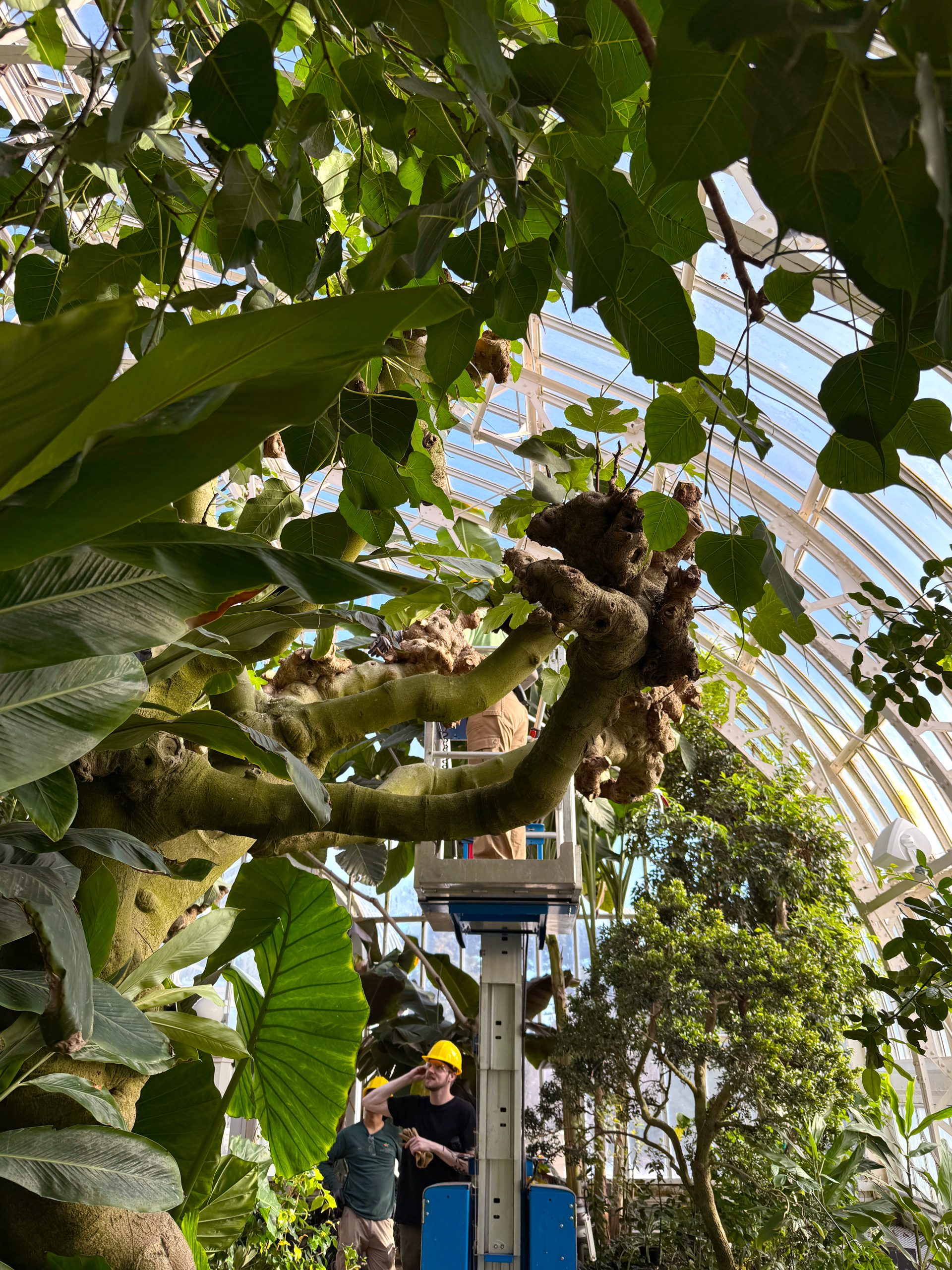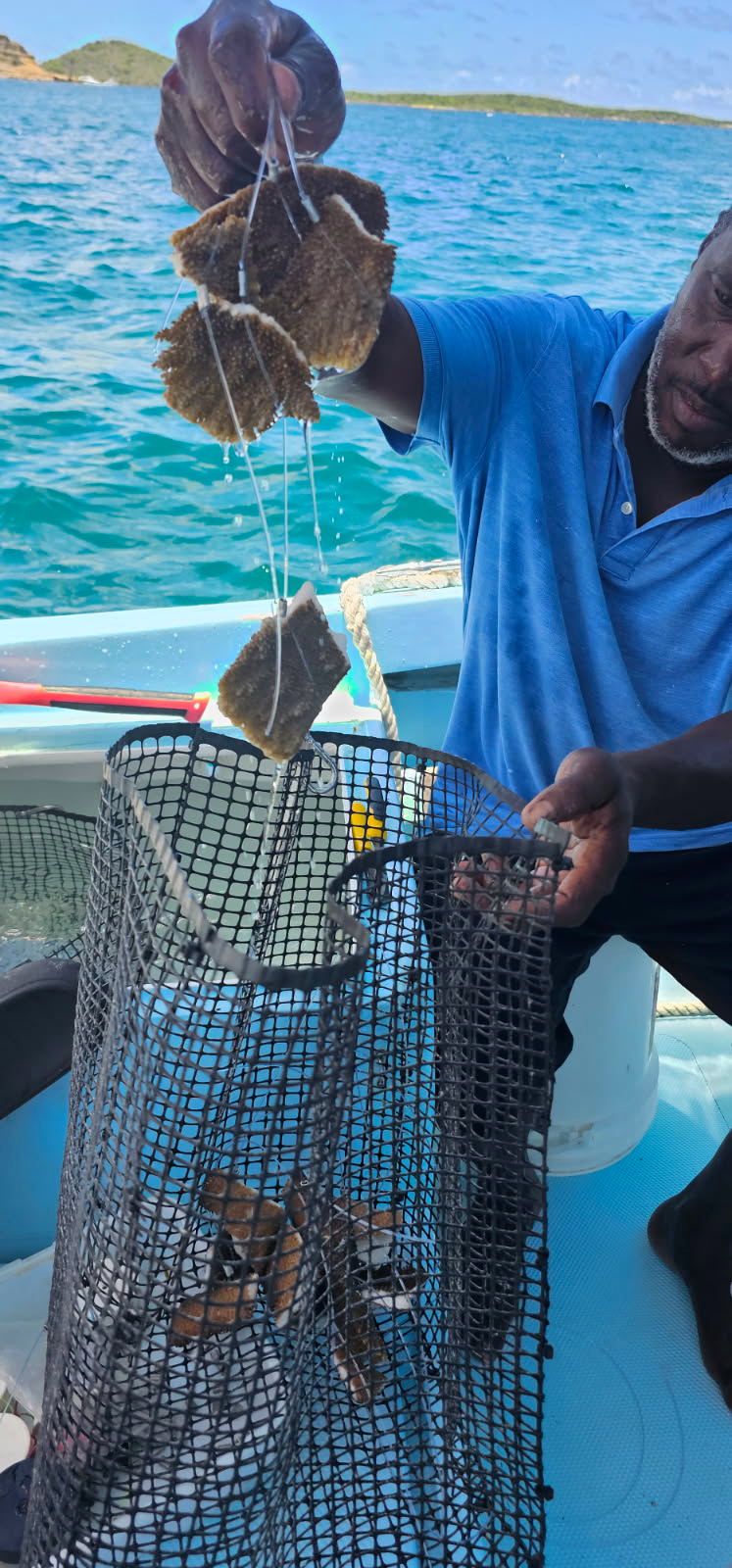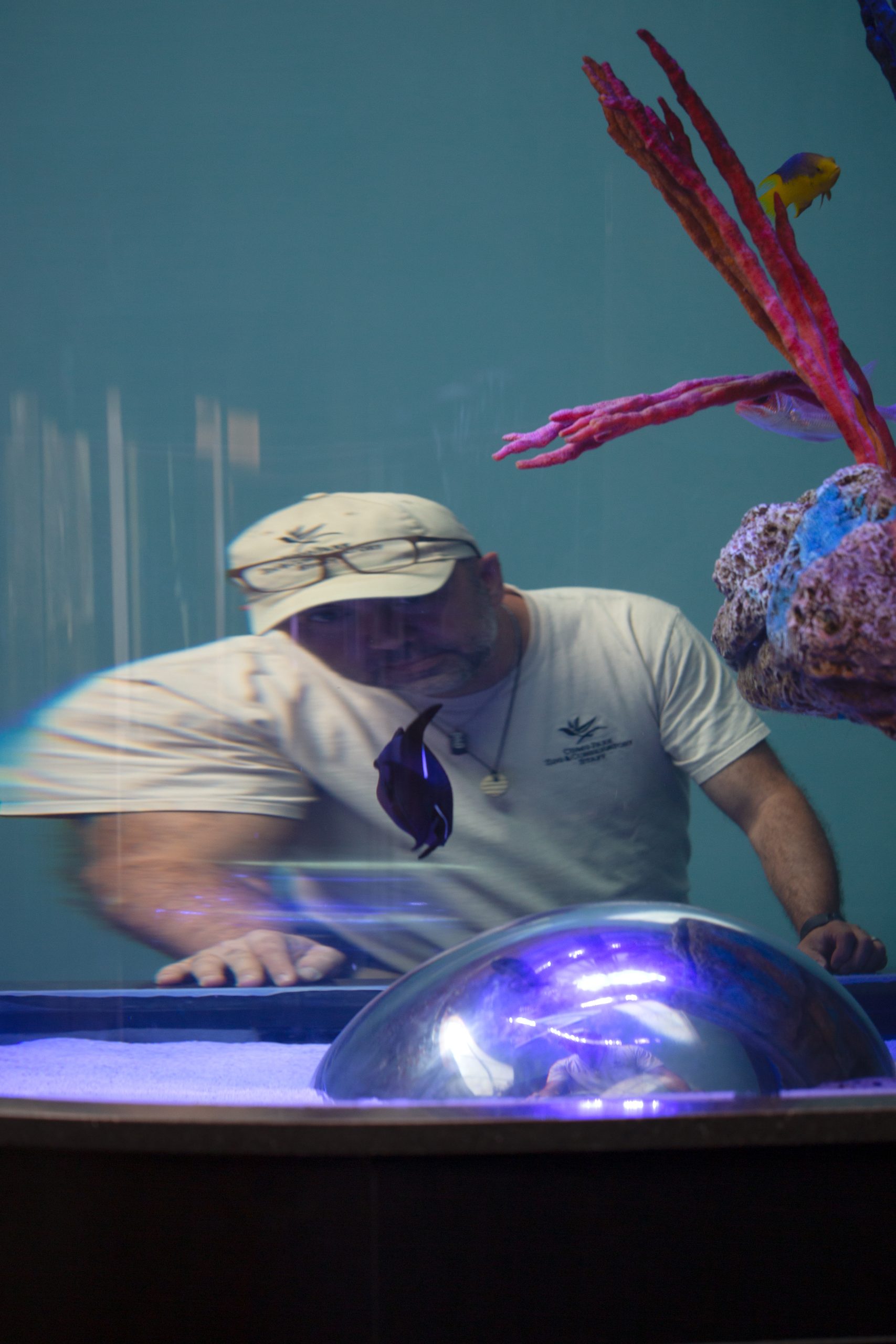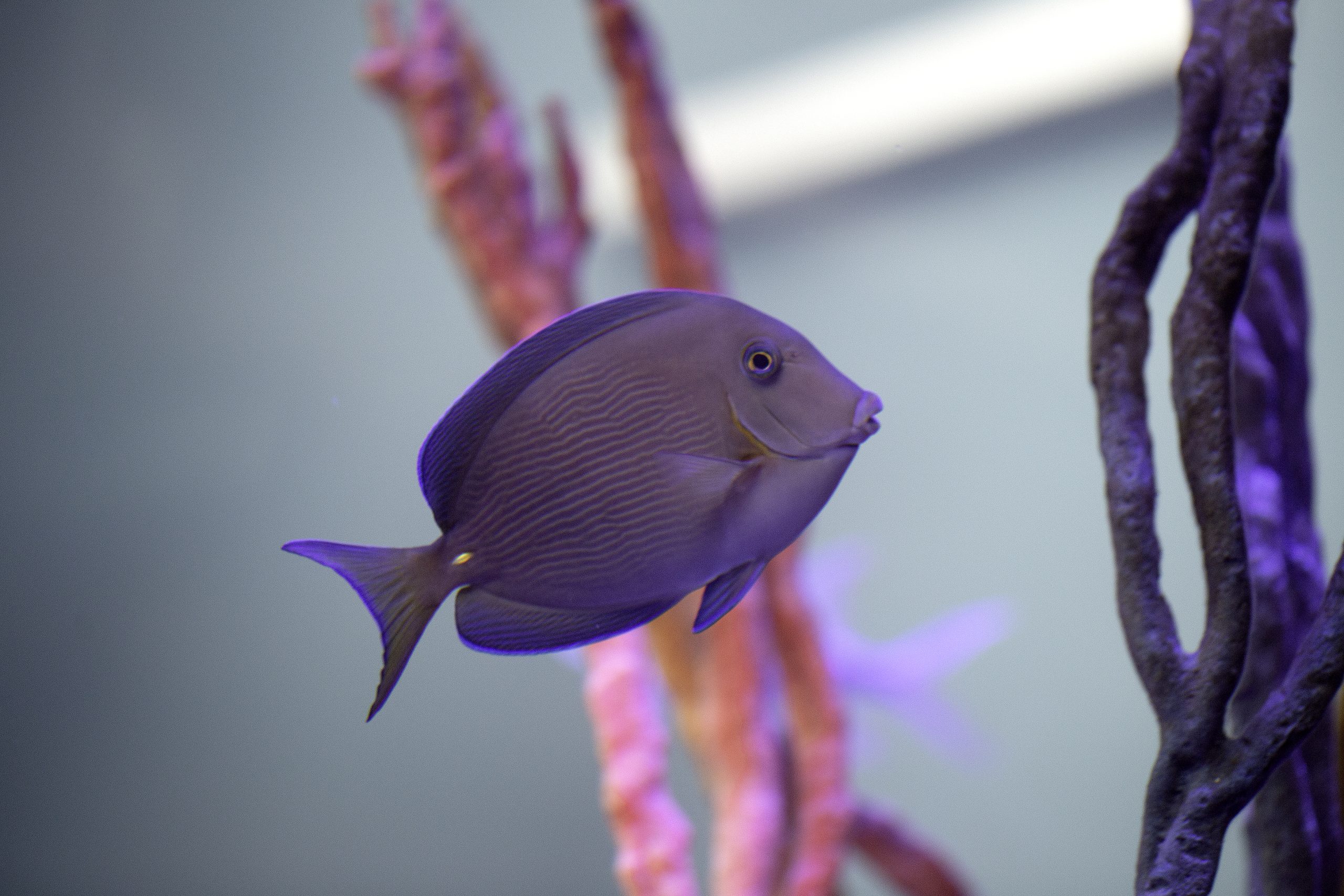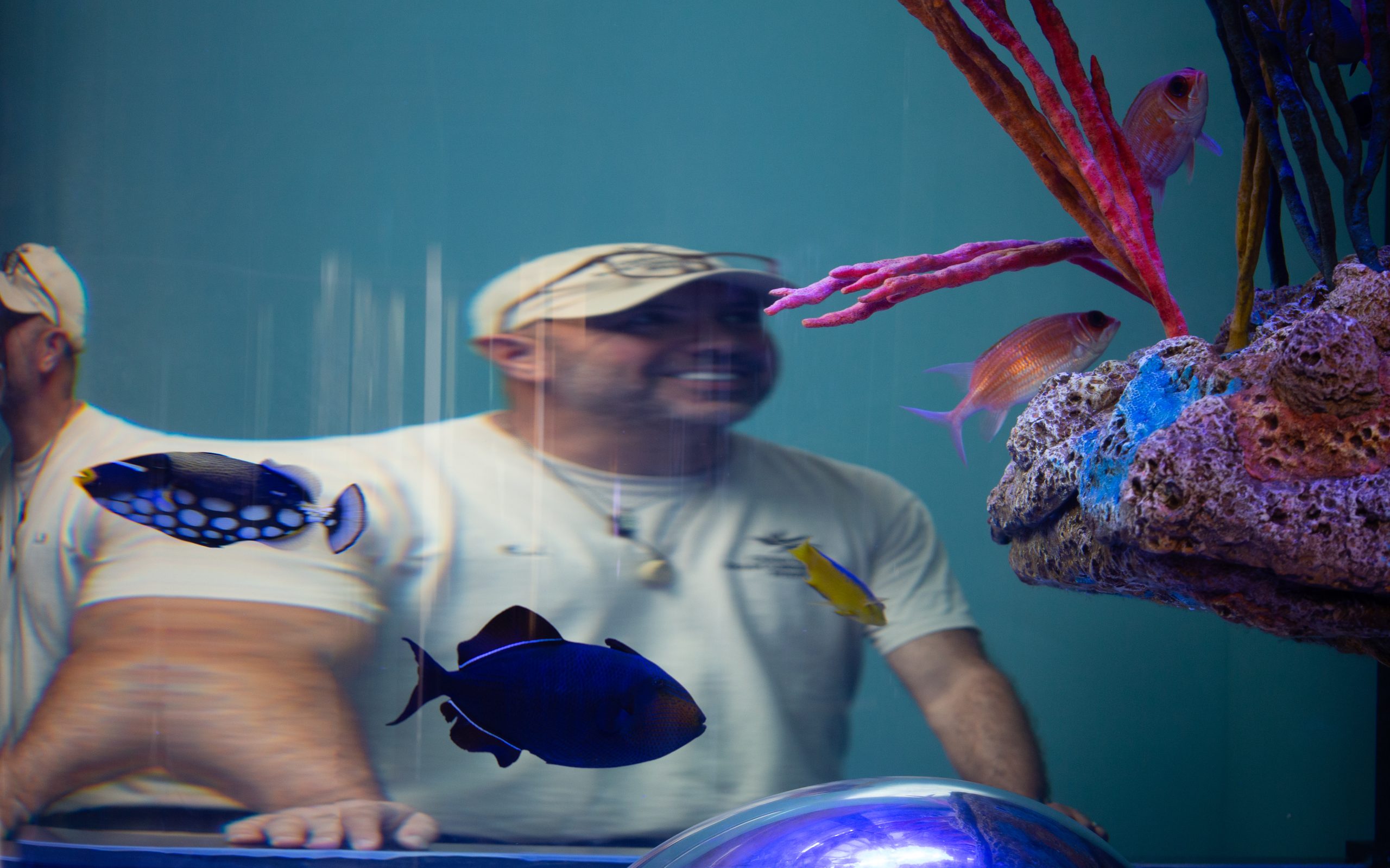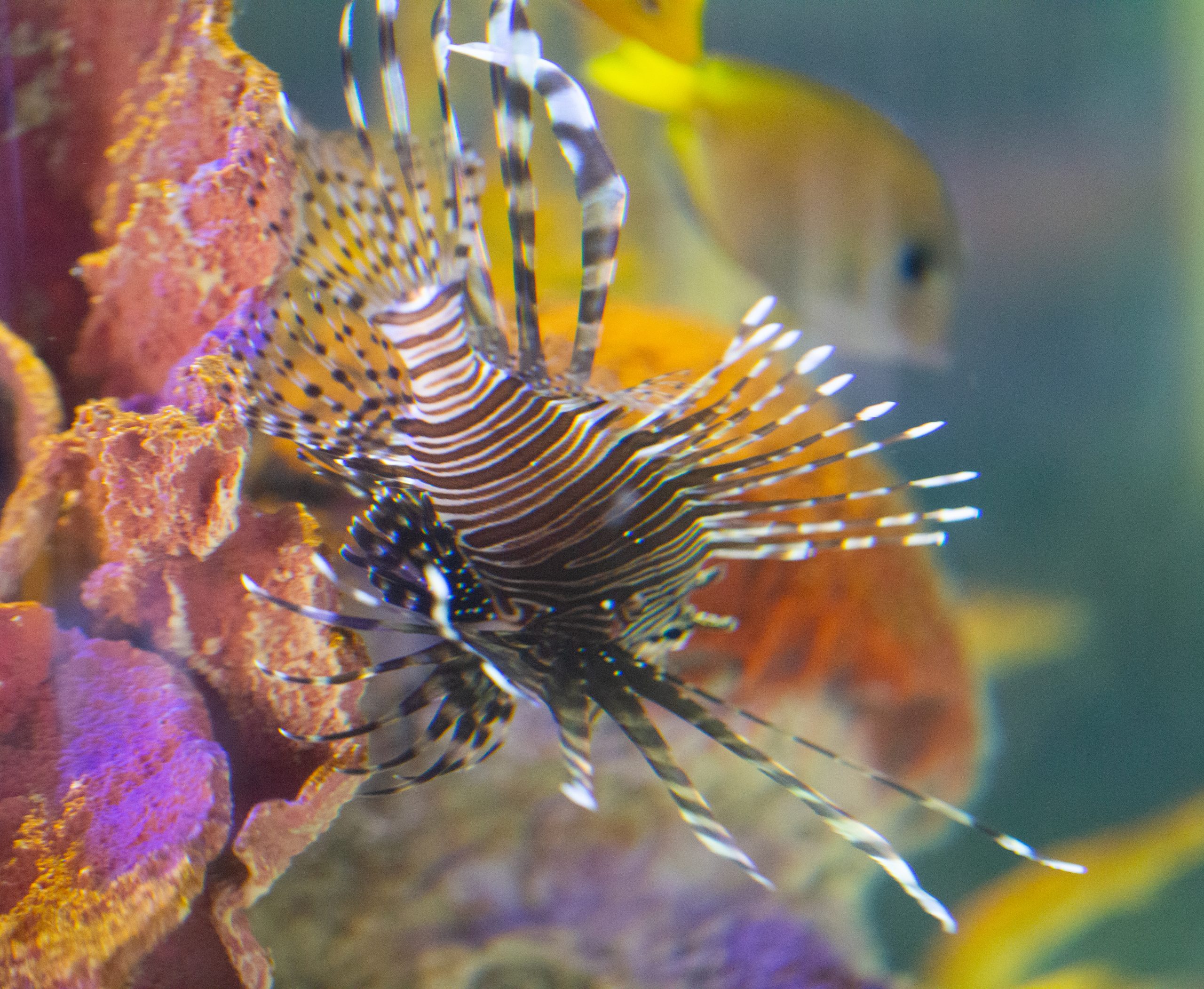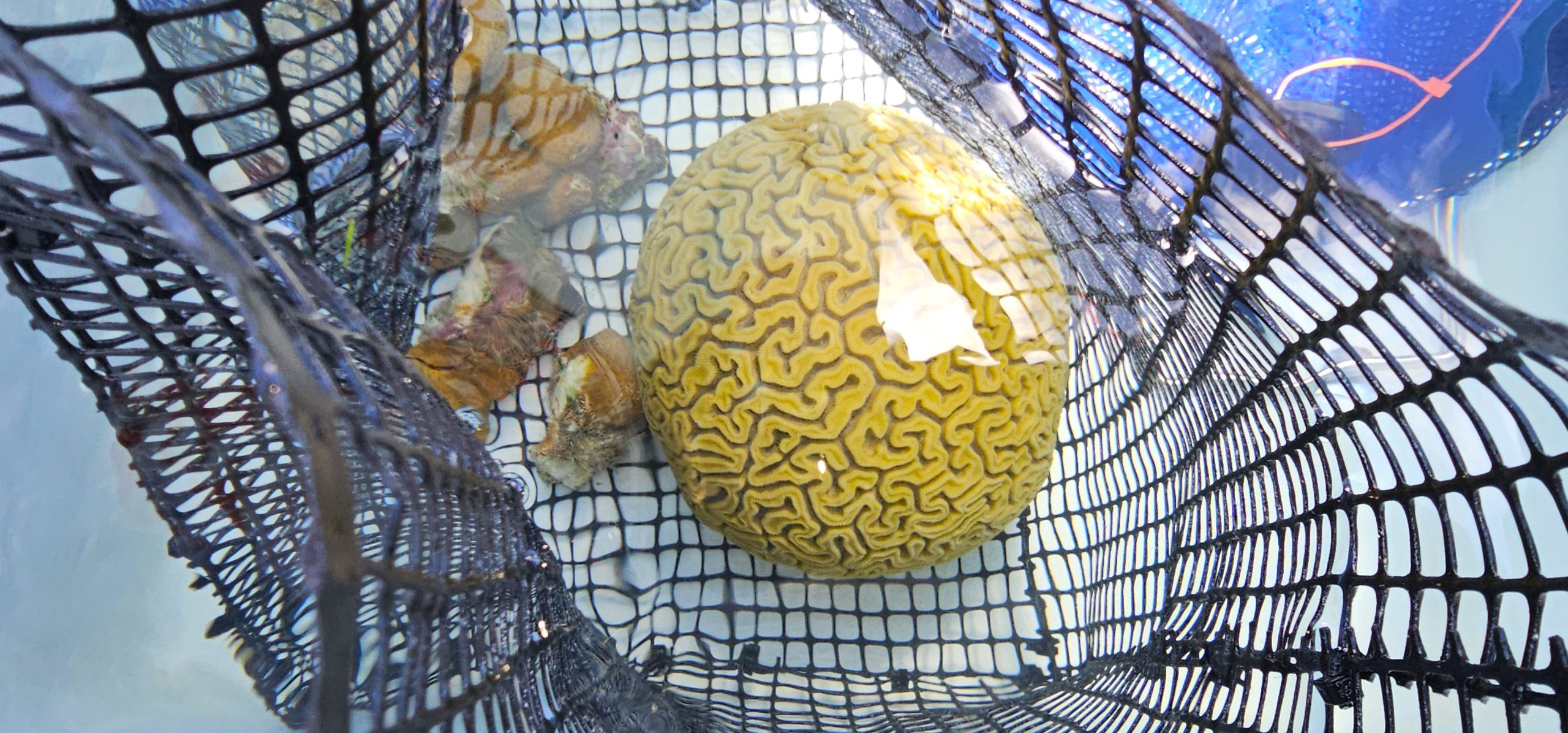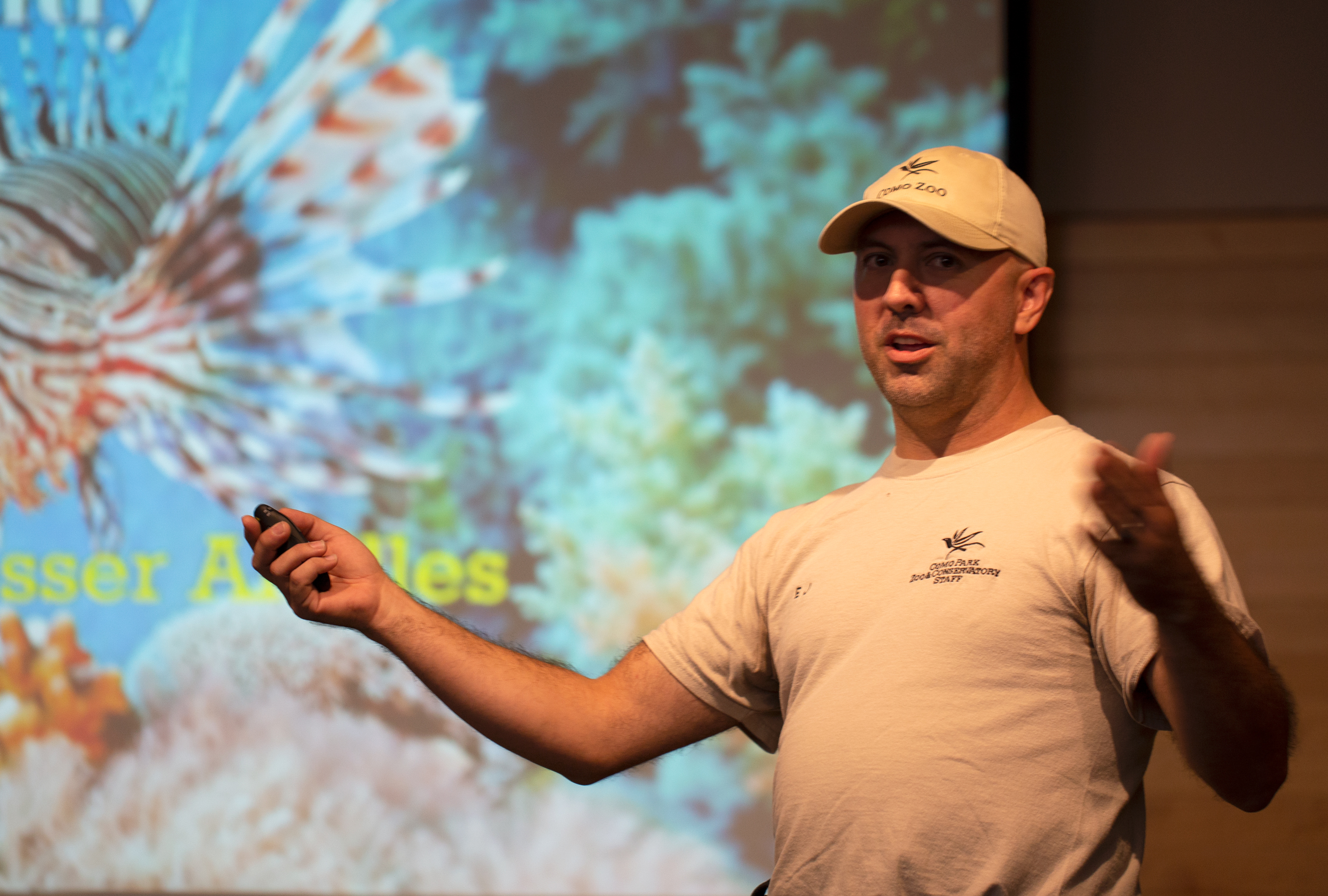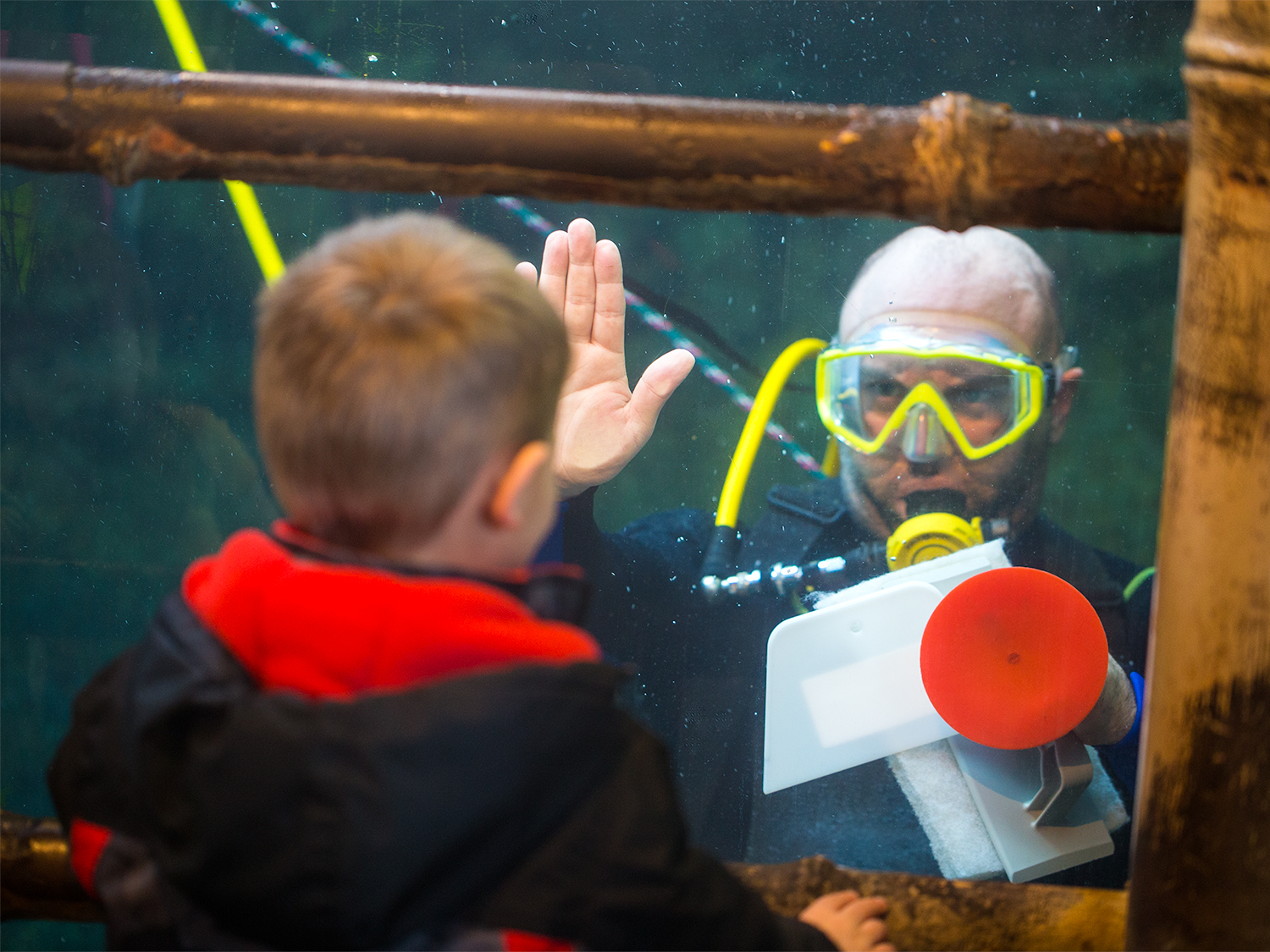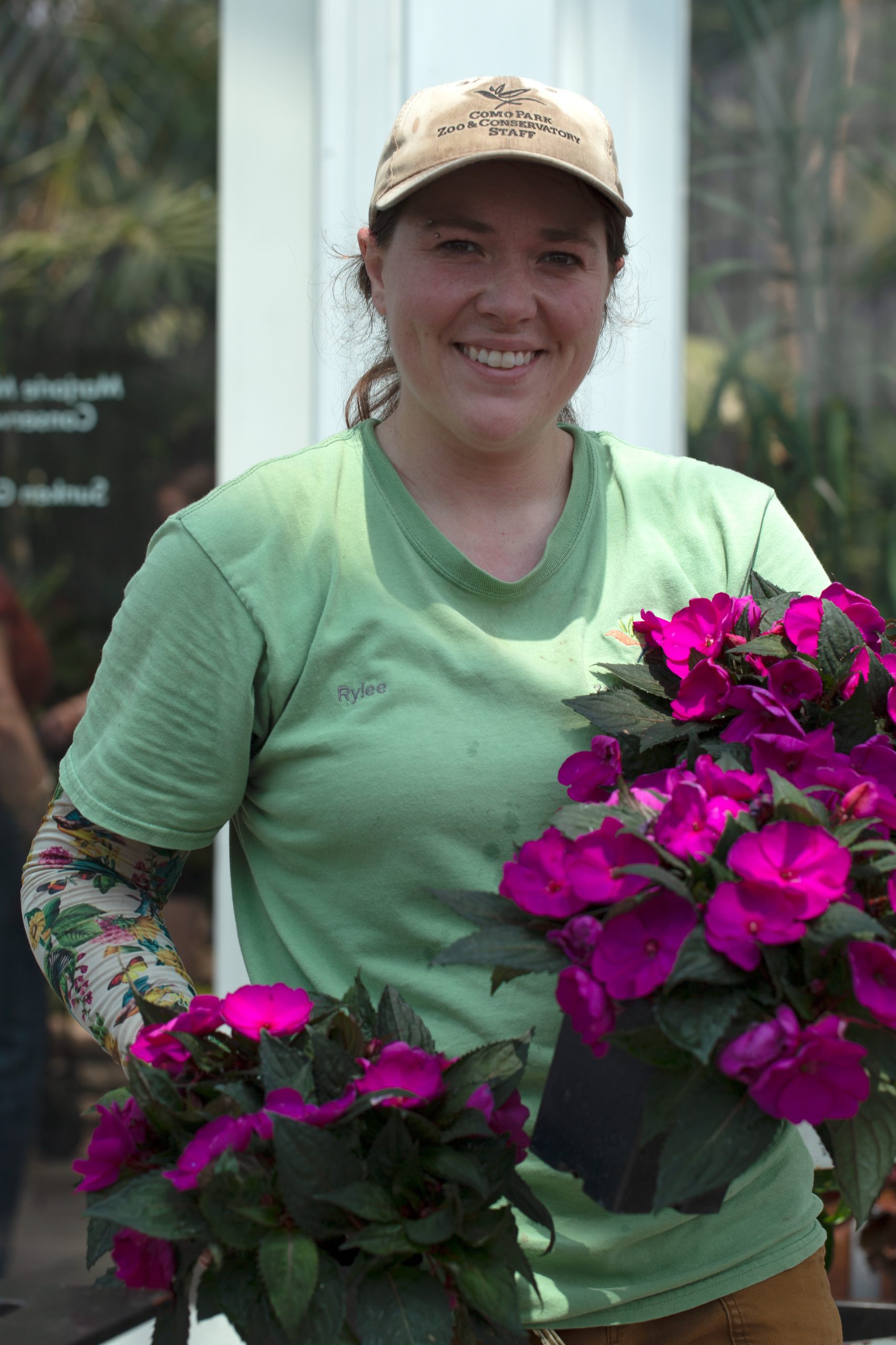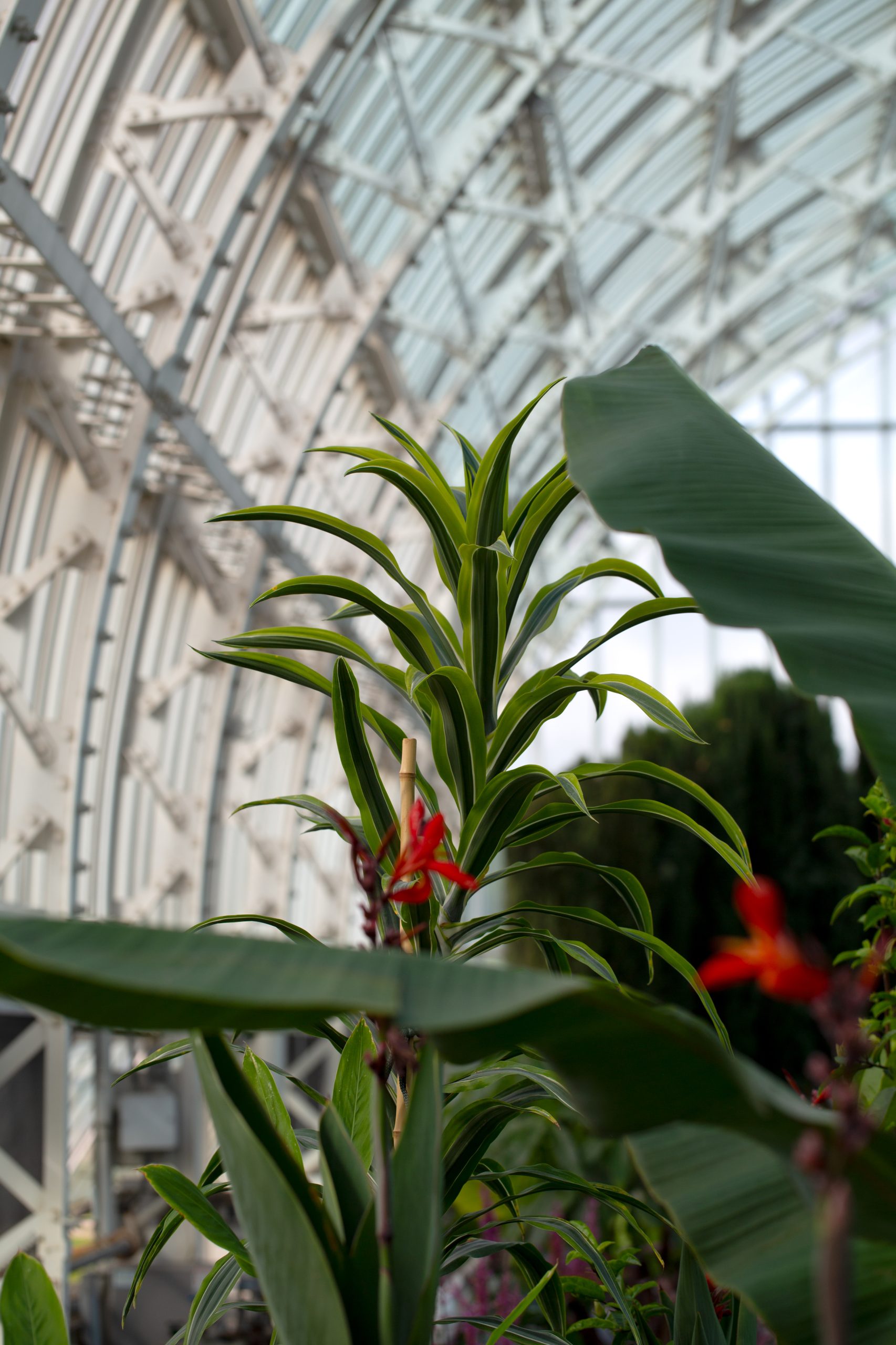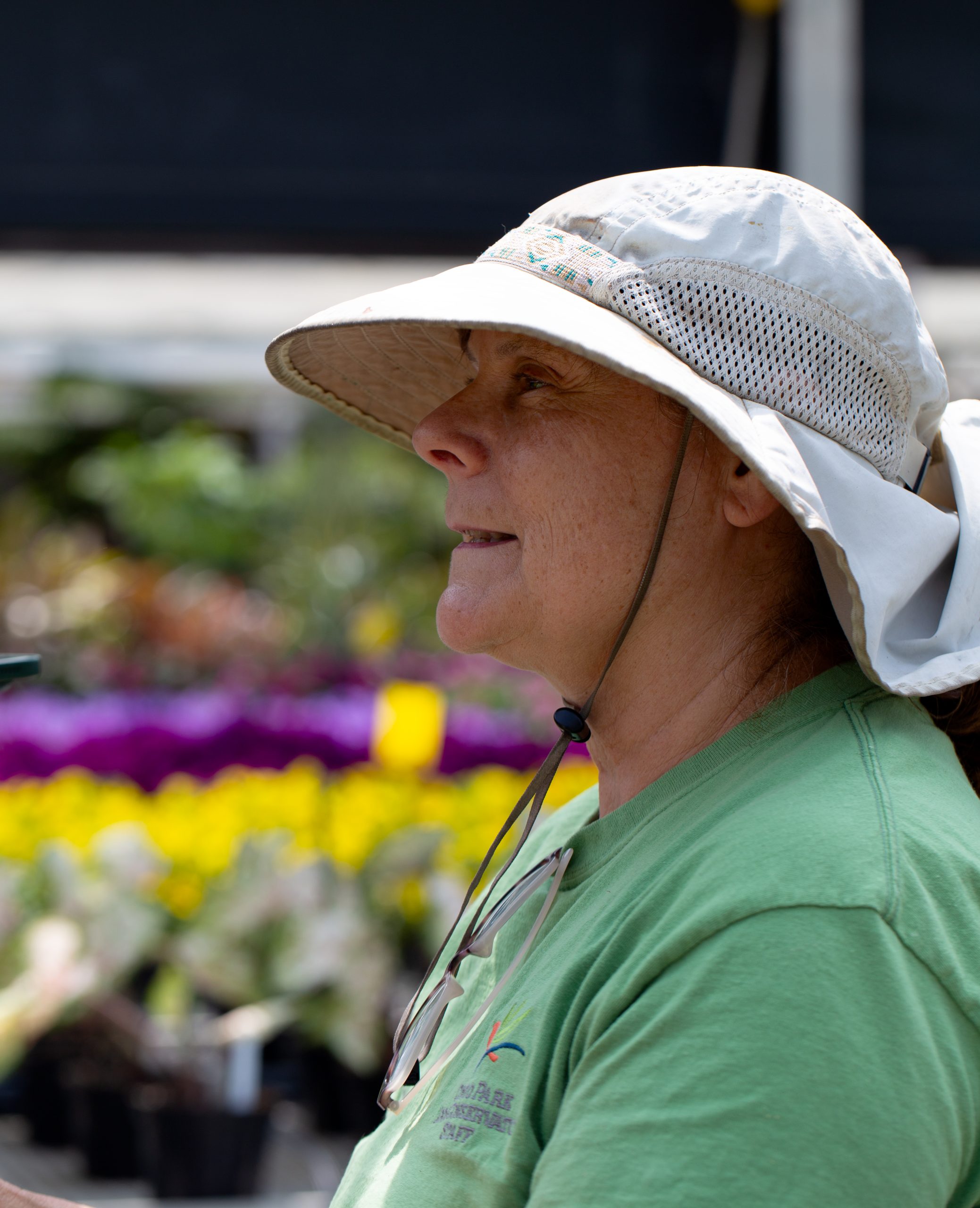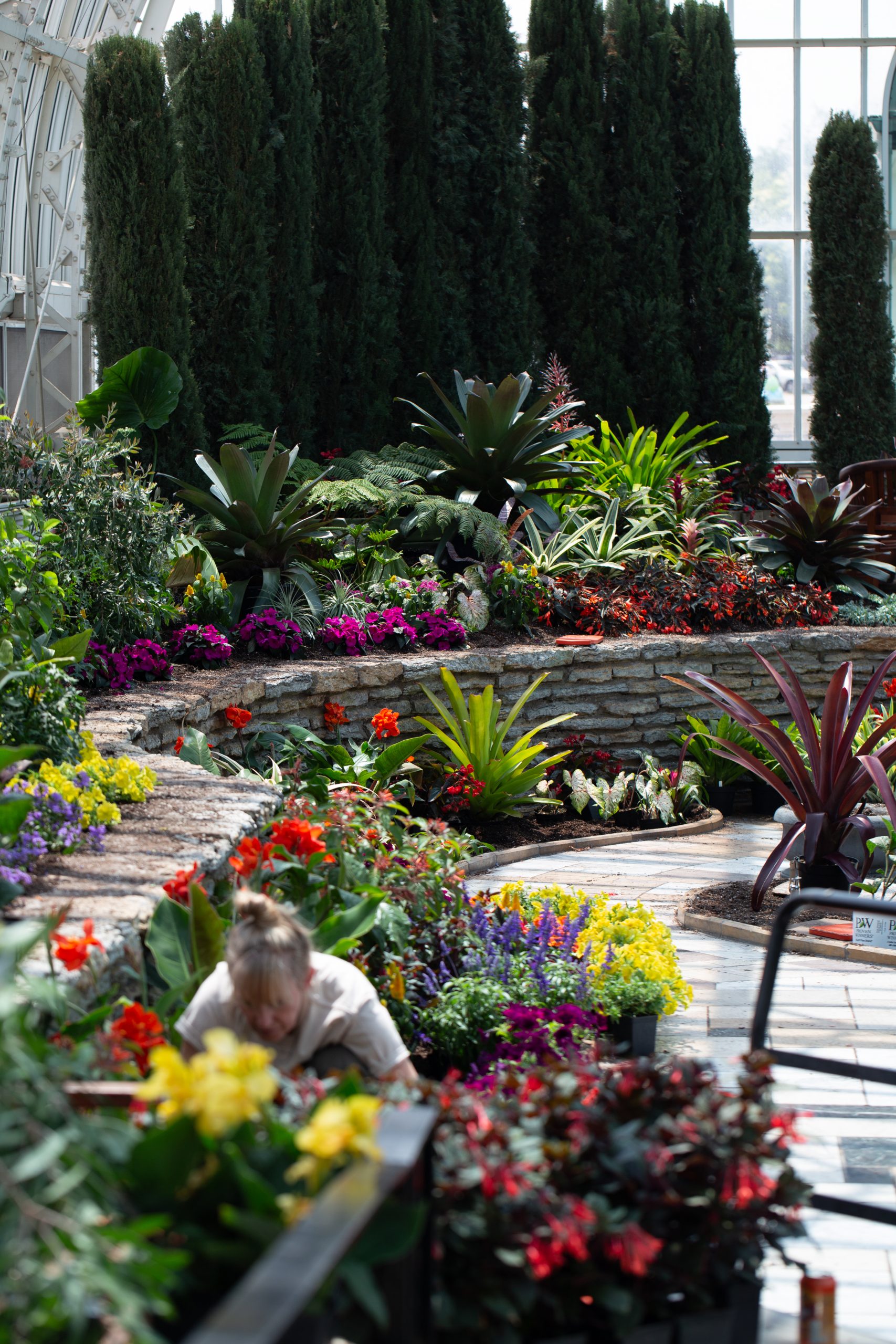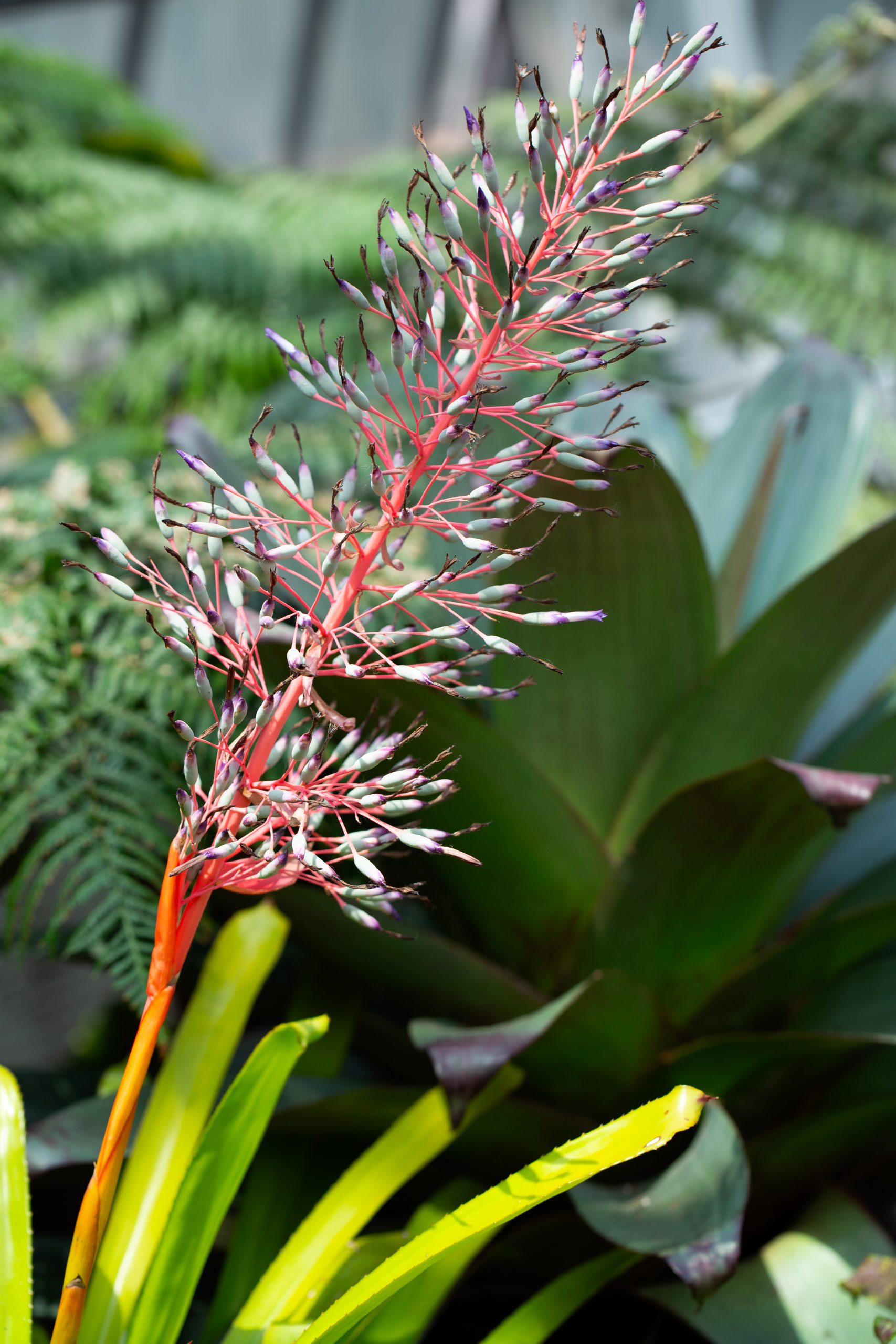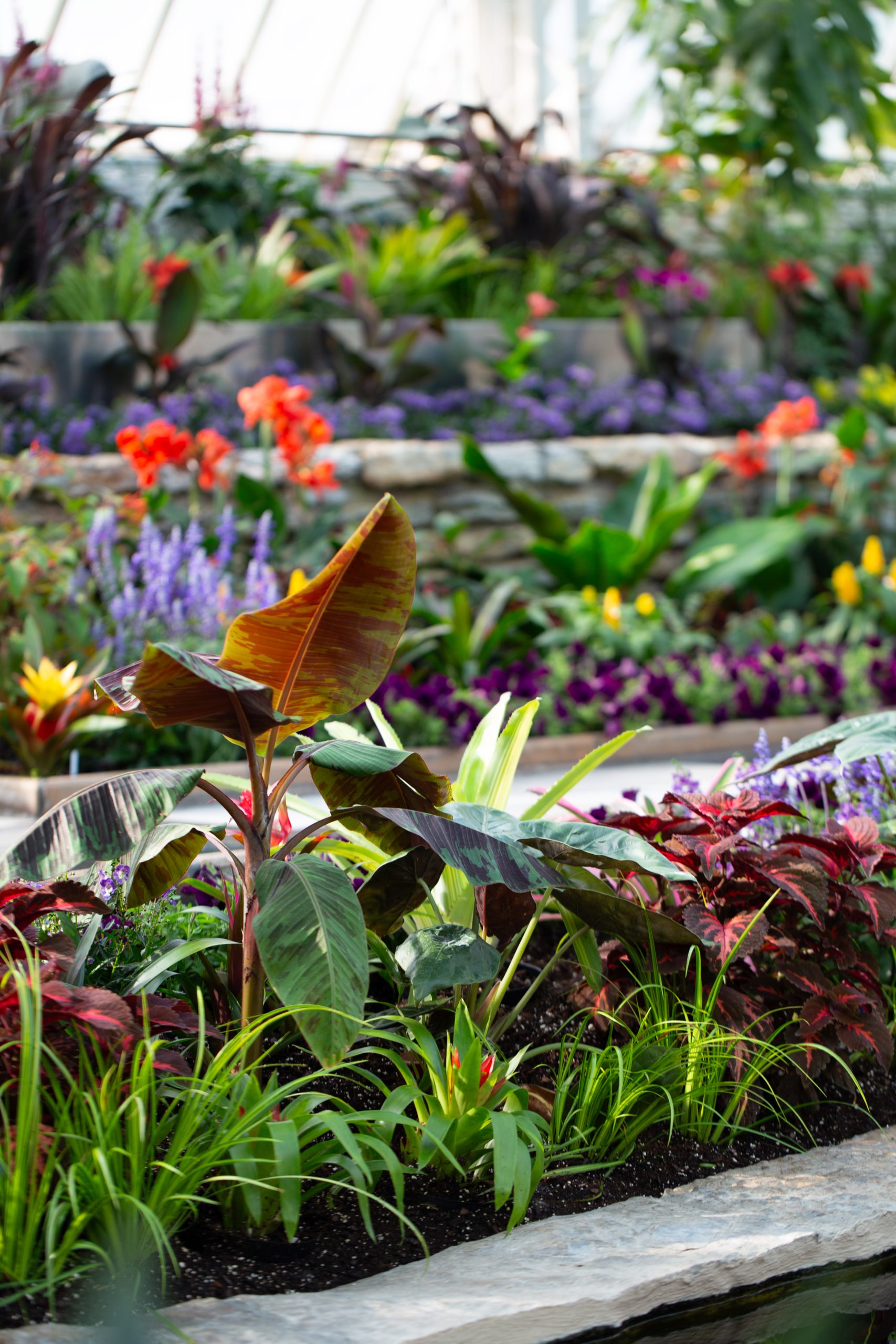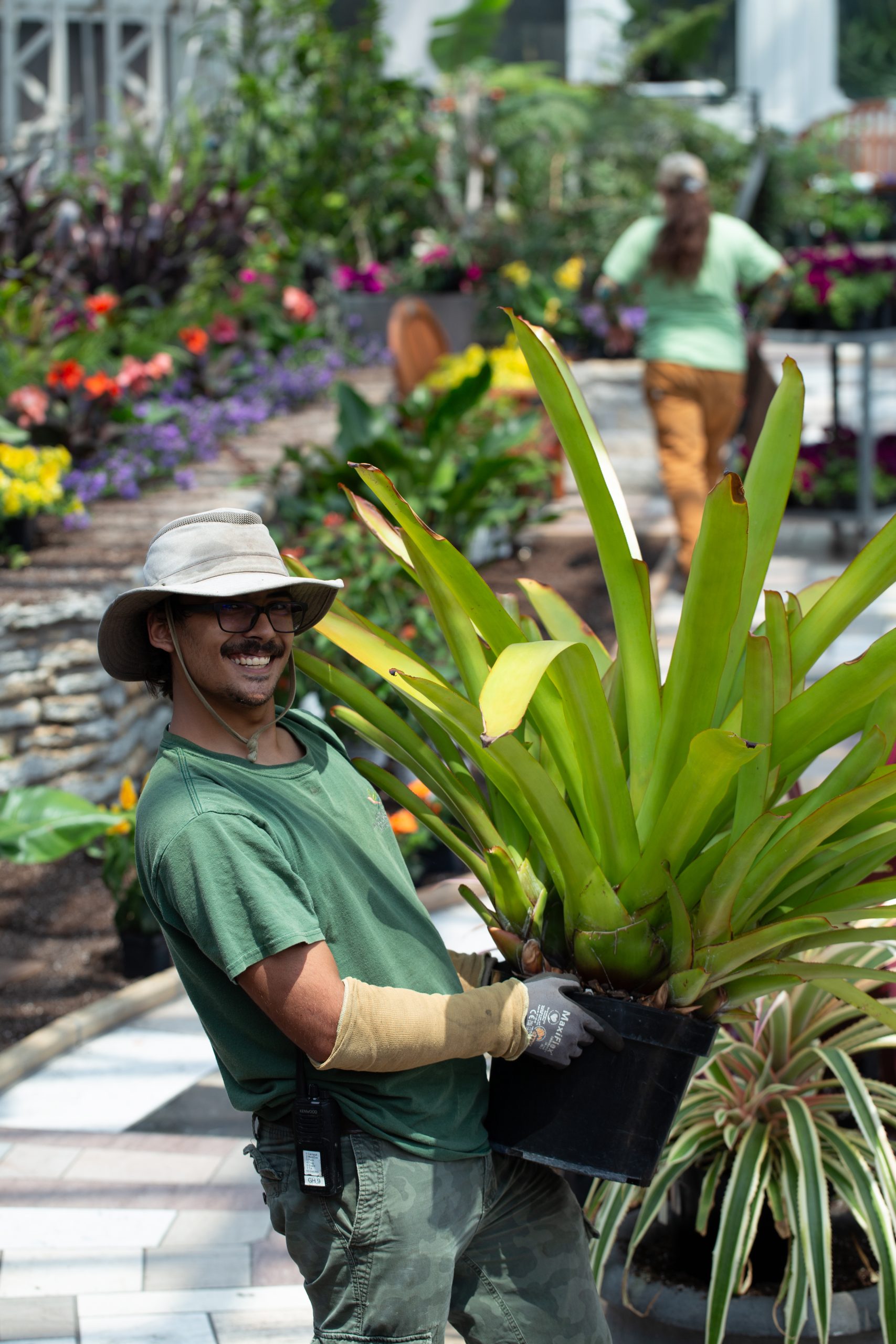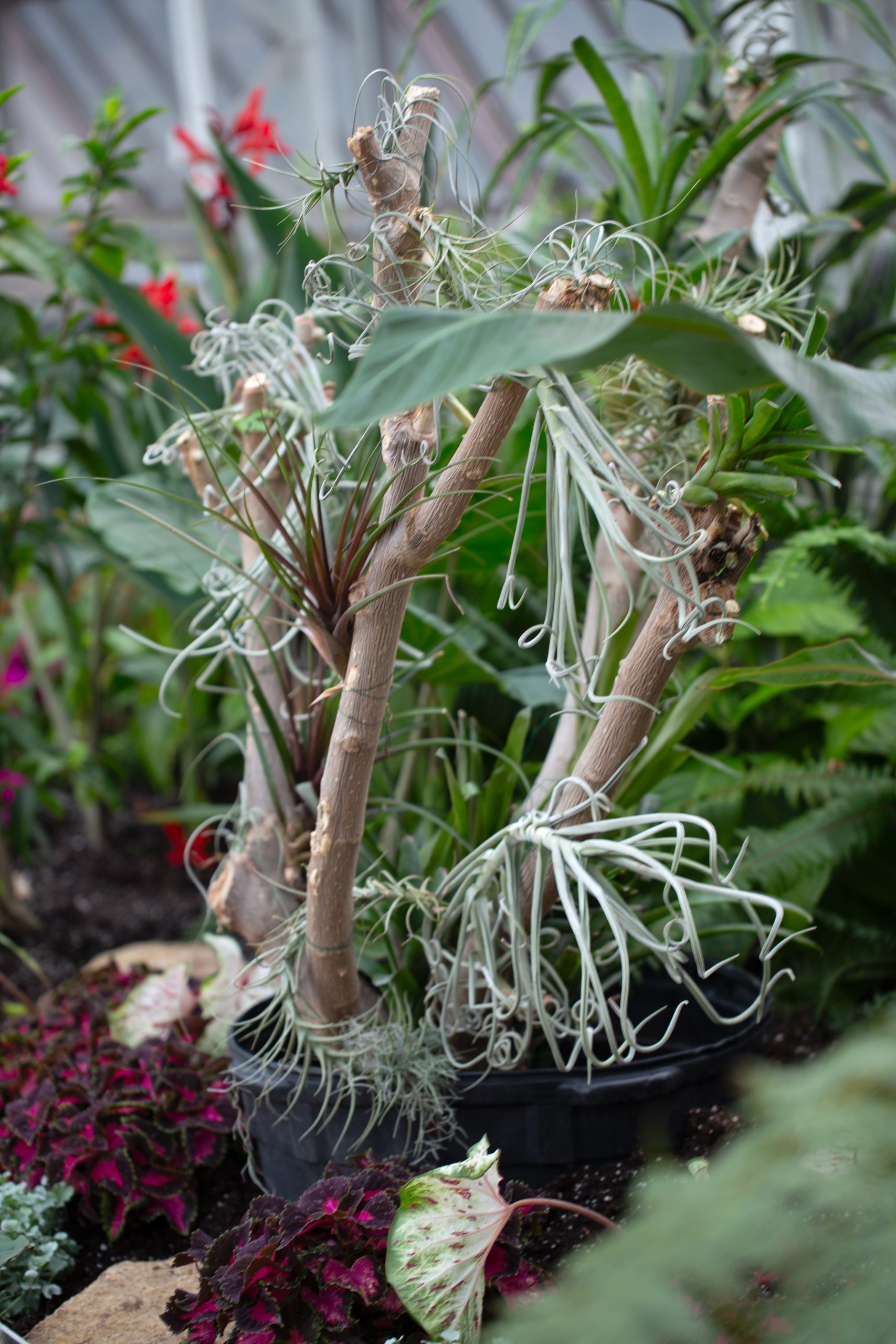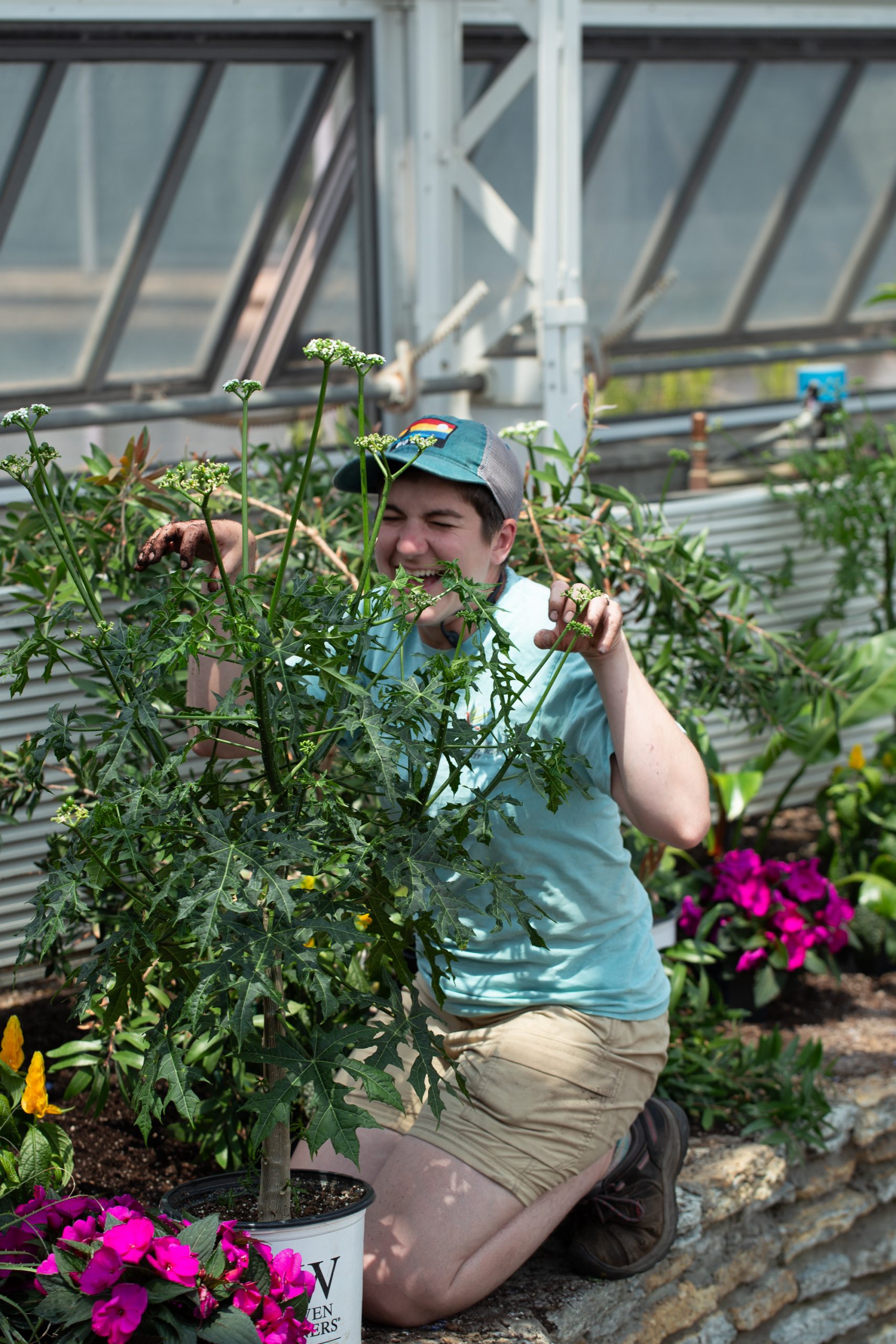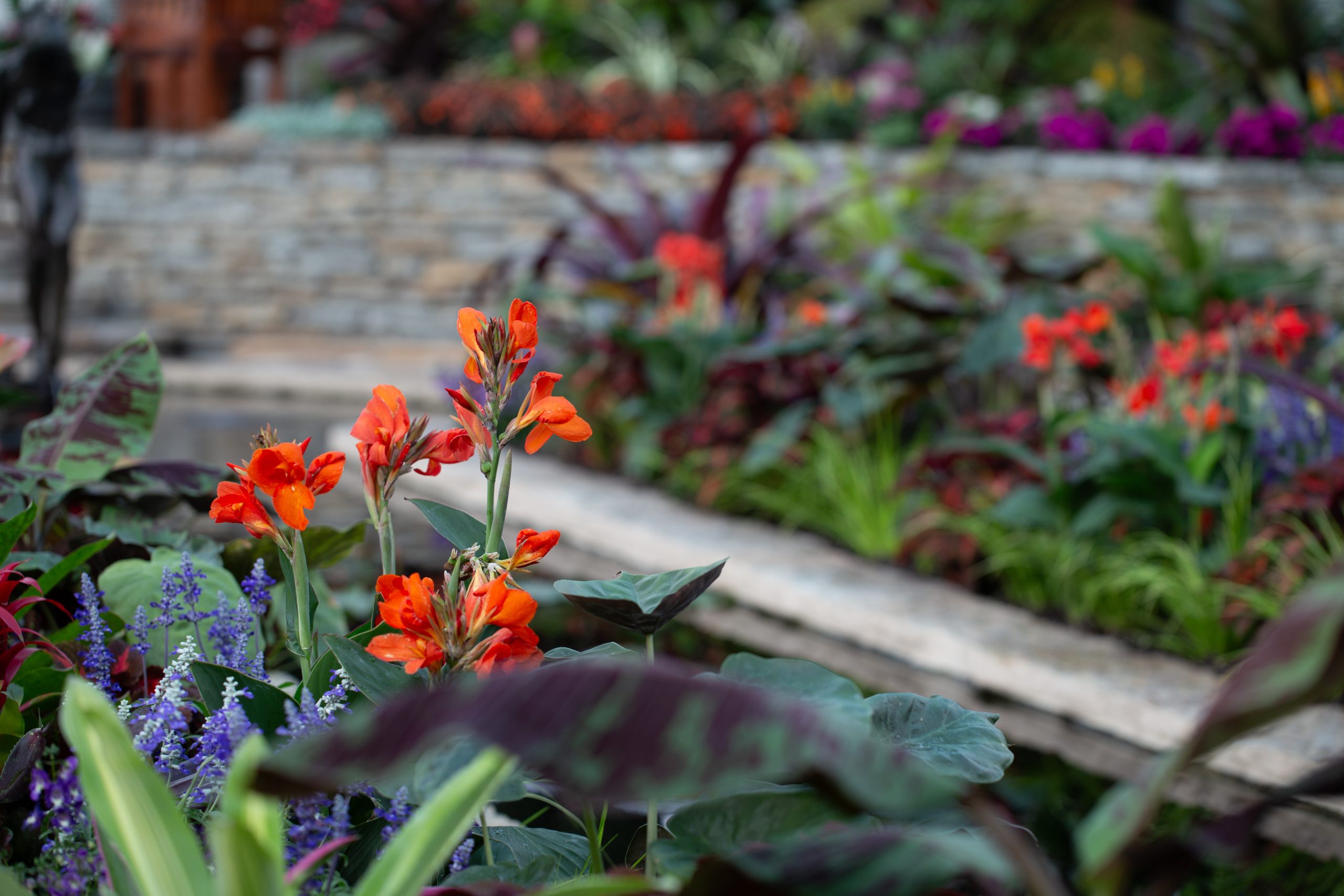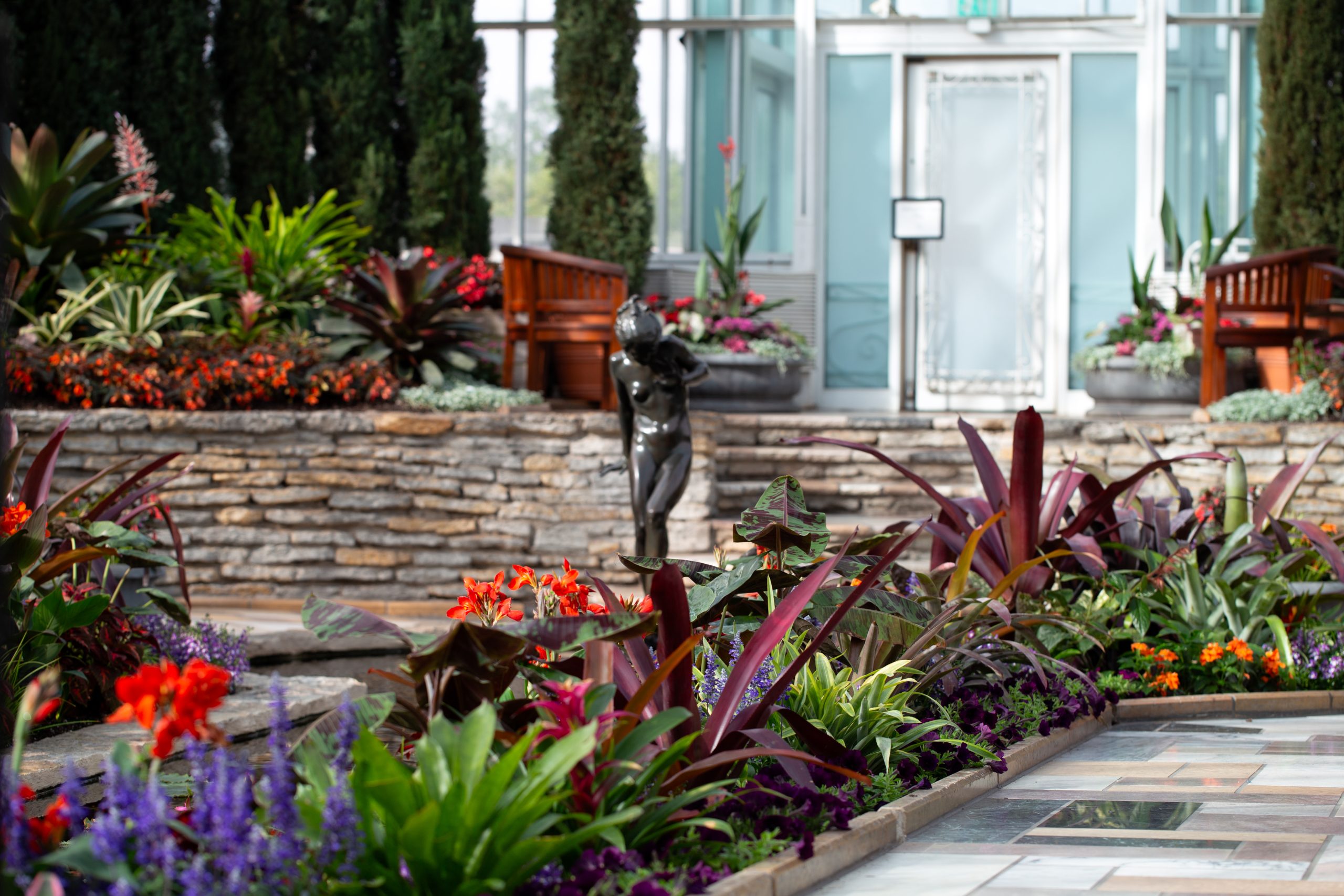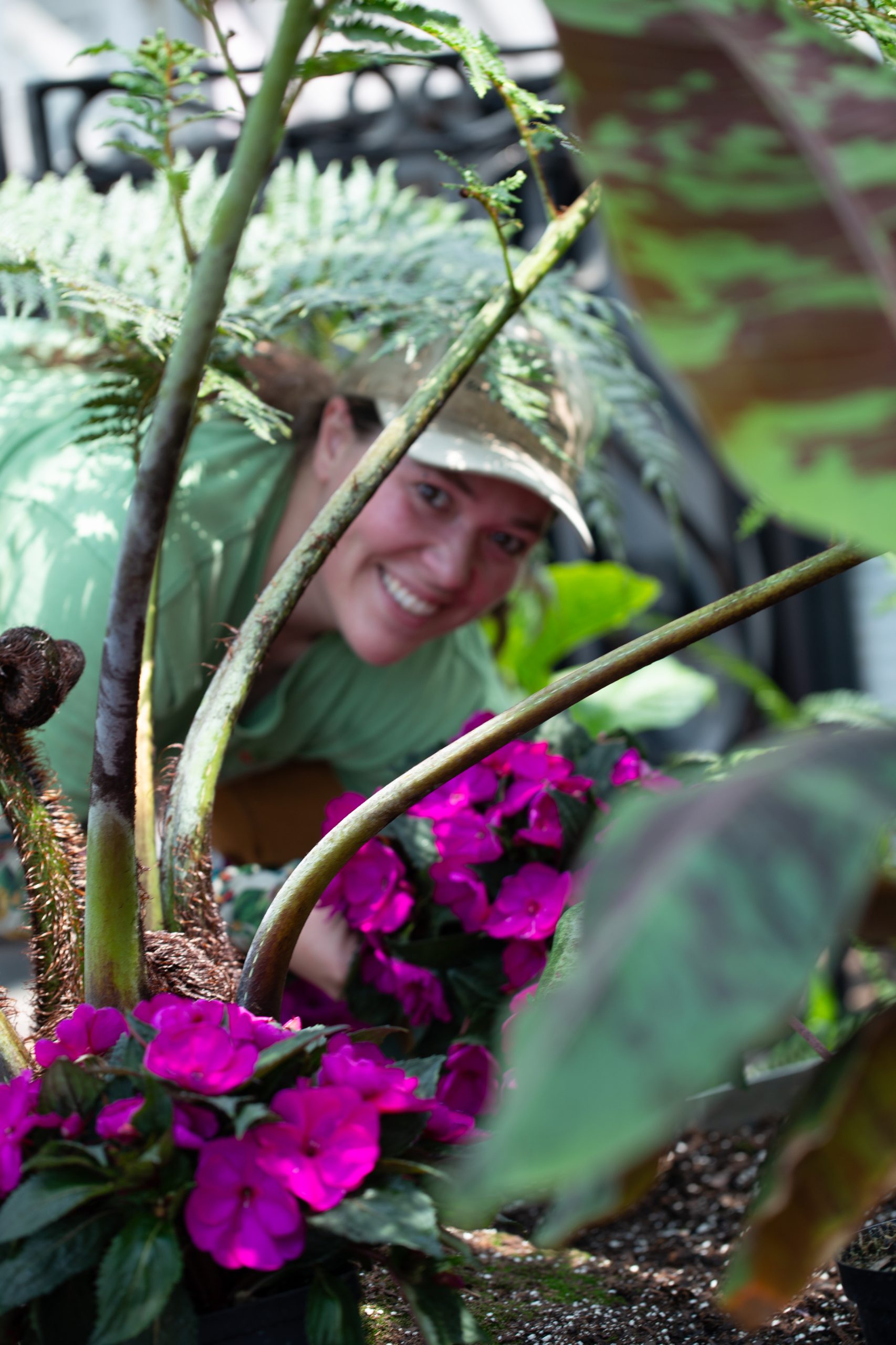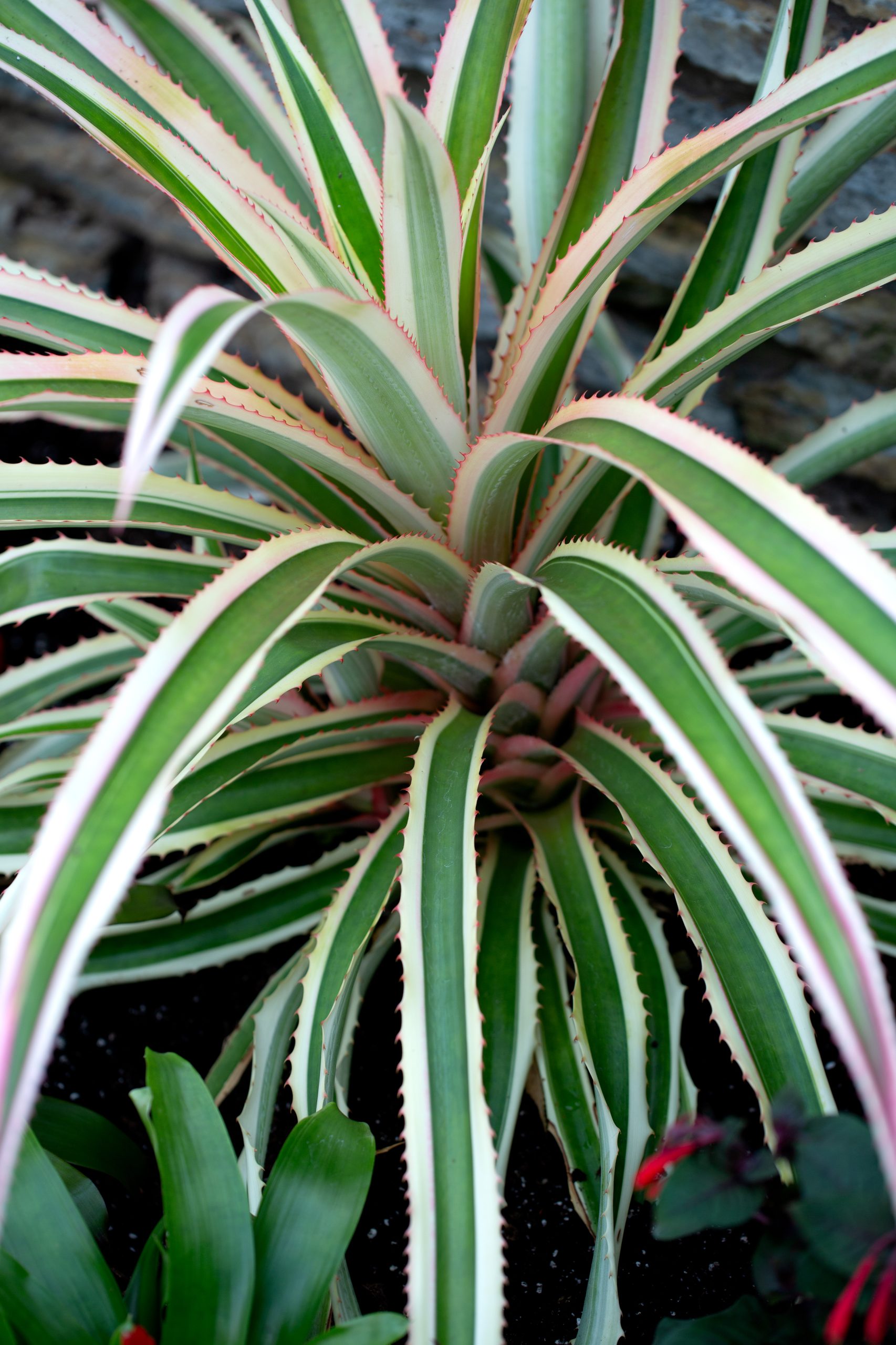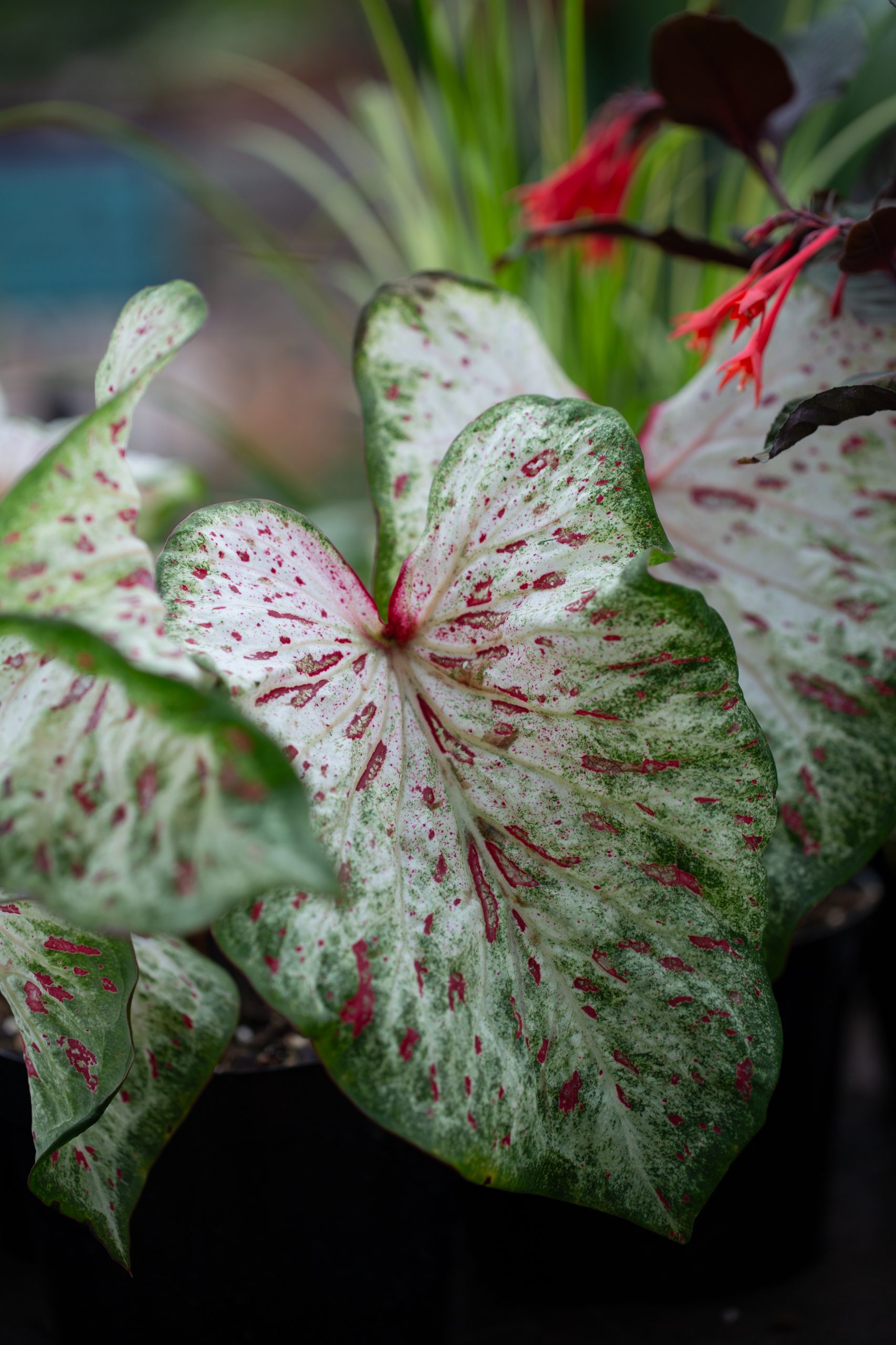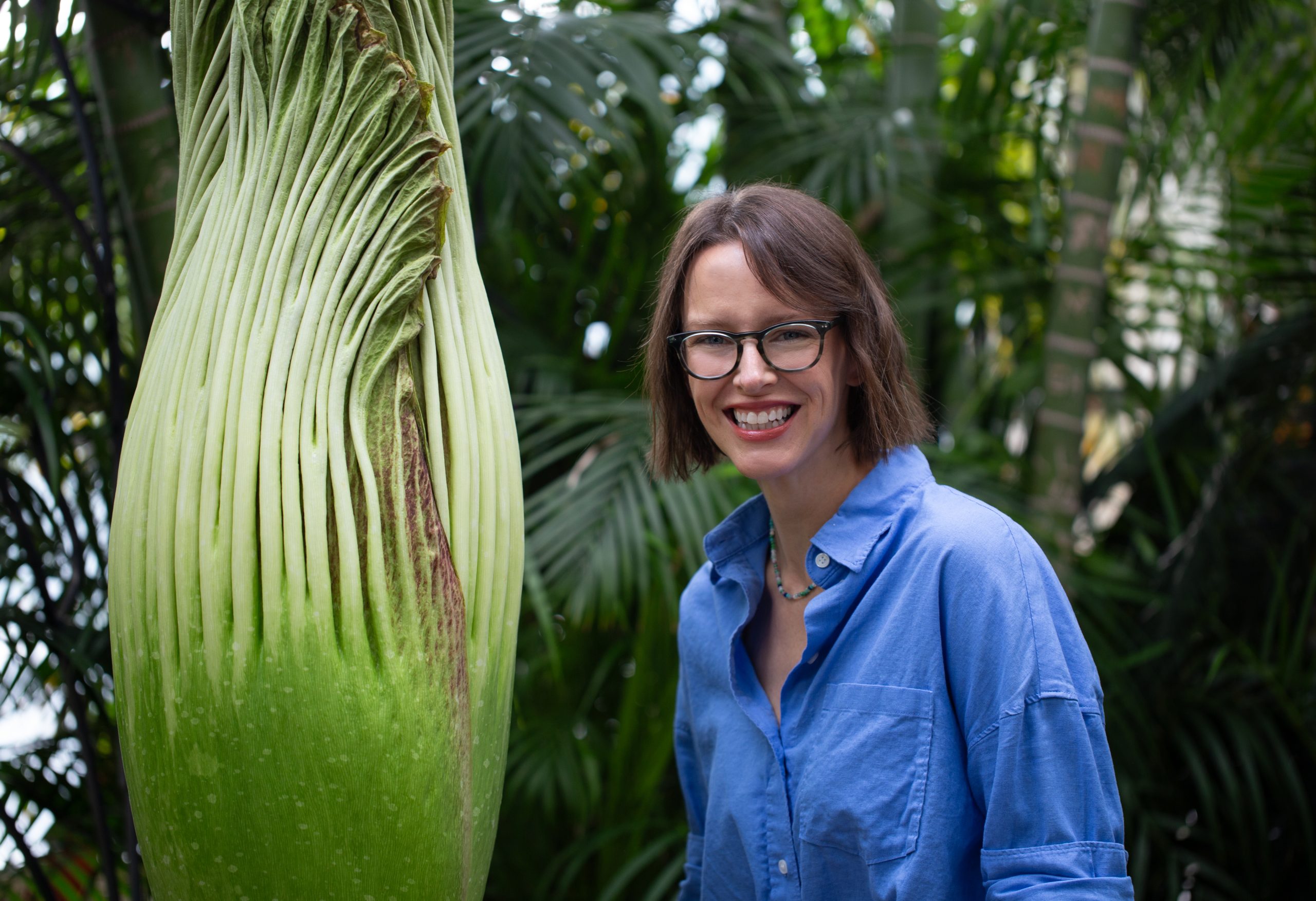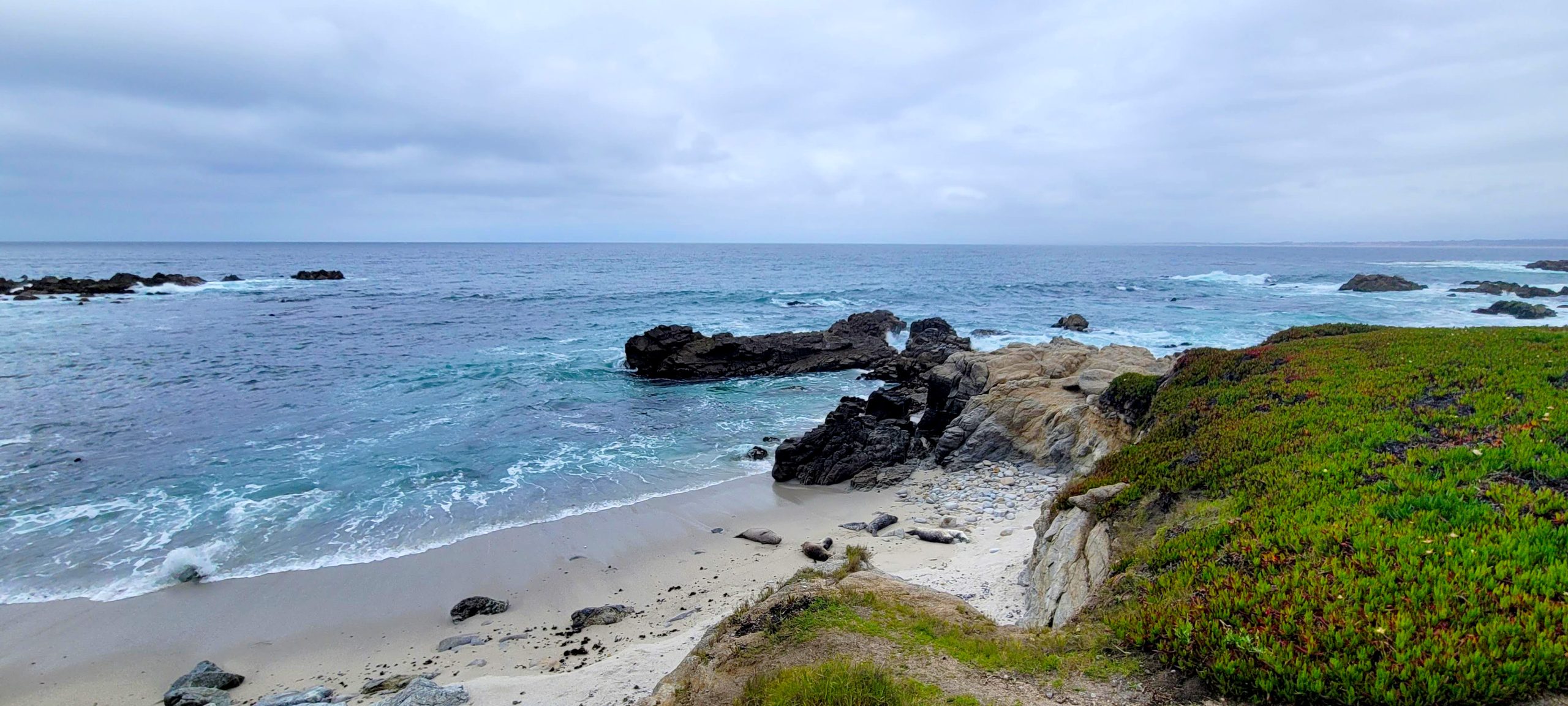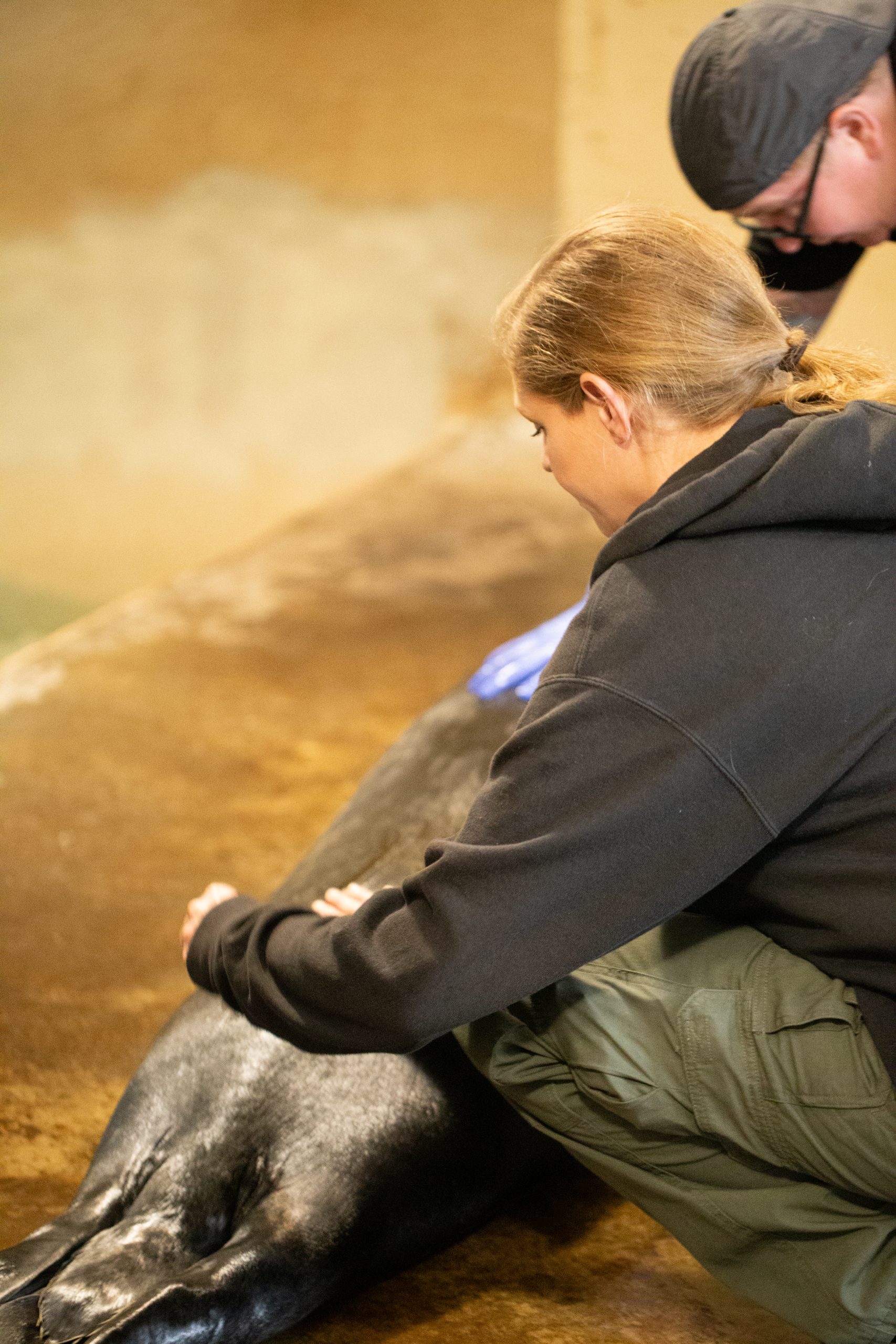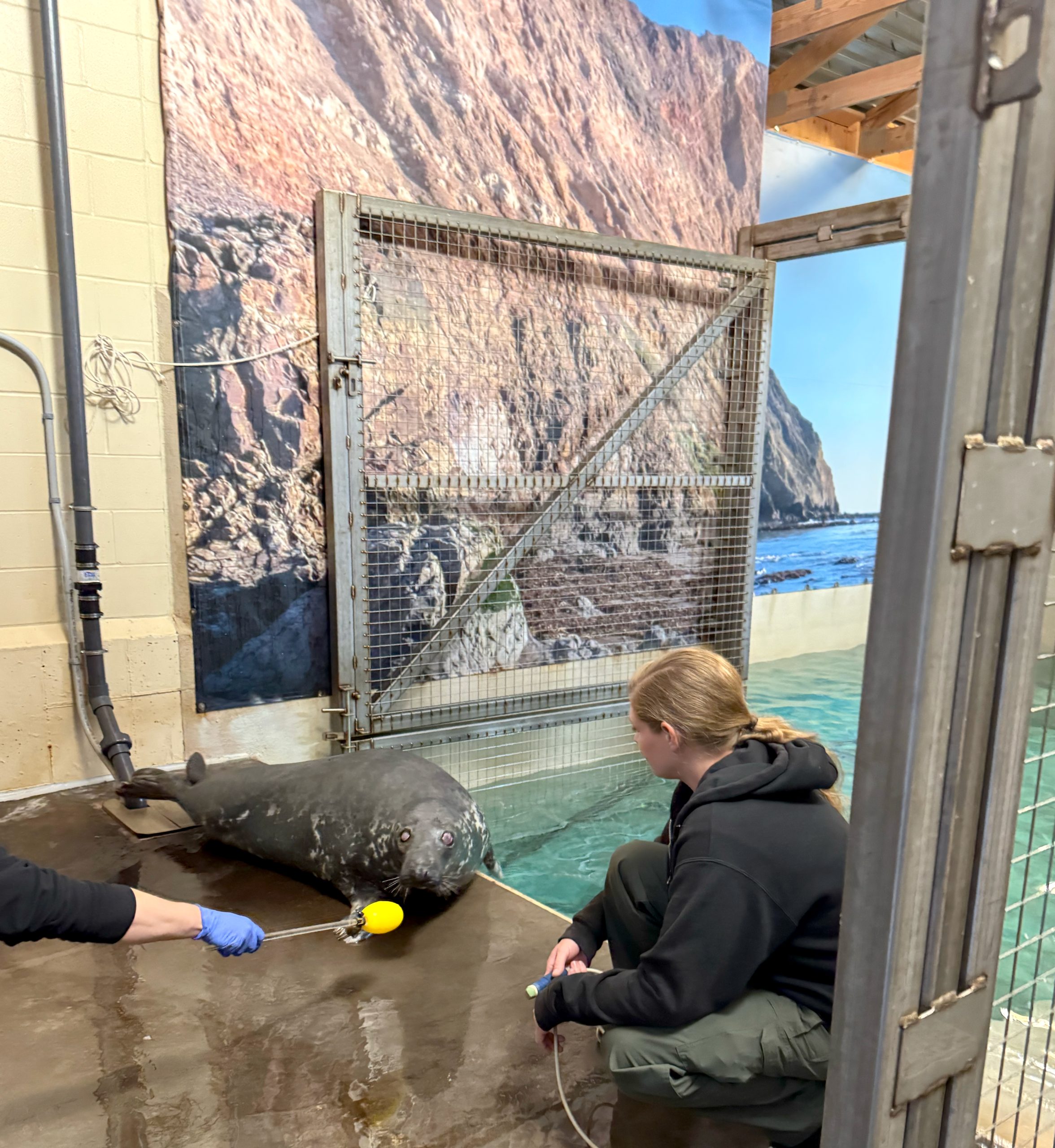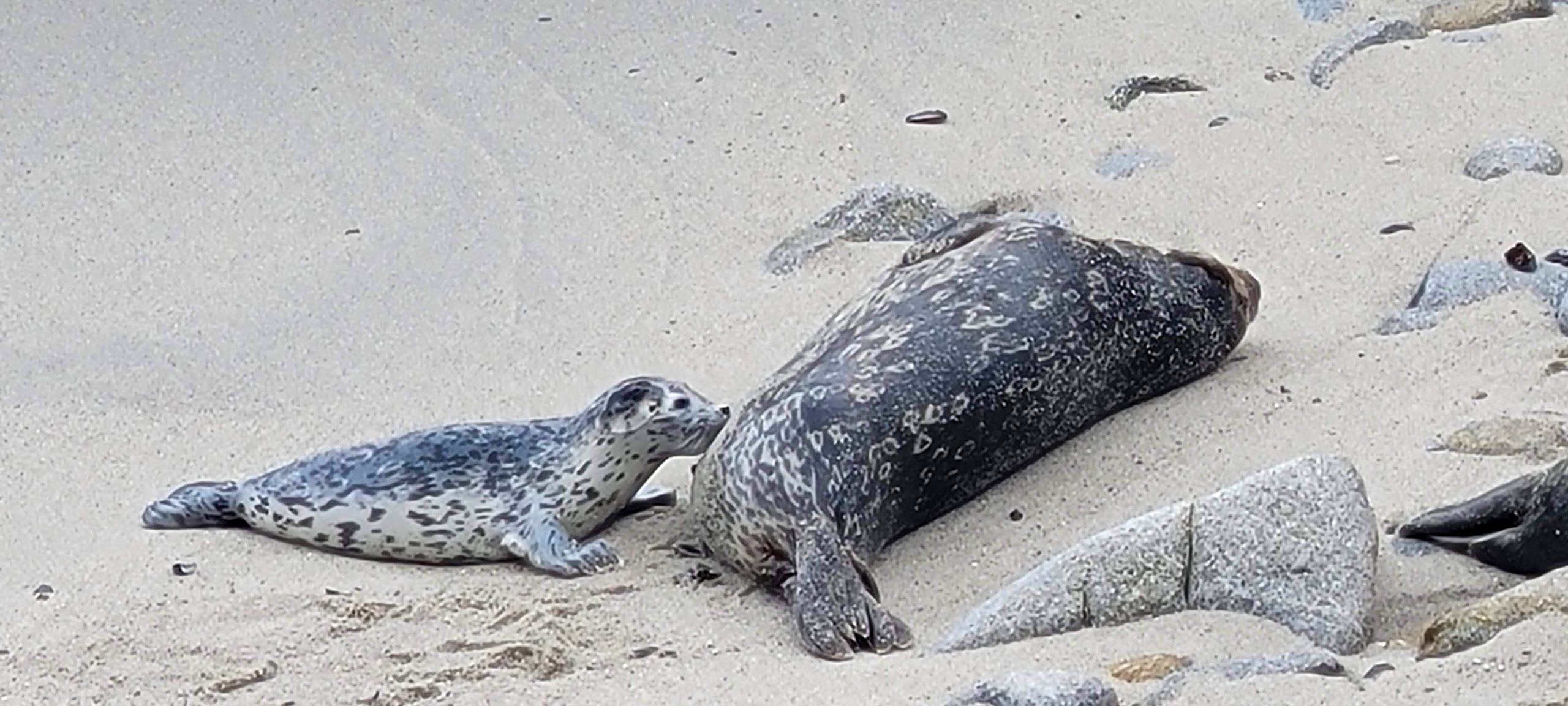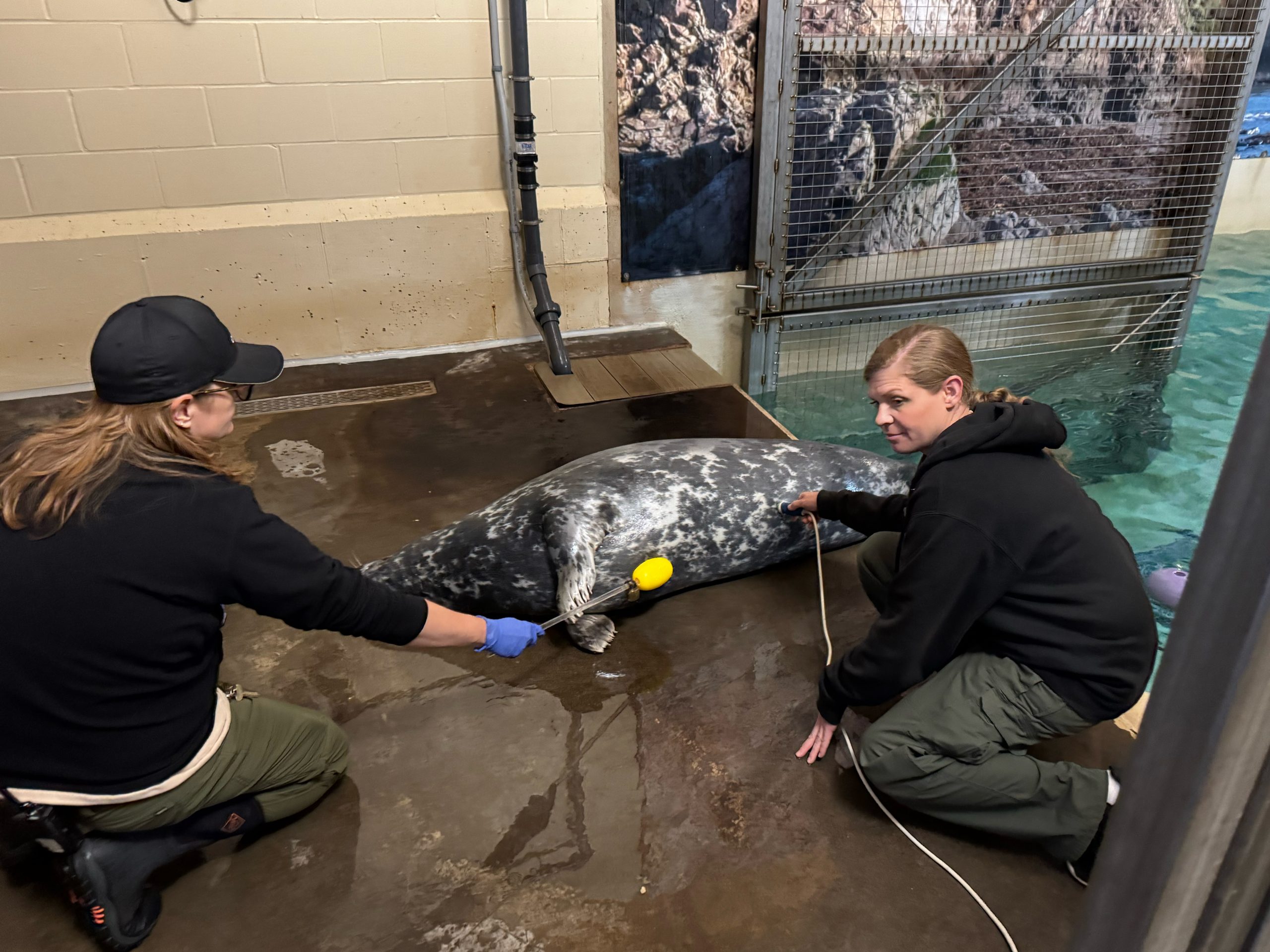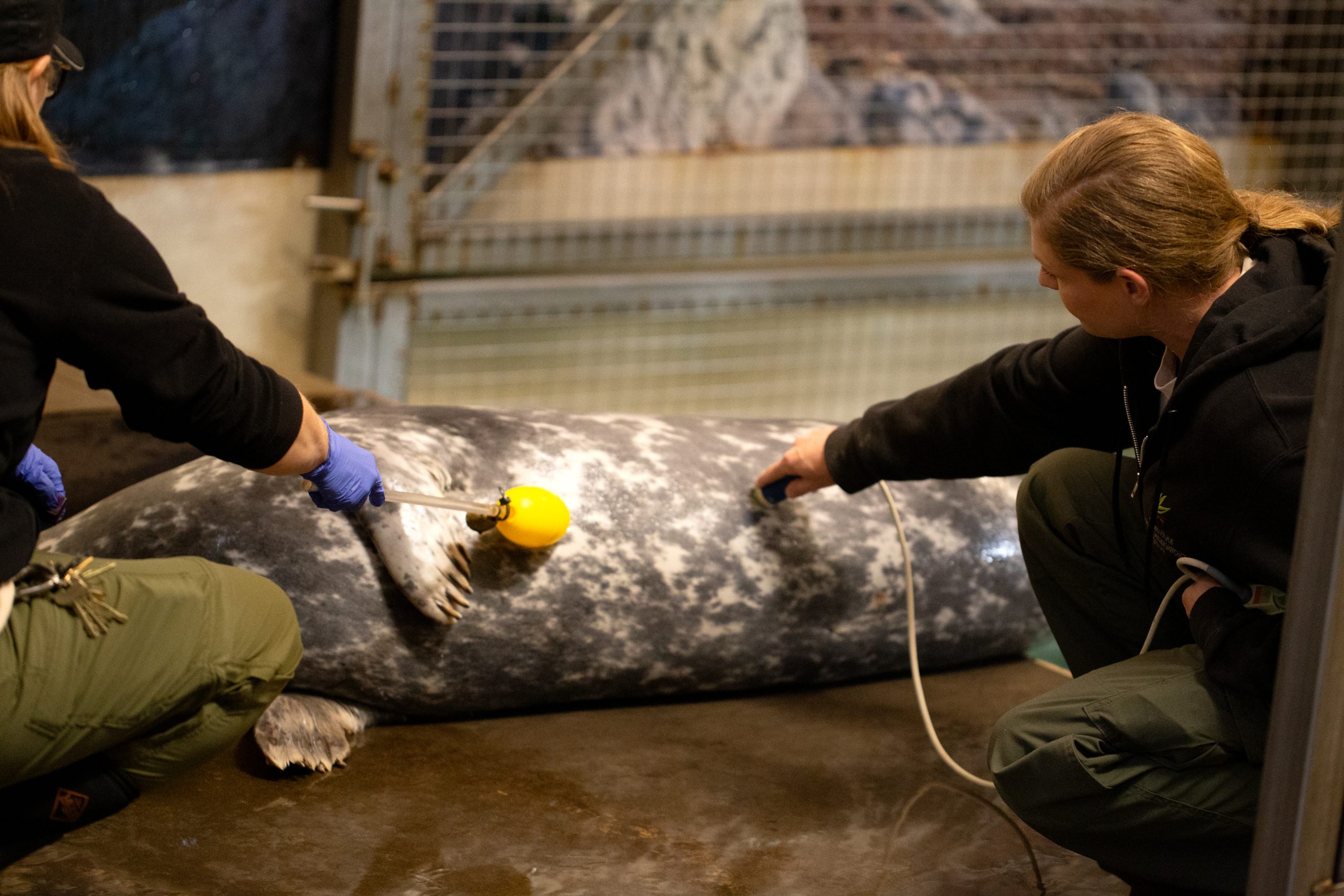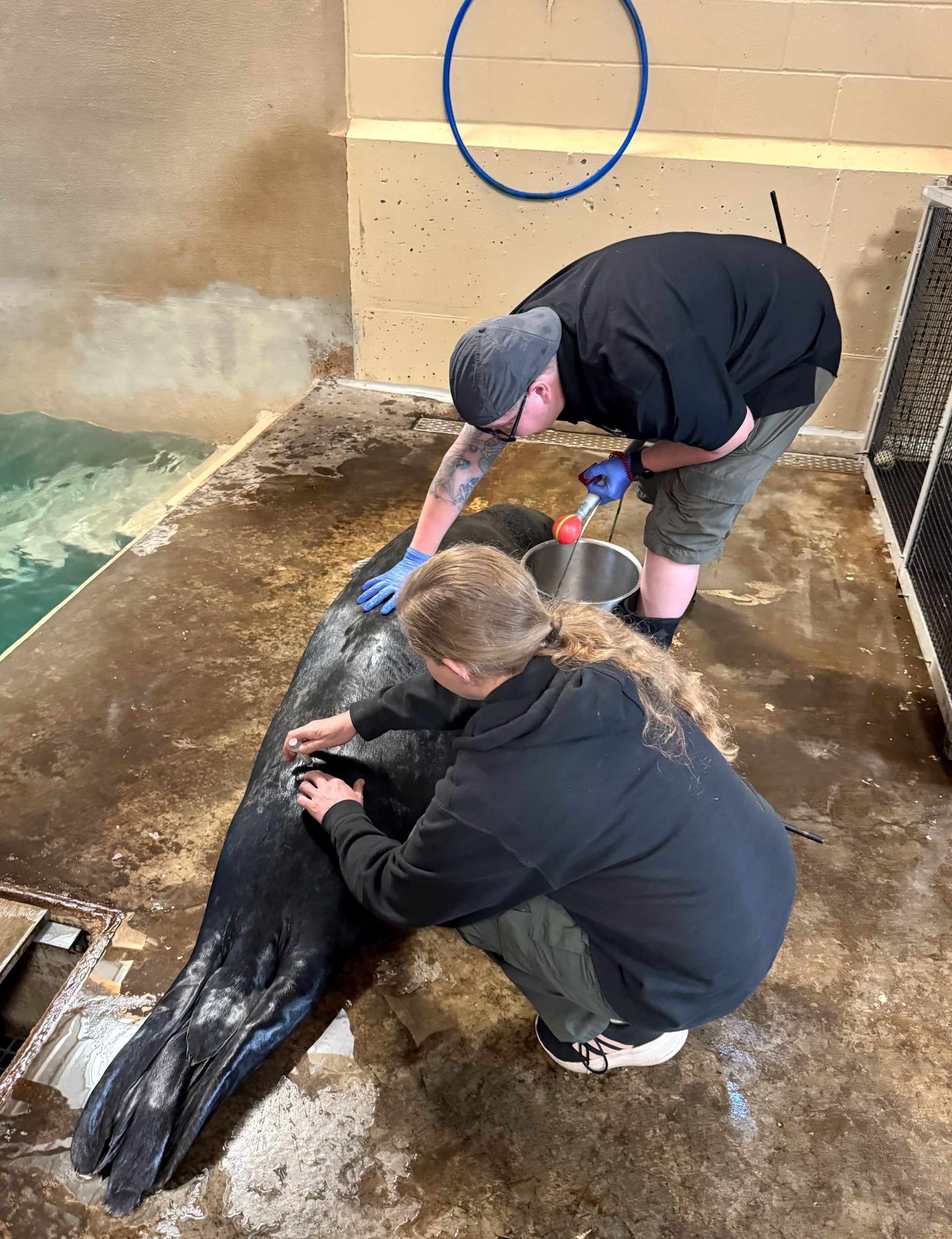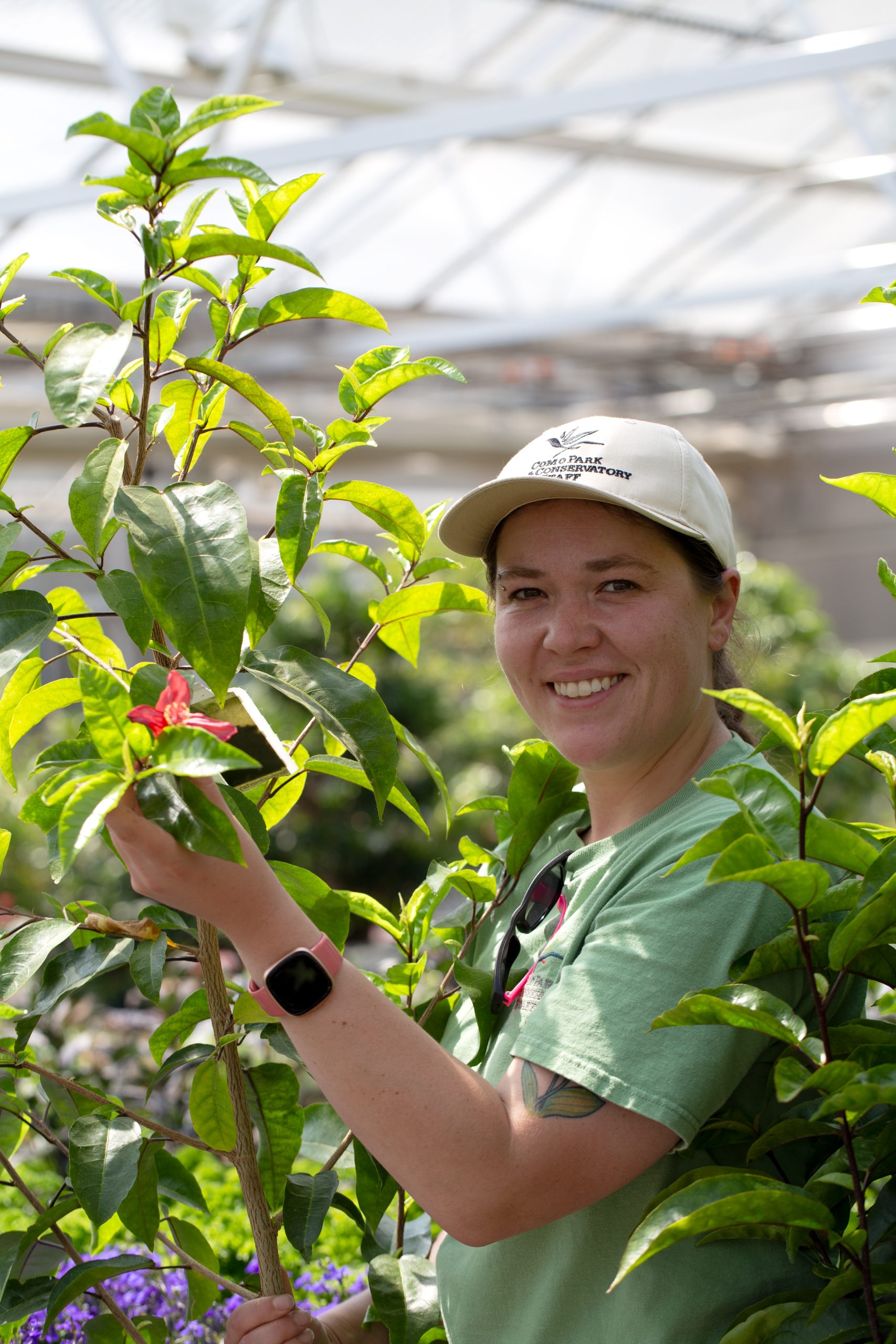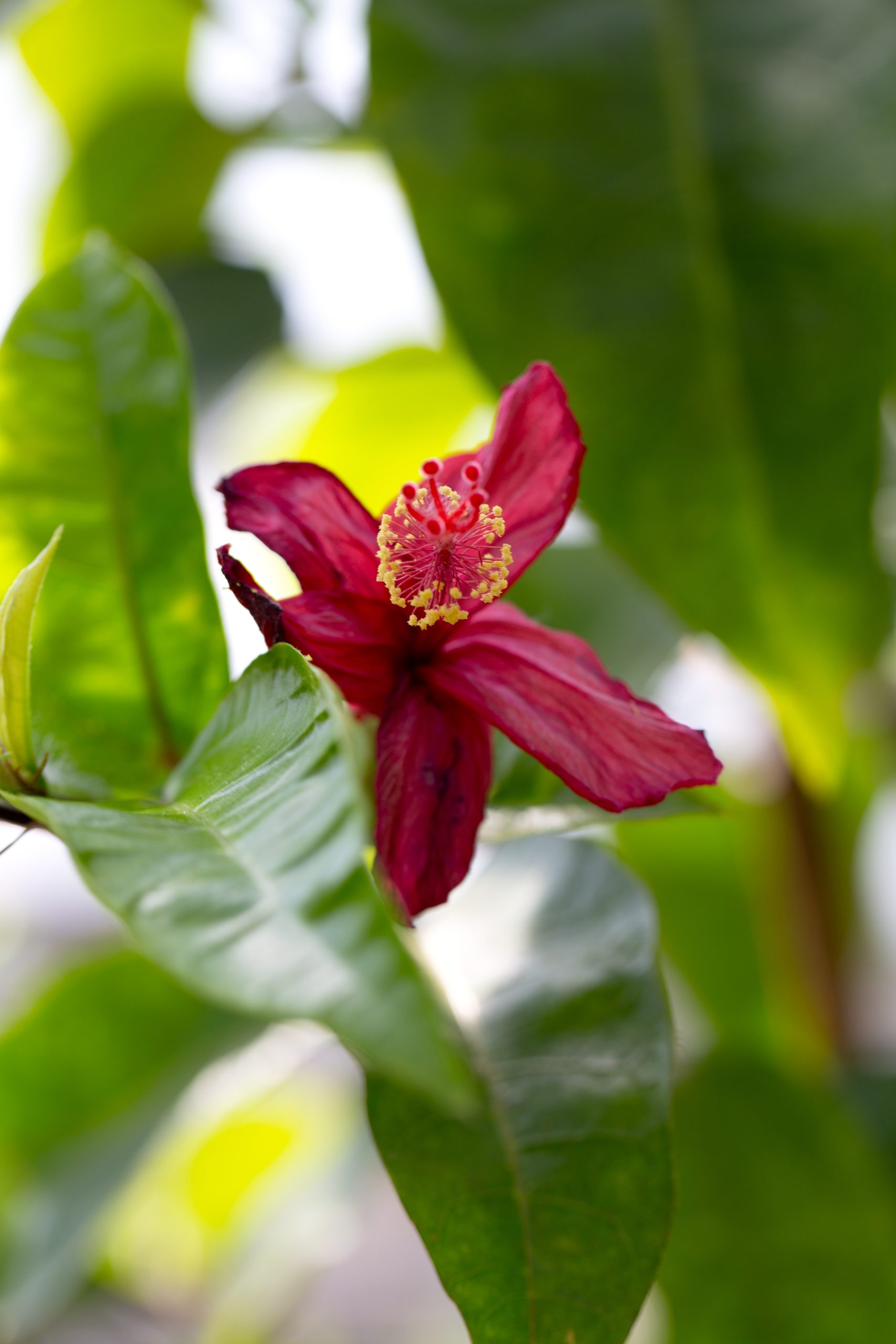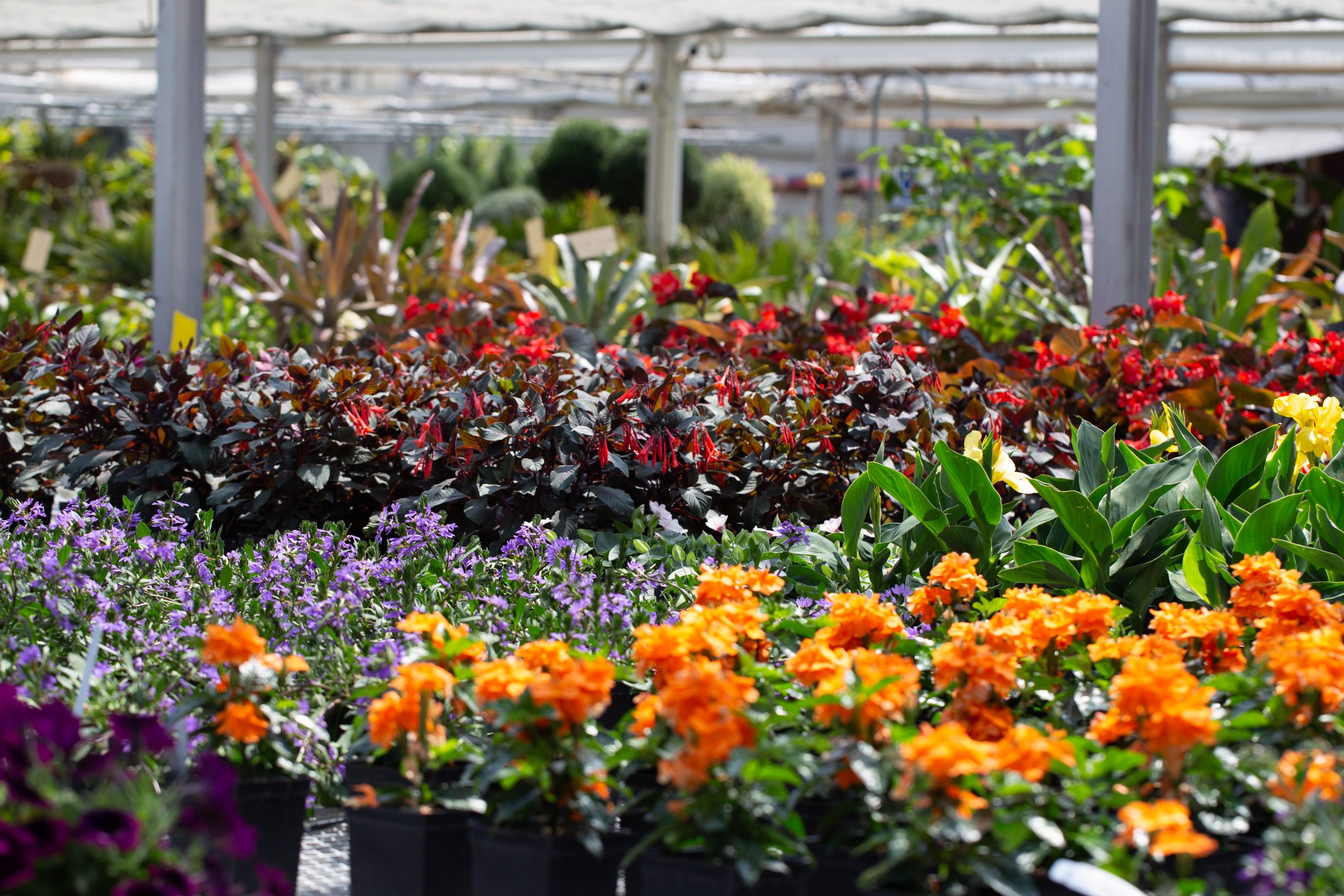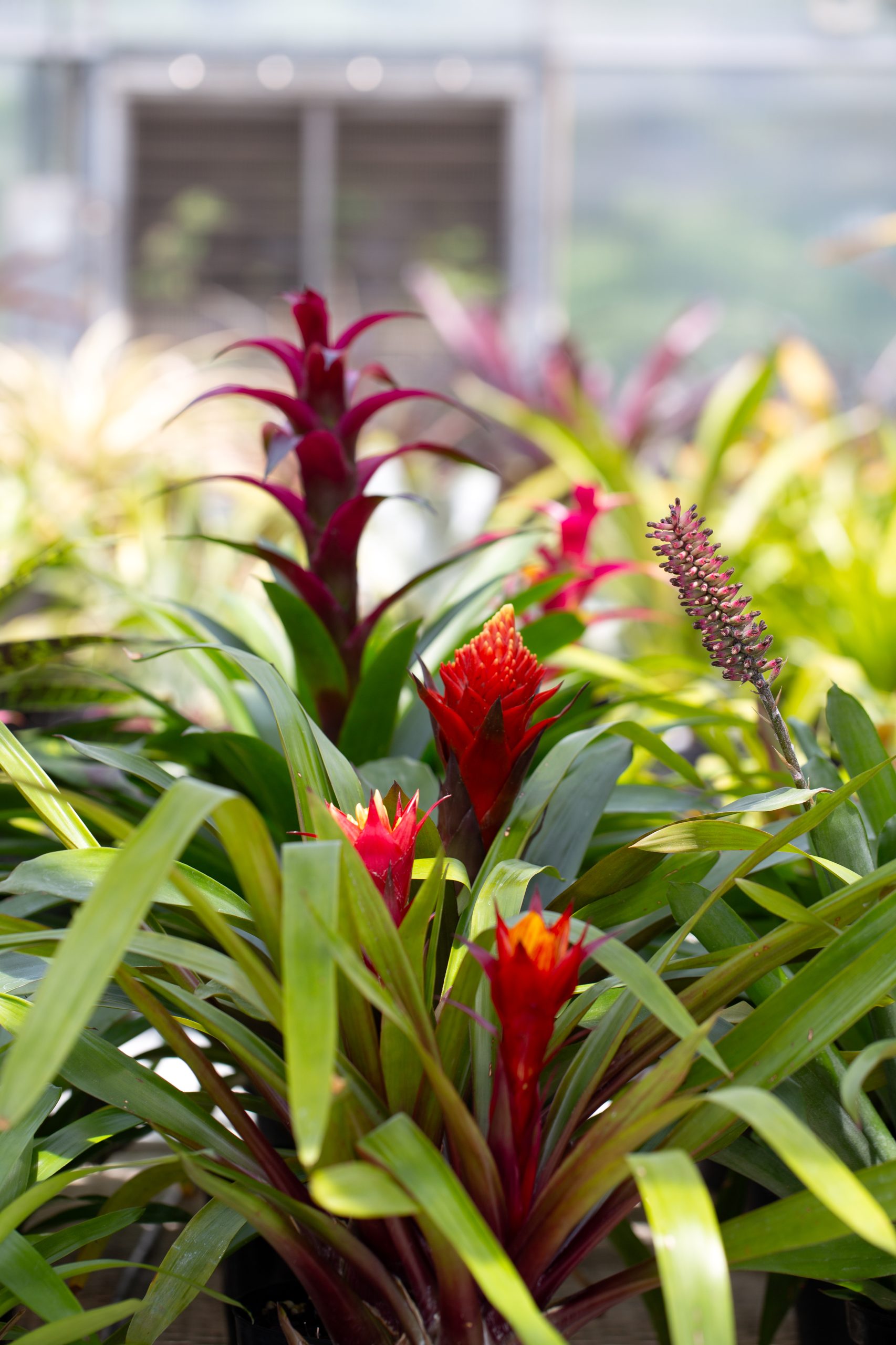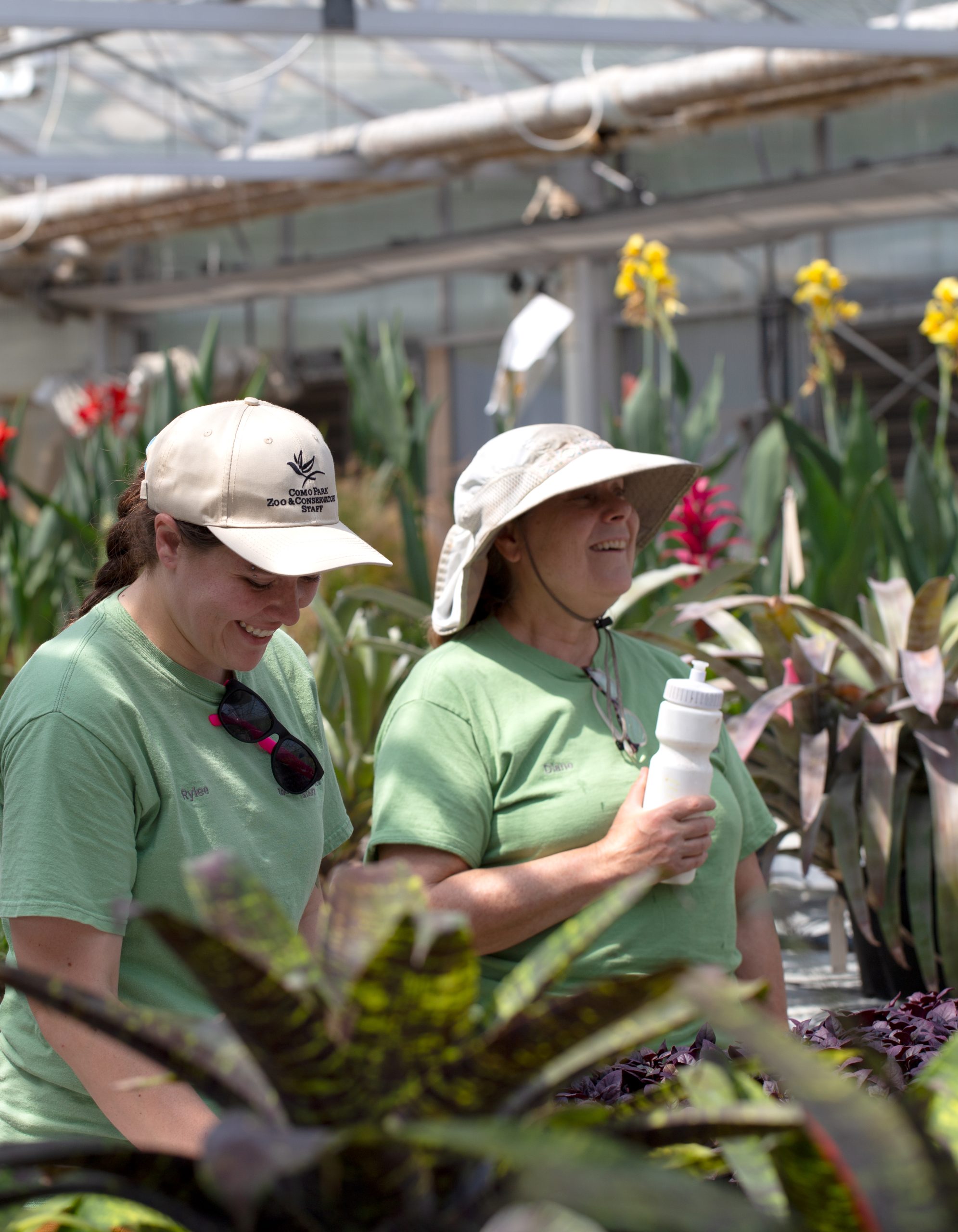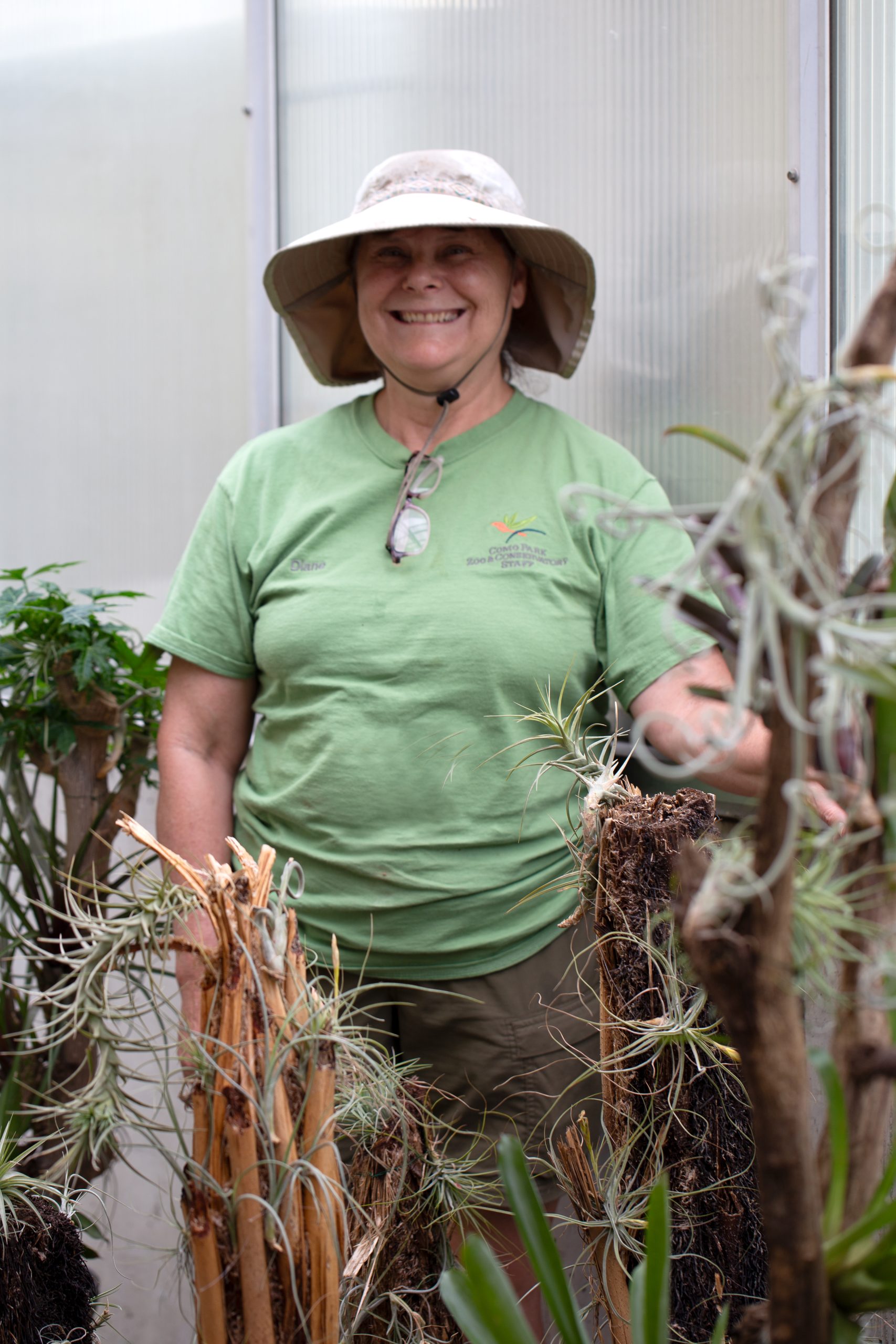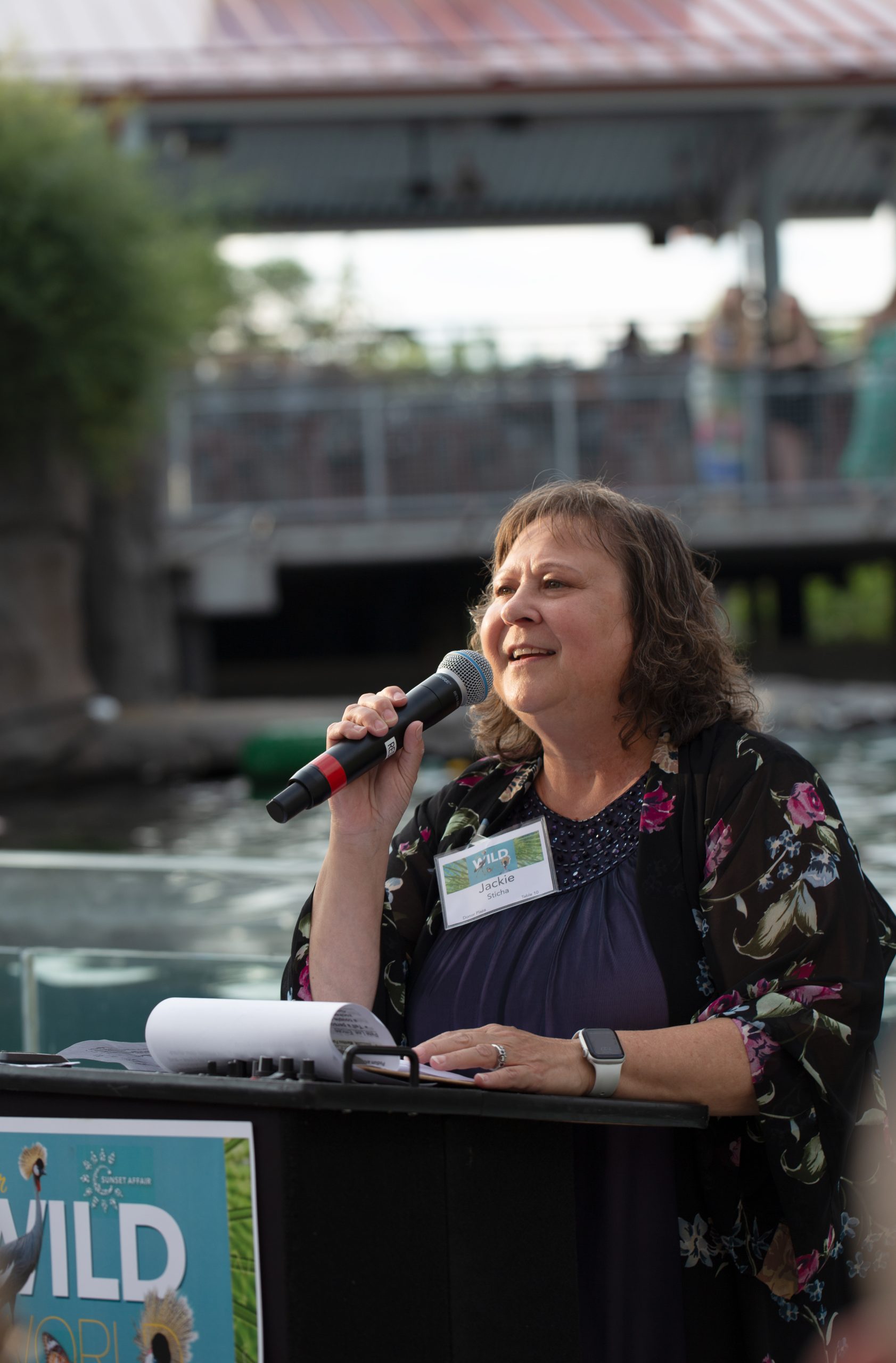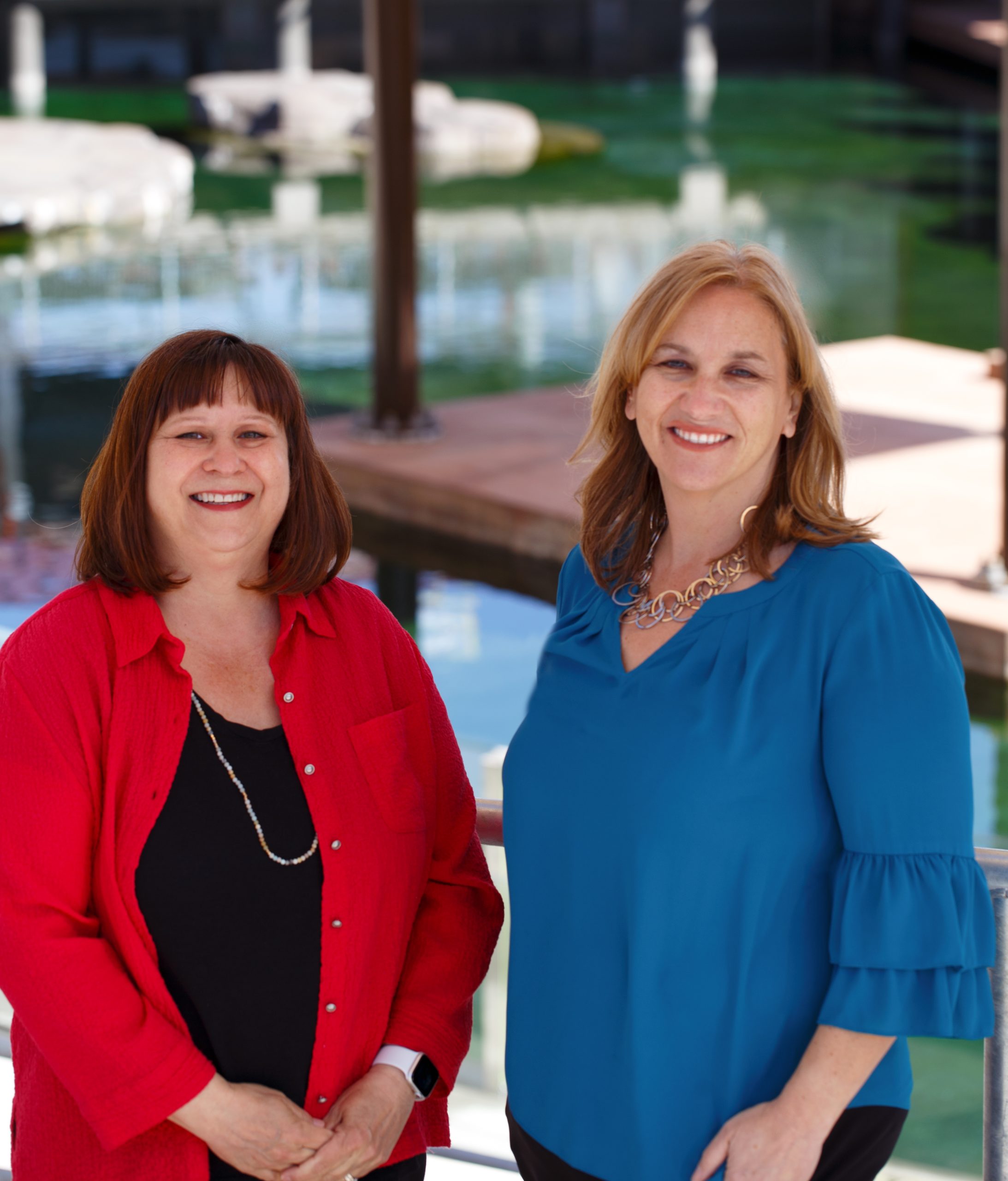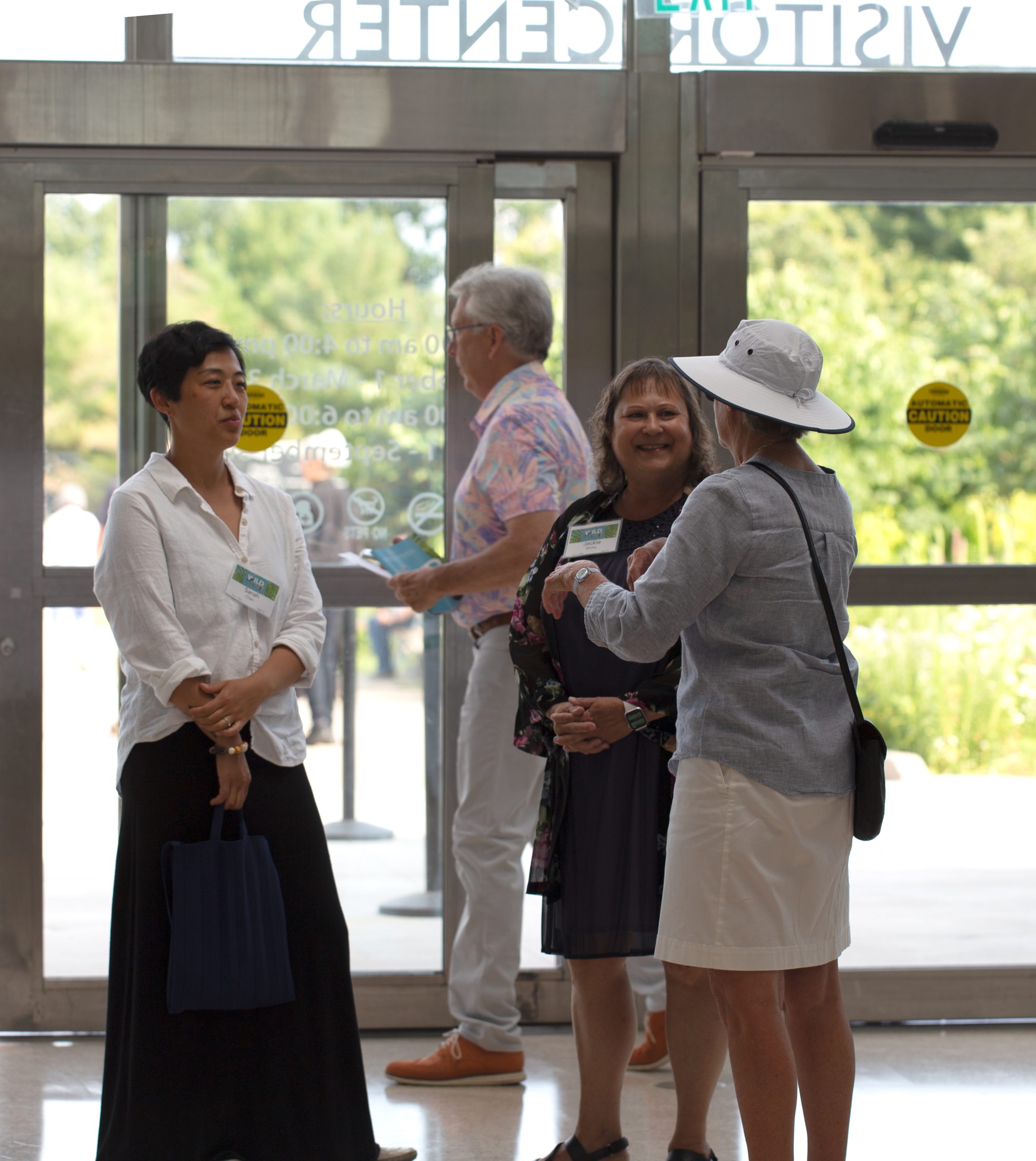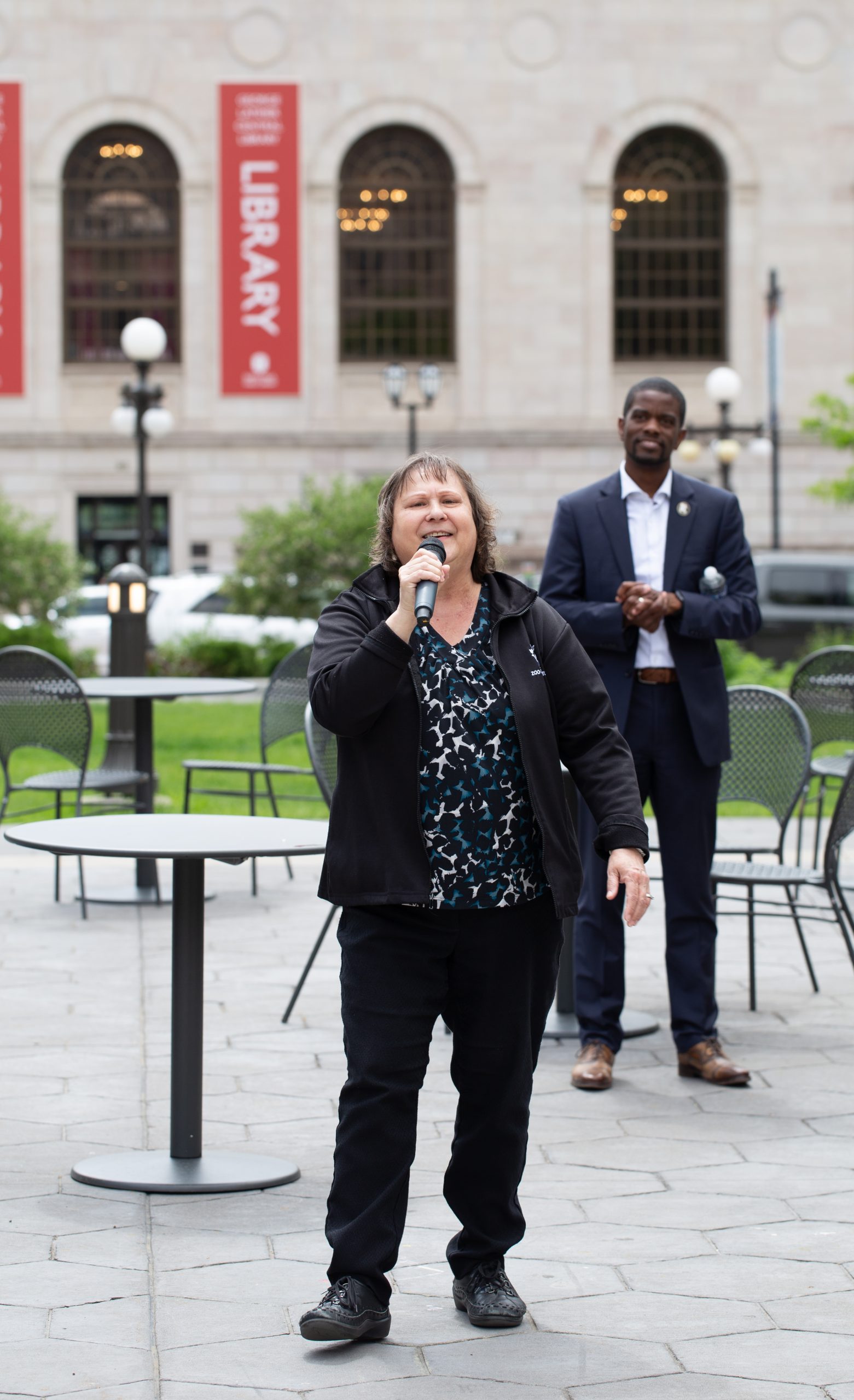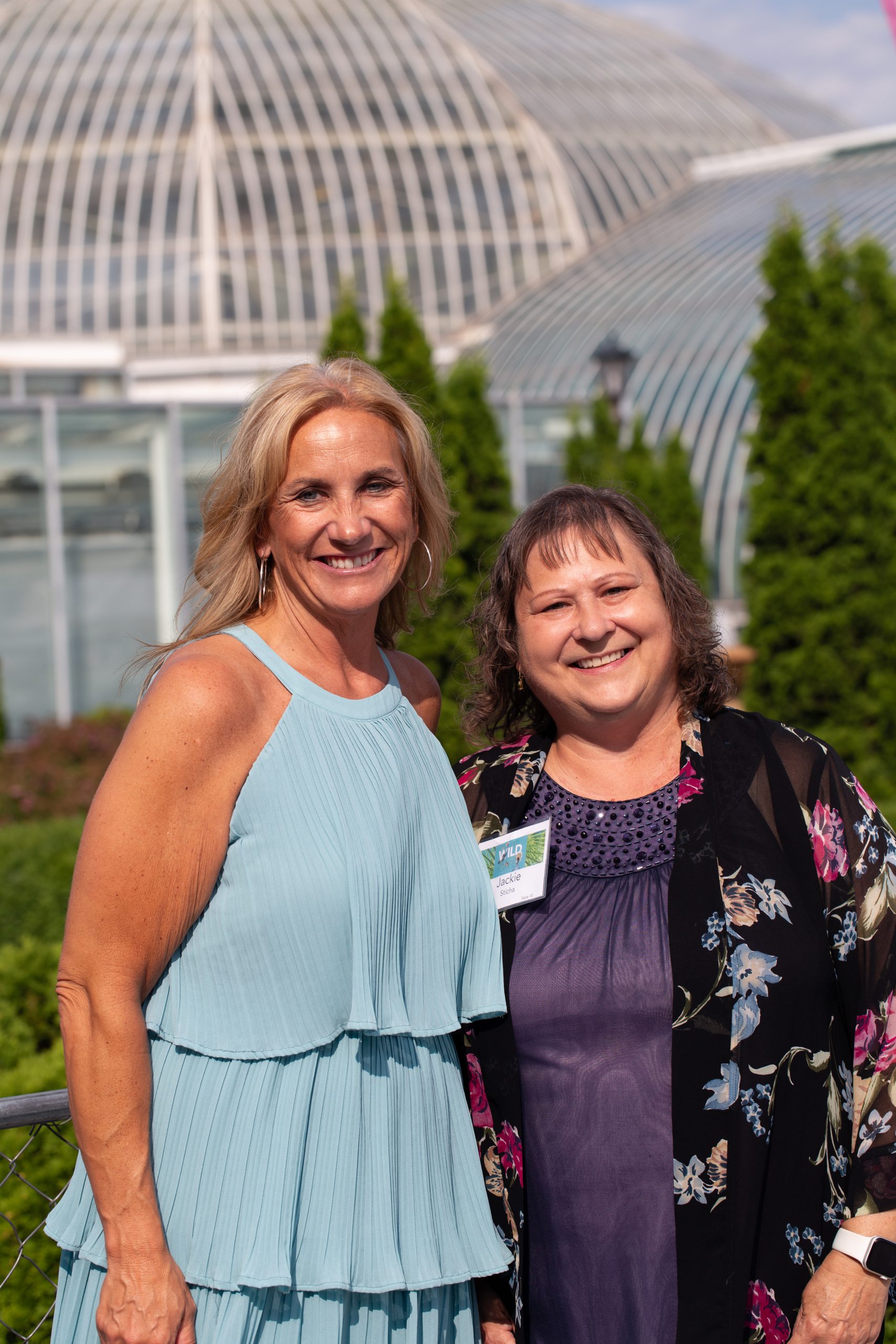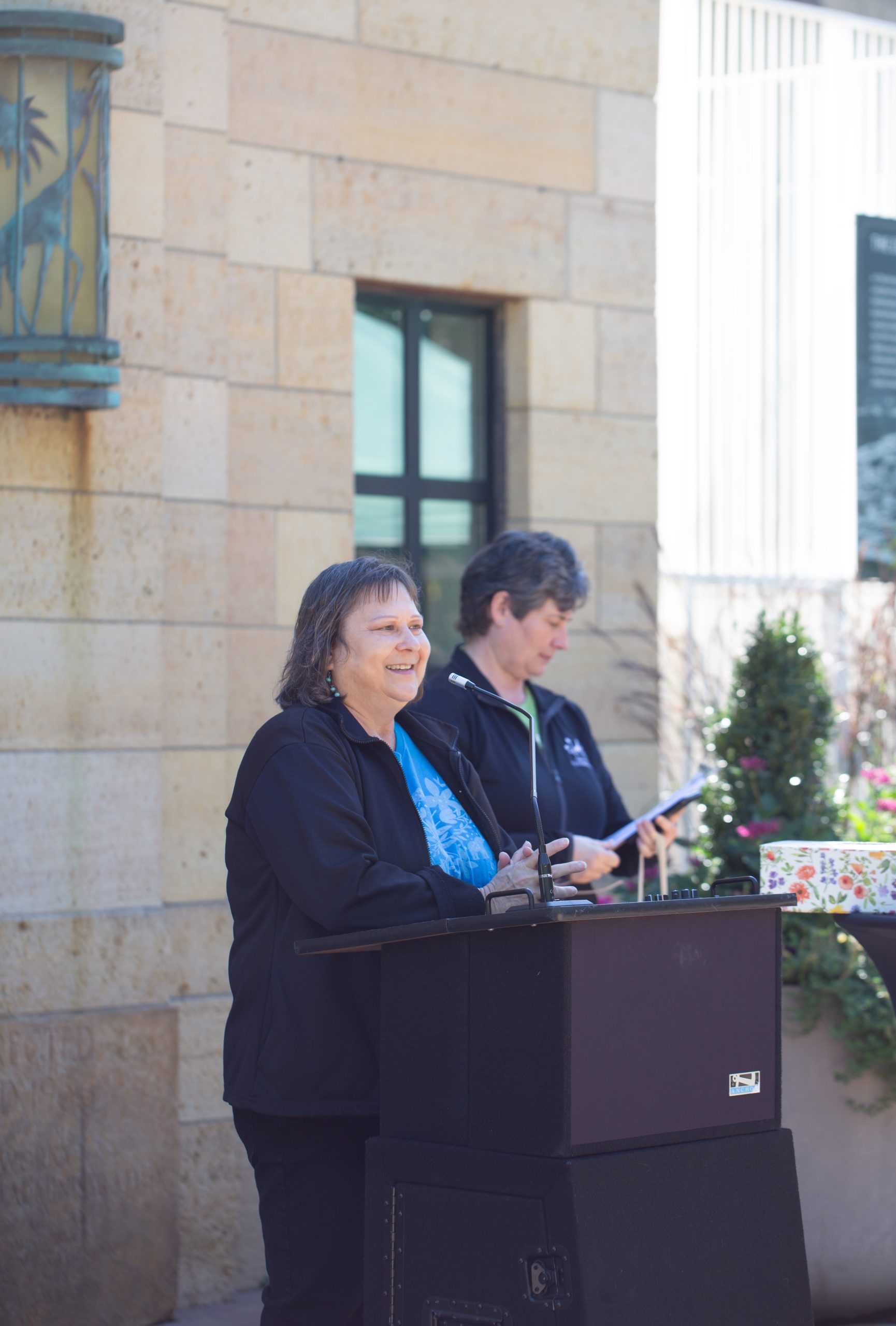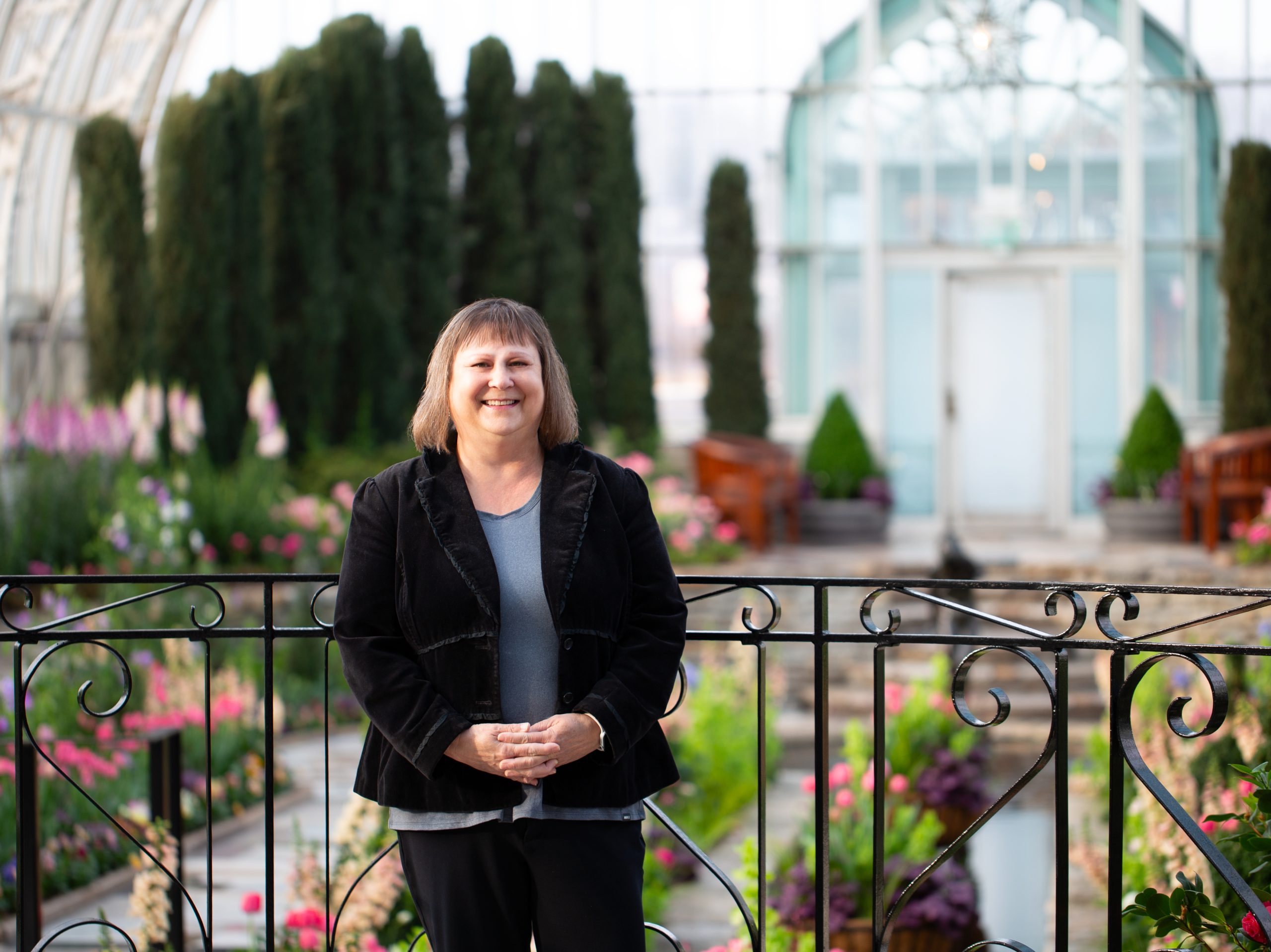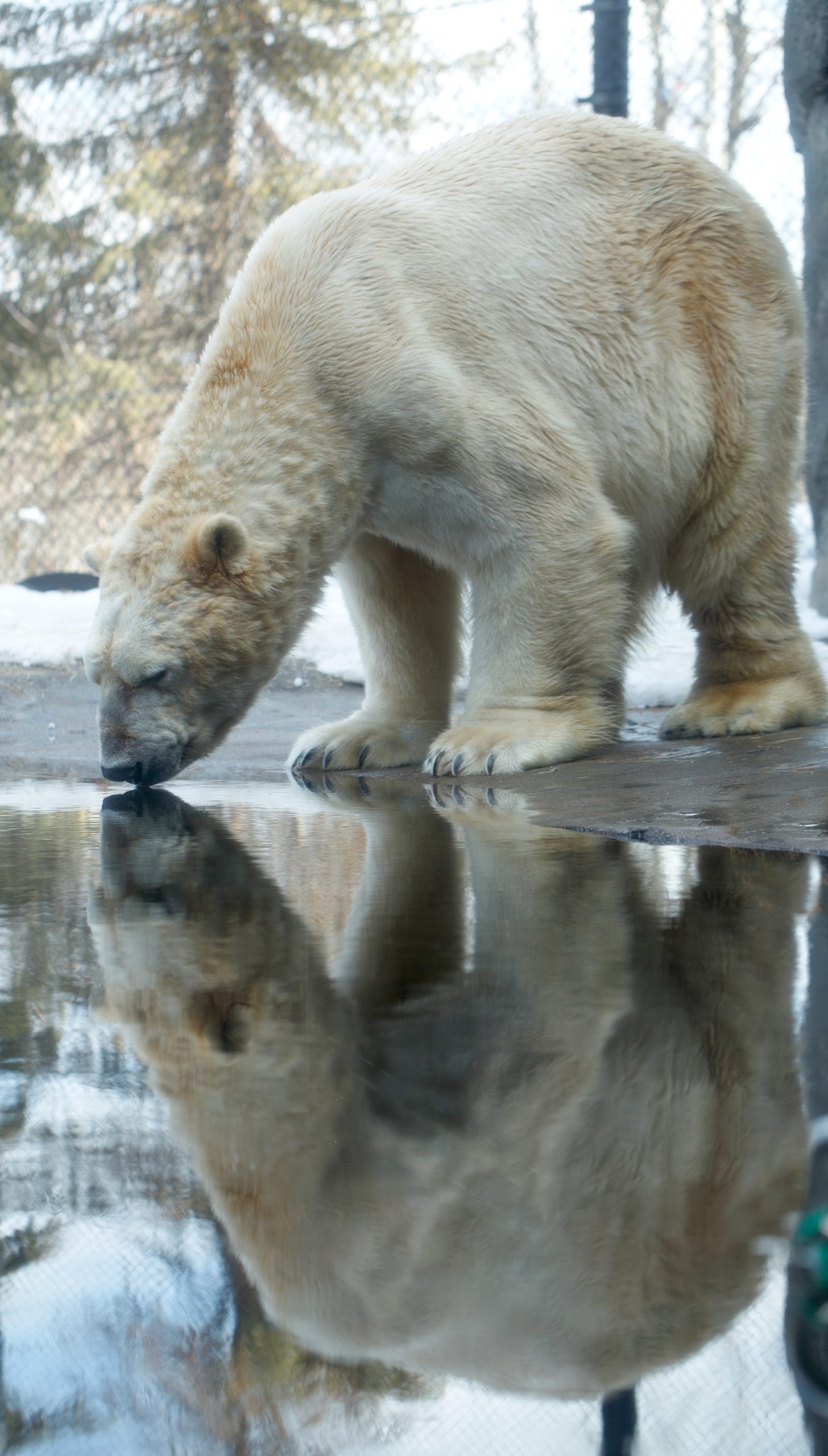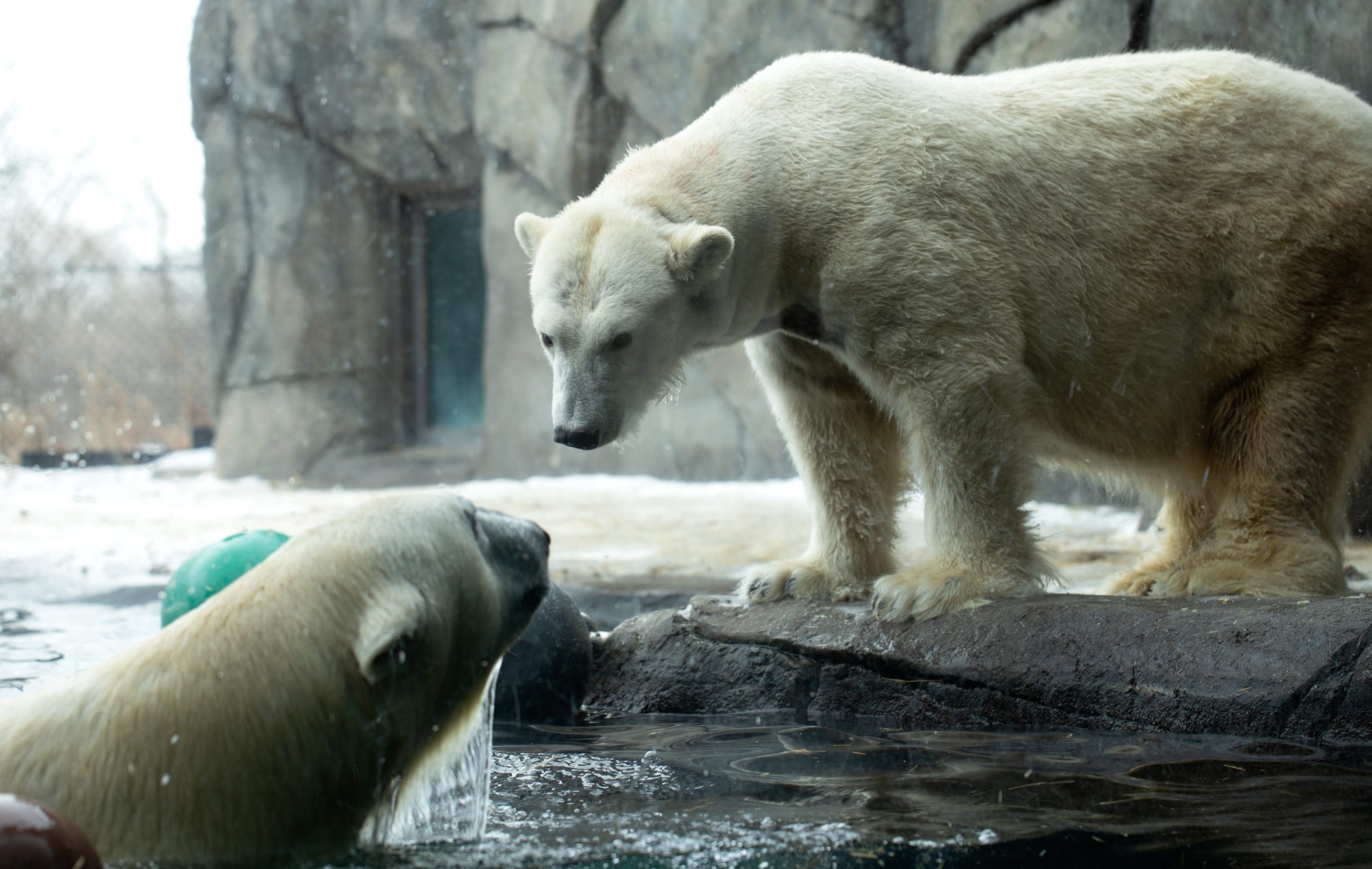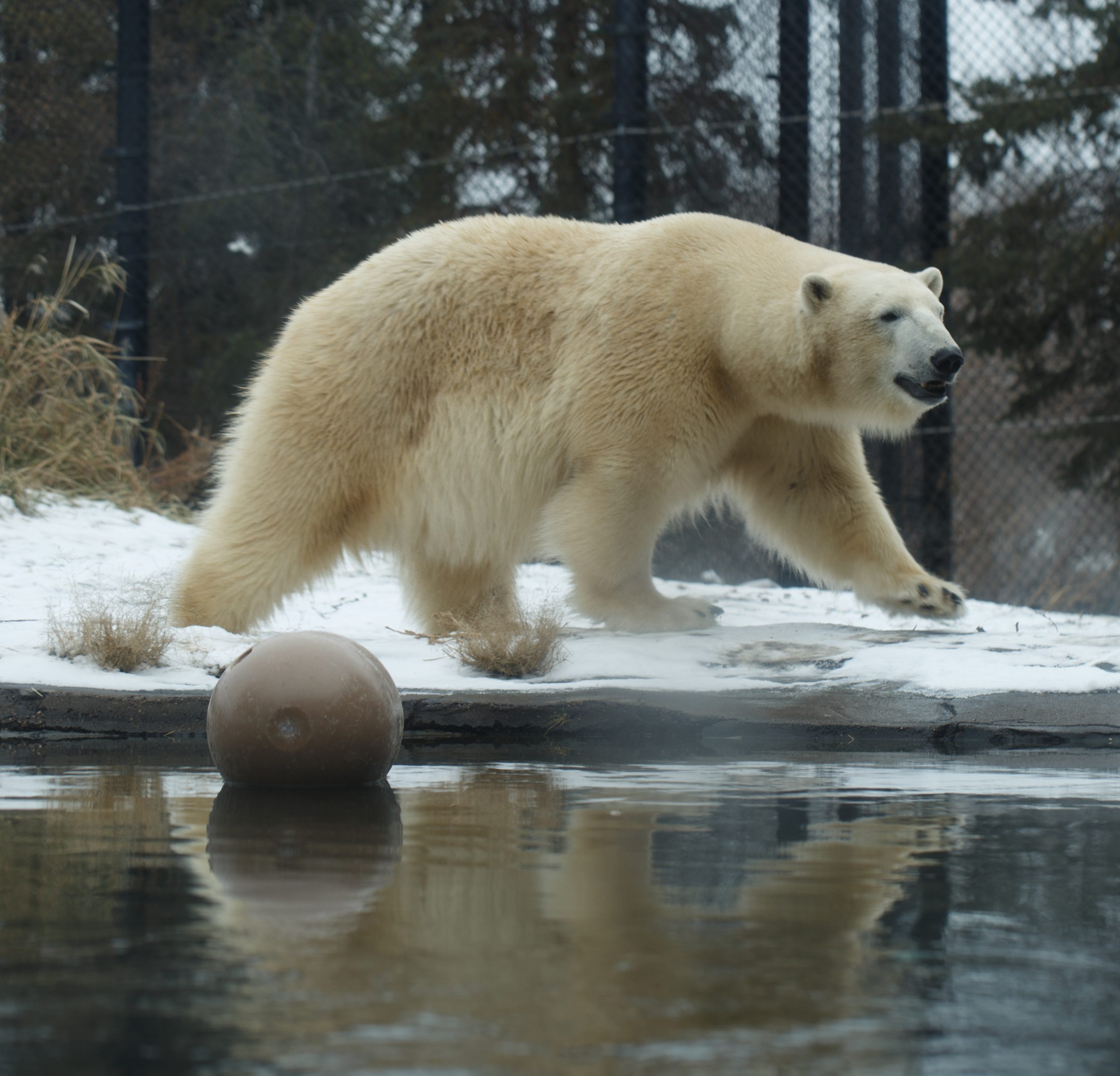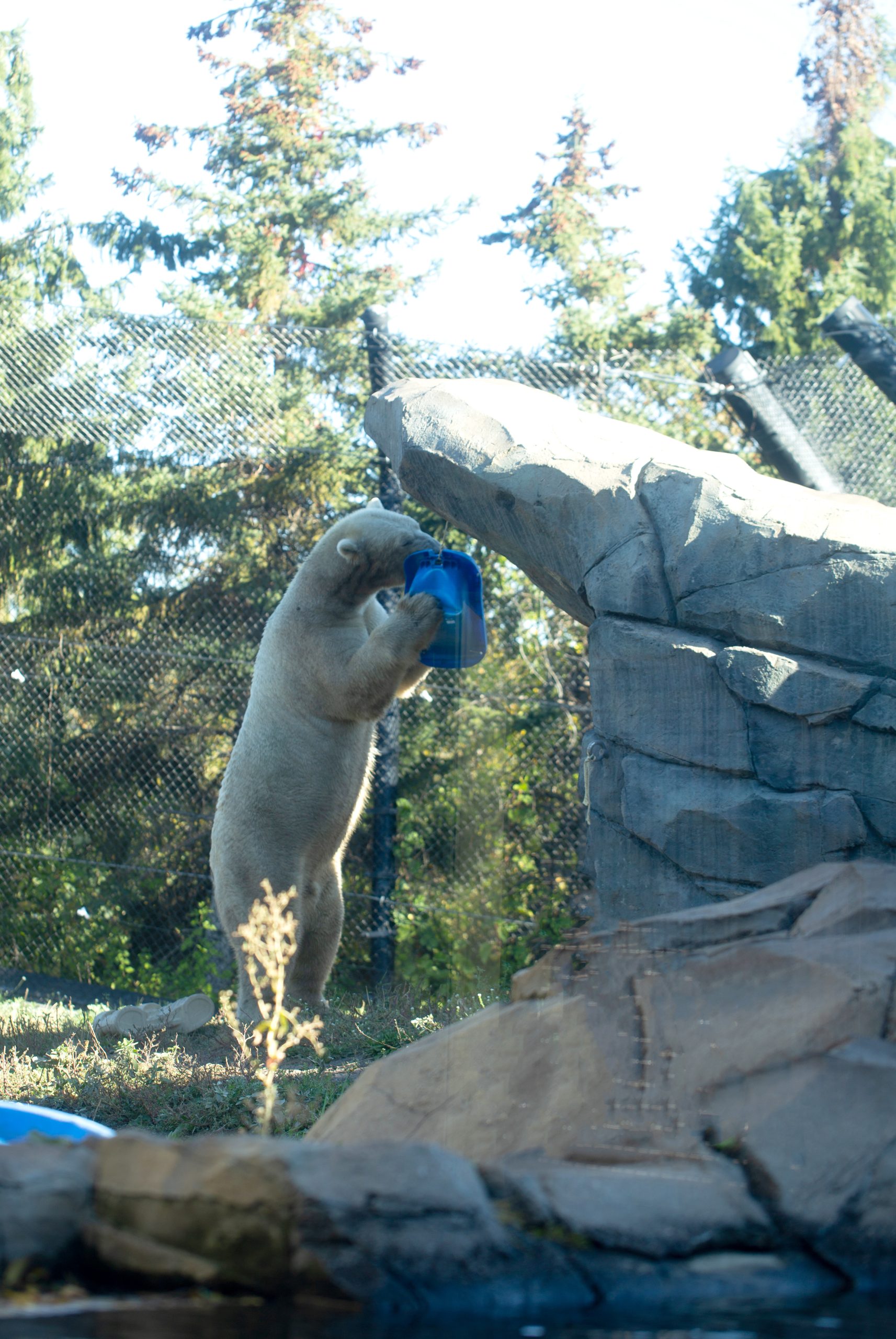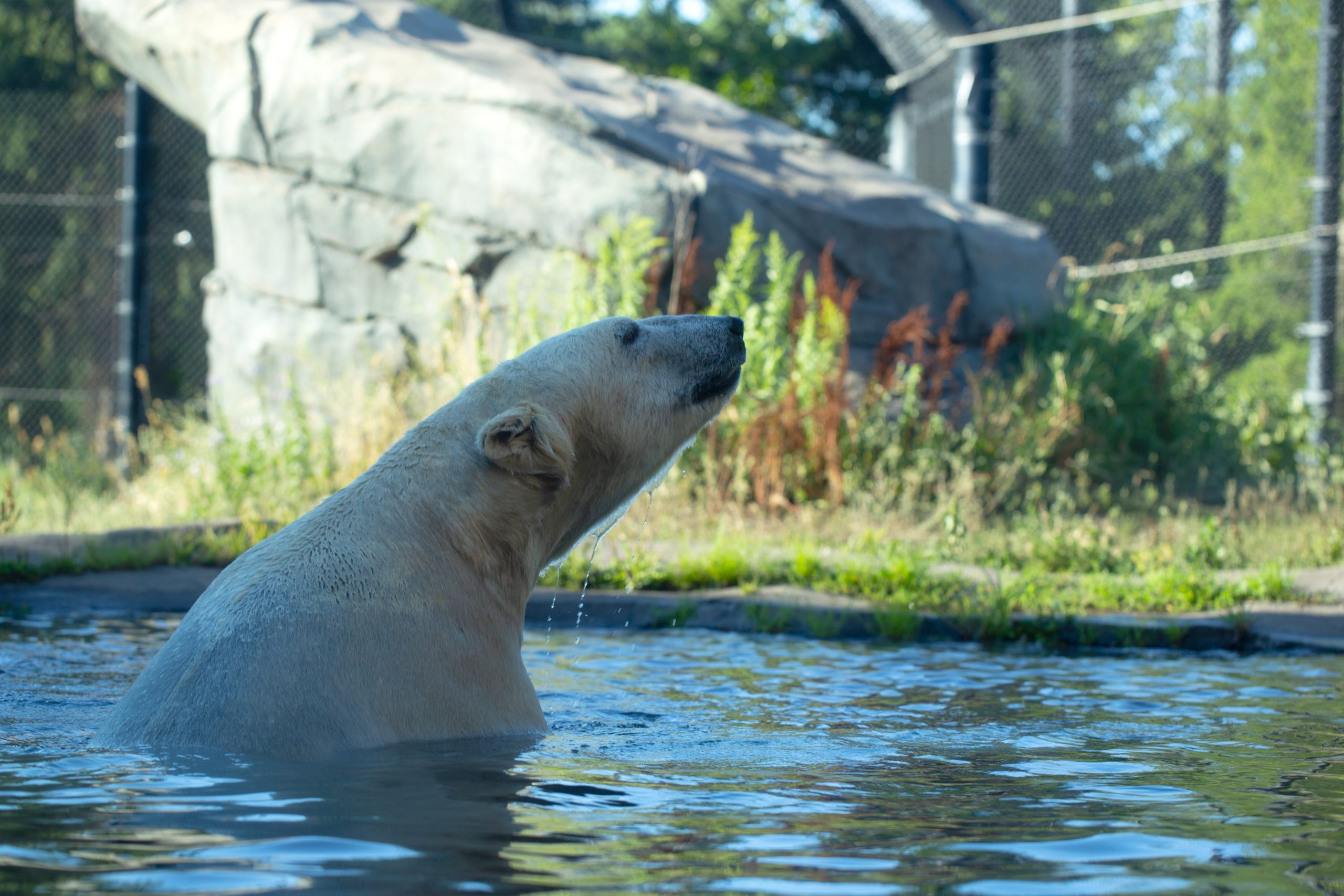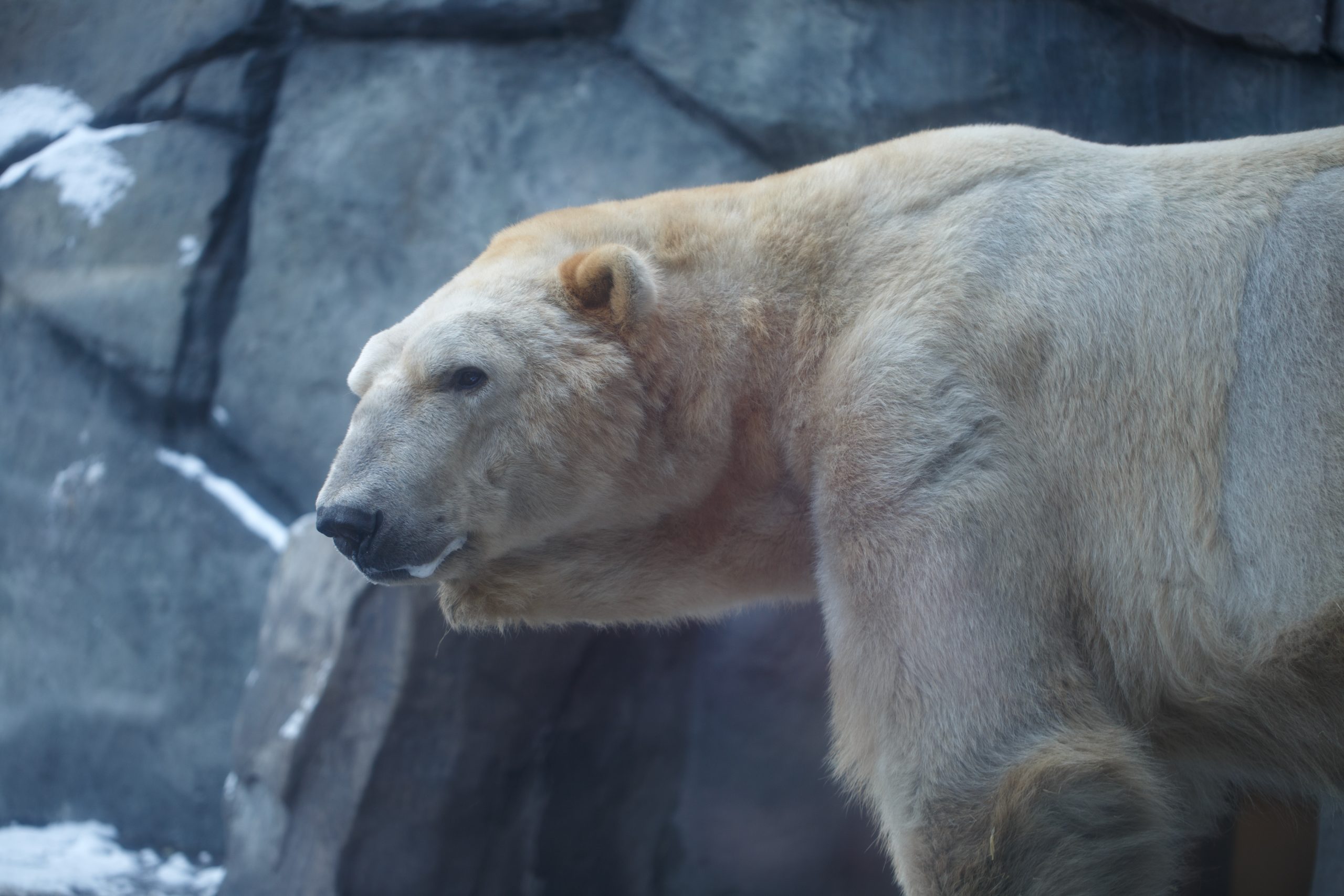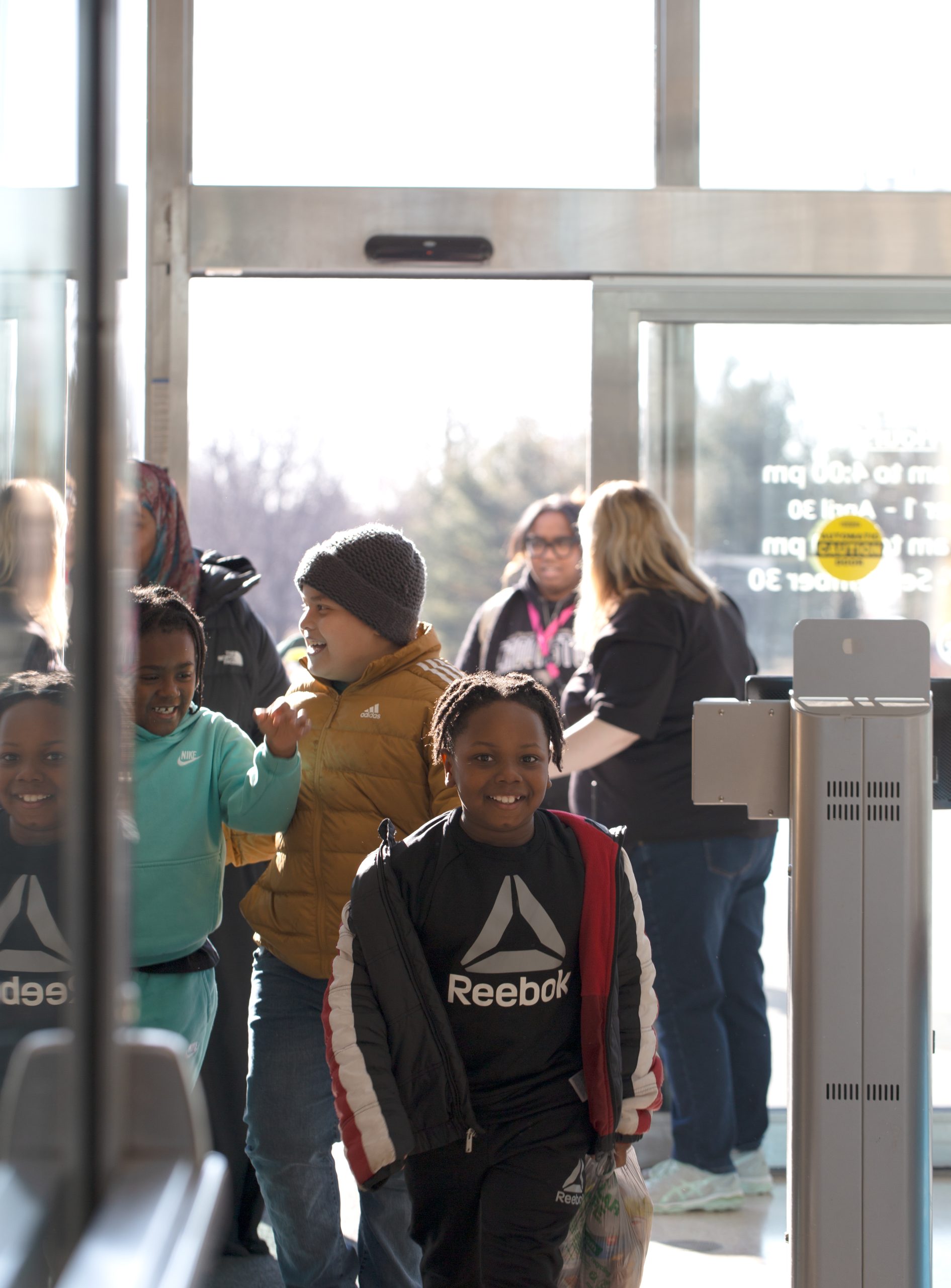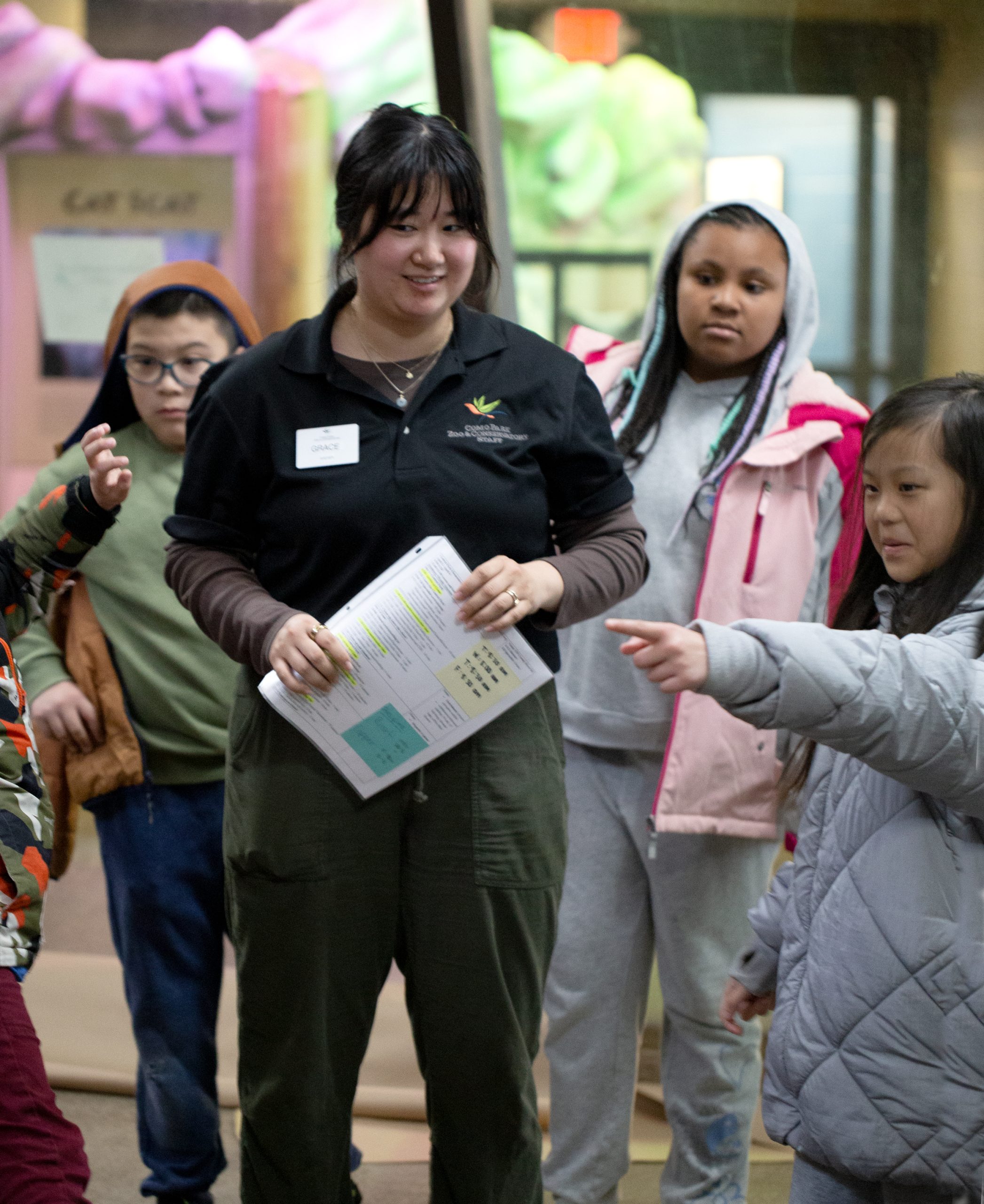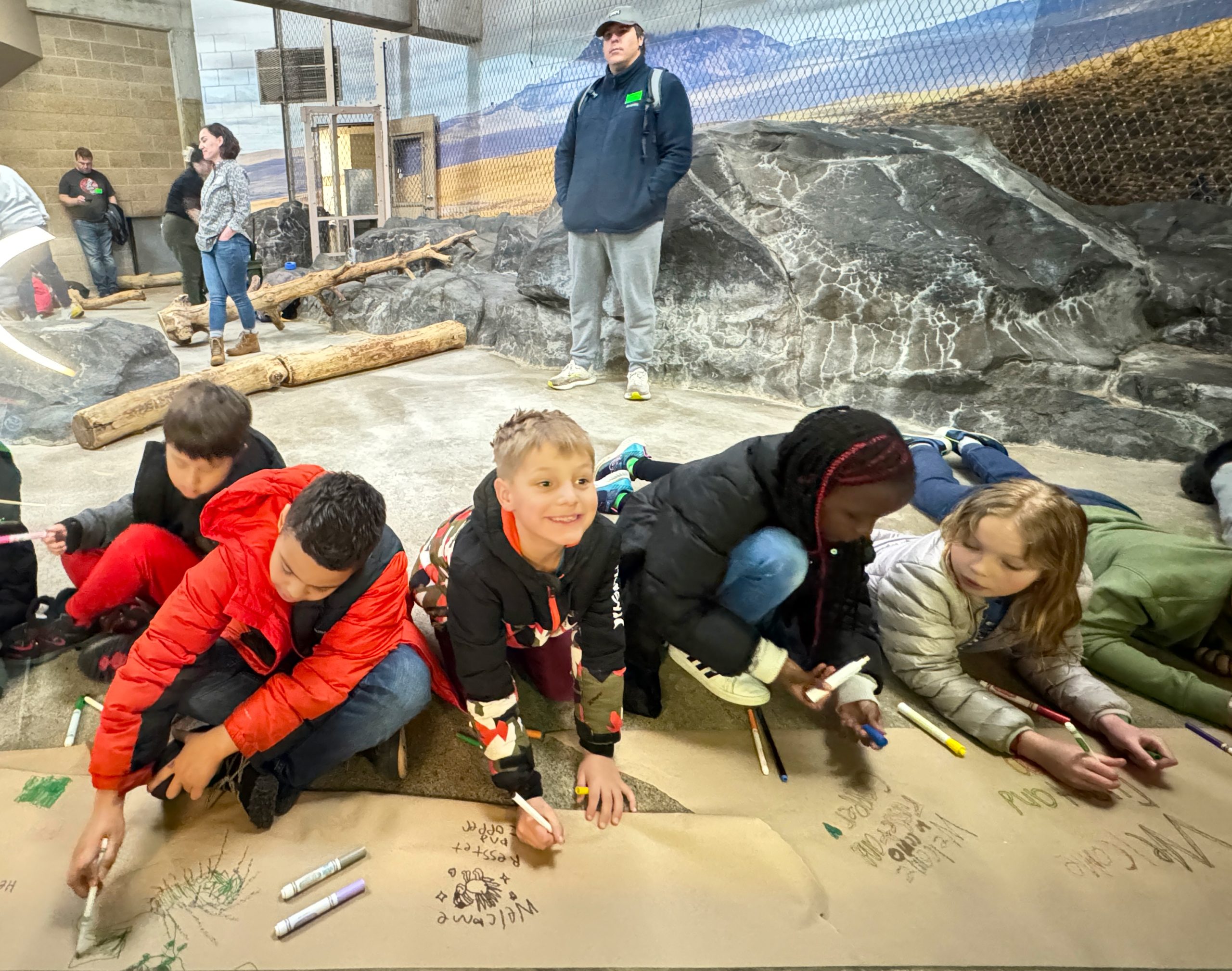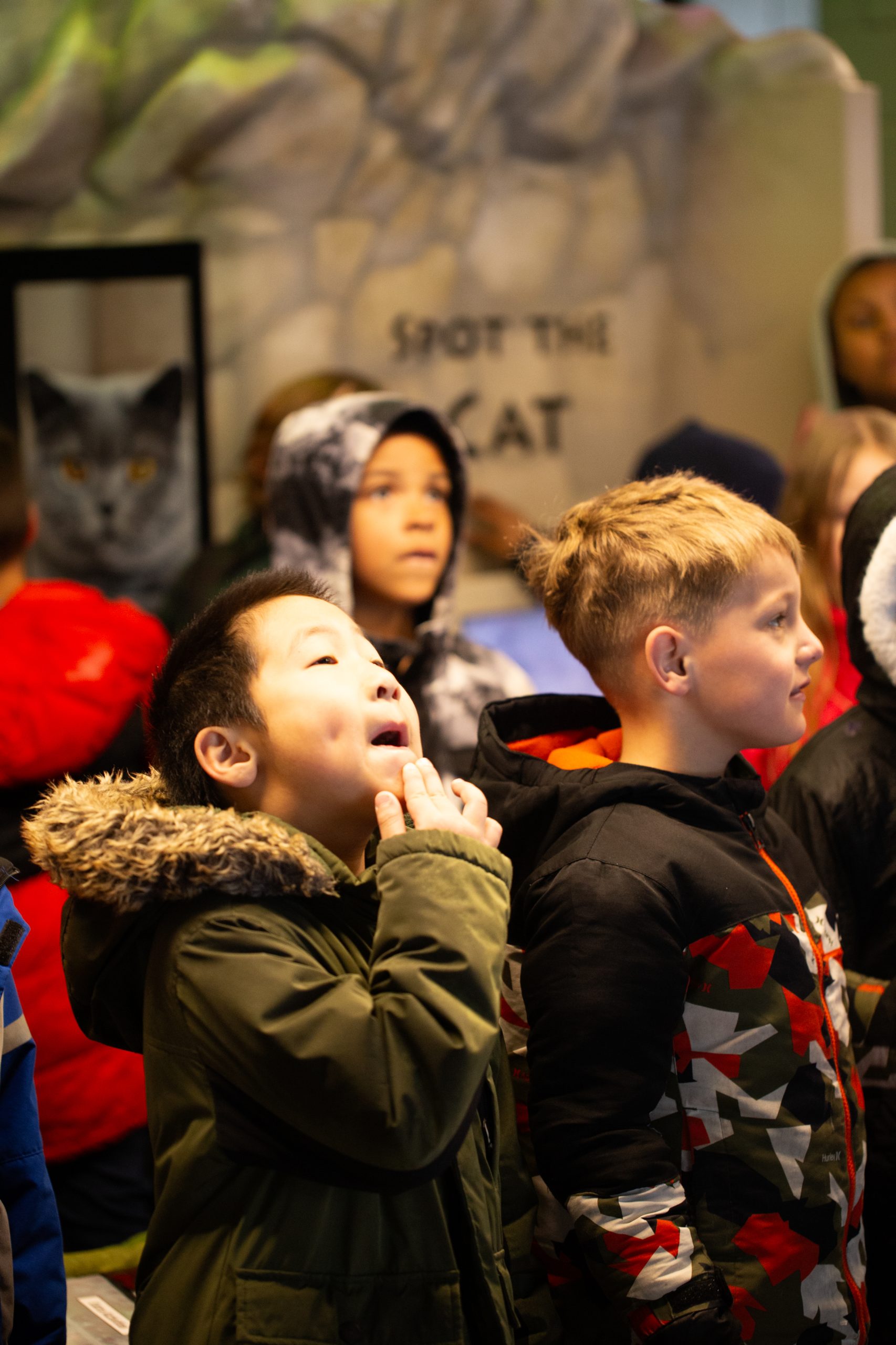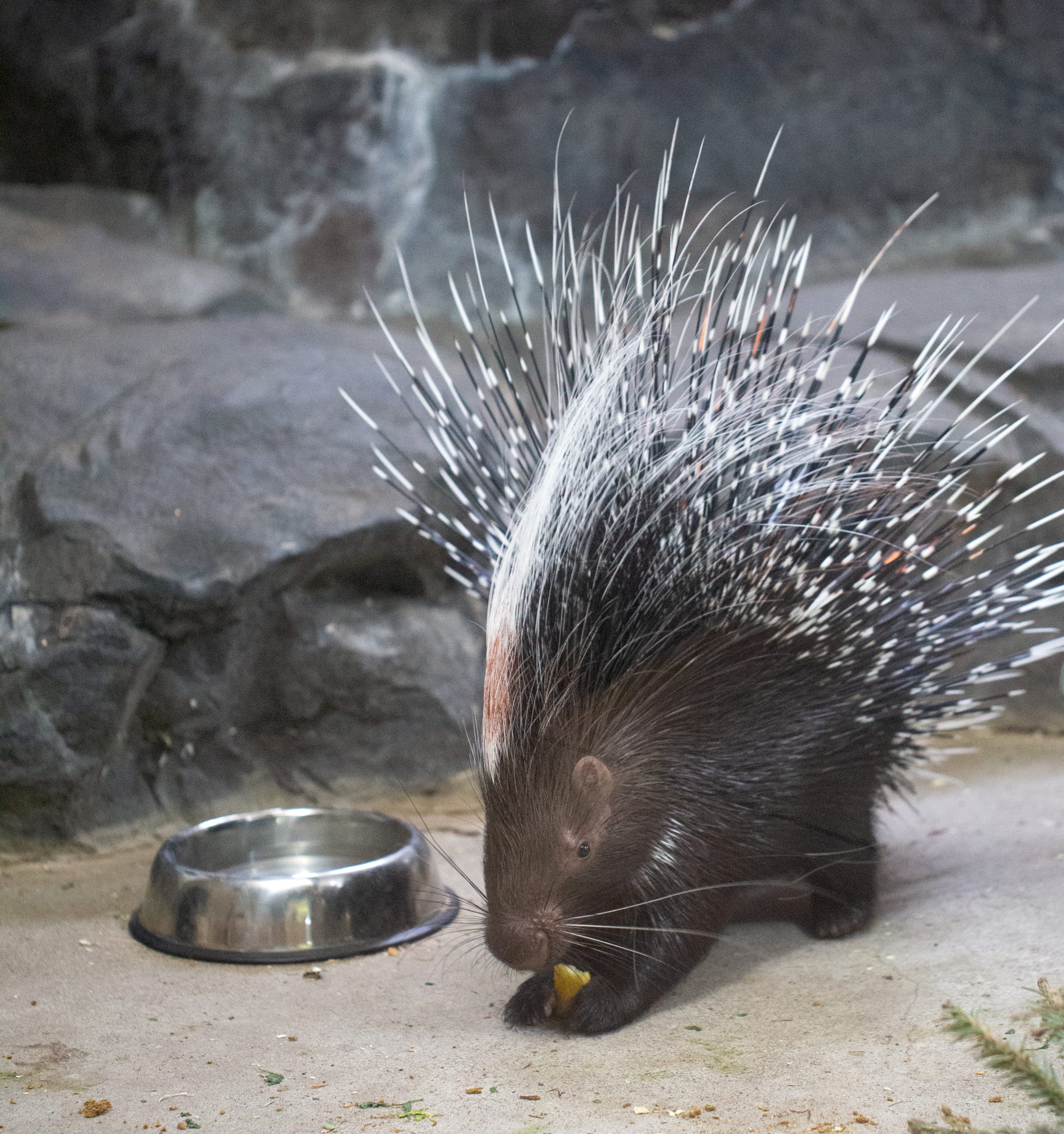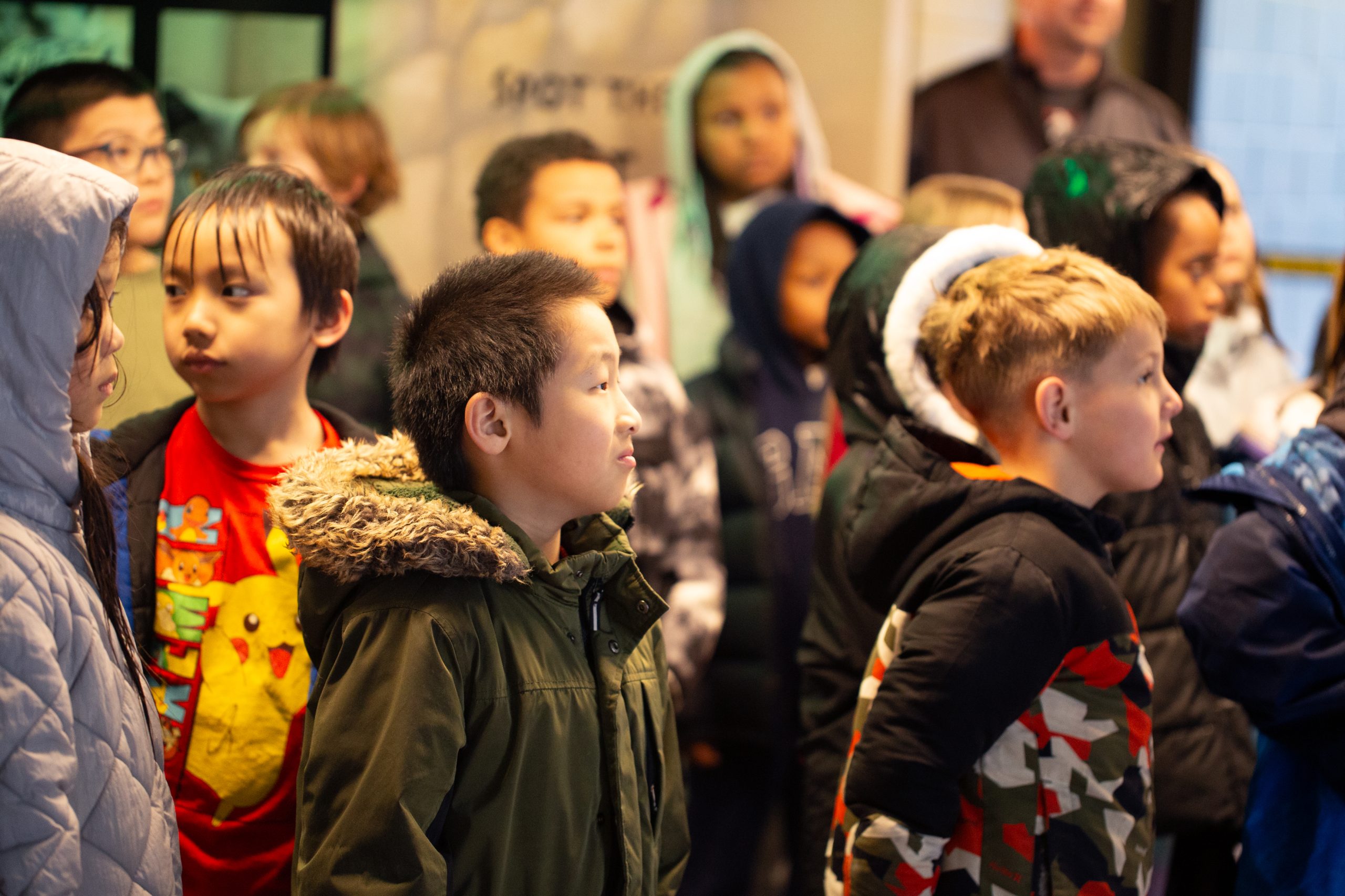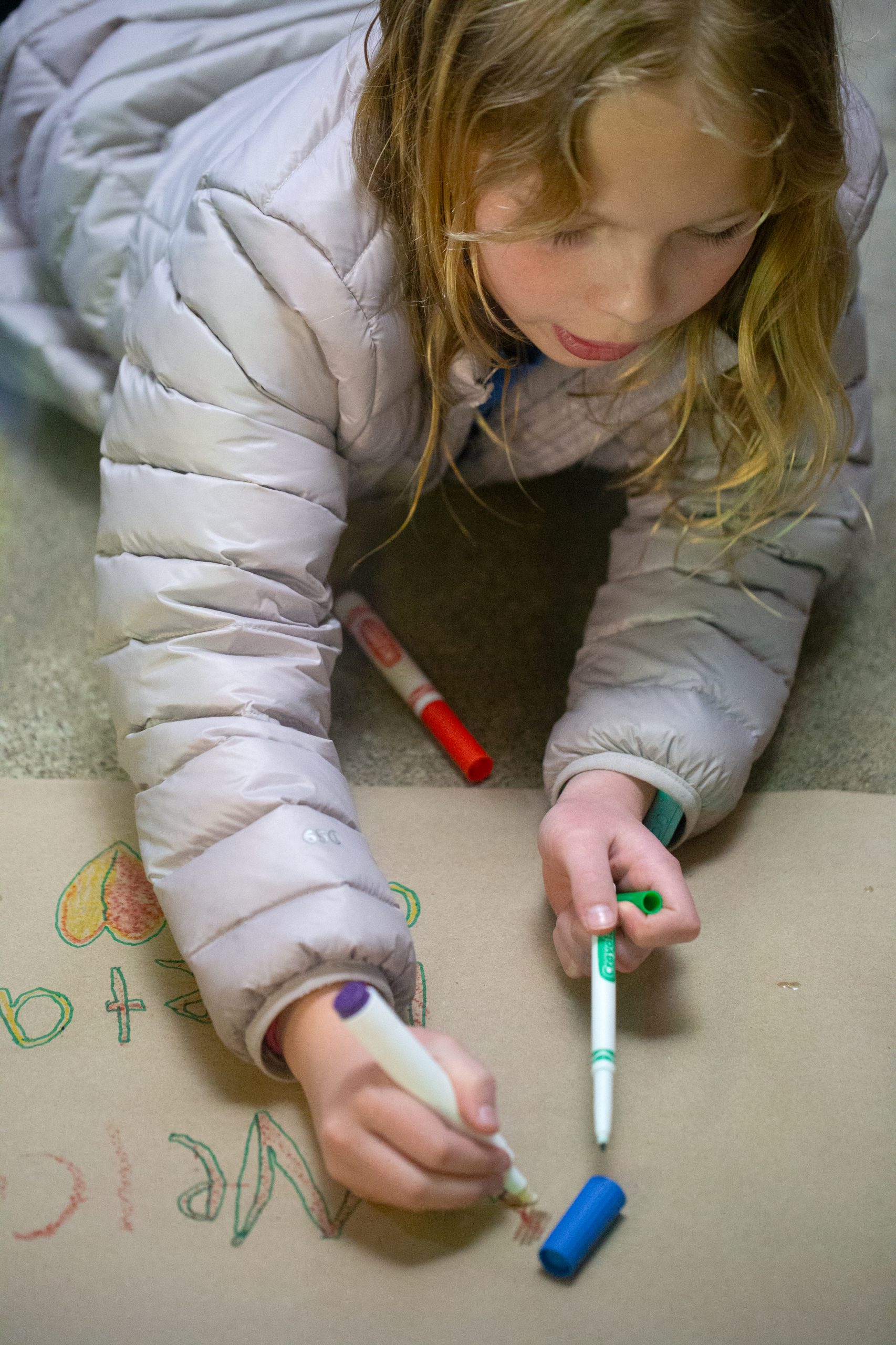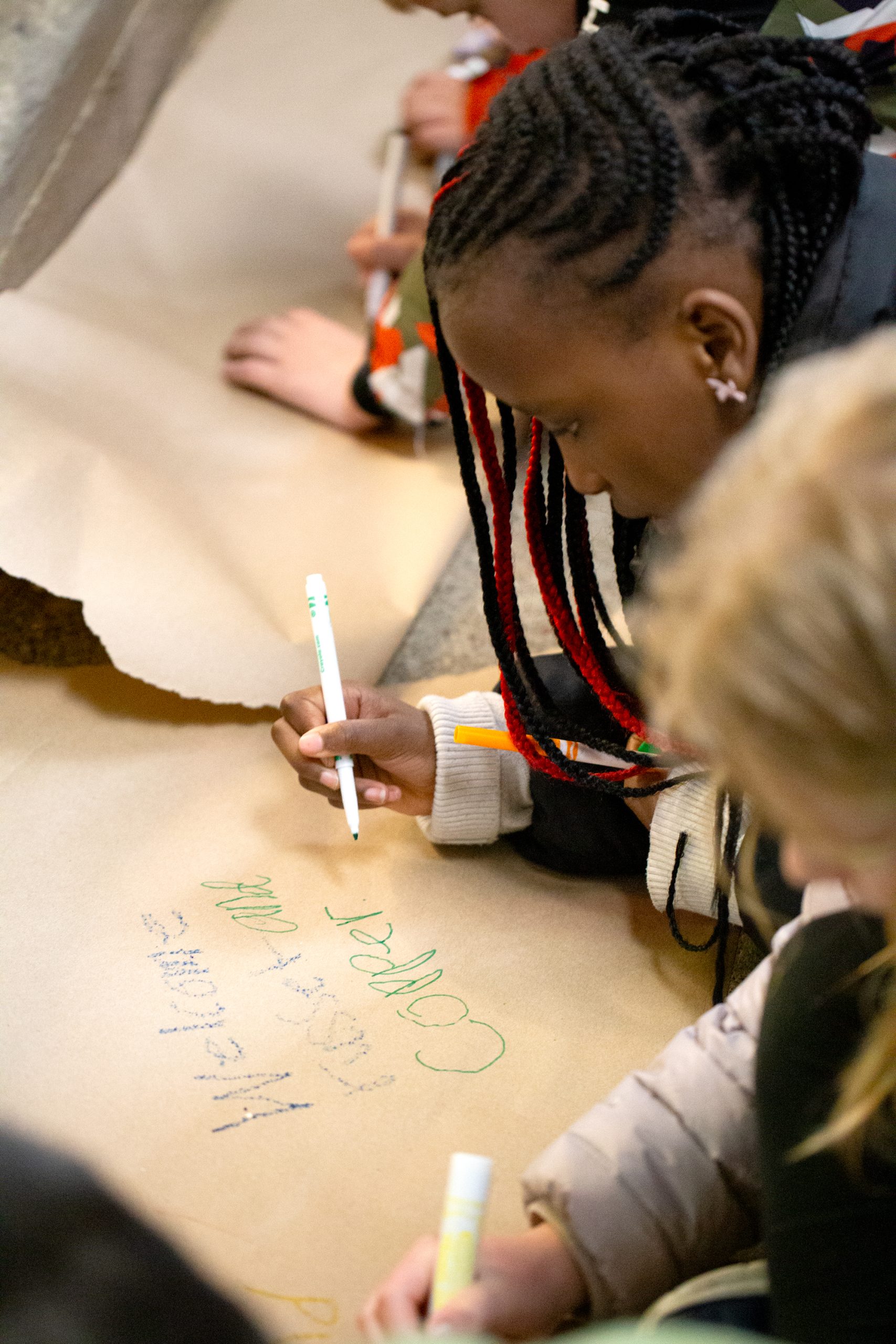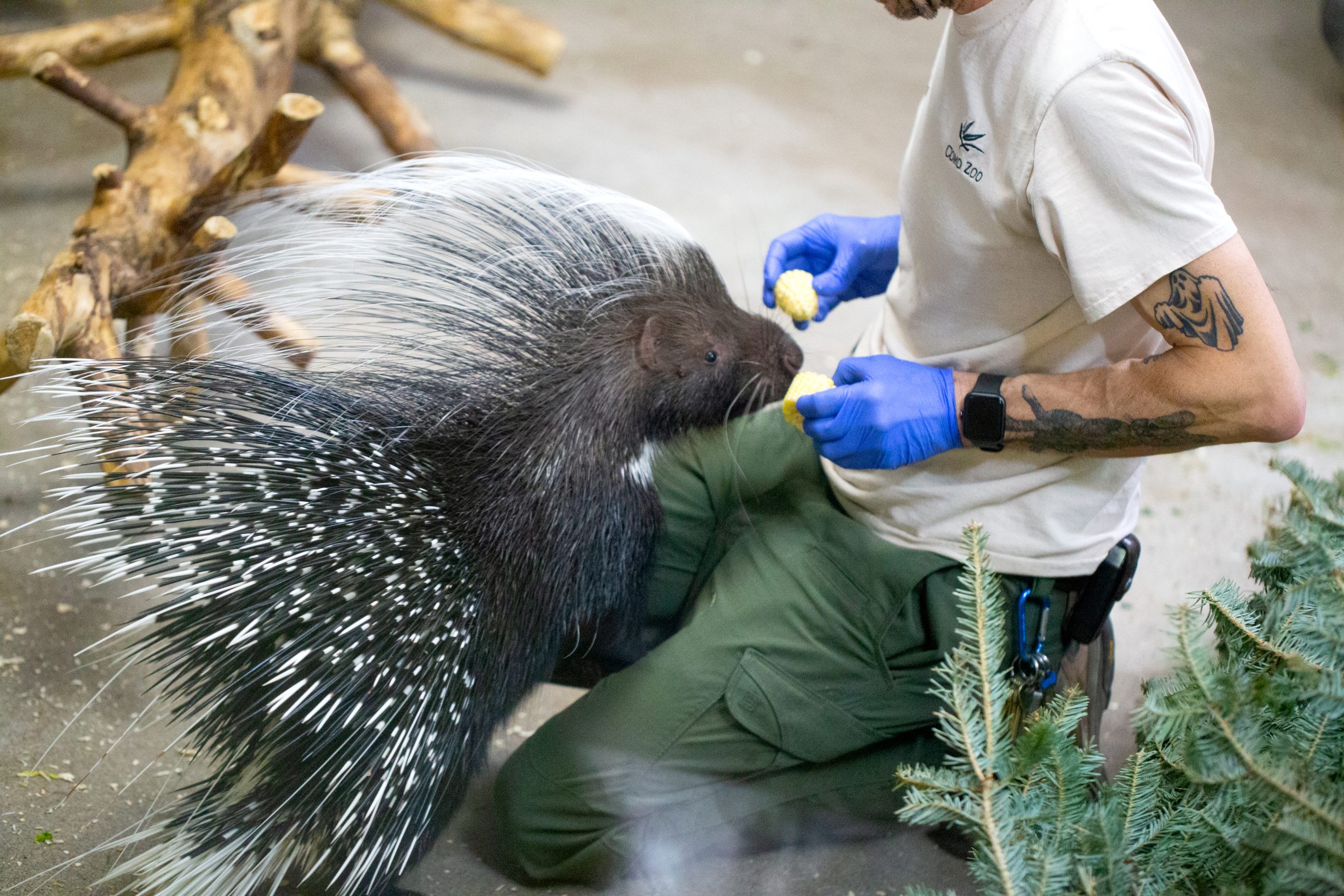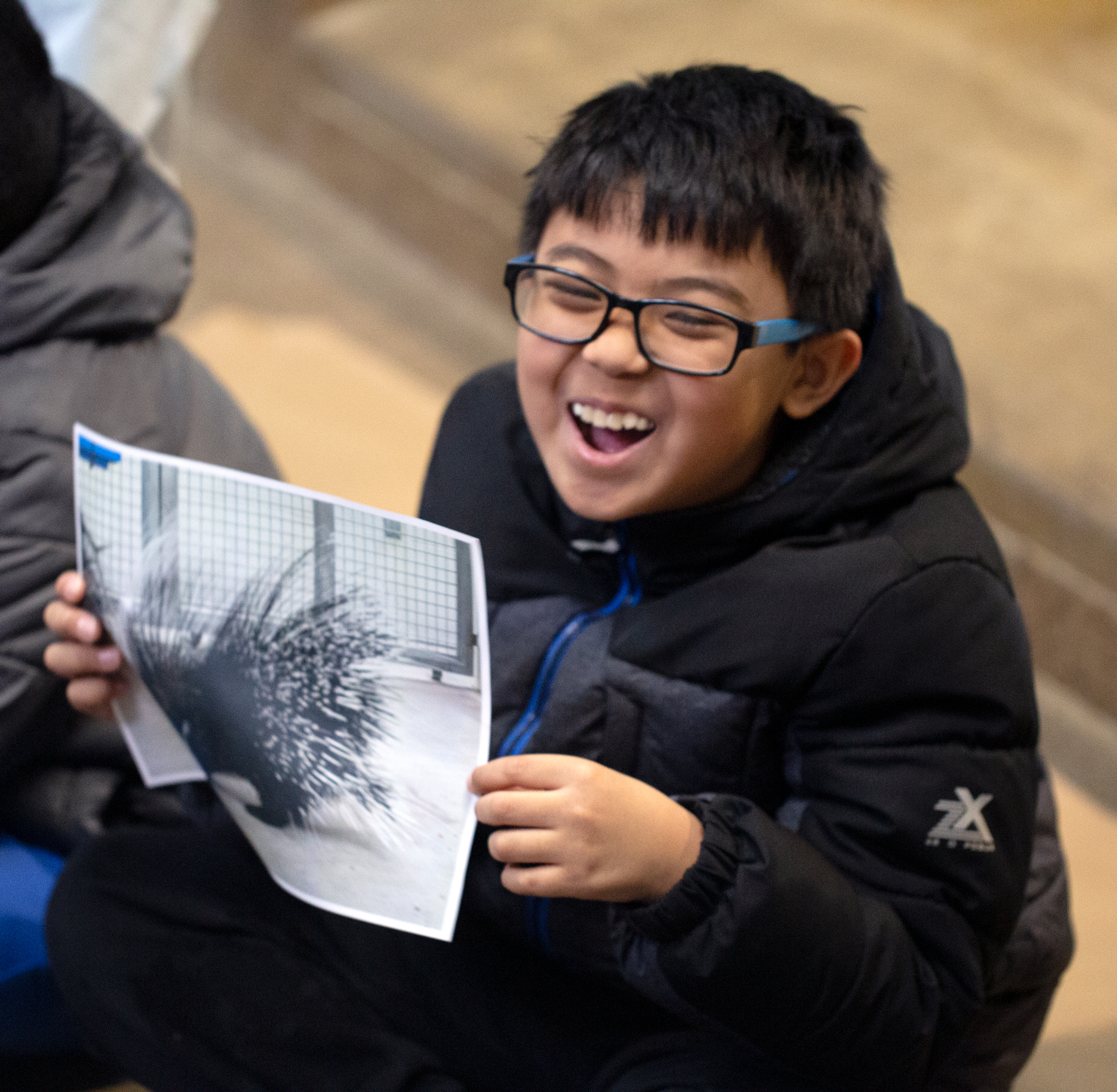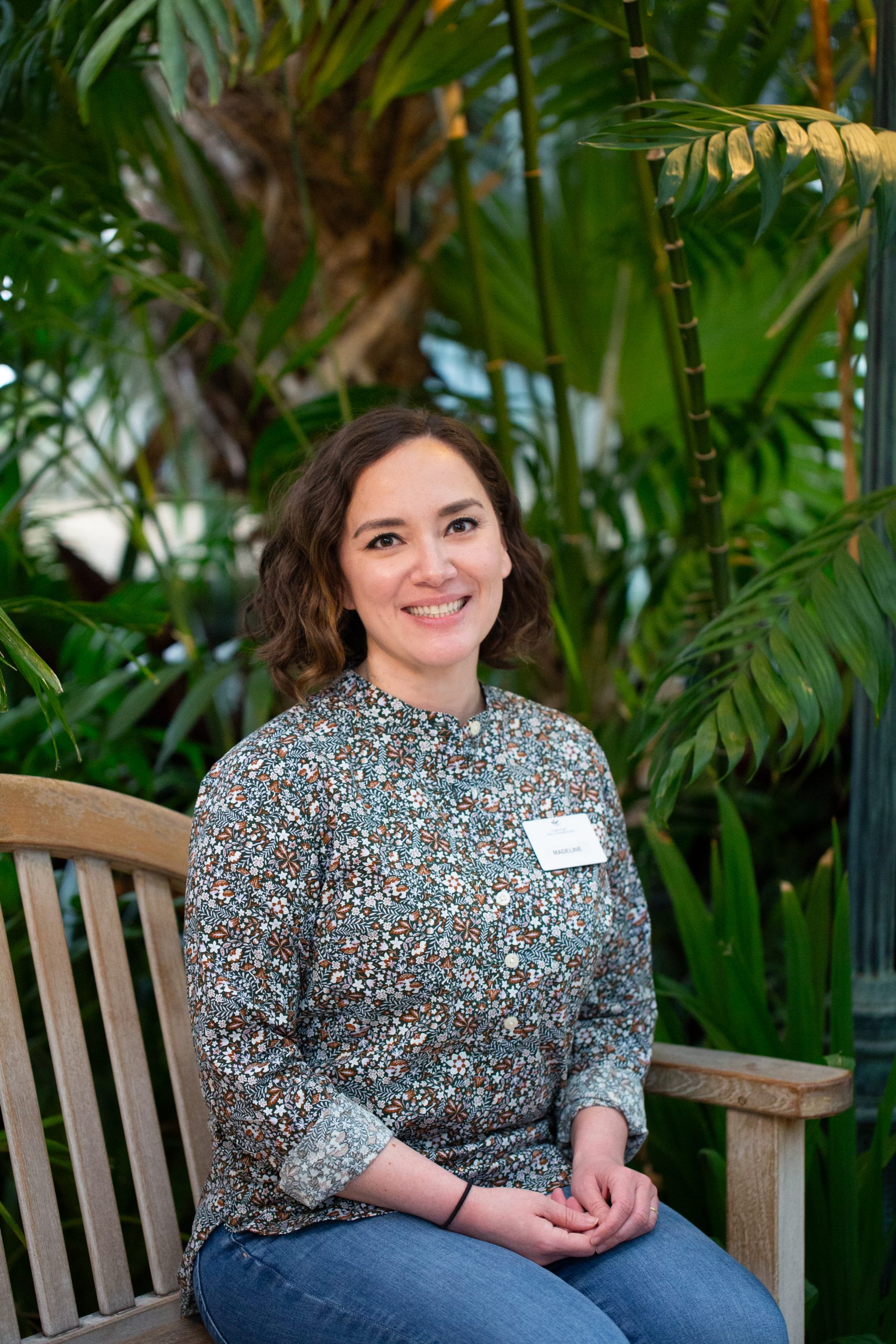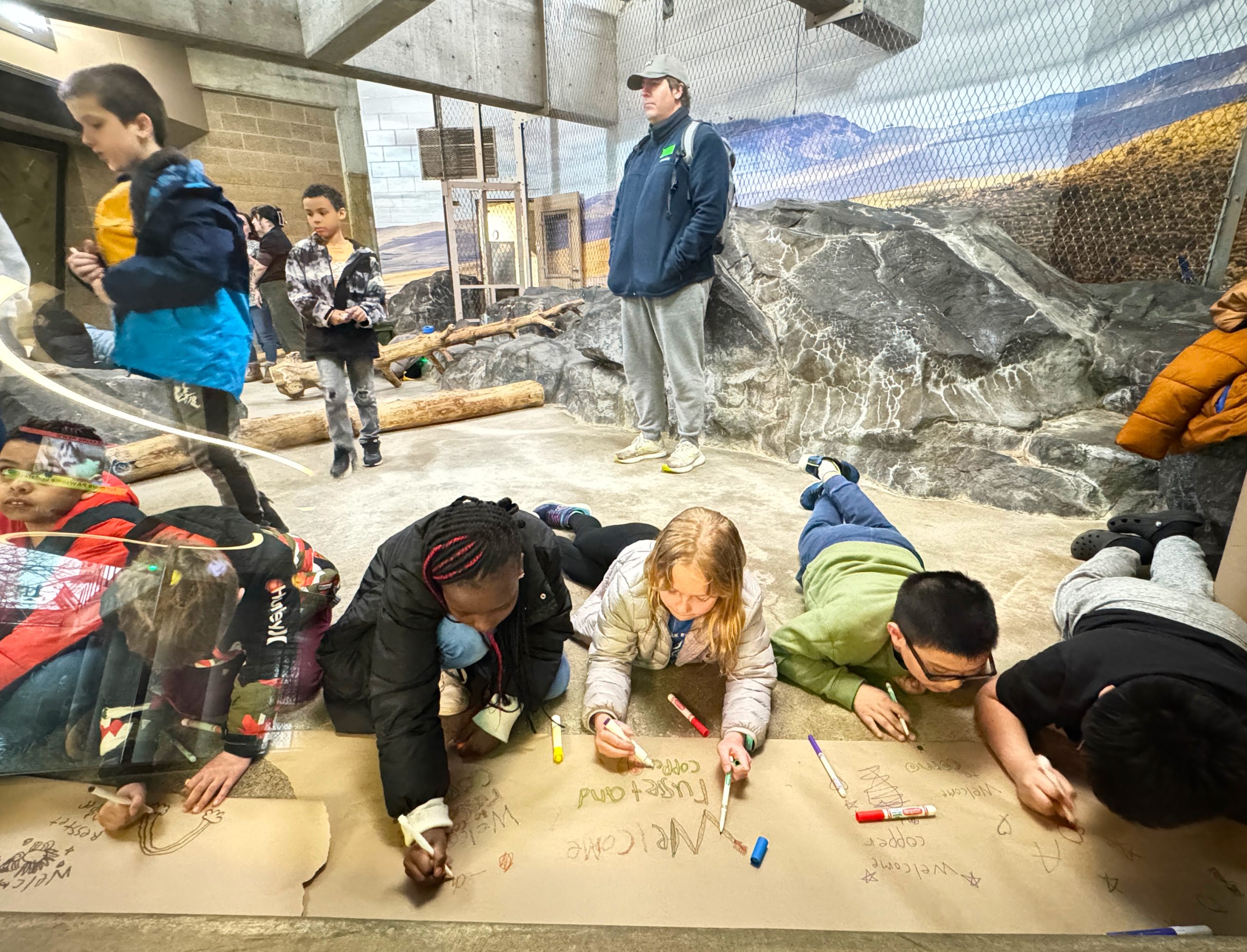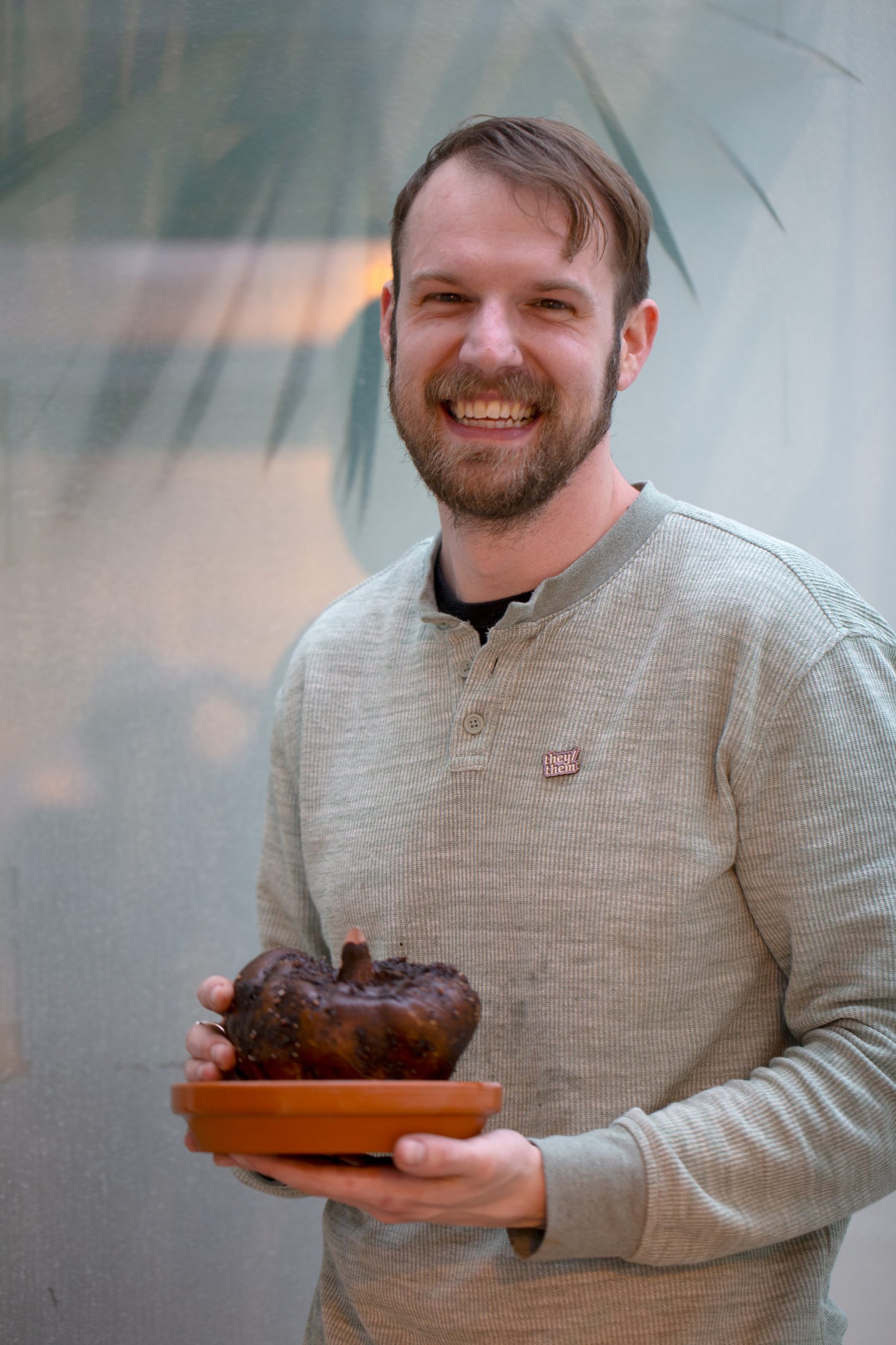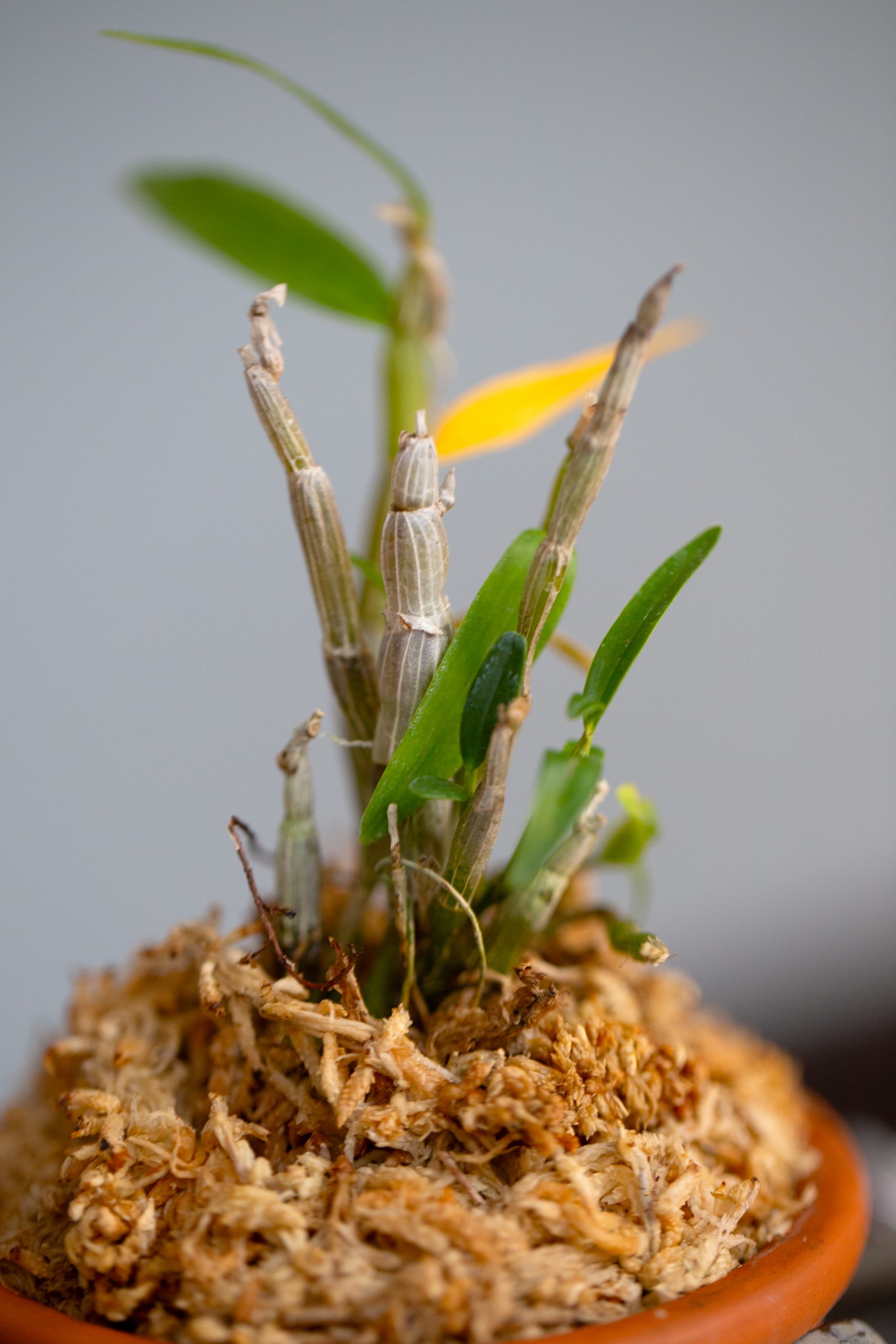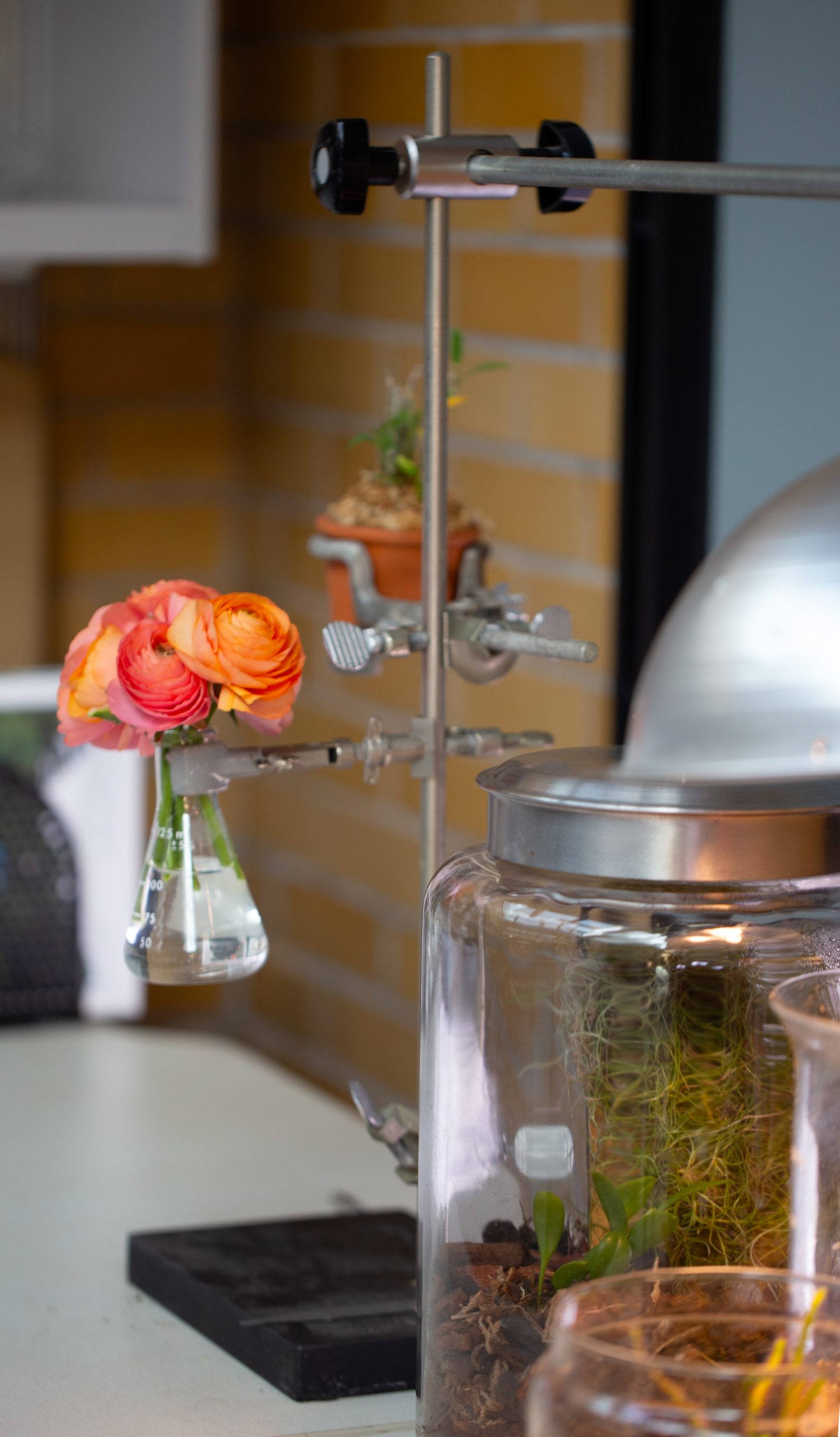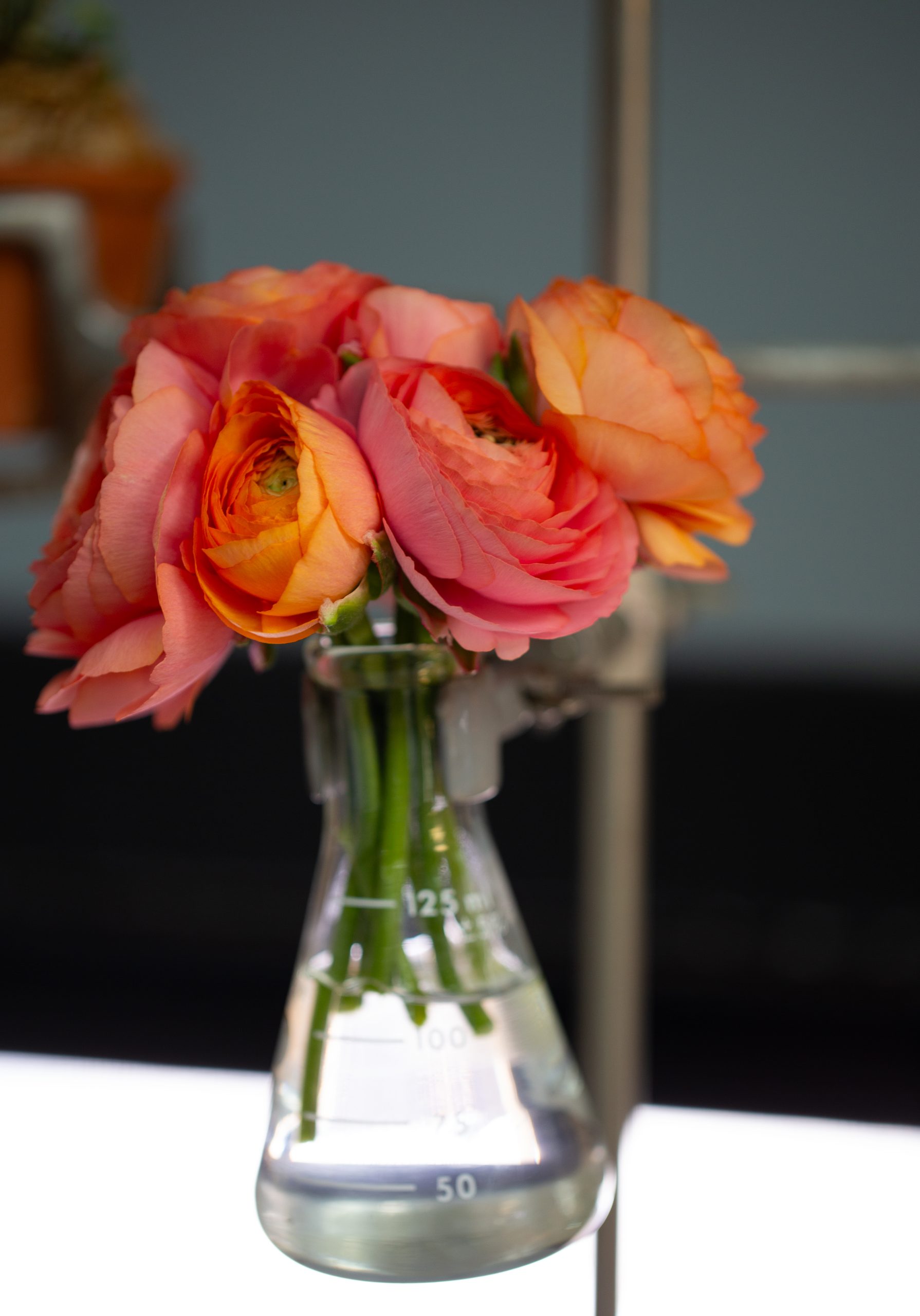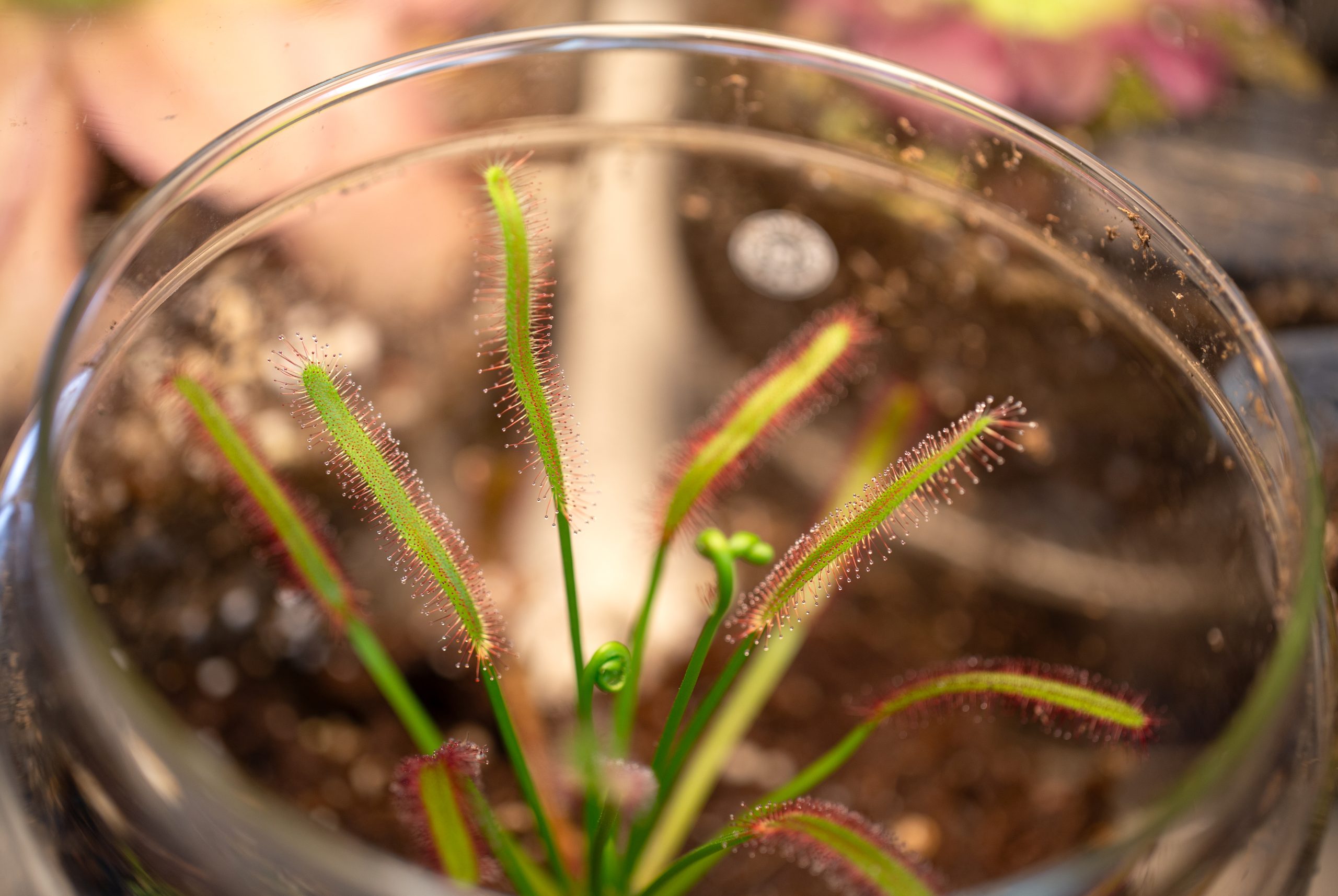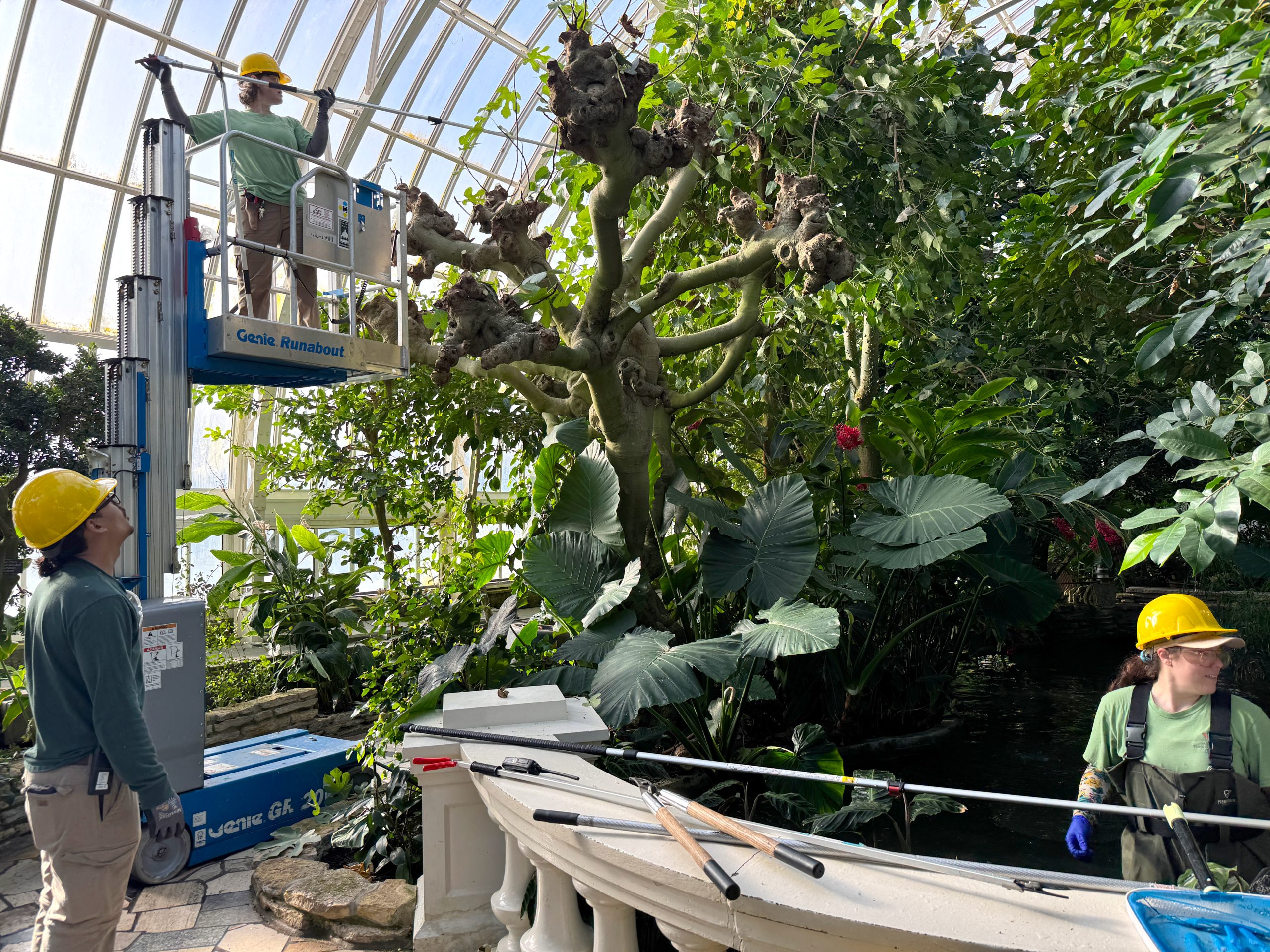Como Zoo’s life support specialist EJ Smith traveled to the Caribbean to support a promising project to rebuild the vanishing coral reefs
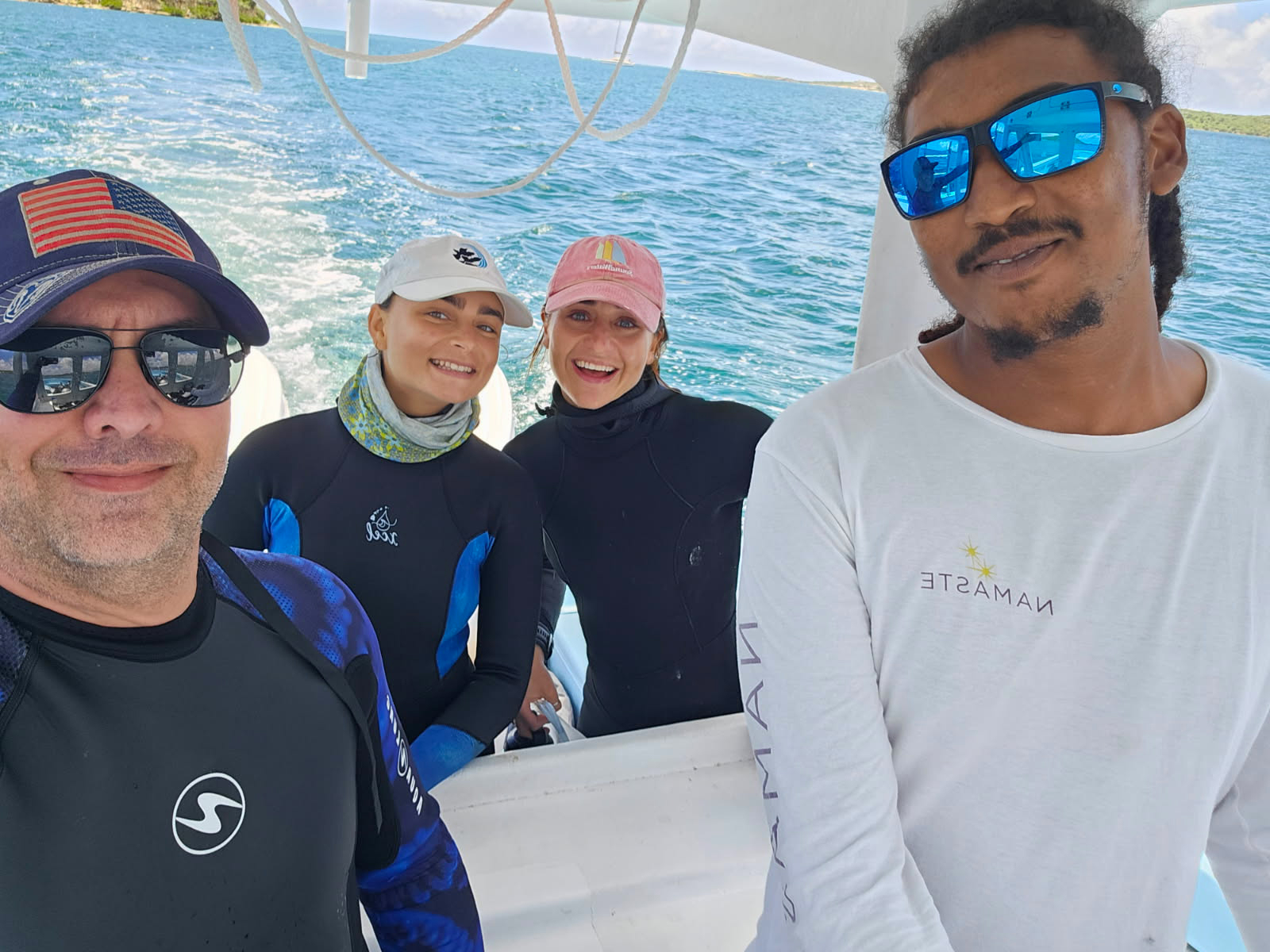
Vivid with color and teeming with life, coral reefs are among the most amazing ecosystems on the planet, accounting for just one percent of the ocean floor’s surface, yet supporting nearly a quarter of all marine species.
But with growing greenhouse gas emissions, rising sea temperatures, ocean acidification, and a host of other factors, reefs around the world are in danger of dying out. While more than half of the world’s living coral has been lost since 1950, scientists predict more than 90 percent could disappear by 2050.
While the challenges are daunting, Como Zoo life support specialist EJ Smith recently found some cause for hope in the Caribbean where a new conservation group called the Elkhorn Marine Conservancy is working on a solution. With the help of a Como Friends Conservation Champions grant, Smith spent three weeks at the EMC’s sites in Antigua and Barbuda helping the small nonprofit with a promising approach to reef restoration.
“To help these reefs rebound, they’re working to create coral nurseries,” Smith explains. “They’ll look for healthy, [stress resistant] coral colonies out on the reefs, and take small chunks of them back to the nursery where they’re broken into micro fragments. Corals grow at an incredibly slow pace, but these micro fragments are found to grow faster in small colonies, speeding up that process of coral growth.” Corals are cultivated on ropes and coral “trees” made of PVC piping that can then be replanted onto degraded reefs. EMC’s nurseries are currently fostering 14 species of reef-building corals, many of which are critically endangered.
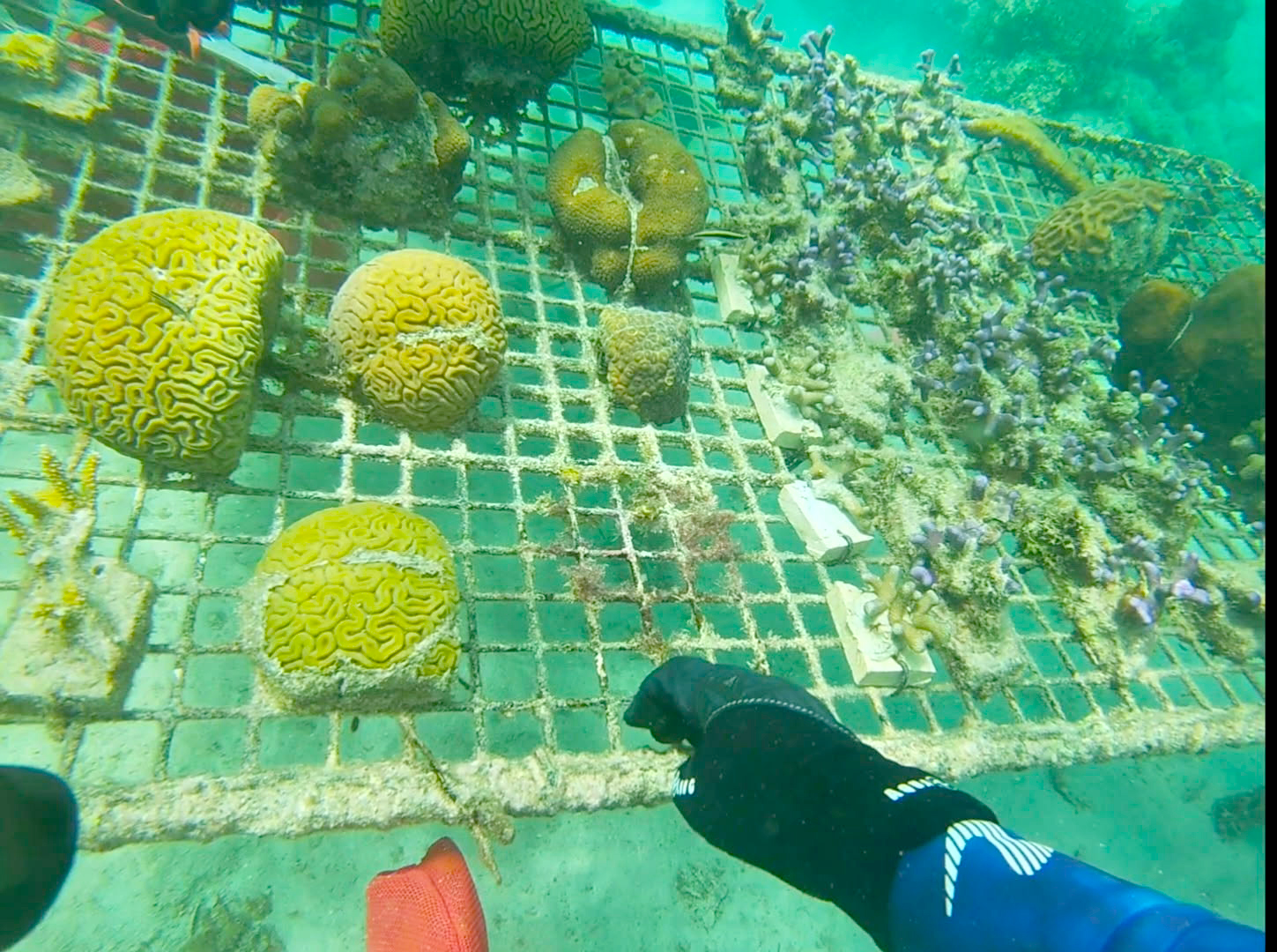
Growing at rates of just millimeters a year, coral barrier reefs can take more than 100,000 years to form. Groups like the Elkhorn Marine Conservancy are making coral nurseries from micro fragments of healthy coral to help speed the process of renewal.
An expert diver, Smith is responsible for all of Como’s aquatic habitats, ensuring water quality for dozens of species, from polar bears to pacus, and regularly diving into Como Zoo’s aquatic habitats to troubleshoot. “I once did the math and figured that professionally and recreationally, I’ve spent about two months of my life submerged in the water,” he says. “But diving with [EMC’s staff] was like working with superheroes. Some of these folks had such amazing physical capabilities they could hold their breath for minutes at a time. It was just astounding.”
The water chemistry skills Smith has honed at Como Zoo are valuable to EMC’s work, and their plans to expand their coral nursery operations. To deepen the connections between conservation efforts in the Caribbean and at Como Zoo, Smith’s colleague Asher Berg, Como Zoo’s Aquatics Keeper, will be taking a Conservation Champions trip of his own this fall to support the renewal of coral near Antigua’s Green Island, York Island, and Cades Reef.
With a new tank of coral beds coming soon to the Aquatics Building, Smith says he’s looking forward to sharing his insights about coral conservation in upcoming keeper talks. While the health of the world’s coral hangs in the balance, Smith says he finds hope in the visit he made to Antigua’s St. Andrew’s School, where he talked with elementary school students about his work in life support, and how coral restoration can benefit the local economy, food chain, and climate resilience.
“This next generation of island people are already tied to conservation, because their lives really are impacted by the health of the reefs,” he says. “To hear these kids talk about how they want to work in conservation, or maintaining fish stocks, or protecting the reefs when they grow up was really heartwarming, to be honest. It makes you hopeful that conservation projects like this are making an impact.”
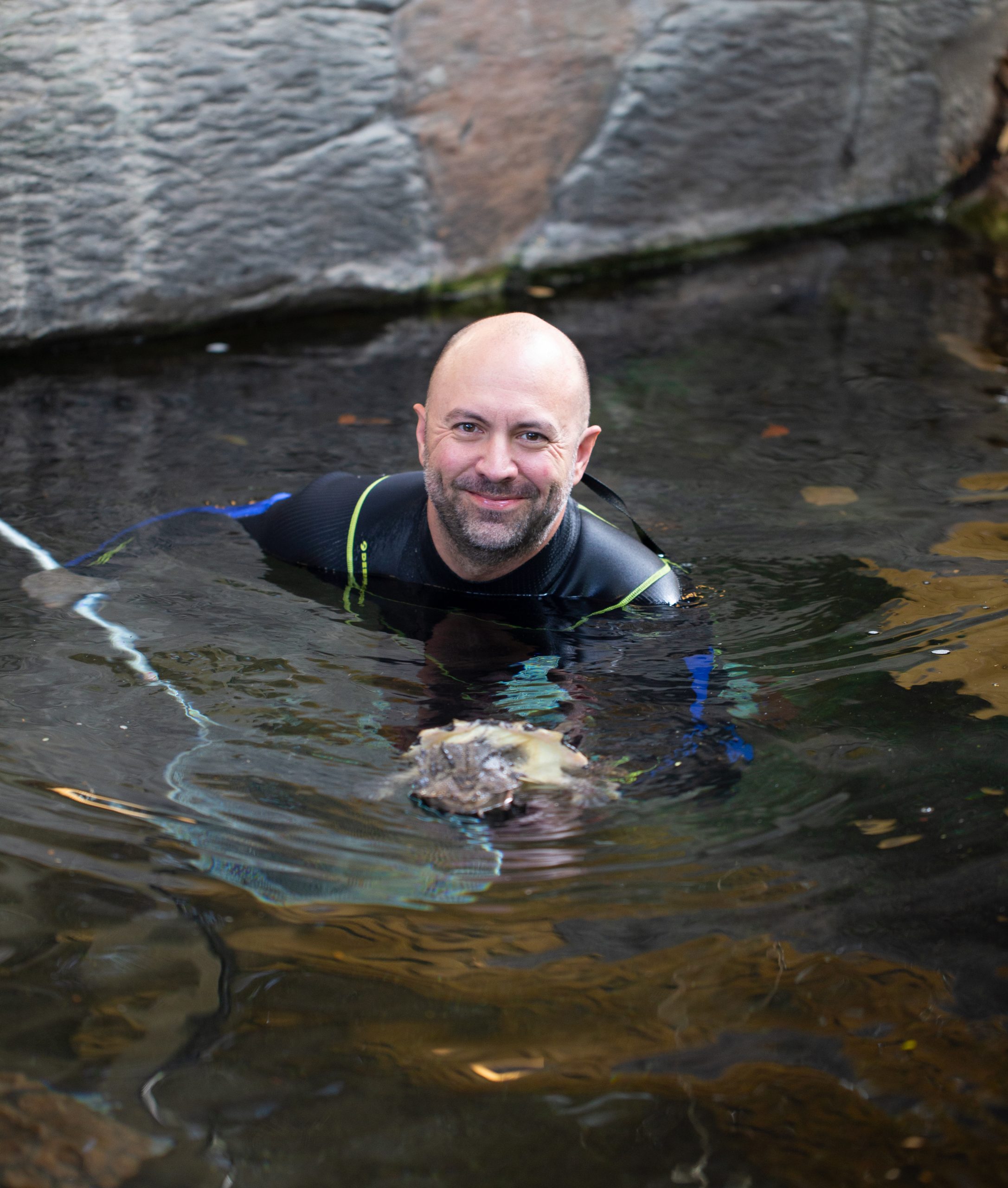
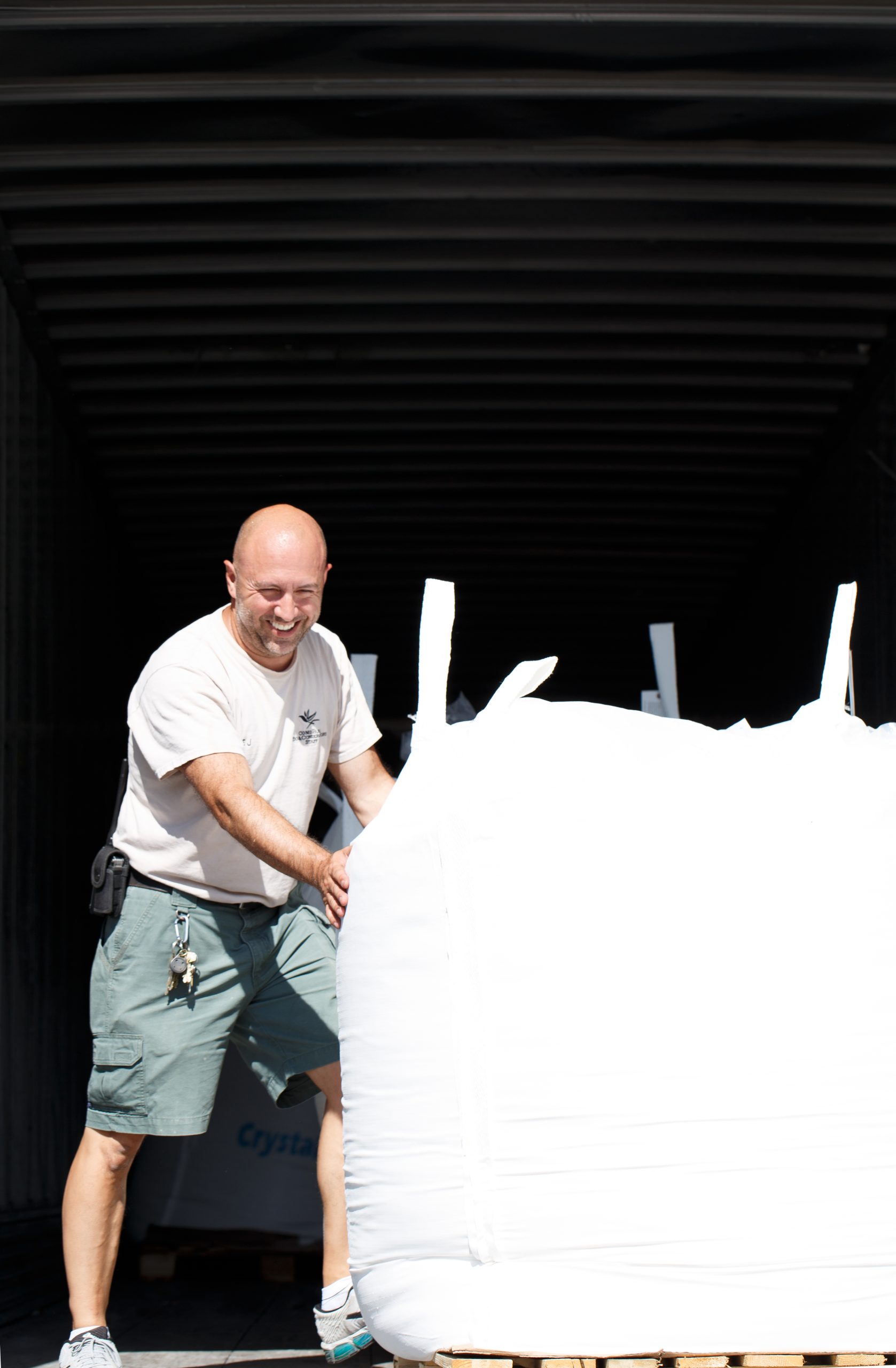
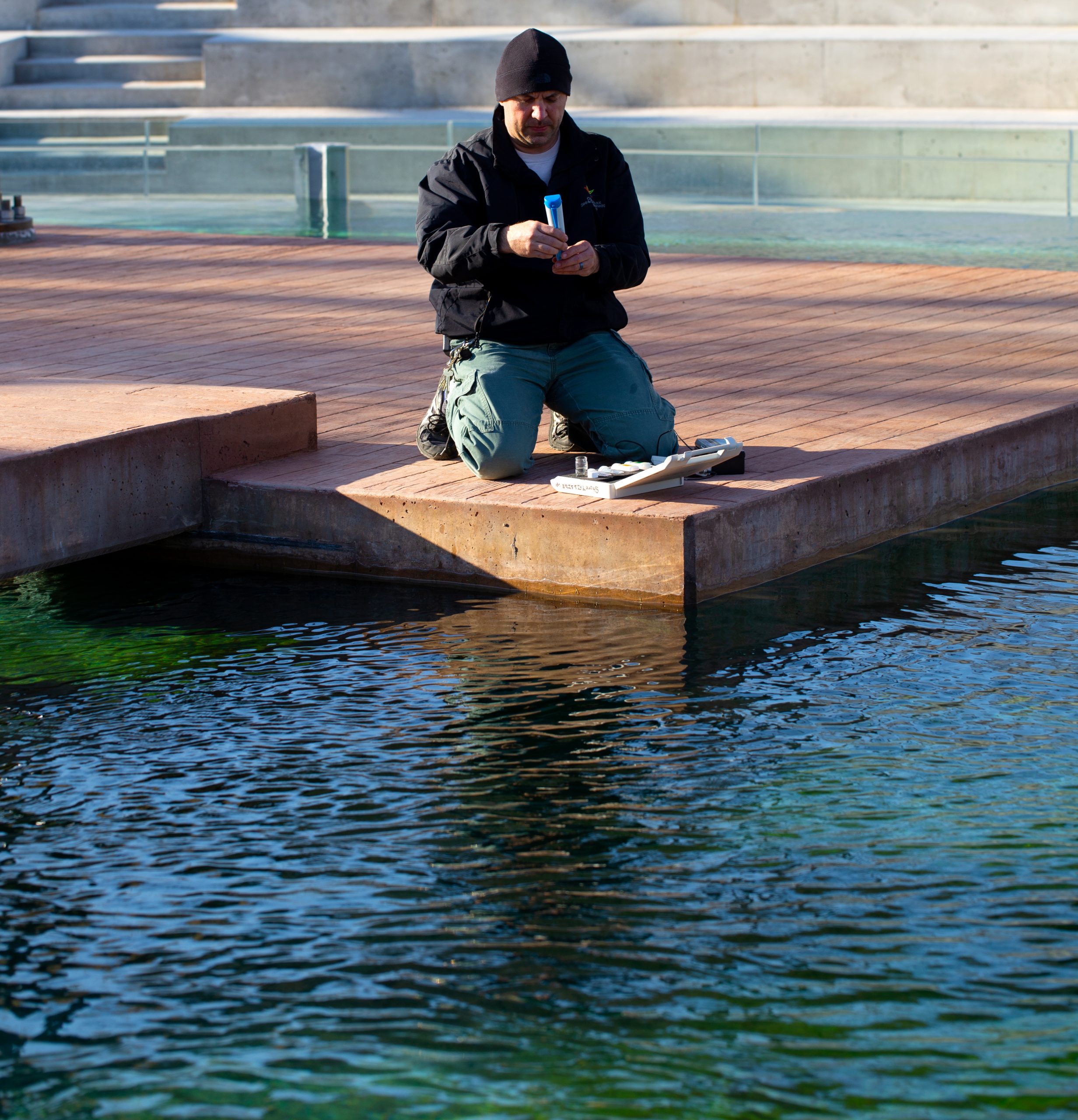
Your gifts to Como Friends support Conservation Champions, a program that encourages Como’s professional horticulture and zookeeping staff to participate in field conservation and restoration projects around the world. Thank you!
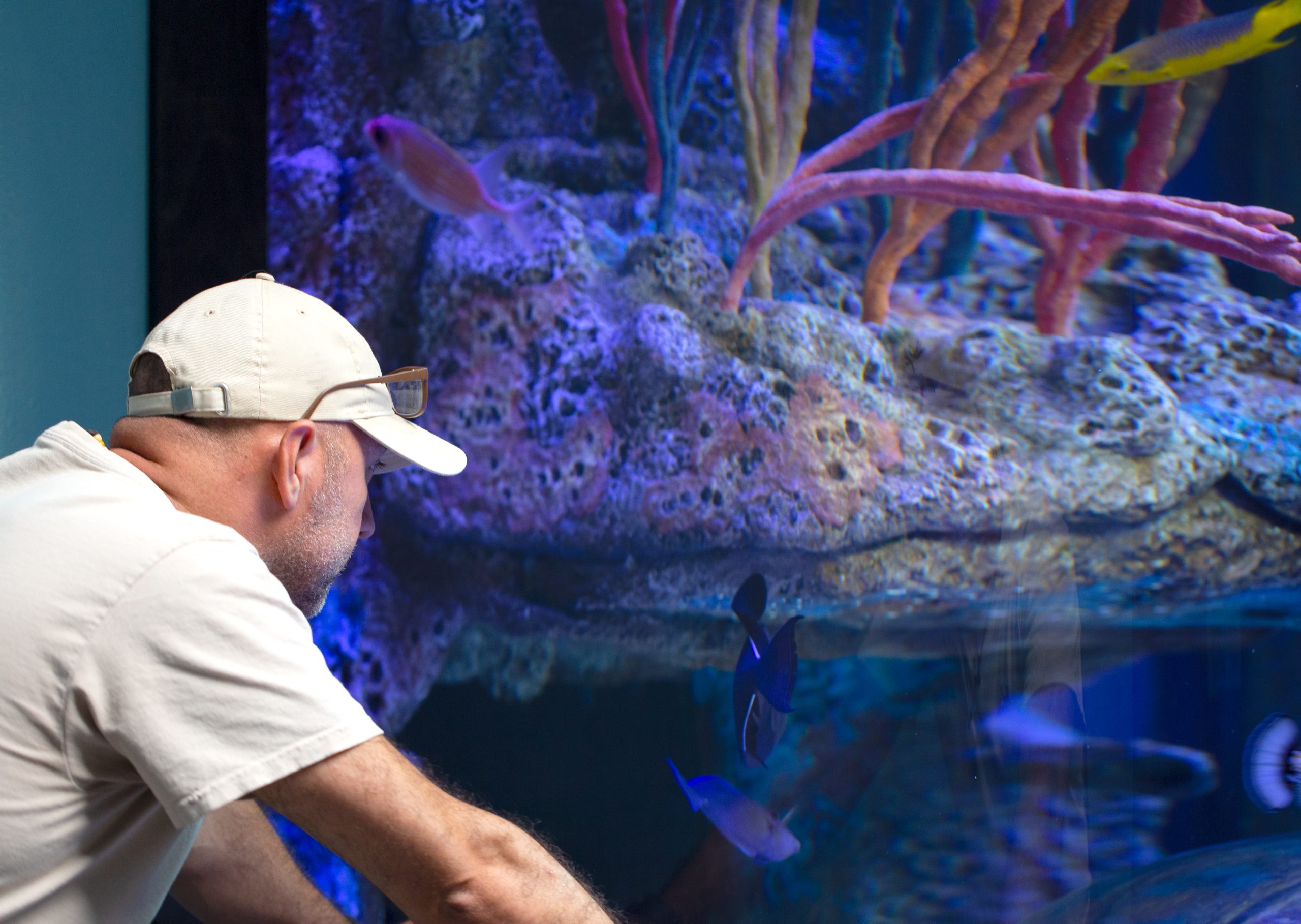
One of the Marjorie McNeely Conservatory’s most interesting plant collections plays the starring role in this season’s Summer Flower Show
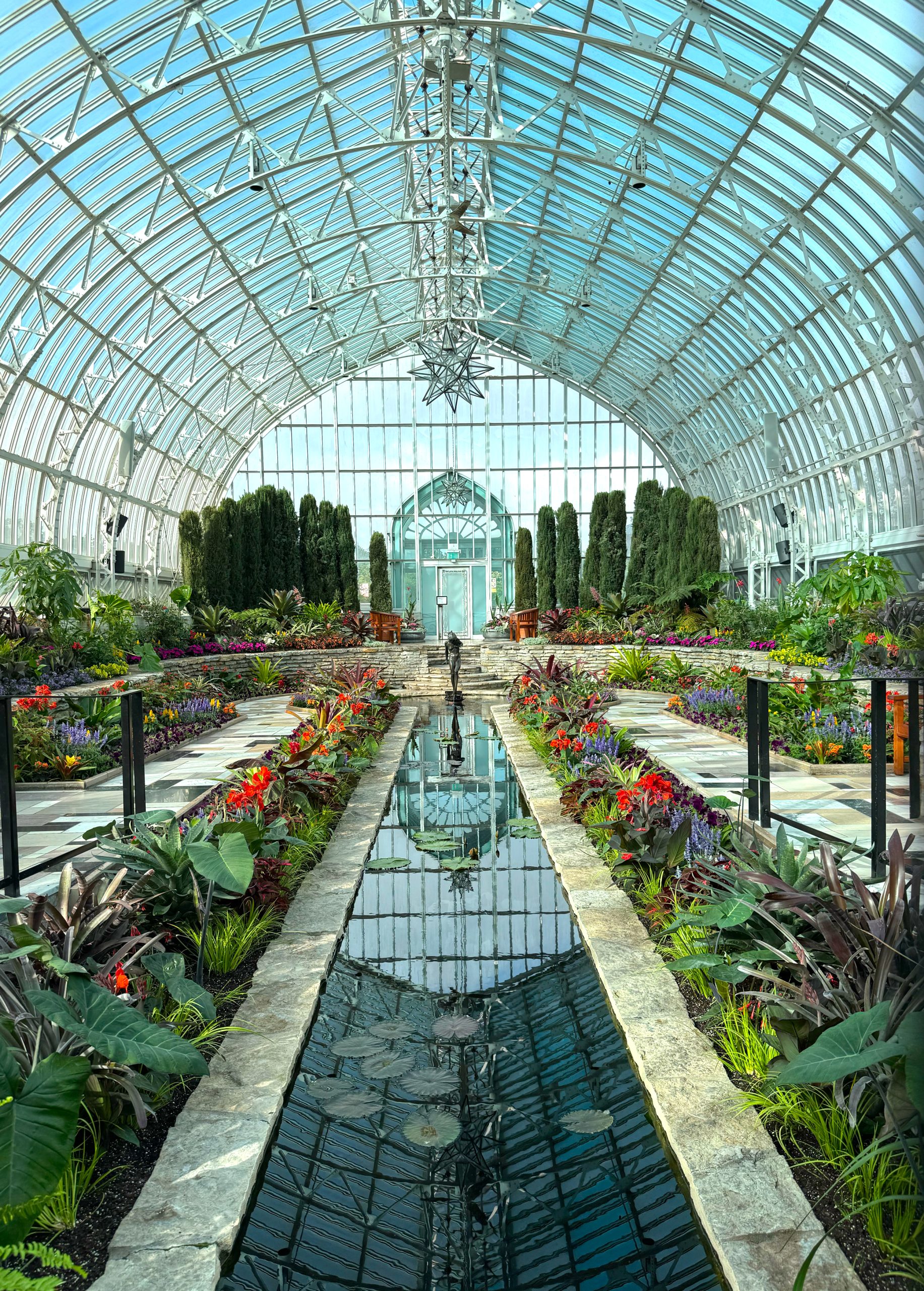
The Summer Flower Show at the Marjorie McNeely Conservatory typically features hundreds of tropical annuals that require warm temperatures, lots of water, and frequent swap-outs as they bloom and fade.
But this season, Como’s horticultural team decided to highlight a plant species that’s a little more sustainable, but no less sensational—the bromeliad.
“We’ve never used the Sunken Garden as a showcase room for a plant collection before, but we have such a variety of bromeliads currently,” says Como Senior Horticulturist Ariel Dressler. “We always want to put plants in a place where they’ll thrive and be happy, and since the Summer Flower Show is our longest show of the year, we know our bromeliads will do well. They’re such a charismatic plant that to see them in mass is a real treat.”
In fact, bromeliads have long been a favorite for Como visitors, who recently bestowed the “Cutest Plant” award on a tiny pineapple bromeliad. With a collection first launched in 1975, The Marjorie McNeely Conservatory currently has 638 living bromeliads in its collection, from 350 different species, the best of which are often displayed in the understory of the historic Palm Dome.
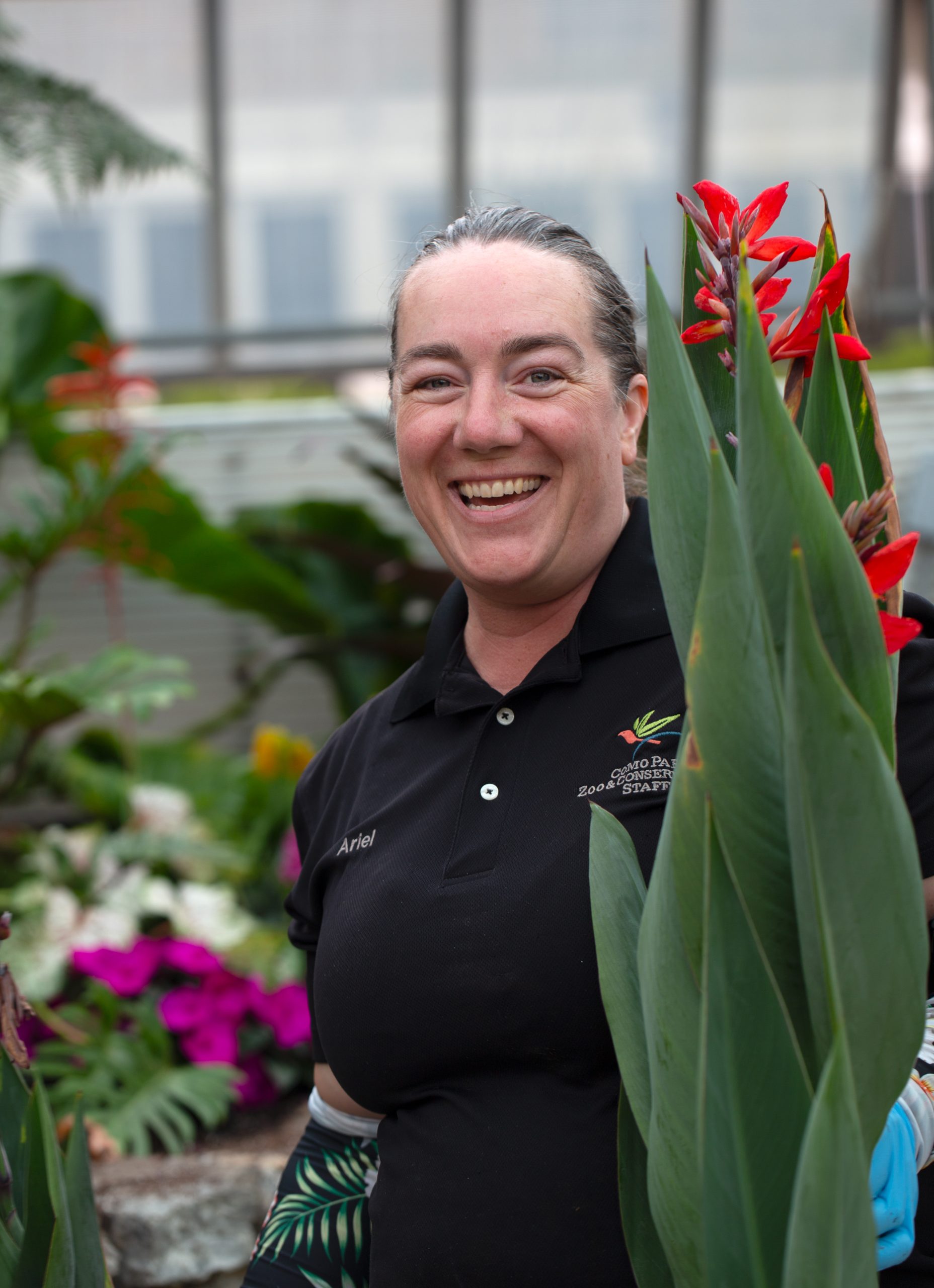
With more than 2,700 known species, the diversity of bromeliads is part of their wide appeal. Unlike other plants, bromeliads only use their roots for balance—all the water and nutrients they need are delivered through their leaves. And while many bromeliads only bloom once in their lifetimes, the mother plant can produce many new offshoots, known as “pups.”
To create the sheer number of plants needed for the Summer Flower Show display, horticulturist Diane Rafats, and a dedicated team of volunteers, propagated hundreds of bromeliad “pups” from Como’s own collection, timing their care and life cycle to ensure they were ready to bloom in time for the show, which runs from June 13 to September 14. Meanwhile, horticulturist Rylee Werden went about taking cuttings from Tropical Encounters and the North Garden to amass the hundreds of tropical accent plants that are also part of the display. Horticulturists worked to acclimate the plants to the unique conditions of the Sunken Garden prior to their June debut.
“Taking divisions of plants requires a little recovery period, because sometimes plants can be a little dramatic or wilty,” says Werden. “We also give them a little bit of shade and cooler temperatures as they move their way into the Sunken Garden, where it’s going to be hot, but not quite as humid as in a misting tropical greenhouse. Our goal is to get them through that drama phase before they go into the show and are ready for that bright sun and heat.”
While visitors have been amazed by the unique vibe the bromeliads bring to Minnesota’s most beautiful room, Rafats reports that they’re more accessible than they look. “Their leaves can be sharp, so you do have to be careful, but otherwise, they make great houseplants.”
Speaking of houseplants—our conservatory-grown bromeliads will be available for purchase at Garden Safari Gifts in the Visitor Center, both during and after the Summer Flower Show!
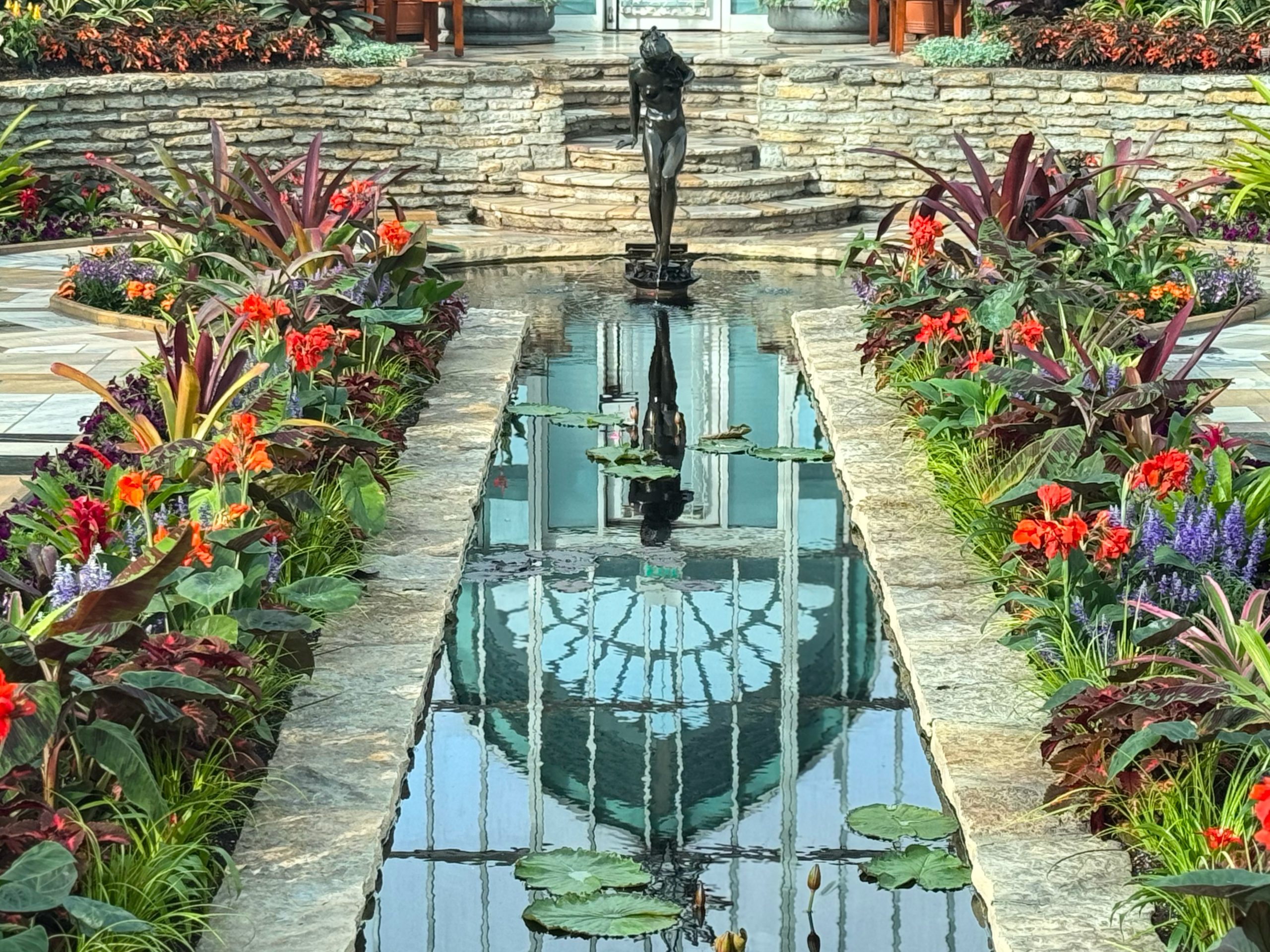
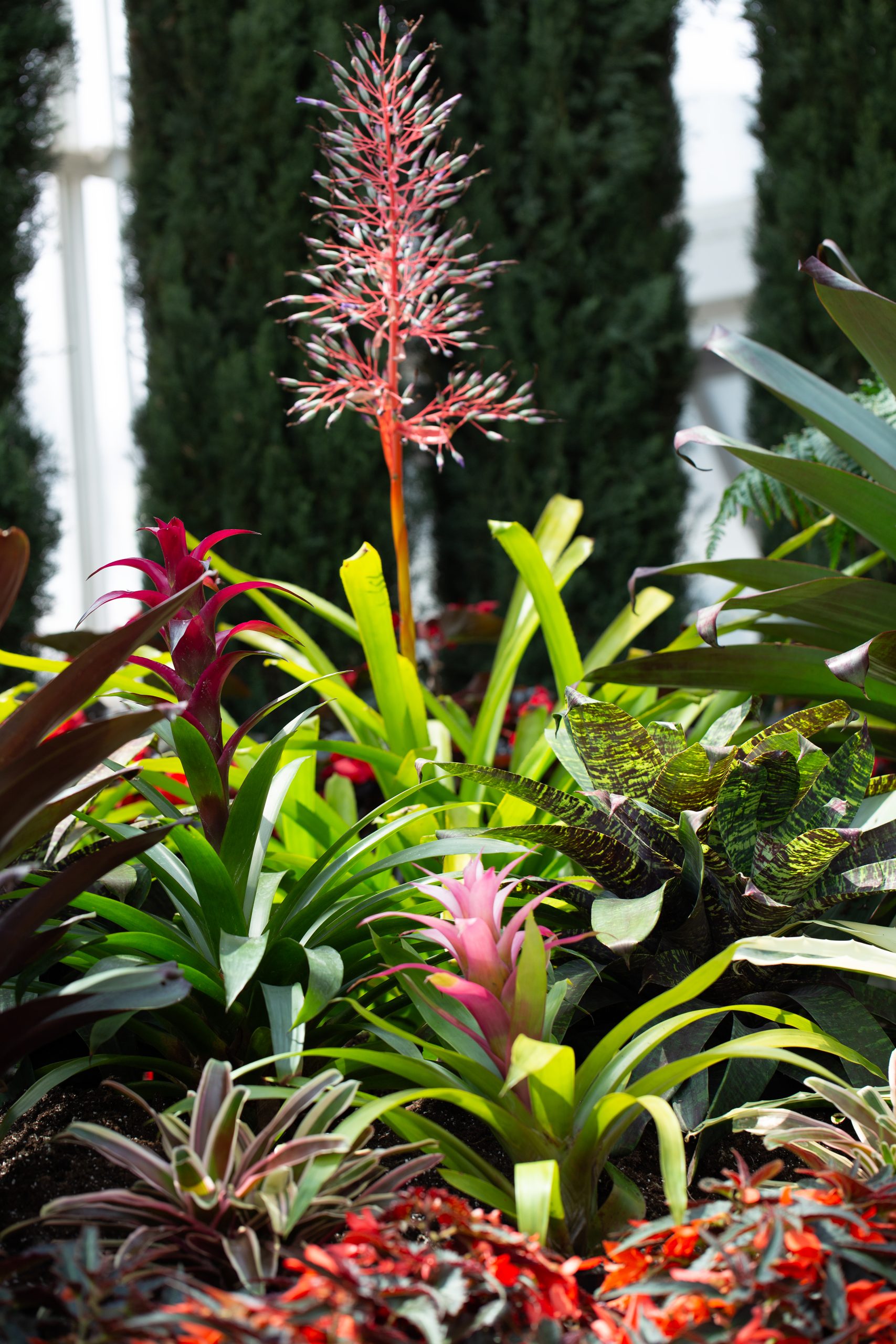
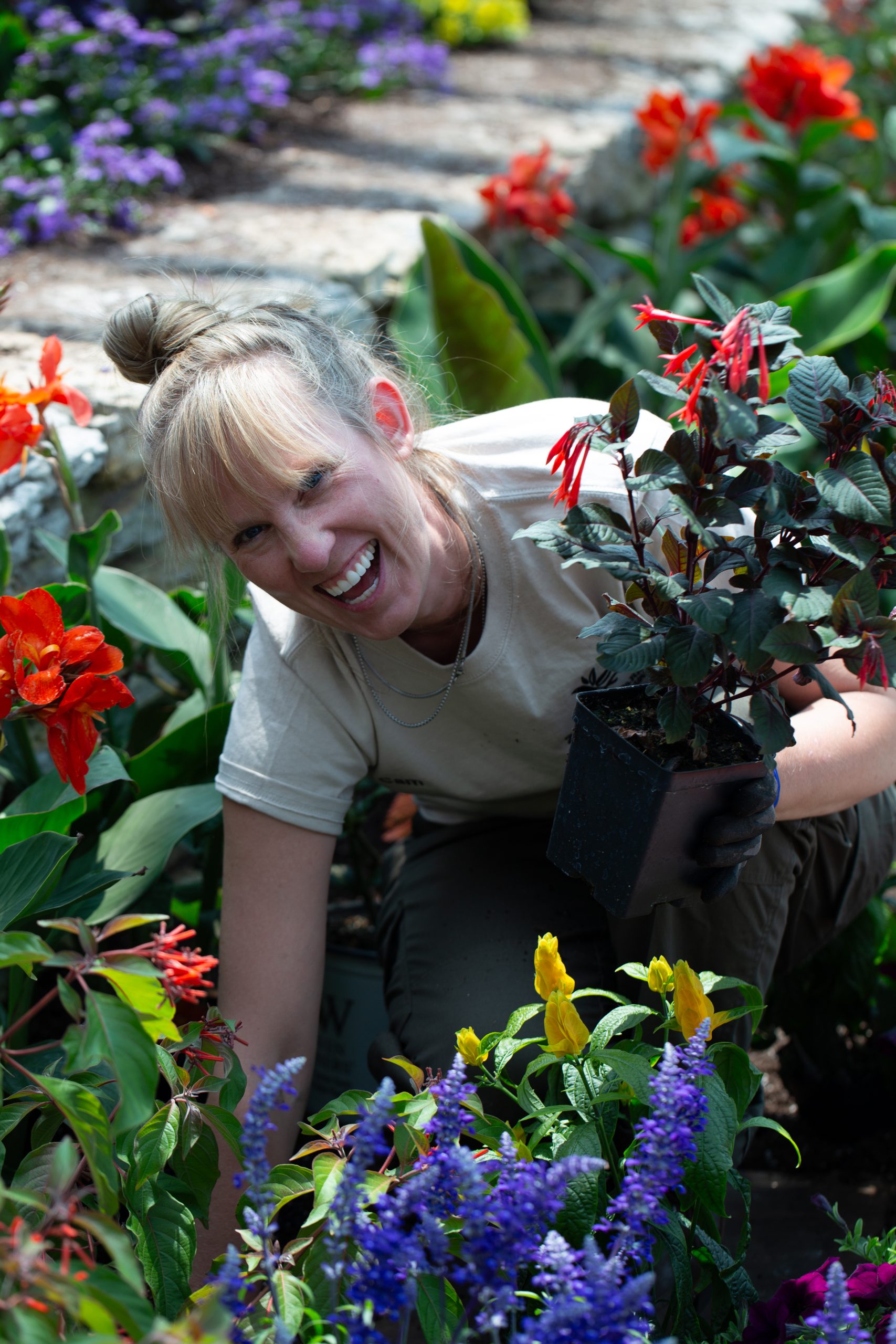
Your support for Como Friends helps ensure the Marjorie McNeely Conservatory’s seasonal flower shows are always free to every visitor. Thank you!
Como Friends’ board of directors is pleased to announce the appointment of Katie Hill as its next president, effective July 14, 2025.

“Katie brings a rare blend of creativity, strategy, and heart,” says Andy Davis, board chair of Como Friends. “She understands what it means to lead with purpose and partnership. Her deep roots in the Twin Cities, her passion for equity and access, and her track record of innovation make her exactly the right leader to guide Como Friends into its next chapter.”
Como Friends’ board of directors is pleased to announce the appointment of Katie Hill as its next president, effective July 14, 2025. Hill succeeds Jackie Sticha, whose 25 years of visionary leadership transformed Como Friends into a nationally recognized model for public-private partnership and helped secure a vibrant, accessible future for Como Park Zoo & Conservatory.
The current vice president of engagement and chief innovation officer at Milkweed Editions, Hill has consistently reimagined how the public connects with such treasured civic institutions as the Walker Art Center and the Minneapolis Institute of Art.
“Katie brings a rare blend of creativity, strategy, and heart,” says Andy Davis, board chair of Como Friends. “She understands what it means to lead with purpose and partnership. Her deep roots in the Twin Cities, her passion for equity and access, and her track record of innovation make her exactly the right leader to guide Como Friends into its next chapter.”
A lifelong Saint Paul resident and longtime Como champion, Hill brings a personal commitment to Como’s future. “Como is where I bring my kids to explore, reflect, and recharge. It’s not just a place—it’s a living ecosystem of wonder, learning, and belonging,” she says. “I’m honored to join Como Friends at this important moment and excited to reimagine how communities connect with public cultural spaces.”
Prior to joining Milkweed Editions—a nationally respected independent publisher of literary fiction, nonfiction, and poetry—Hill spent more than a decade in art museum communications, digital strategy, and public engagement. She launched her career in innovation as creator of the first Internet Cat Video Film Festival at the Walker Art Center in 2012. Hill moved on to help launch the practice of audience engagement at the Minneapolis Institute of Art, where she headed the engagement strategy department and oversaw the marketing operation. Hill holds a BA in English language and literature from Kenyon College, and an MA in art history from the University of St. Thomas.
Selected after an extensive search conducted by Ballinger | Leafblad, Hill will join Como Friends in July. Como Friends supporters will have their first chance to connect with Hill on July 17 at Sunset Affair, the organization’s annual summer gala. The nonprofit fundraising partner to Como Park Zoo & Conservatory, Como Friends has delivered more than $54 million in private contributions to Minnesota’s most visited cultural destination, safeguarding the free admission policy Como’s 1.9 million annual visitors value.
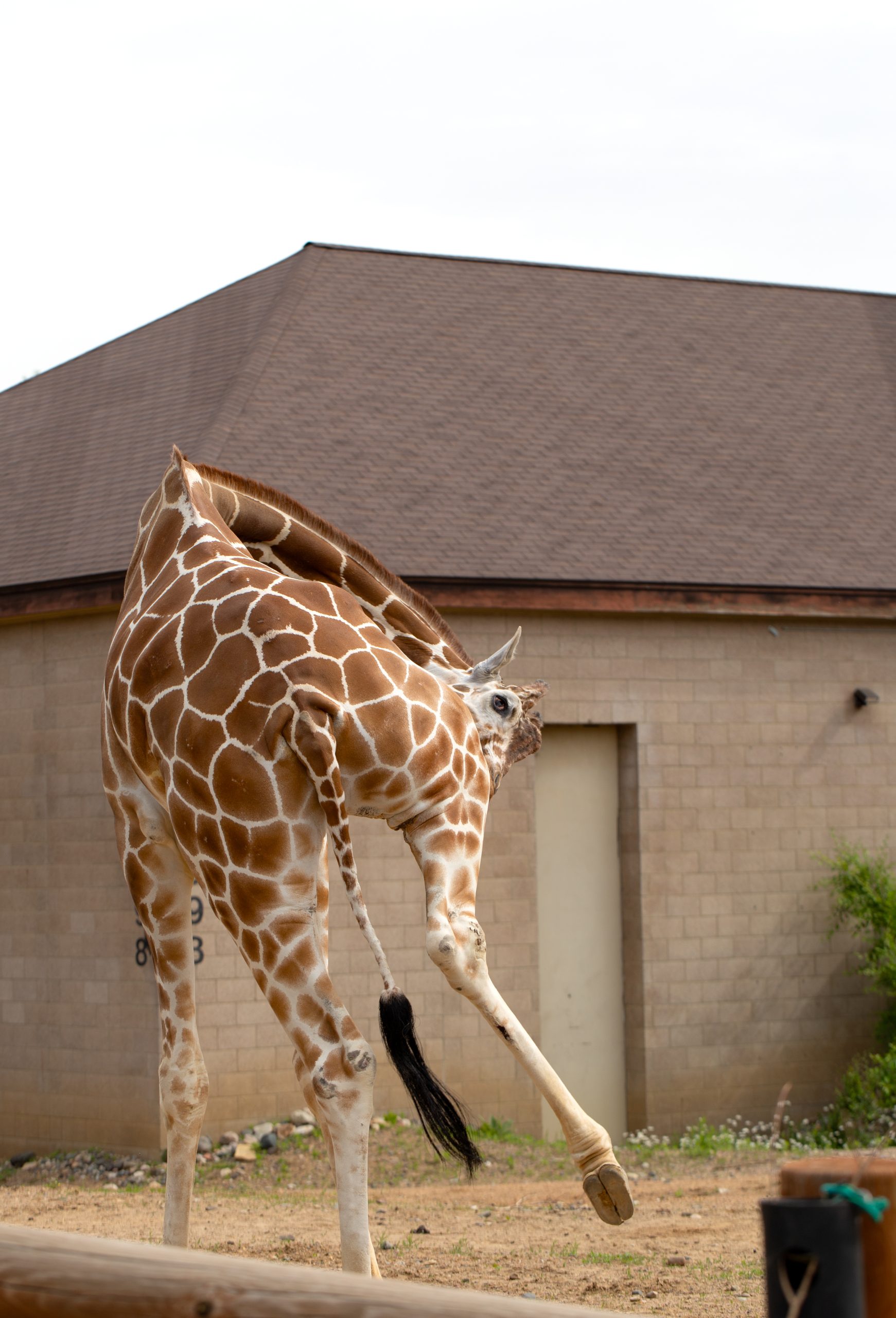
What’s the best time of day to come to Como? With more than a dozen free daily programs offered throughout the summer, the answer is all the time, and again and again. As summer heats up, make the most of every visit to Como with this roster of family-friendly programs and special events, all free to every visitor.
-
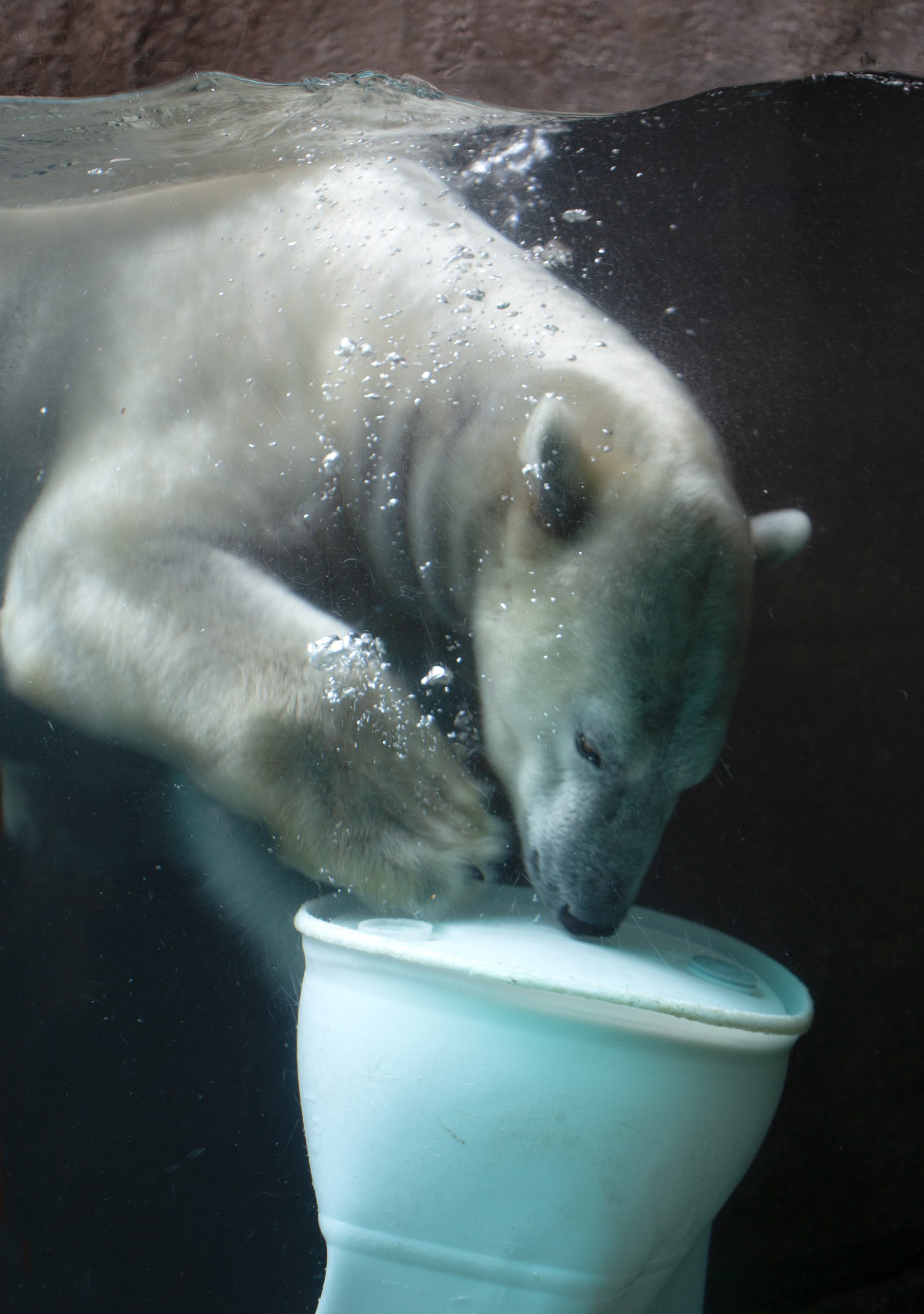
Polar Bear Program | 10:30 a.m.
Stop by Polar Bear Odyssey to see how Nan, Neil, and Kulu connect with their trainers every day, splashing down in the pools, and sniffing out special enrichments in their habitat.
-
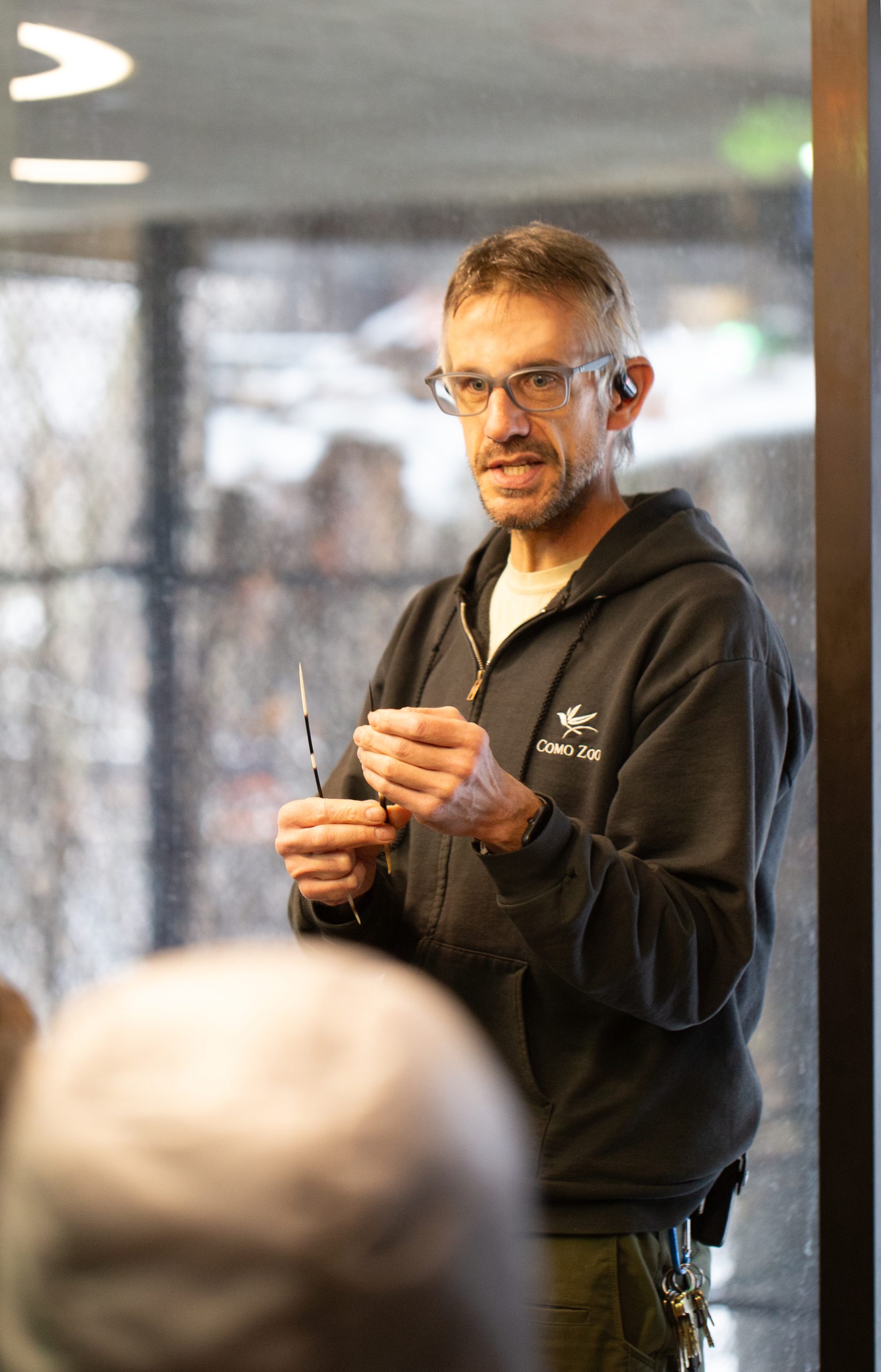
Zookeeper Talk | 11:00 a.m.
What’s it like to take care of the world’s most amazing animals? Ask one of Como’s zookeepers, who take turns sharing their behind-the-scenes insights about dozens of different animals at this daily event. Listen to Como’s public address announcements to find out where the day’s talk is taking place.
-

Blaze Sparky Show | 11:30 a.m. & 2:30 p.m.
A splashy Como tradition since 1956, the Blaze Sparky Show now highlights all of the pinnipeds that call Como Harbor home.
-
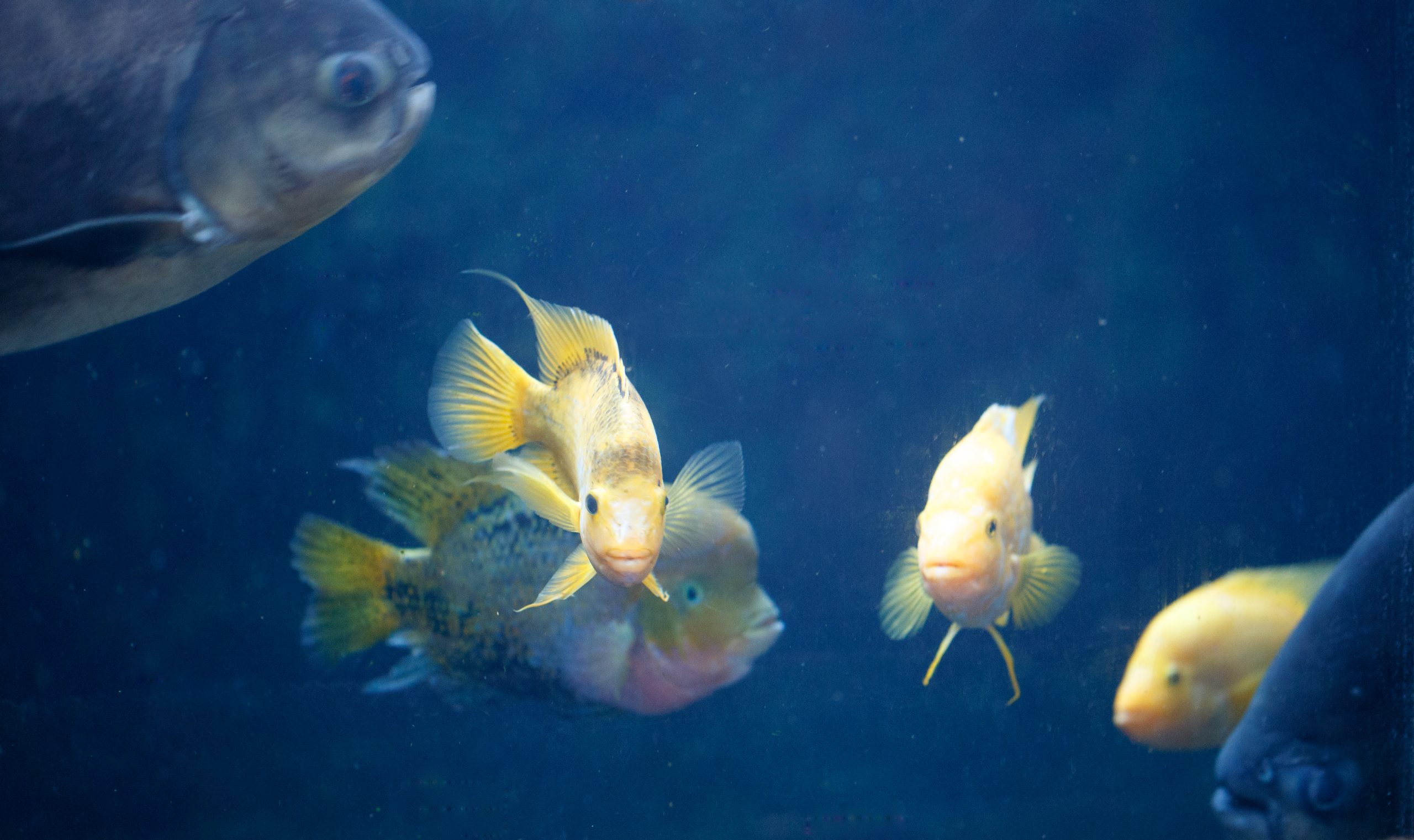
Fish Feeding in Tropical Encounters | Noon
Dive a little deeper into understanding the underwater world with this daily fish-feeding experience presented by Como’s interpretive staff.
-
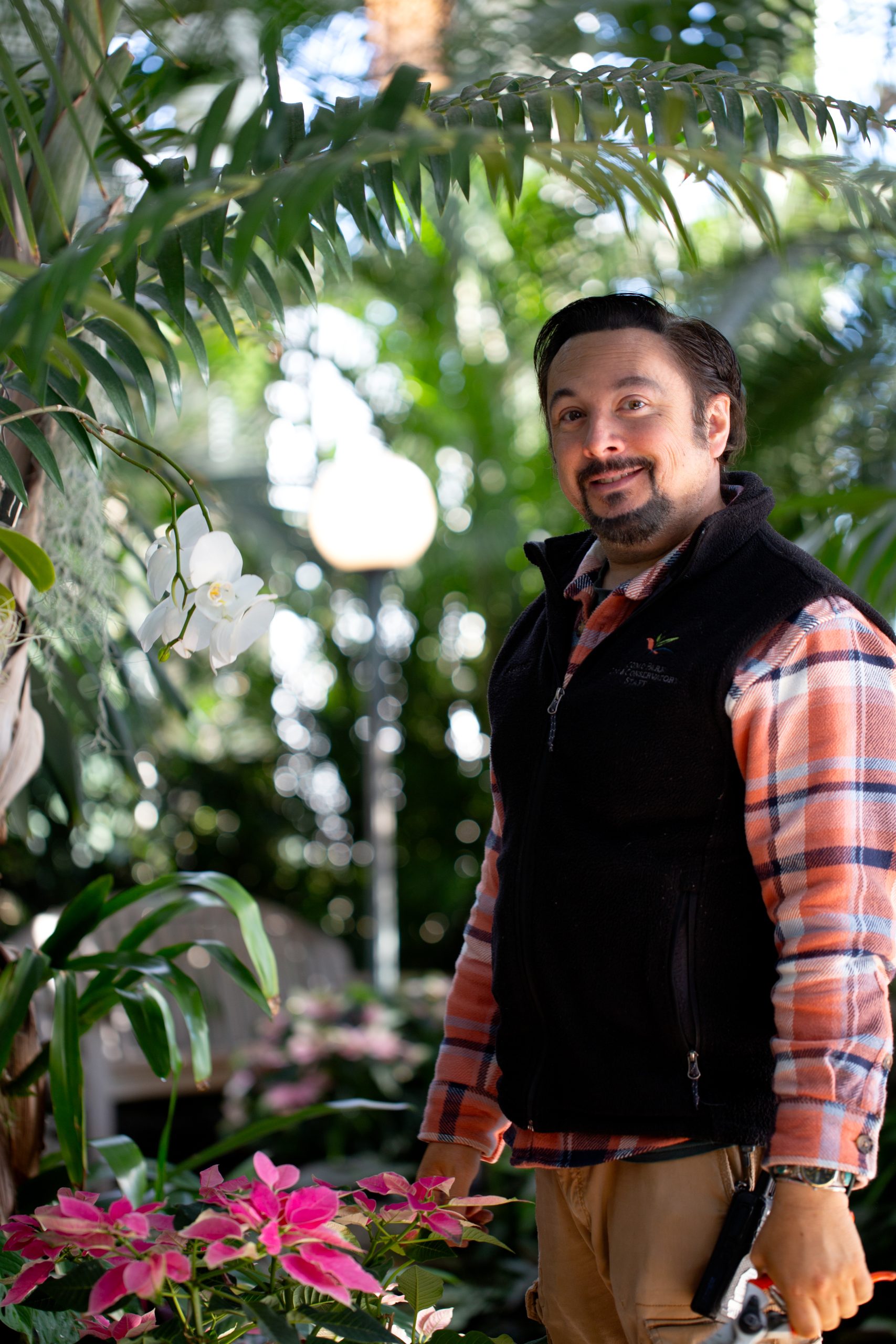
Gardener Chat | 1:00 p.m.
What does it take to keep the Marjorie McNeely Conservatory growing? Find out at this engaging Q and A, featuring a new topic in gardening and plant care every day.
-
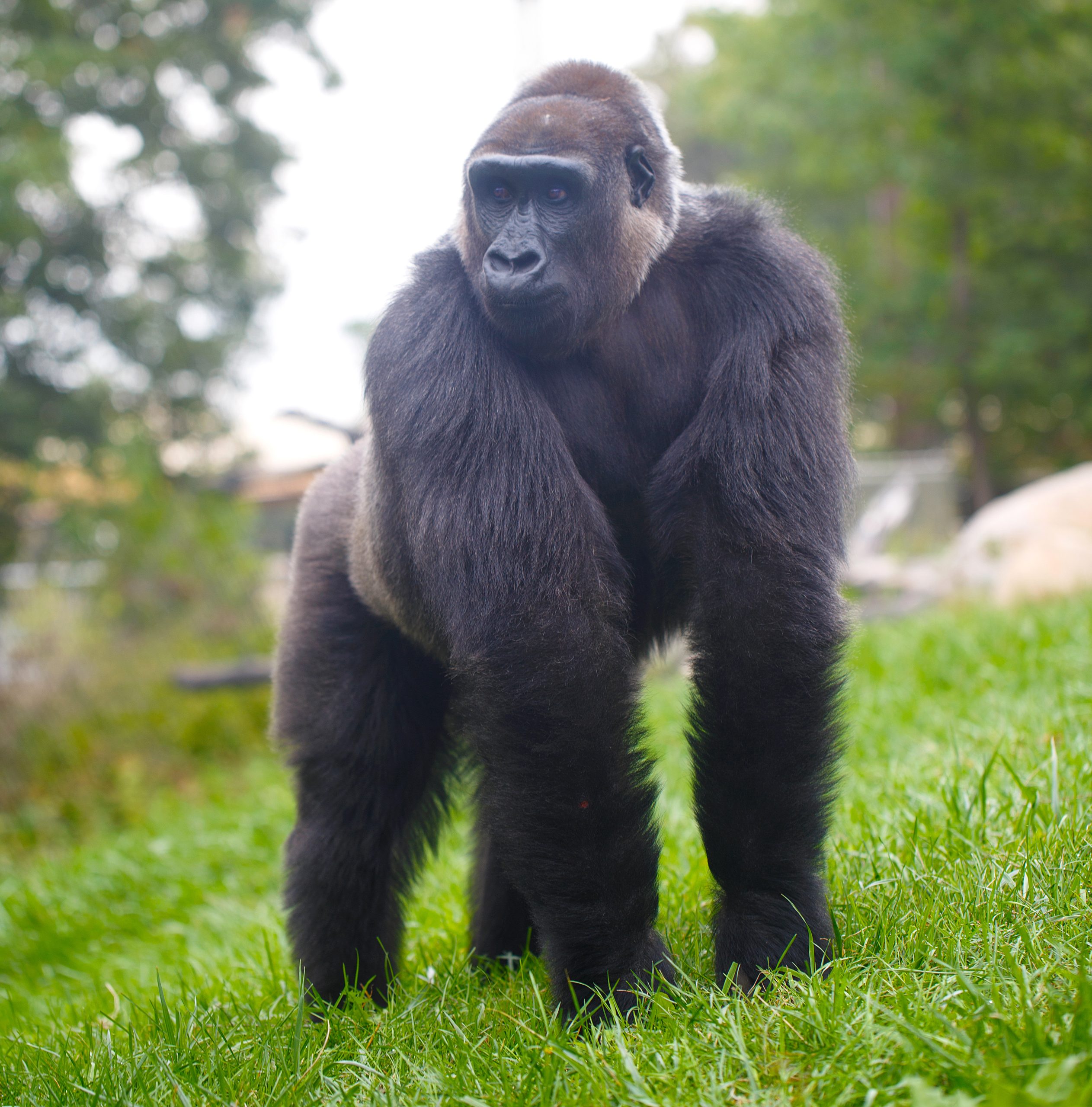
Gorilla Program | 1:30 p.m.
Meet the greatest of the apes face-to-face in Gorilla Forest, as primate keepers connect with Como’s western lowland gorillas, while exploring ways that you can help protect their wild cousins.
-
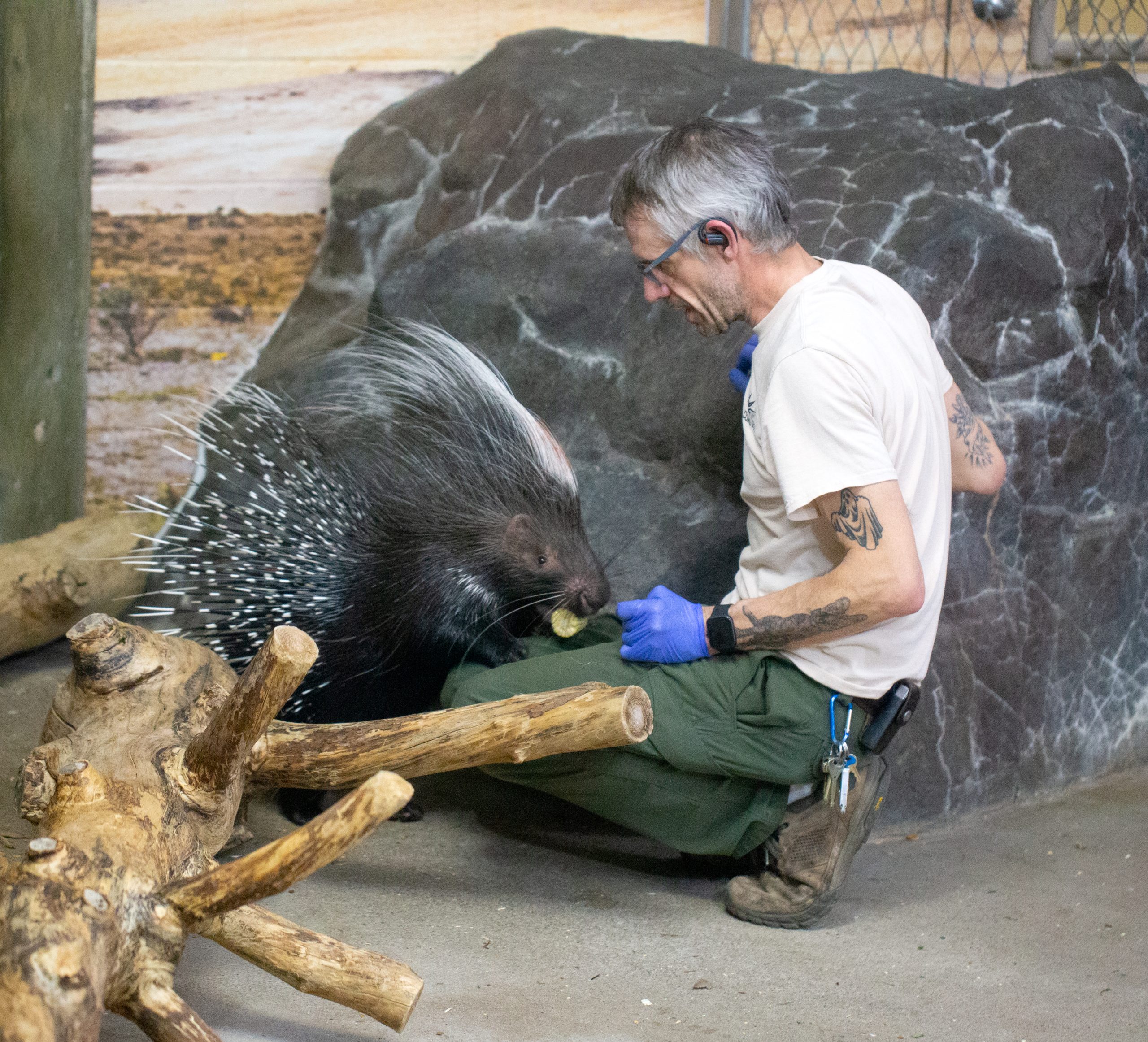
Porcupine Time | 2:00 p.m.
Como Zoo’s prickliest new arrivals, Russet and Copper, are the focus of this mid-day program, where you can learn all about the African crested porcupine.
-
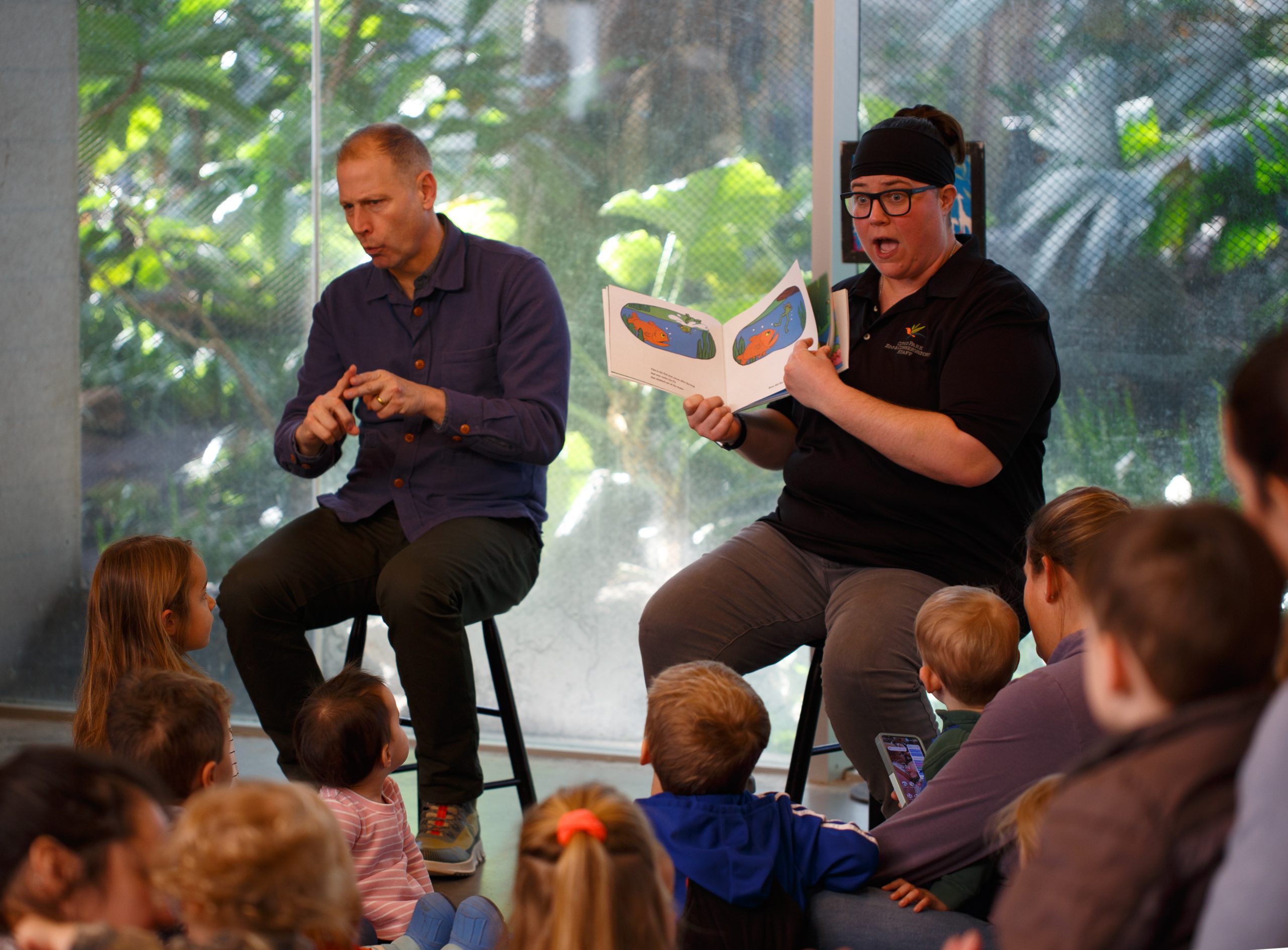
Story Time | 3:00 p.m.
Take a break in Como’s Visitor Center to listen to a nature-themed story perfect for preschoolers and other young learners.
-

Tiger Talk | 3:30 p.m.
Tiger mom Bernadette and her twin cubs Maks and Marisa are the focus for this daily conversation, all about the care and feeding of Como’s large cats.
-
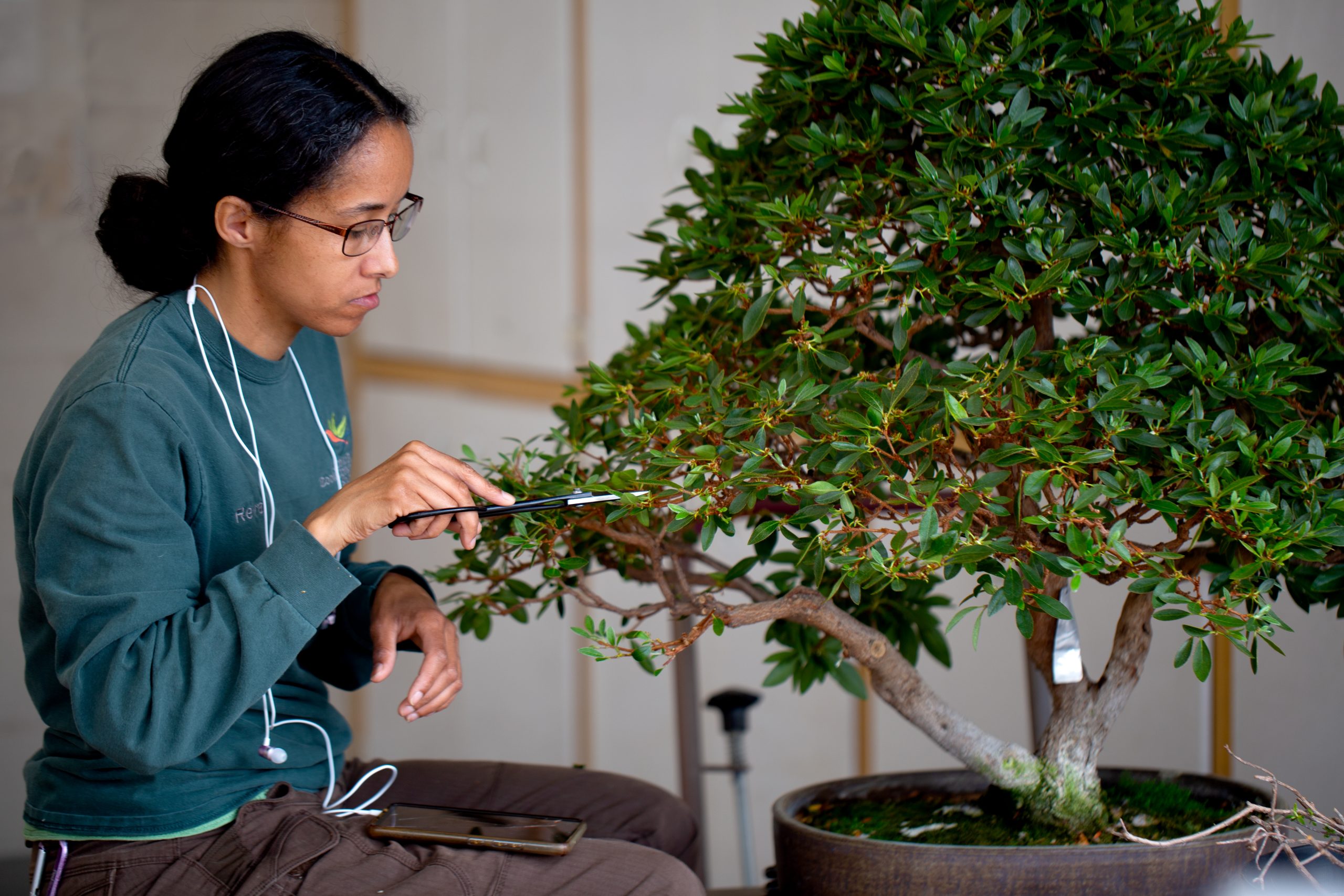
The Art of Bonsai | 4:00 p.m.
With one of the best collections of bonsai for public display in the Midwest, this daily program gives visitors the chance to learn more about the amazing trees in Como’s collection, and the history and philosophy of this ancient art form.
Special Programs
-
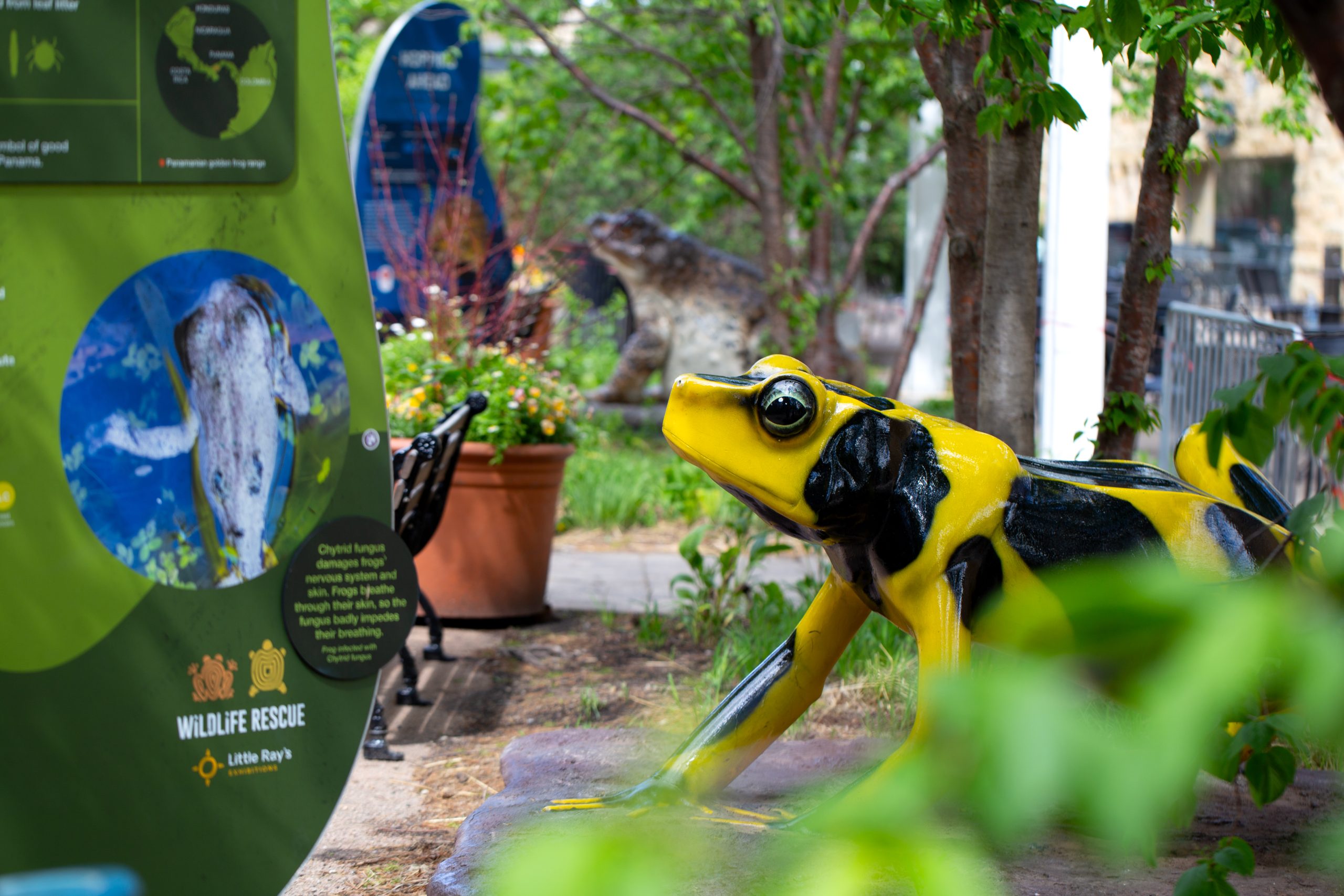
Wildlife Rescue: Tales of Conservation
Como’s latest free seasonal exhibit features 12 totally climbable animal sculptures from the black rhino to the Burmese star tortoise, highlighting endangered species that are now thriving in the wild thanks to committed acts of conservation.
-

Groovin’ in the Garden | Wednesdays from 6:00 p.m. to 8:00 p.m.
Put on your dancing shoes and pack a picnic for the Twin Cities’ favorite free summer concert series. Set against the beautiful backdrop of the Marjorie McNeely Conservatory, this outdoor concert series is fun for all ages, with favorite local acts, and fun activities for the kids. Mark your calendar for these upcoming events:
June 11 – Innocent Reggae Band – Roots Reggae
June 18 – Maria & The Coins – Singer-Songwriter Driven Pop Hooks
June 25 – Flamin’ Oh’s – Minnesota Music Legends
July 2 – Leslie Rich & The Rocket Soul Choir – 3-piece Rock Band
July 9 – Salsa del Soul – High-Energy Latin Dance Music
July 16 – Jellyjacket – All-Star Minnesota Rock & Roll Band
July 23 – Favourite Girl – Female Powered Rock Band
July 30 – School of Rock – St. Paul & Plymouth House Bands -
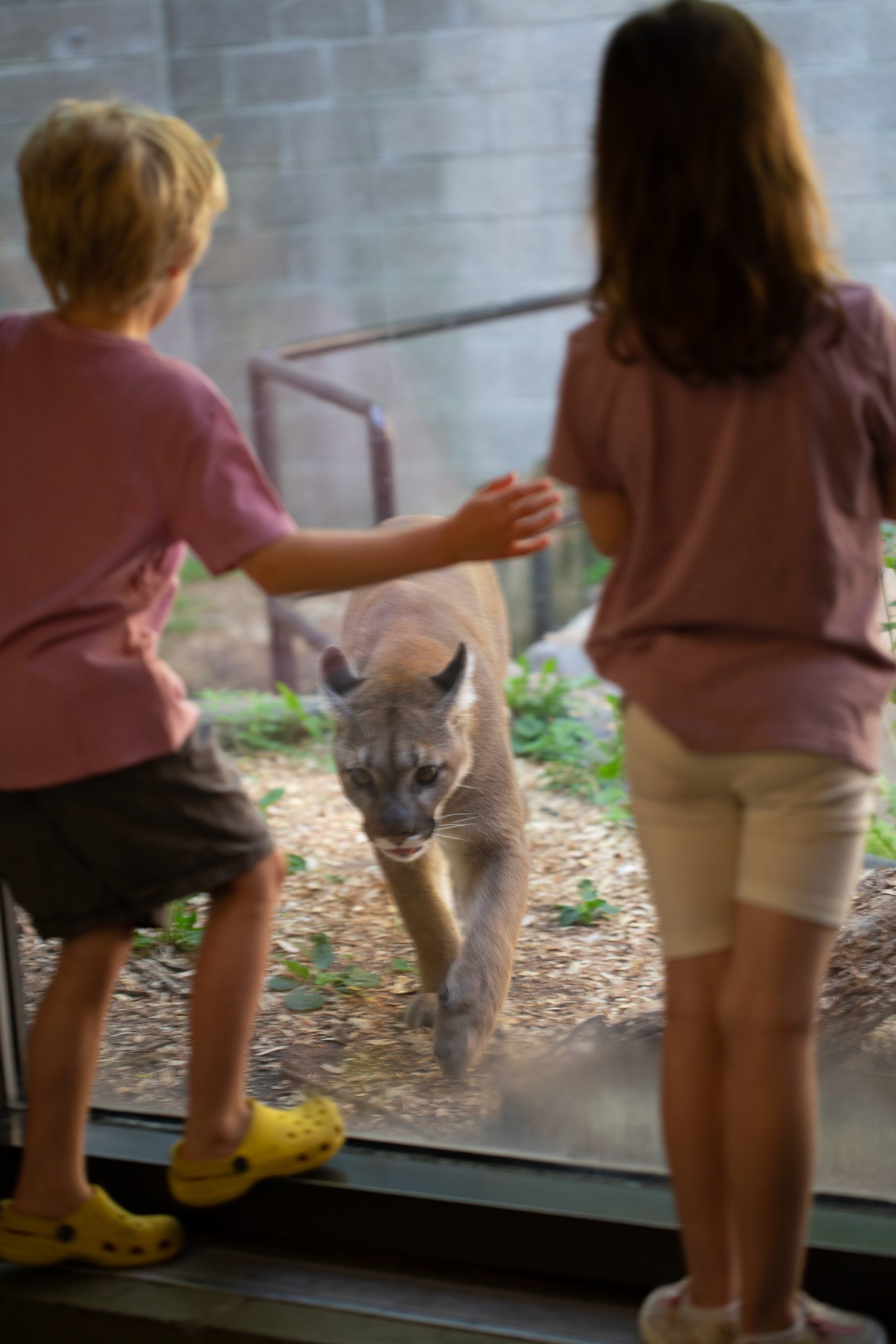
Autism-Friendly Early Entry
See Como Zoo without the crowds from 9 a.m. to 10 a.m. during these early access days:
June 7, June 18, July 12, July 23, August 9, August 20, September 13, September 21
-
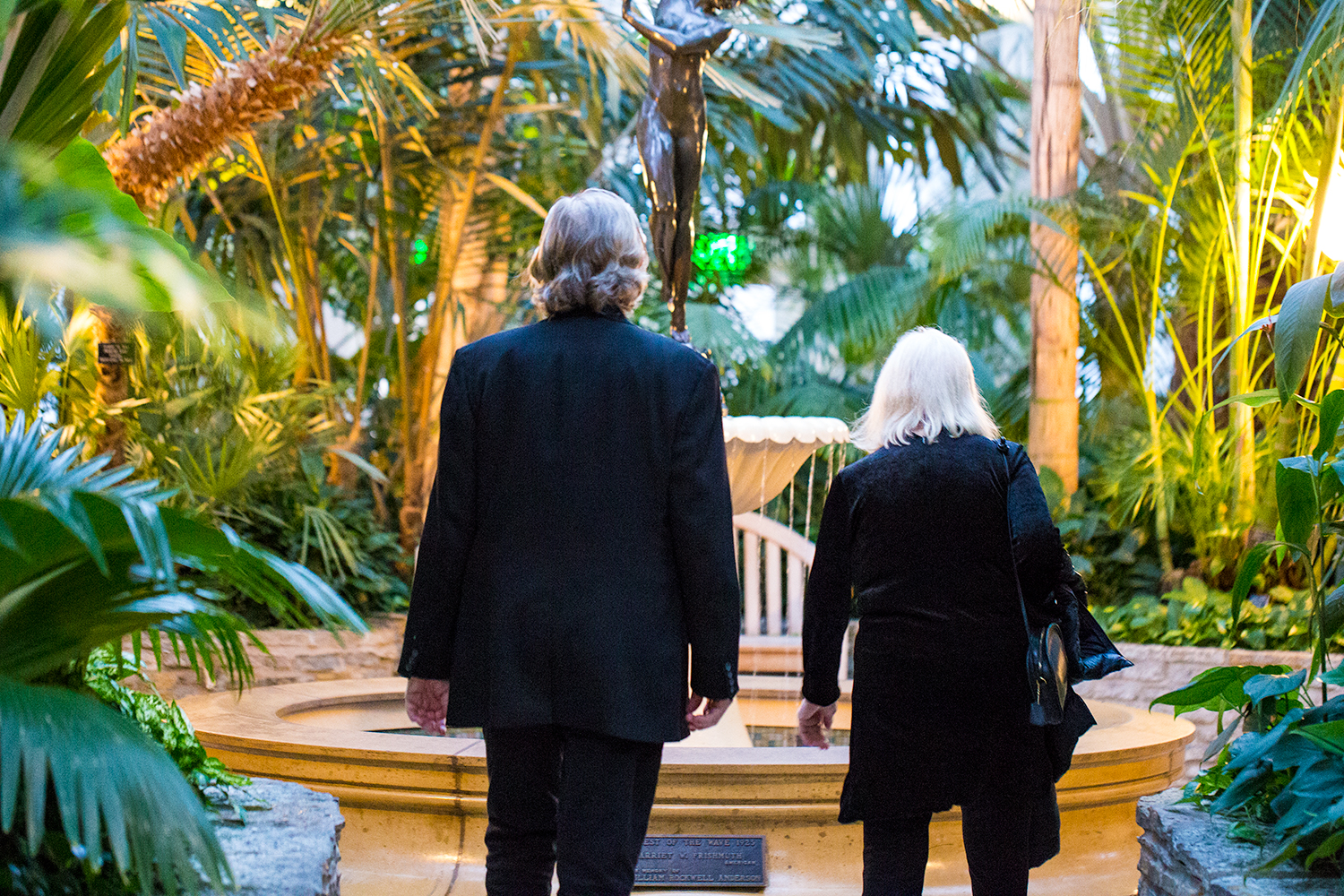
Senior Strolls
Take some time to smell the roses during these special entry times, set aside for seniors.
June 10 – 6:30 p.m.–8:00 p.m.
June 17 – 9:00 a.m.–10:00 a.m.
July 8 – 6:30 p.m.–8:00 p.m.
July 22 – 9:00 a.m.–10:00 a.m.
August 5 – 6:30 p.m.–8:00 p.m.
August 19 – 9:00 a.m.–10:00 a.m.
September 9 – 6:30 p.m.–8:00 p.m.
Conservation Champion Andrea Persson traveled to Sausalito’s Marine Mammal Center to learn the secrets of seal and sea lion care
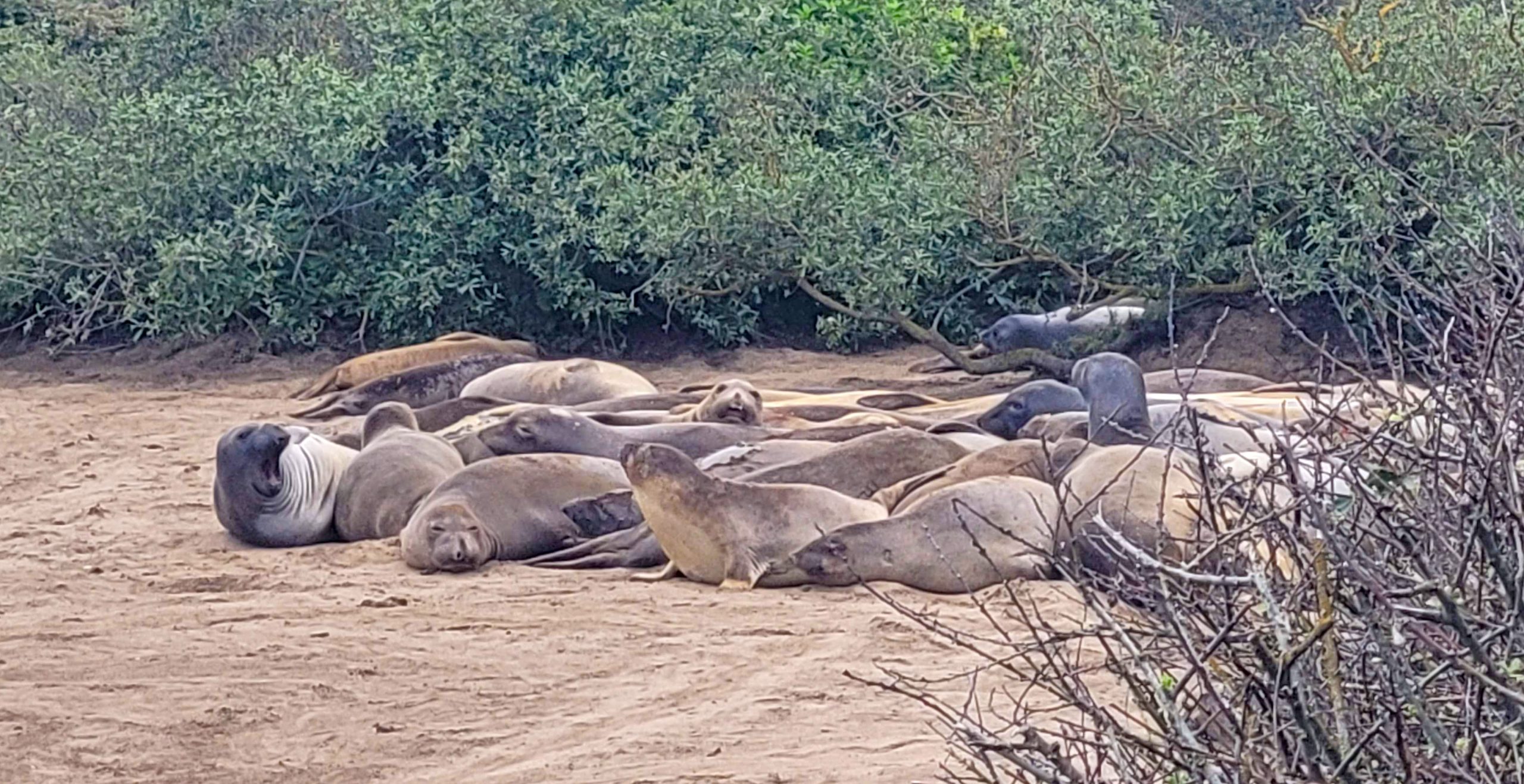
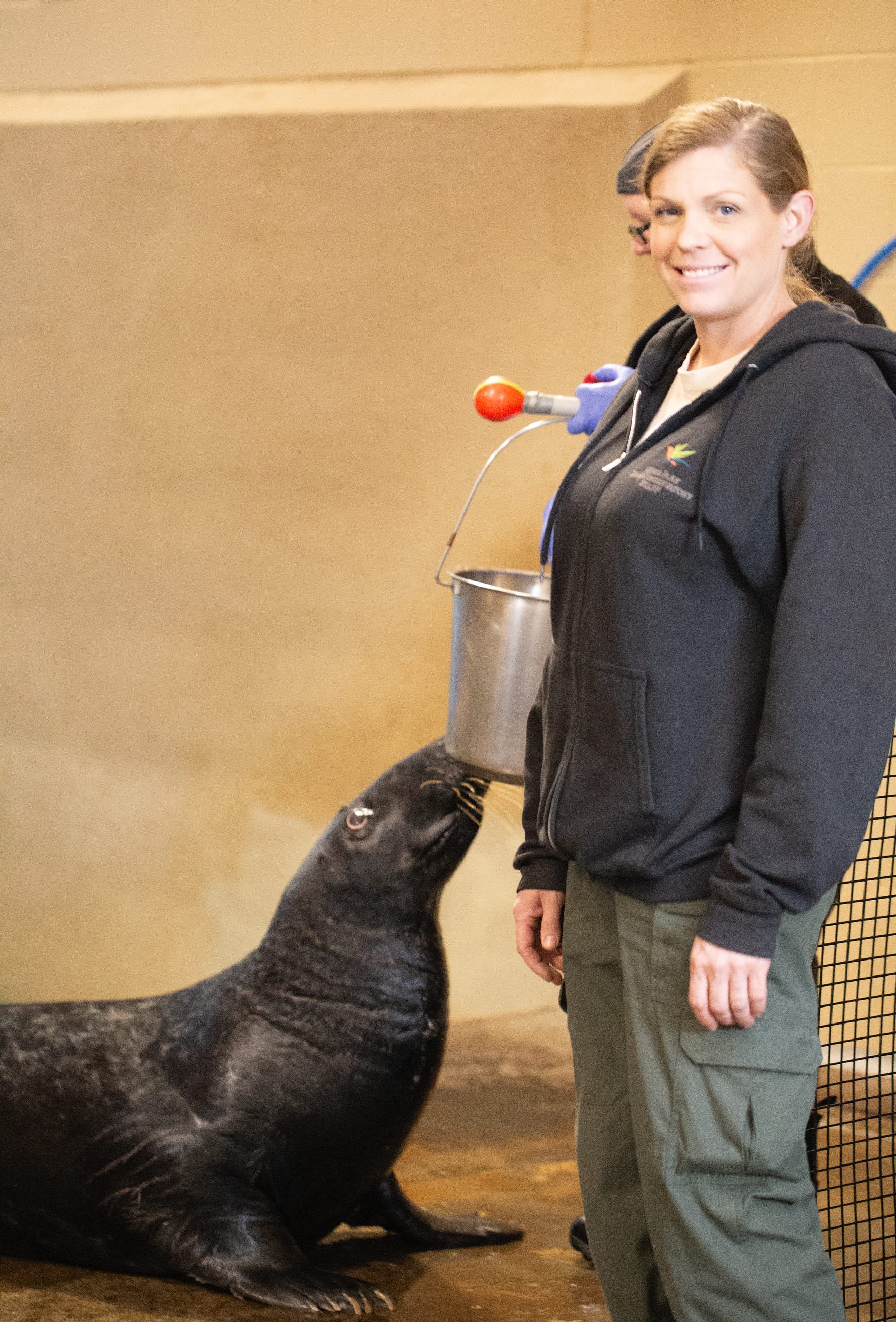
If you’ve been to a Blaze Sparky Show at Como Zoo, you know that sea lions like Sparky are capable of some amazing feats, from diving nearly 60 stories below the ocean’s surface, to holding their breath for up to 20 minutes at a time.
But some of the adaptations that work swimmingly in the sea can make veterinary care very complicated for seals and sea lions, particularly when it comes to anesthesia and other medical interventions. “They’re so trainable and willing to participate in their own health care that you can accomplish quite a lot when they’re awake,” says Como Zoo veterinary technician Andrea Persson. “But it can be much trickier when they’re sick and need to be immobilized, in part because of the dive response that allows them to conserve oxygen and also because we just don’t have to do it very often.”
That’s why Persson recently traveled to Sausalito, California, to attend an intensive veterinary training program at the Marine Mammal Center, the largest marine mammal teaching hospital in the country. Made possible by a grant from Como Friends’ Conservation Champions program, the five-day program allowed Persson to support the Center’s work, rehabilitating stranded seals and sea lions, while learning veterinary tips and tricks from experts who provide daily care to more than 80 elephant seals, harbor seals, and sea lions.
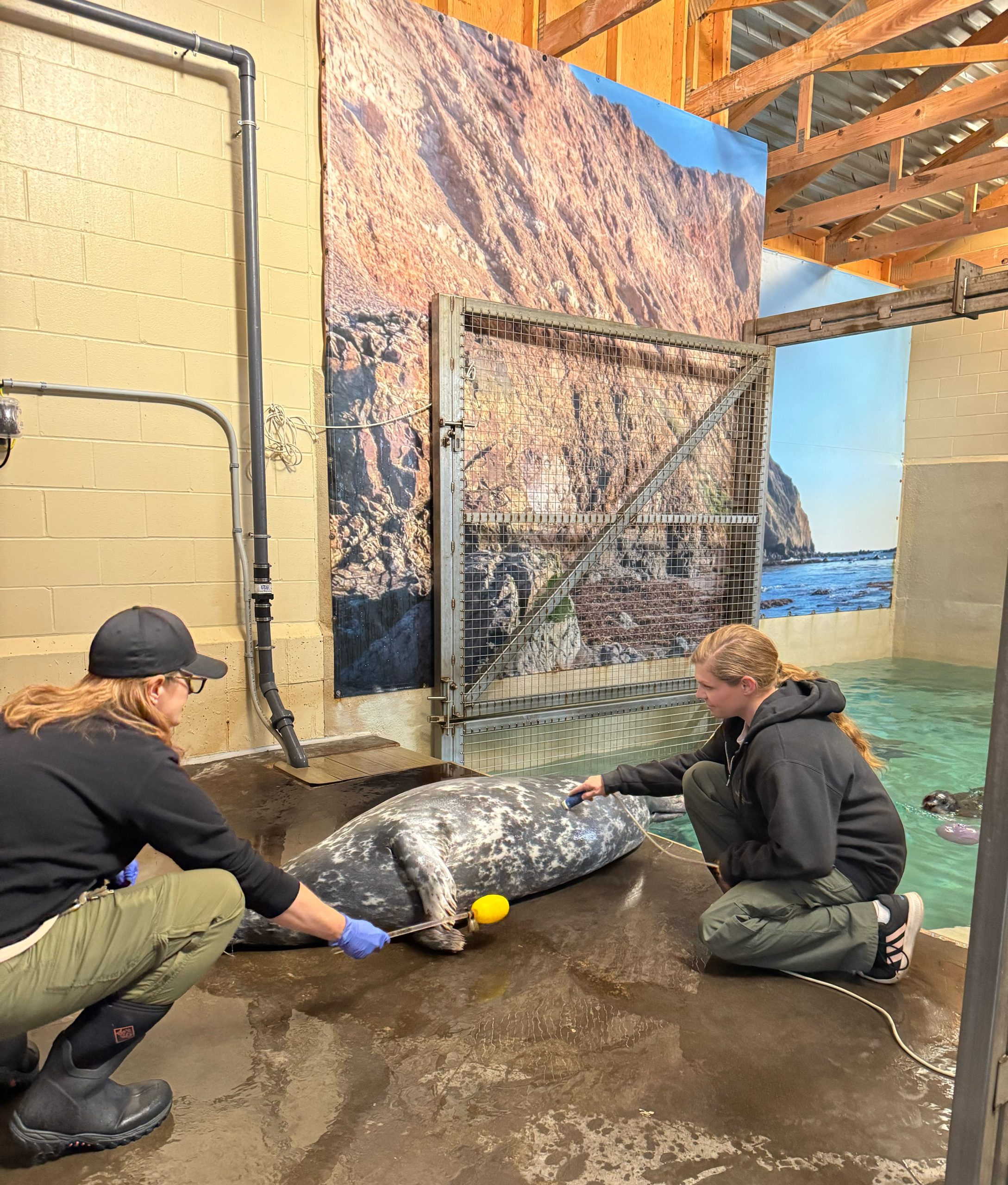
“Part of their mission is to expand the number of veterinary professionals that are equipped to deal with seals and sea lions, and it was a great opportunity for me to get concentrated hands-on experience,” says Persson, who cares for hundreds of different species at Como Zoo as part of her work with Como’s new on-site veterinary team. “One of my main objectives was to get good at collecting blood, because it’s one of the most important diagnostic things we can do with an animal, but it’s probably something I’ve done less than 10 times on a seal in my 20-year career.”
Drawing blood from a seal requires making a puncture near the animal’s spine. “One of my main objectives was to become proficient in blood collection. Blood samples are very important in providing information on the health of the animals we care for and with our relatively small population of seals at the zoo I had limited opportunities to refine my venipuncture techniques. It was great to be able to collect blood on multiple animals each day while I was at the MMC and I am now very confident in my ability to collect blood from our animals at the zoo.”
Since 1975, the Marine Mammal Center has rescued more than 26,000 marine animals along 600 miles of California coastline and in Hawai’i, typically answering more than 10,000 distress calls about sick, injured, or entangled marine mammals every year. During Persson’s stay in April, the Center was providing safe harbor to dozens of orphaned elephant seal pups, which are born at about 75 pounds and weigh nearly 300 pounds just a month later when they’re fully weaned from their mothers. In spite of their impressive size, young seals can often be separated prematurely when strong storms wash them off of beaches before they’ve learned how to survive on their own. Climate change makes the problem worse, as rising sea level and storm surges are more likely to sweep mothers and pups away from each other.
Distressed elephant seal pups are routinely rehabilitated at the Marine Mammal Center, but before they can be returned to the ocean, they need to be taught how to eat an adult diet of fish, squid, krill, and algae. “But you have to do it in such a way that you’re not habituating them to people,” says Persson. “It’s very difficult to get them to eat, because if they get even a little bit of water in their mouth with the fish they don’t know what to do, and they start gagging.”
The time Persson spent with pinniped pups may soon come in handy thanks to a new breeding recommendation for Como Zoo’s Atlantic gray seals, Wally and Medusa. And getting the chance to see wild harbor seals and sea lions on the California coast gave her even more appreciation for the species. “I would say the whole experience was invaluable, and gave me so many ideas to bring back to Como Zoo to improve care for our animals,” says Persson. “I’m very grateful.”
Private contributions from people like you are critical to support conservation efforts at Como Zoo and in the wild. Thank you!
The Marjorie McNeely Conservatory’s Summer Flower Show opens June 13, and regular visitors will notice it has a whole different vibe.
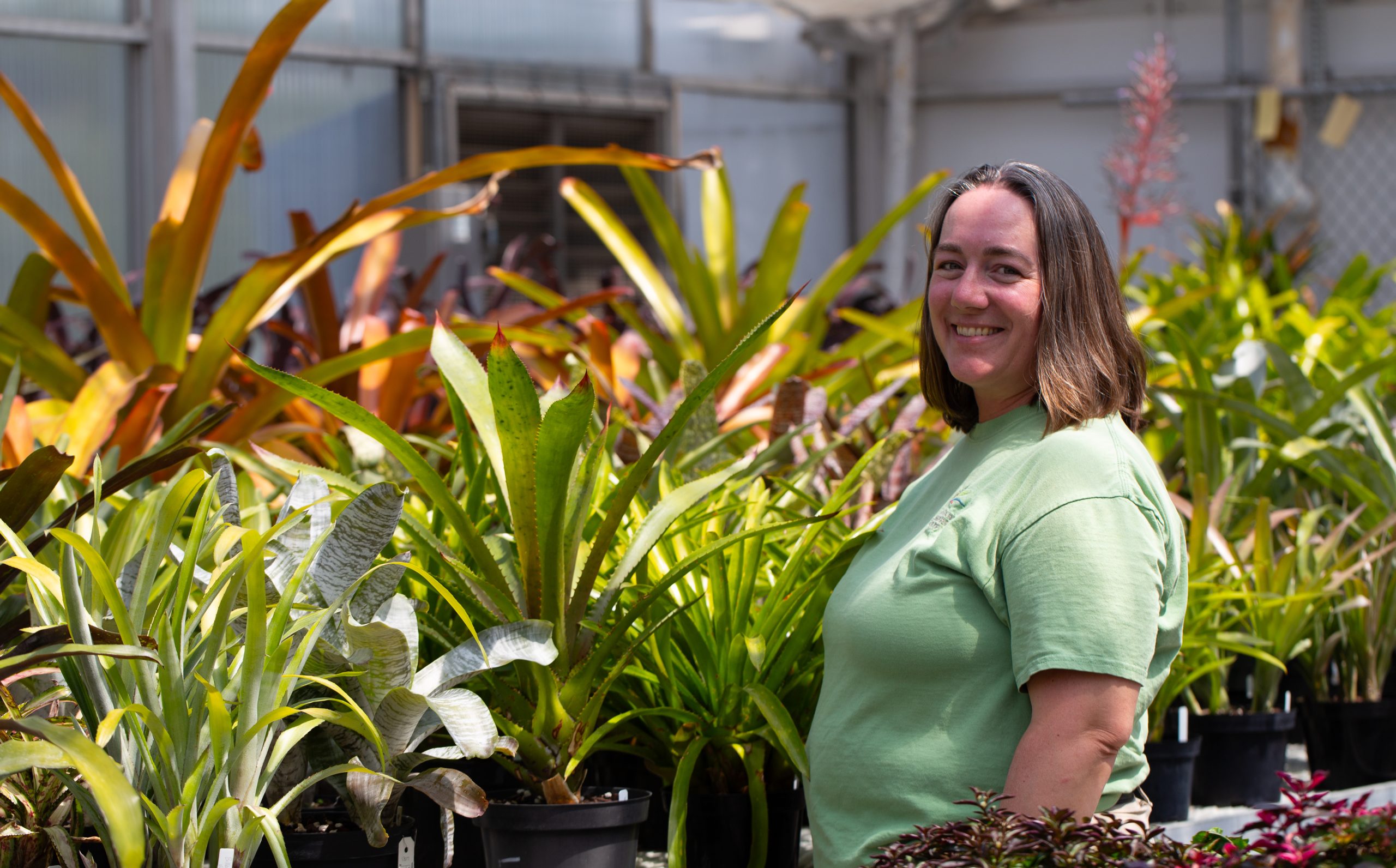
While Como’s longest-running flower show will still feature dozens of tropical annuals, the starring role this season will belong to Como’s exceptional collection of bromeliads.
“We’ve never used the Sunken Garden as a showcase room for a plant collection before, but we have such a variety of bromeliads currently,” Como Senior Horticulturist Ariel Dressler says, noting that Como visitors recently bestowed the “Cutest Plant” award on a tiny pineapple bromeliad. “We always want to put plants in a place where they’ll thrive and be happy, and with such a long show [that runs through September 14], bromeliads will do well. They’re such a charismatic plant, that to see them en masse will be a real treat.”
Bromeliads are also celebrating a birthday of sorts at Como. Fifty years ago, in September 1975, the horticultural staff established the Marjorie McNeely Conservatory’s first bromeliad garden. Como currently has 638 living bromeliads in its collection, from 350 different species, the best of which are often displayed in the understory of the historic Palm Dome.
To create the sheer number of plants needed for the Summer Flower Show display, horticulturist Diane Rafats propagated hundreds of bromeliad “pups” from Como’s own collection, coordinating their care to ensure they’re ready to bloom in time for the show. Hibiscus and citrus, colorful coleus, orange-red canna, coral-flowered fuchsia, and purple gomphrena will also be featured in the display, transforming Minnesota’s most beautiful room into a tropical paradise.
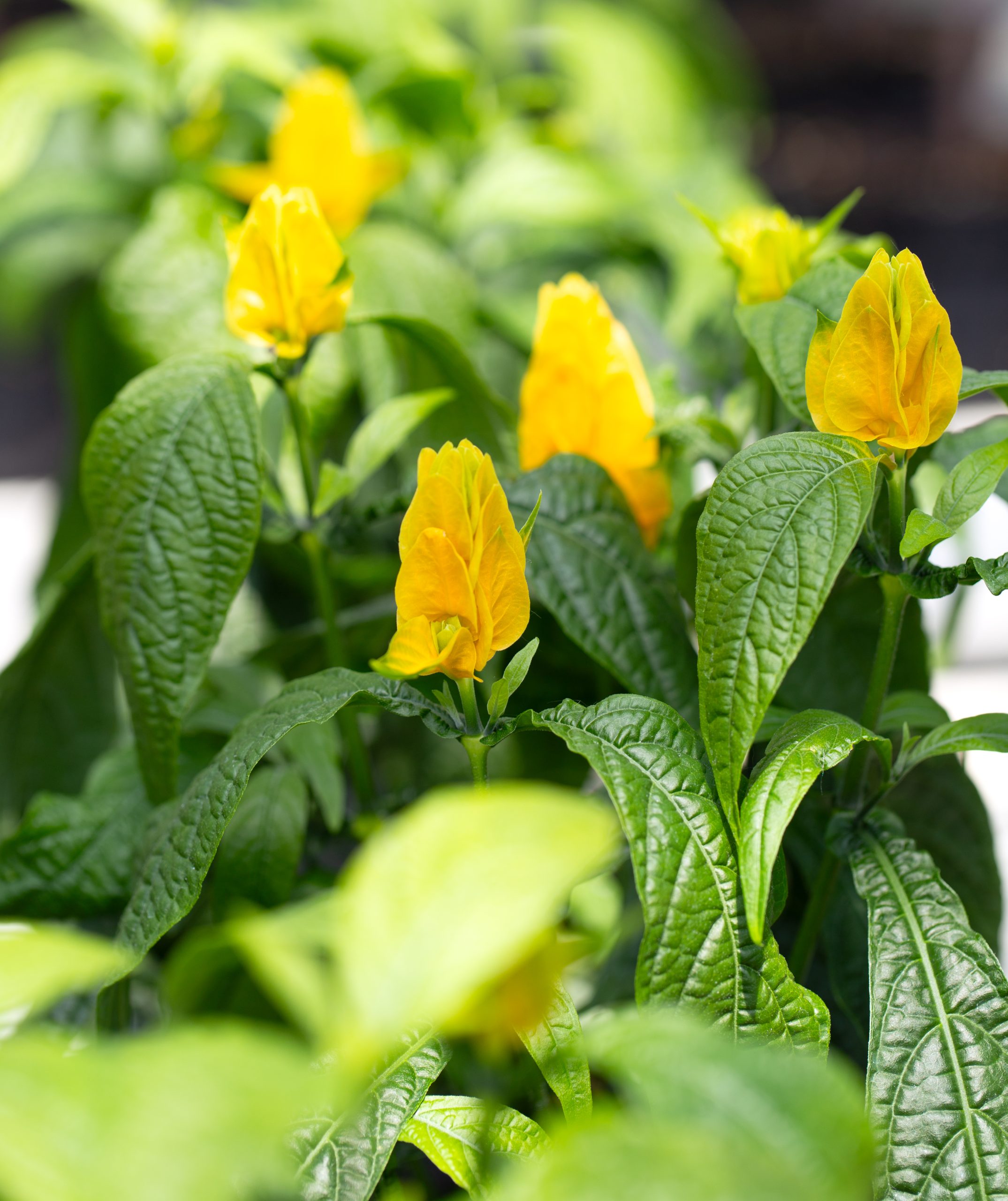
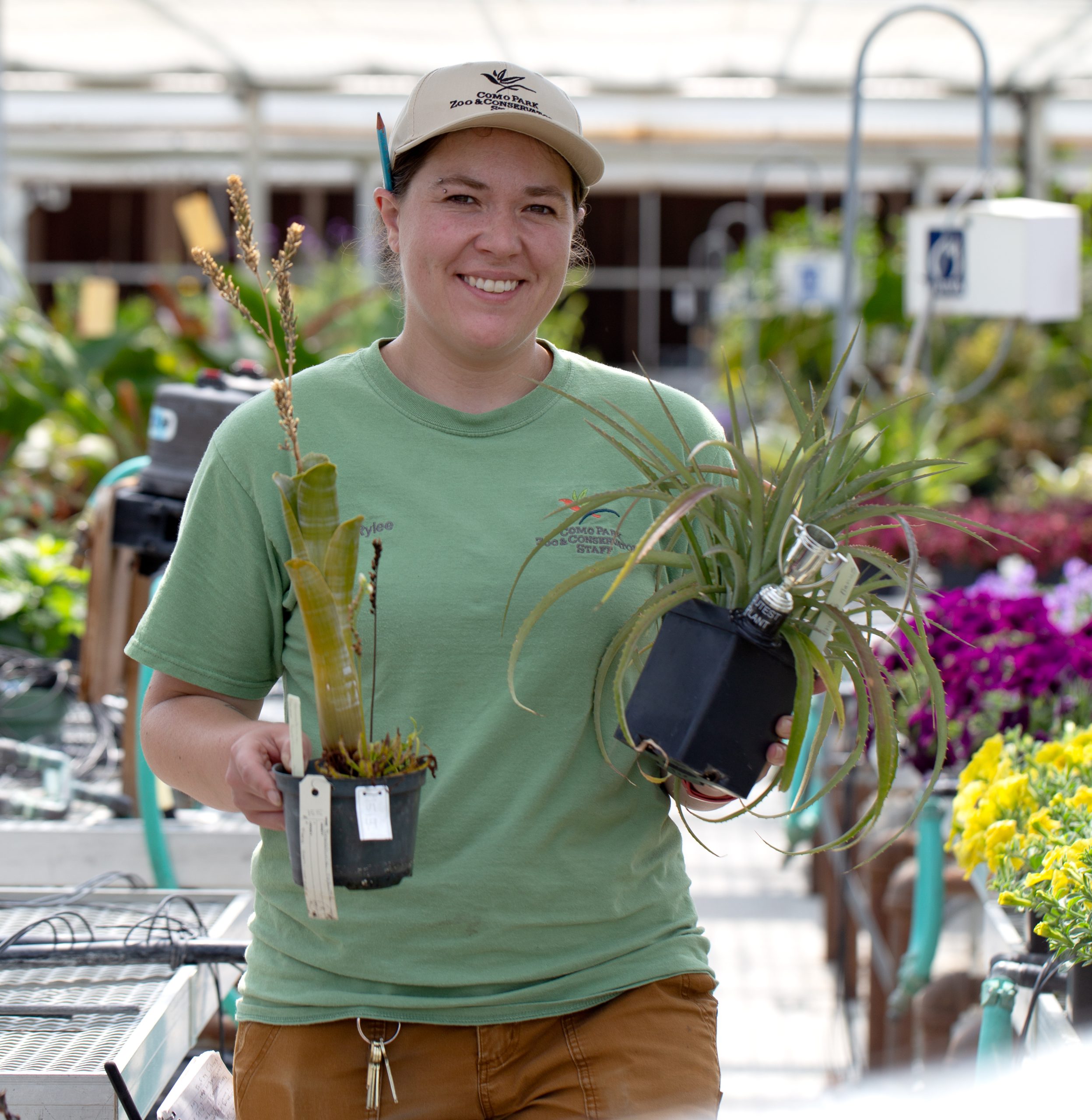
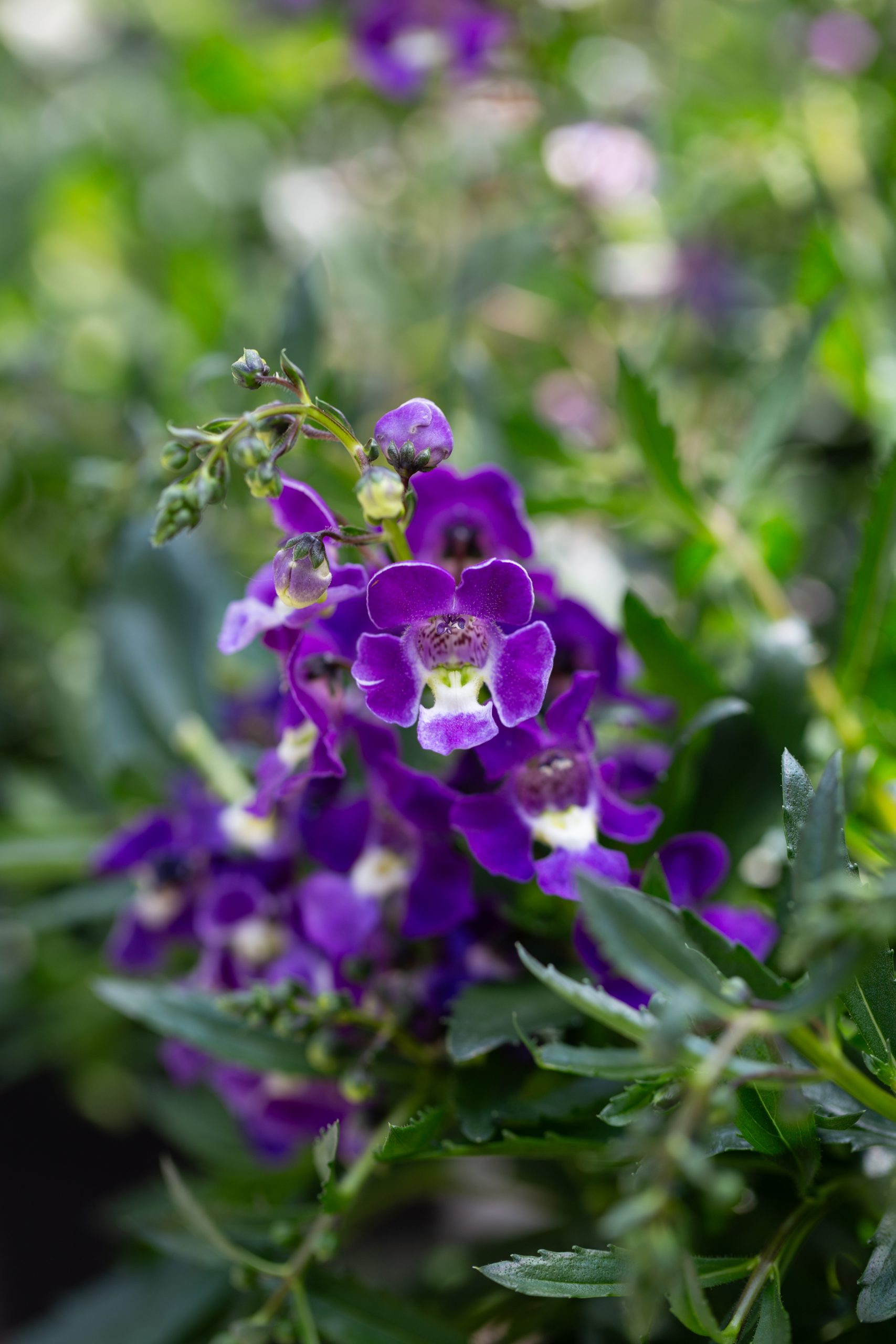
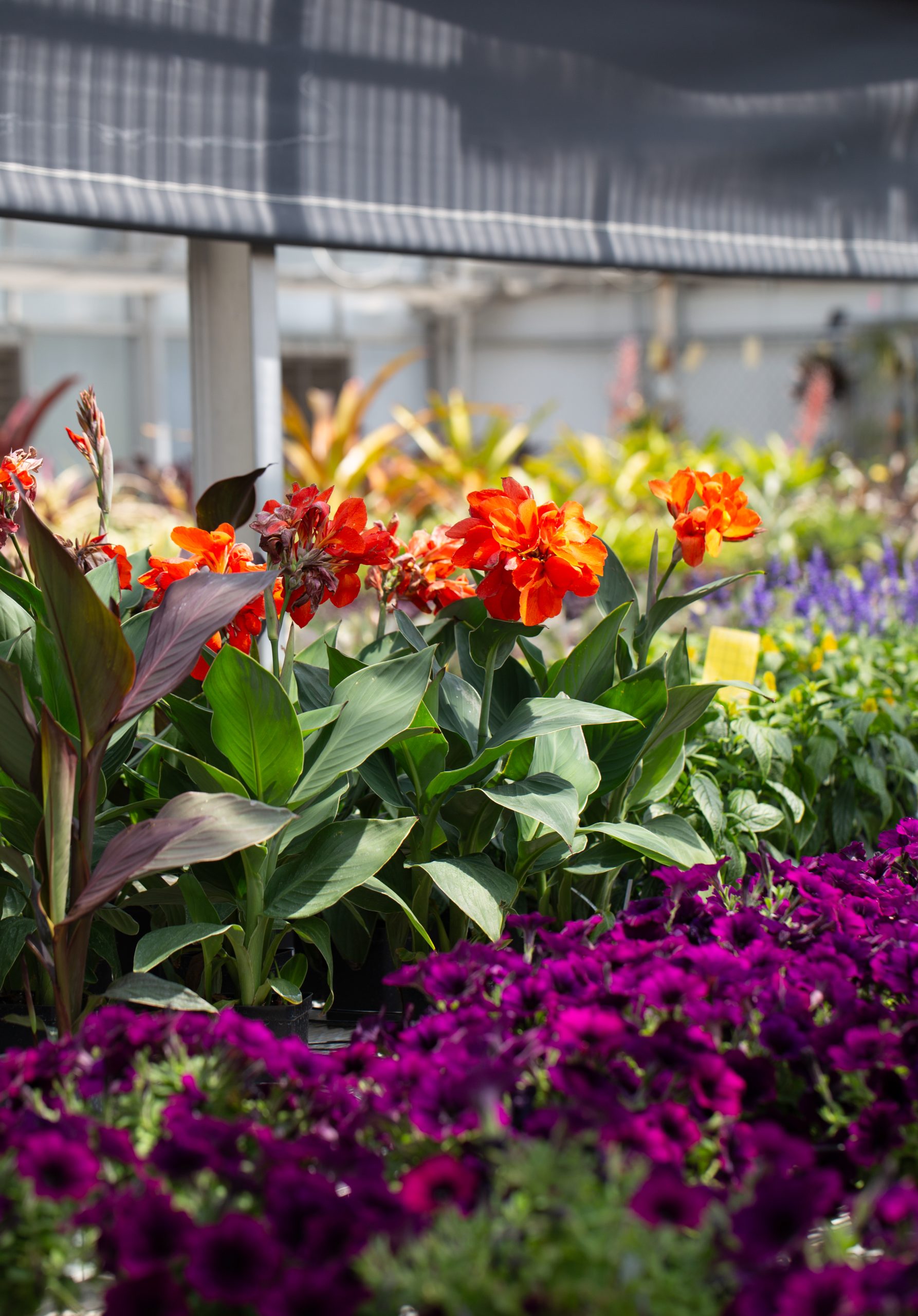
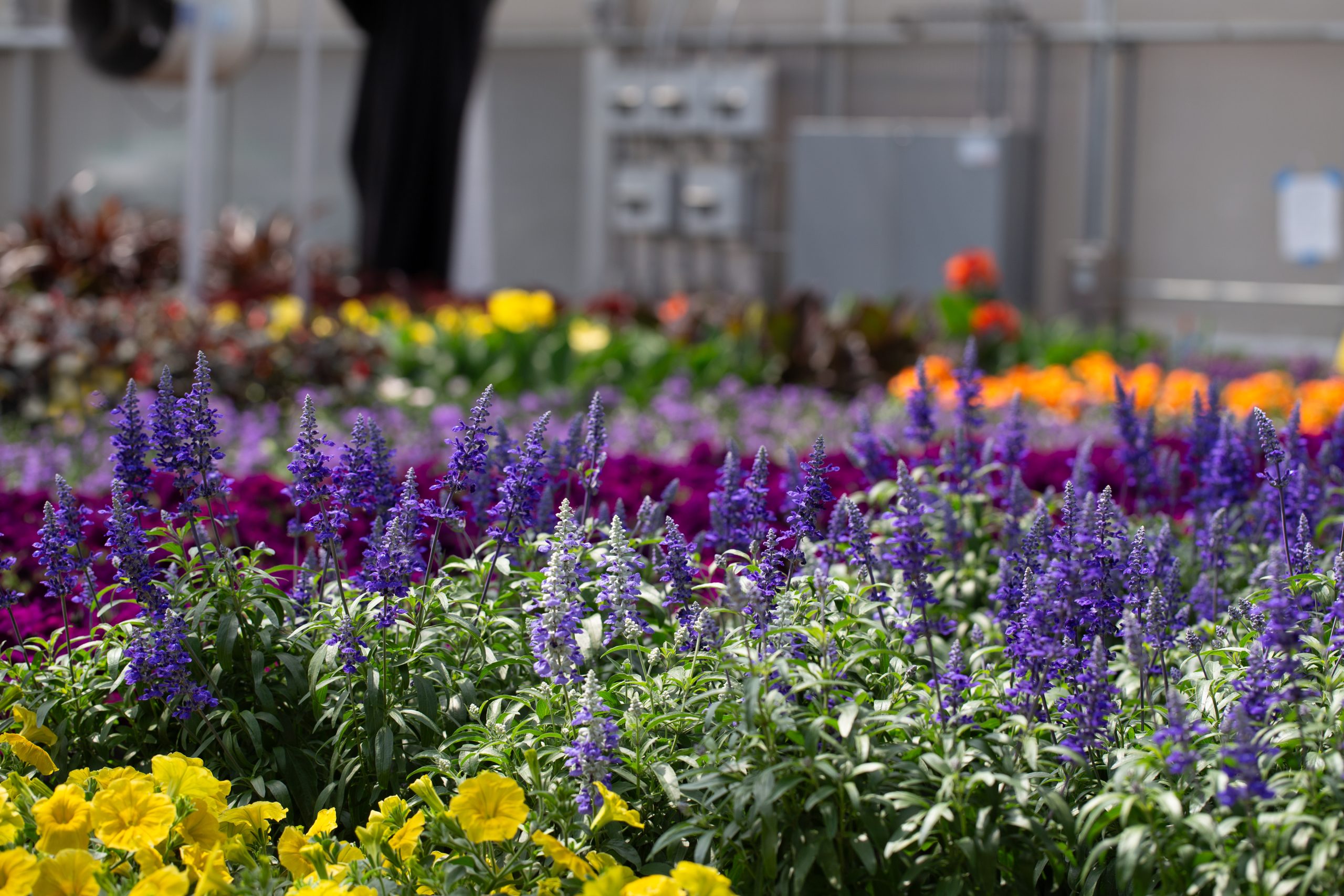
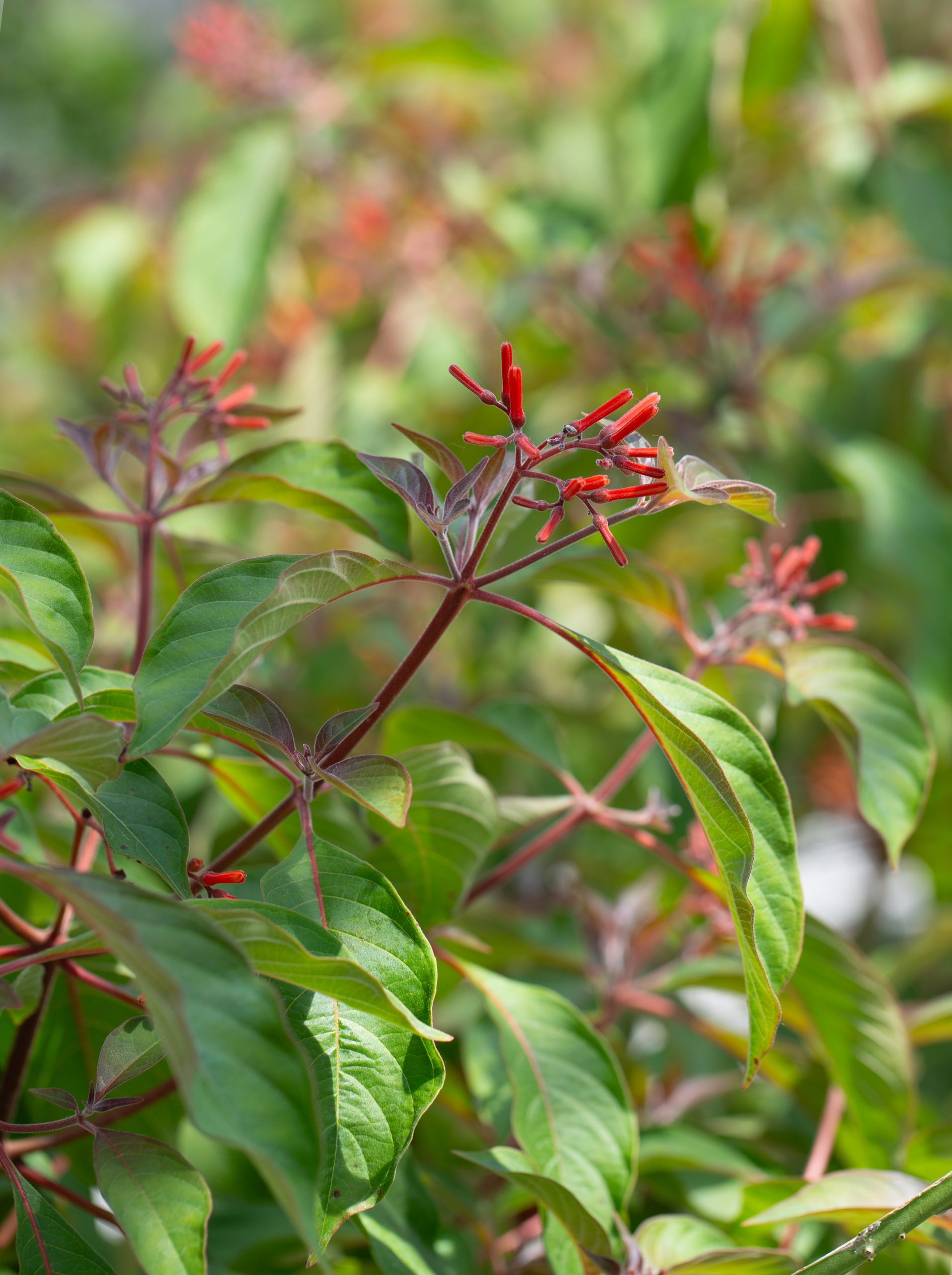
Your support for Como Friends helps ensure the Marjorie McNeely Conservatory’s seasonal flower shows are always free to every visitor. Thank you!
As she prepares to retire this year, founding president Jackie Sticha looks back on 25 years with Como Friends
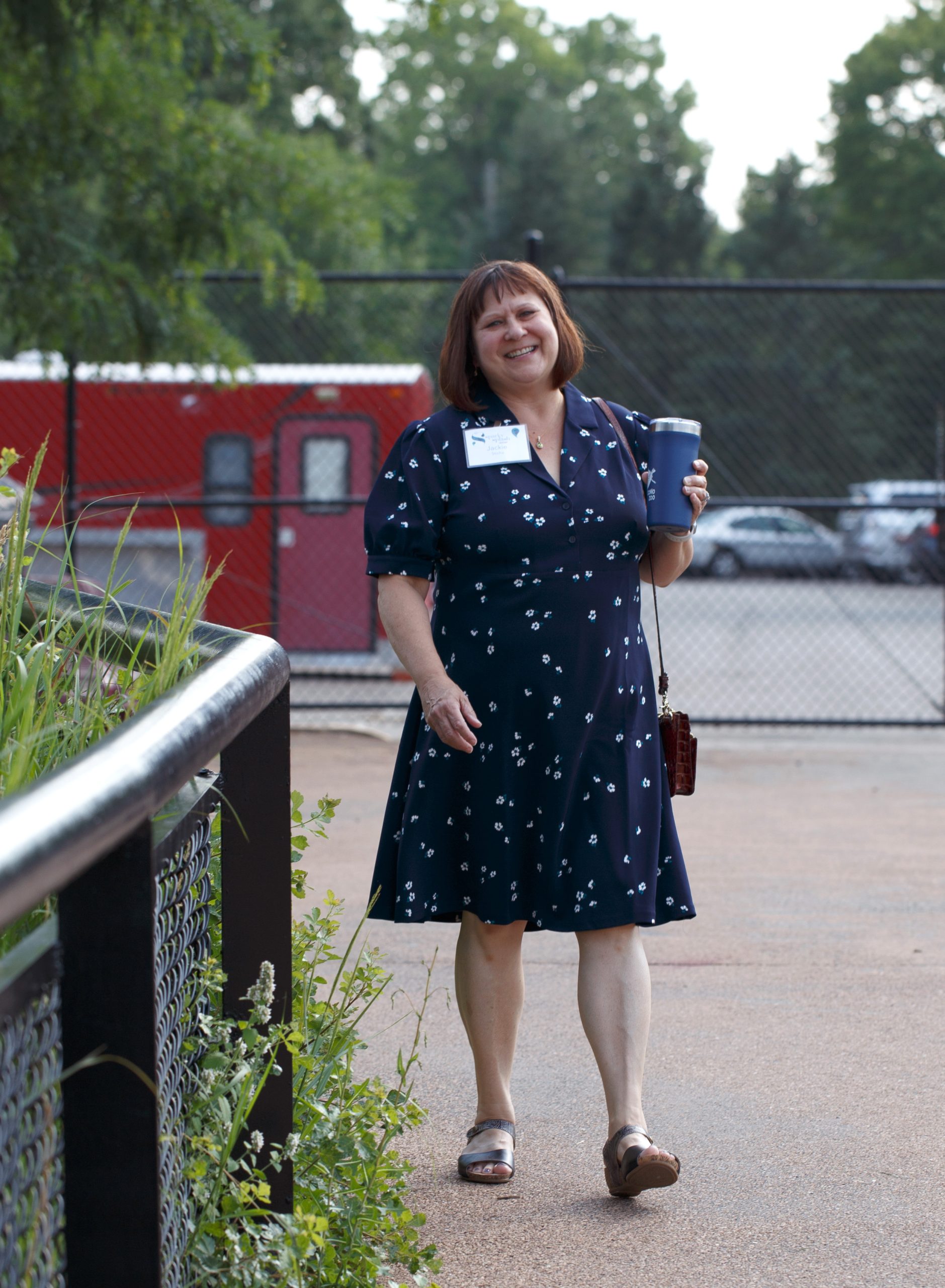
Nearly every day, Como Friends President Jackie Sticha takes a walk around the grounds of Como Park Zoo and Conservatory, but those first bright days of spring are always her favorites. “There’s really nothing like being at Como on a beautiful busy day, with thousands of people of all backgrounds and ages, tourists and teenagers, senior citizens, families and kids on field trips,” she says. “I often overhear conversations that are quite inspiring, or that make me chuckle. And I love the way the whole place buzzes with energy.”
The long-tenured president of Como Friends, Sticha can claim credit for a lot of that buzz. Since the organization’s founding in 2000, she’s led annual fundraising strategy, advocacy initiatives, and three successful capital campaigns that have contributed $52 million in new funding for the historic Como Zoo and the Marjorie McNeely Conservatory and leveraged an additional $50 million in state funds made possible through Como Friends’ advocacy work. These funds have had a big impact, creating new classroom space that serves thousands of students every year; unveiling cutting-edge habitats like Como Harbor, Polar Bear Odyssey, and The Ordway Gardens; and expanding programs that connect visitors to the wonders of the living world.
But 25 years ago, as an early hire of the newly formed Como Zoo and Conservatory Society, a merger of four different nonprofits and docent groups, Sticha’s first job was figuring out how to establish a strong public/private partnership that could protect the future of one of the Twin Cities’ most beloved institutions. “With 100 years of history, nearly everyone has a memory of coming to Como as a child, with their children, with their grandchildren,” she says. “Another strength was the passion and knowledge and commitment of the Zoo and Conservatory staff, and their vision for what could make Como even better.”
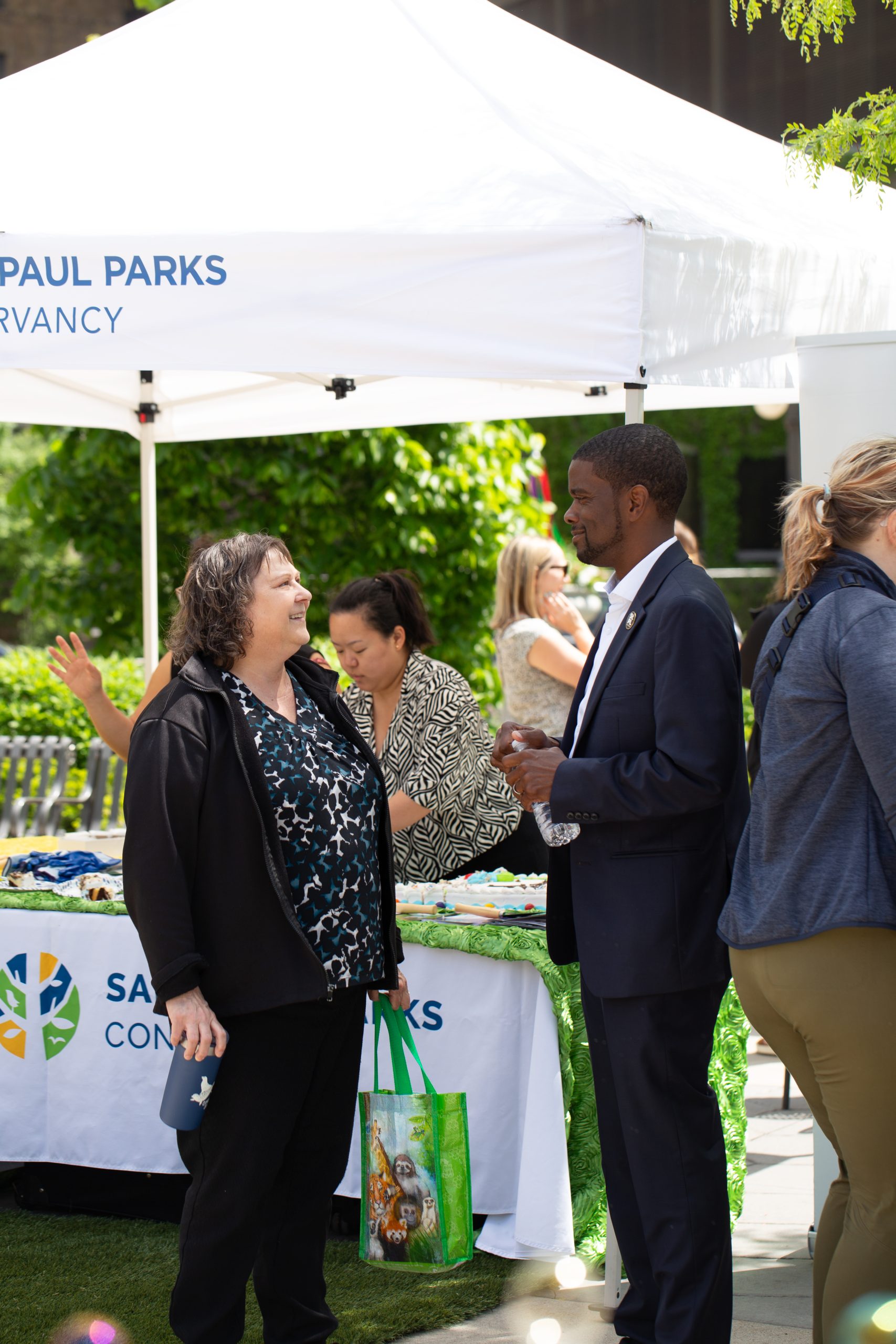
With strong support from the city and its parks department, an engaged board of directors, and such visionary volunteer leaders as Leonard Wilkening, Arlene Scheunemann, Bob Piram, and Paul Verret, the Society (renamed Como Friends in 2008) launched a major capital campaign to unite the Zoo and Conservatory through the Visitor Center, and to provide much-needed updates to the historic campus with new spaces for animal support, plant collections and administration. “What drew me is that this was a brand new organization with some really big ideas,” she says. “We all had to build new relationships to move forward, and while we definitely made mistakes along the way, it was often out of an excess of enthusiasm for what was possible.”
During the most challenging times, Como Friends’ first board chair, the late Leonard Wilkening, would give Sticha this advice: “Just give it five years, and it will all work out.” His timeline was prophetic—within the first five years of their partnership, Como Friends and Como Park Zoo and Conservatory unveiled the new Visitor Center, Tropical Encounters, the new Fern Room and the first ever Orchid House to the public, with behind-the-scenes improvements that included a new Animal Support Building and administrative offices retrofitted in Como Zoo’s iconic WPA-era building. “As we all began working together, we started having more and more success,” Sticha says. “But unveiling the Visitor Center was the real turning point, because it was the first visual demonstration of what the future at Como would look like.”
Since then, Como Friends has led the charge on two additional capital campaigns, one for Como Harbor, and another to create Polar Bear Odyssey and The Ordway Gardens. Como Friends also secured the major gift that renamed the Marjorie McNeely Conservatory, and a $1 million endowment to create a permanent source of support for the Charlotte Partridge Ordway Japanese Garden.
During Sticha’s tenure, Como Friends finished each fiscal year with an operating surplus and increased the annual contribution to Como Park Zoo and Conservatory. Como Friends’ steady growth provided stability for Como, creating a dependable source for their annual operations and funding for ongoing improvements.
When public funding for Gorilla Forest was threatened, Como Friends expanded its profile to include advocacy work, joining Como each legislative season to support the campus’s role as both a community asset and an economic powerhouse that welcomes nearly two million visitors each year—the largest audience for any cultural institution in the state. Como Friends also successfully diversified its revenue streams with a mix of popular fundraising events like Bouquets, Sunset Affair, and Como After Hours; strong relationships with foundations and corporate funders; growing individual giving programs; and a successful gift shop operation, Garden Safari Gifts. “We’ve grown and learned a lot since our early years, but we’re still a relatively small team for the amount of money we raise, and for the extensive retail operation that we have, but we have a smart and nimble staff who are so innovative and creative in coming up with solutions for how we can be successful, and then working together to execute them,” Sticha says.
As she looks ahead to retiring this summer, Sticha says many of her favorite memories were made learning from supporters energized by their love of plants and animals, and working with families who have passed their commitment to Como from one generation to the next. She also thinks often of community leaders like Wilkening; the late Nancy Nelson, who raised funds for the Polar Bear Odyssey campaign with her husband Russ; and fundraising consultant Jim Scarpetta and others who were instrumental in making Como Friends’ vision a reality. “Every time we finish a new project, I think how pleased they would be to see how much progress Como has made.” She also thinks about some of her favorite animal ambassadors, including the late Amanda the orangutan, who once spiced up a behind-the-scenes tour by spitting a mouthful of water and orangutan kibble in Sticha’s direction. “Orangutans can hold a lot of water in their mouths, so it was like walking into a lake,” she laughs. “But I wasn’t offended at all. I felt like she’d chosen me.”
As Como Friends looks ahead to announcing the appointment of its next leader, she has some advice for her successor: “Have fun. Being at a job for 25 years is a long time to be in one place, but I’ve never been bored because Como is so dynamic, with living animals and gardens that are always changing and evolving. Between our staff, our board, and our donors, there are so many wonderful people connected to Como and it’s fun working with them, and working together for something that is so meaningful to our community.”
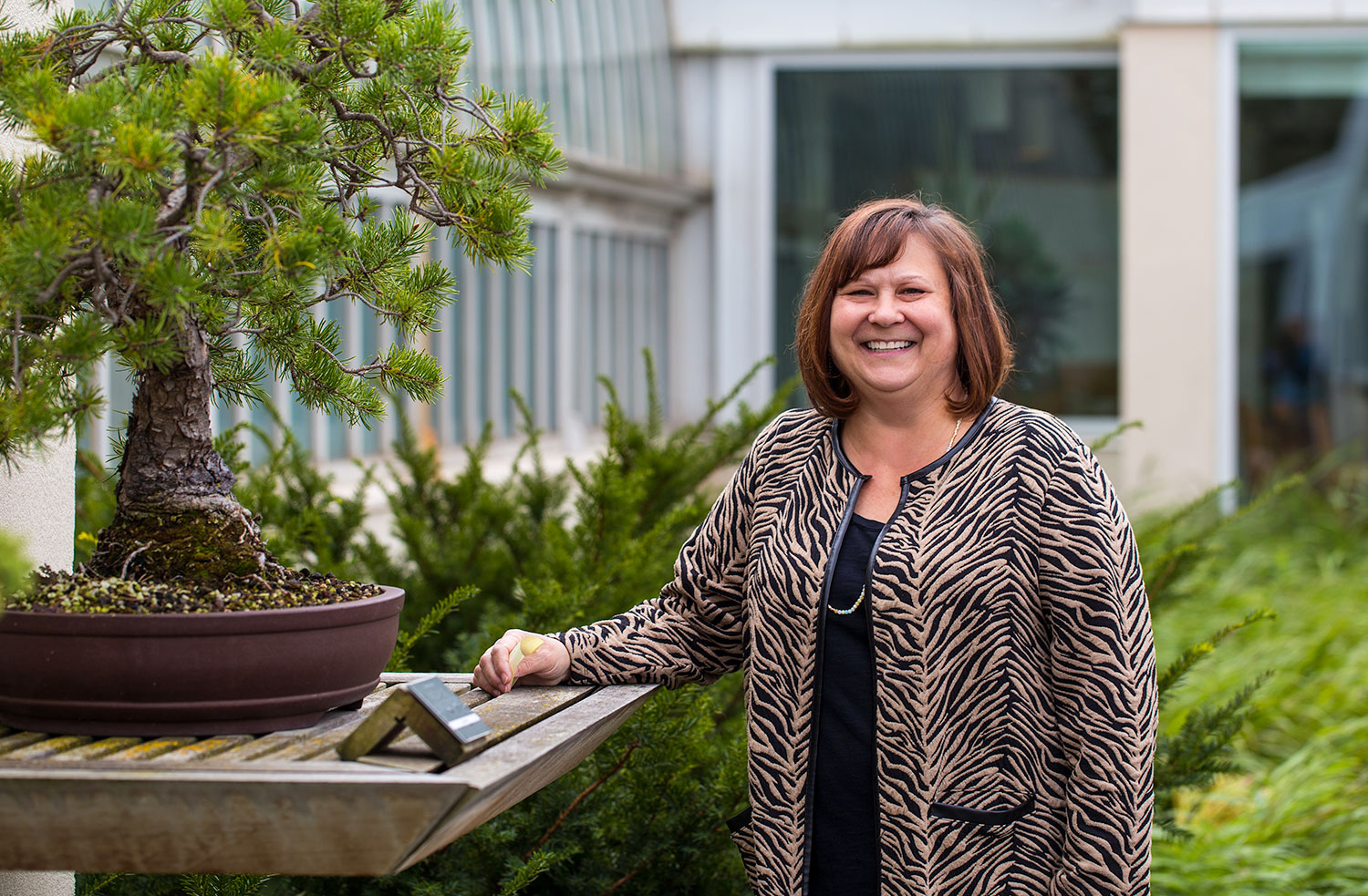
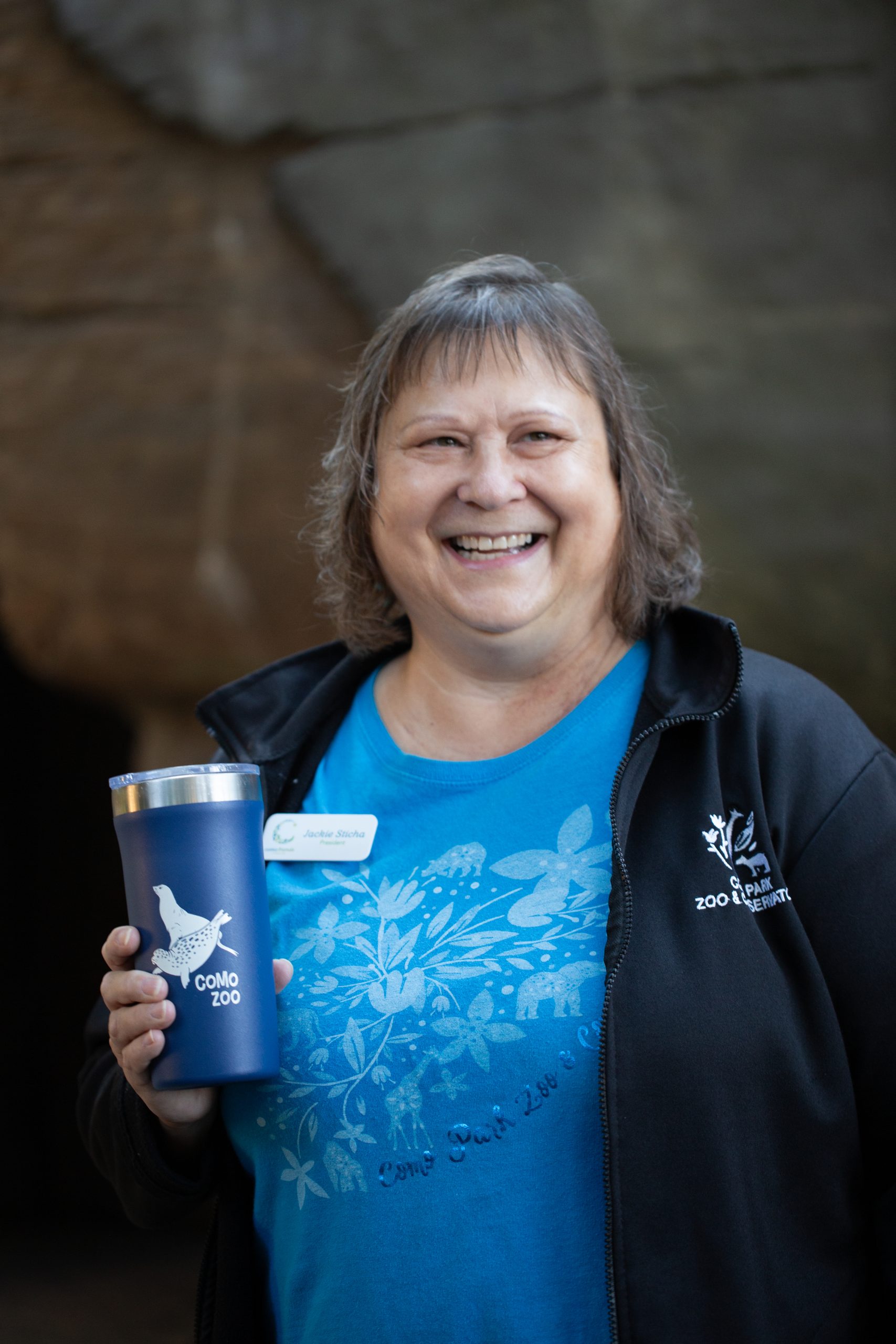
As studbook keeper for polar bears, Allison Jungheim preserves the health and genetics of North America’s most majestic species
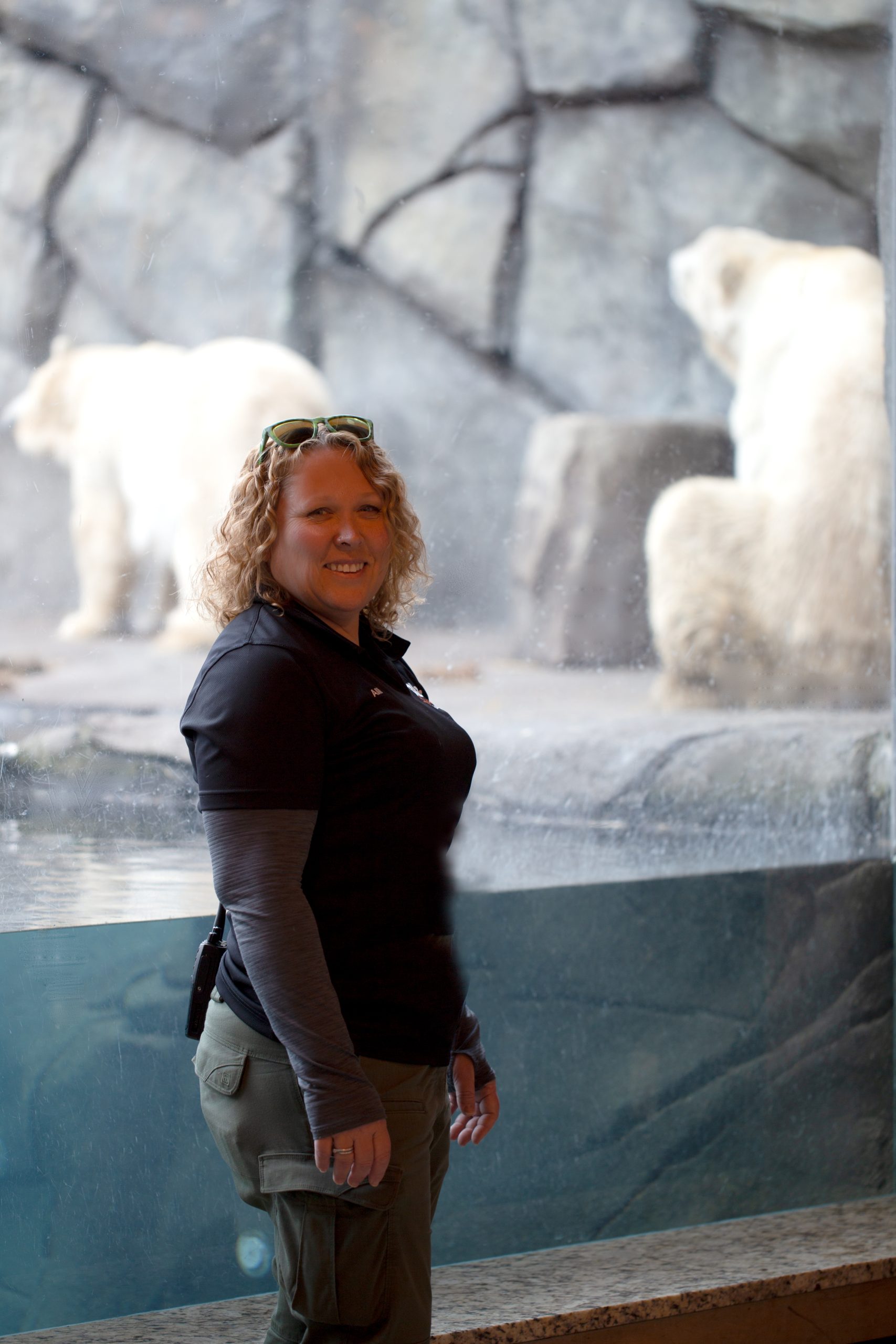
When she shares observations about the polar bears in her care, Senior Keeper Allison Jungheim can sound like she’s talking about her closest friends, bubbling about Nan’s bossy behavior, bragging about Kulu’s impressive weight gain (“At 940 pounds, we should probably stop calling him little Kulu”), and beaming at Neil, the mild-mannered male who first came to Como Zoo with his brother Buzz back in 2001. “He is my bear,” she says.
Jungheim brings the same enthusiasm to her role as studbook keeper for North America’s polar bears, responsible for tracking the genetic health and history of some 60 individuals living in partner zoos across Canada and the U.S. A project of the Bear Taxon Advisory Group through the Association of Zoos and Aquariums, the studbook is one of the ways that zoos work together to ensure that managed populations of polar bears are living their best lives.
Similar to your family’s own electronic medical records that allow for more coordinated health care, “keeping all of that data in one place is super important for the longevity of animals,” Jungheim says. “The studbook also gives me the ability to look back at historic animals and current animals, to see who’s related to whom, and who should breed with whom.”
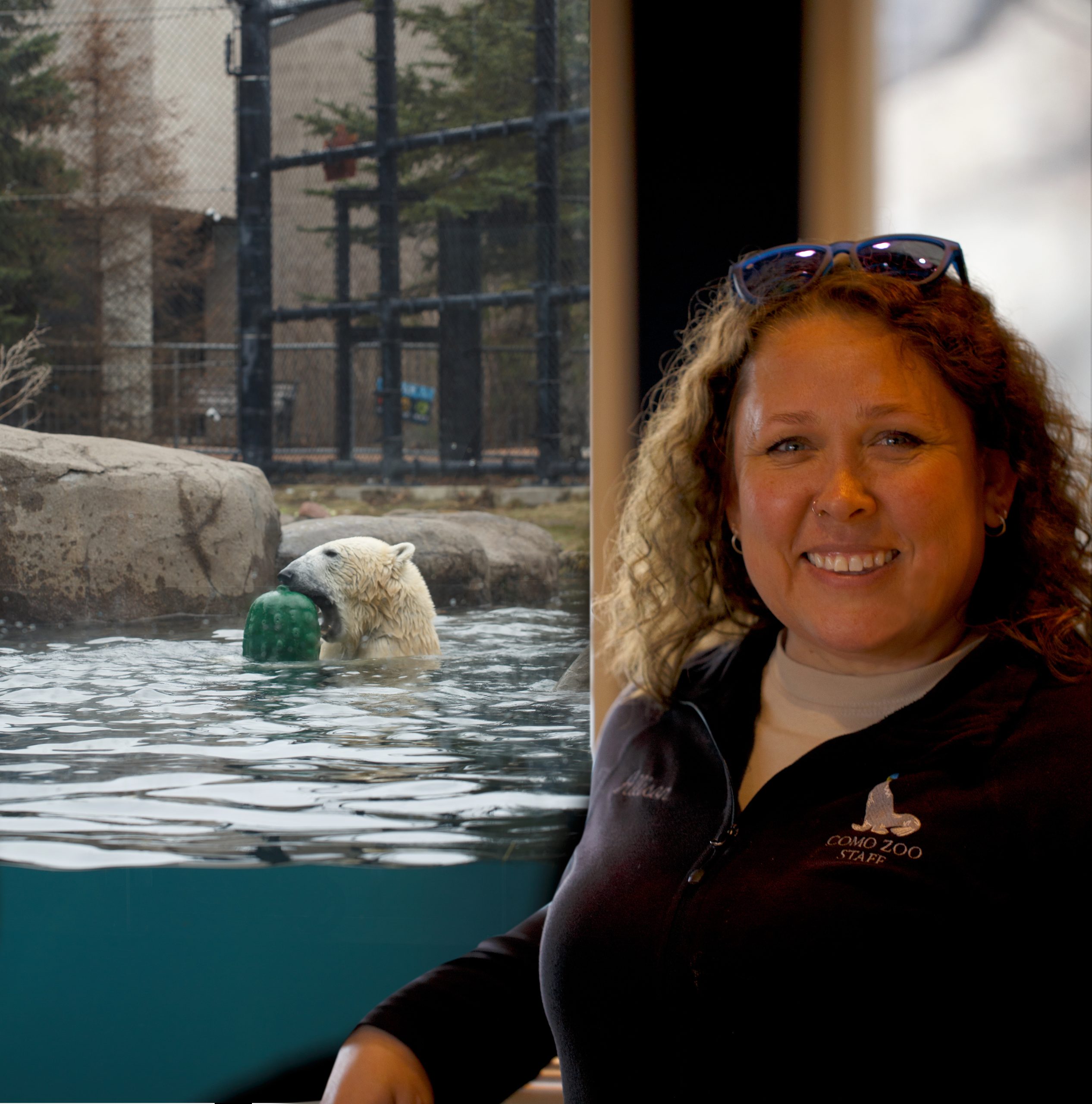
While Como Zoo’s keepers have earned national recognition for their success at reducing polar bear repetitive behaviors and developing tools for improving polar bear blood draws, Jungheim’s longtime leadership in polar bear preservation is a volunteer effort. “I don’t get any extra money or funding for managing the polar bear studbook, but it’s worth it to be part of the bigger picture, helping polar bears around the country, and not just here at Como.”
Polar bears require just the right conditions for successful breeding, both in zoos and in the wild. While polar bears will typically mate in early spring, they’re one of more than 130 animal species with delayed implantation, meaning that fertilized eggs don’t implant in the uterus until months later. The delay allows females to build up the fat reserves they’ll need to support themselves and their cubs during a long denning period. “But if the female doesn’t gain enough weight, or have good enough body condition, she may not implant that embryo or embryos at all,” explains Jungheim. The long dormancy period means that if one breeding pair is unsuccessful, zoos don’t have much time to establish a new pairing.
“That’s one reason why collaboration with other zoos is so important,” she says, noting that the polar bear community of keepers, managers, and veterinary staff have regular virtual meetings throughout the year, sharing breeding and denning news, and exploring new strategies. “One of the things we’re trying is to create more choice for mates by pairing more than just one male and one female,” she says. “Our thought is that by giving mate choice, it gives the male the chance to share the love with other females, and increases competition for breeding, and hopefully, increases success rates.”
With that strategy in mind, Como Zoo is getting ready to welcome a new female bear from a partner zoo, who might make a good breeding partner for Kulu. “With an aging population of bears, we’re trying to shake things up,” Jungheim says. If the pairing works, she may even have a couple of new names to add to the polar bear studbook.
Funding from Como Friends enabled Allison Jungheim to travel to attend an in-person polar bear conference, strengthening the network of connections zoos rely on to help bears live their best lives.
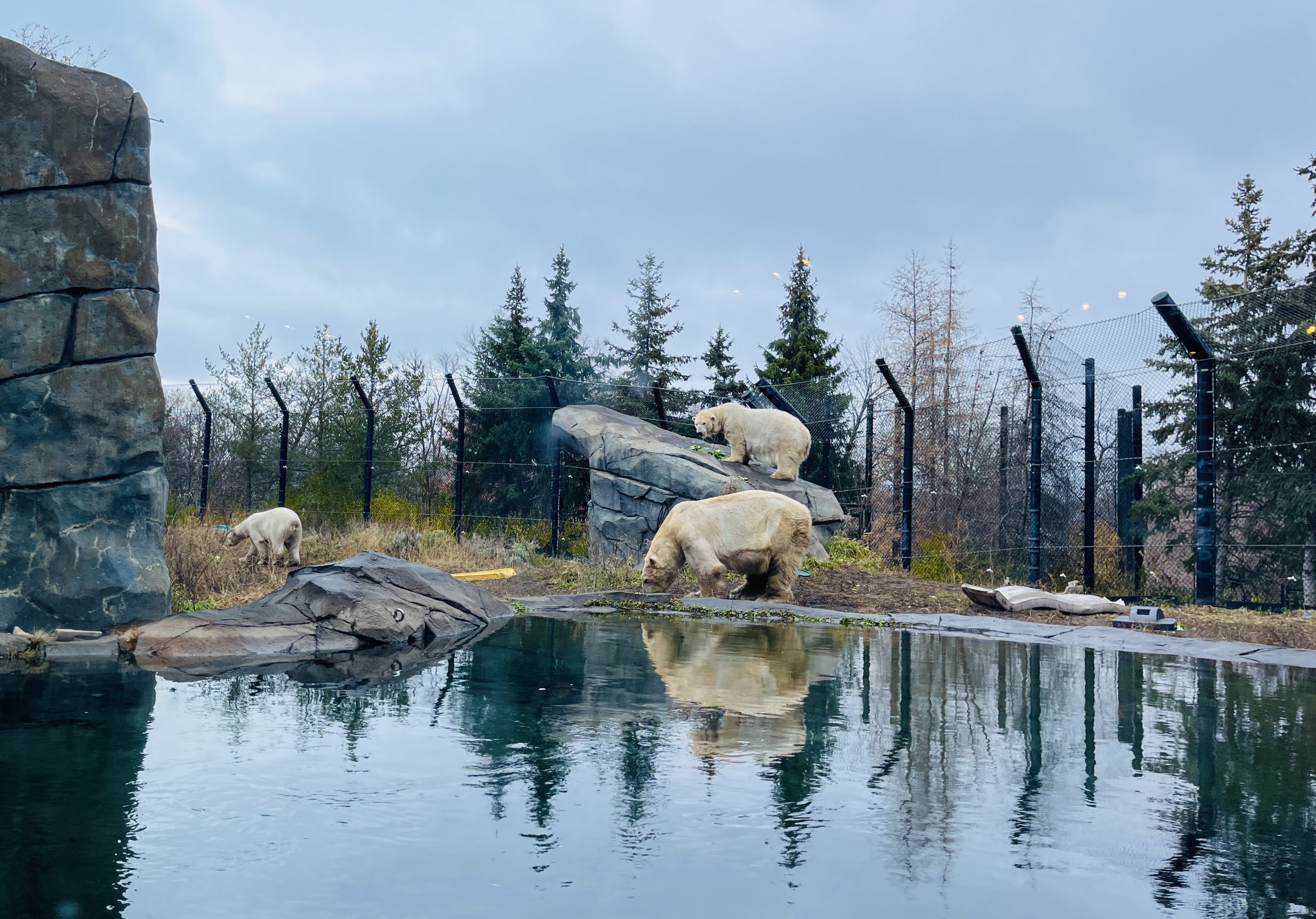
Celebrate Party for the Planet at Como on
April 26 and 27 | Presented by Xcel Energy
There’s no better place to celebrate Earth Day 2025 than Como Park Zoo & Conservatory, where our annual Party for the Planet is a two-day weekend celebration for visitors of all ages. Powered by our friends at Xcel Energy, this year’s Earth Day theme, “Our Power, Our Planet,” celebrates the movement toward renewable energy. With family-friendly activity stations, and splashy public programs like our Blaze Sparky Show, Party for the Planet is a great way to learn more about what you can do to protect our environment on Earth Day and every day.
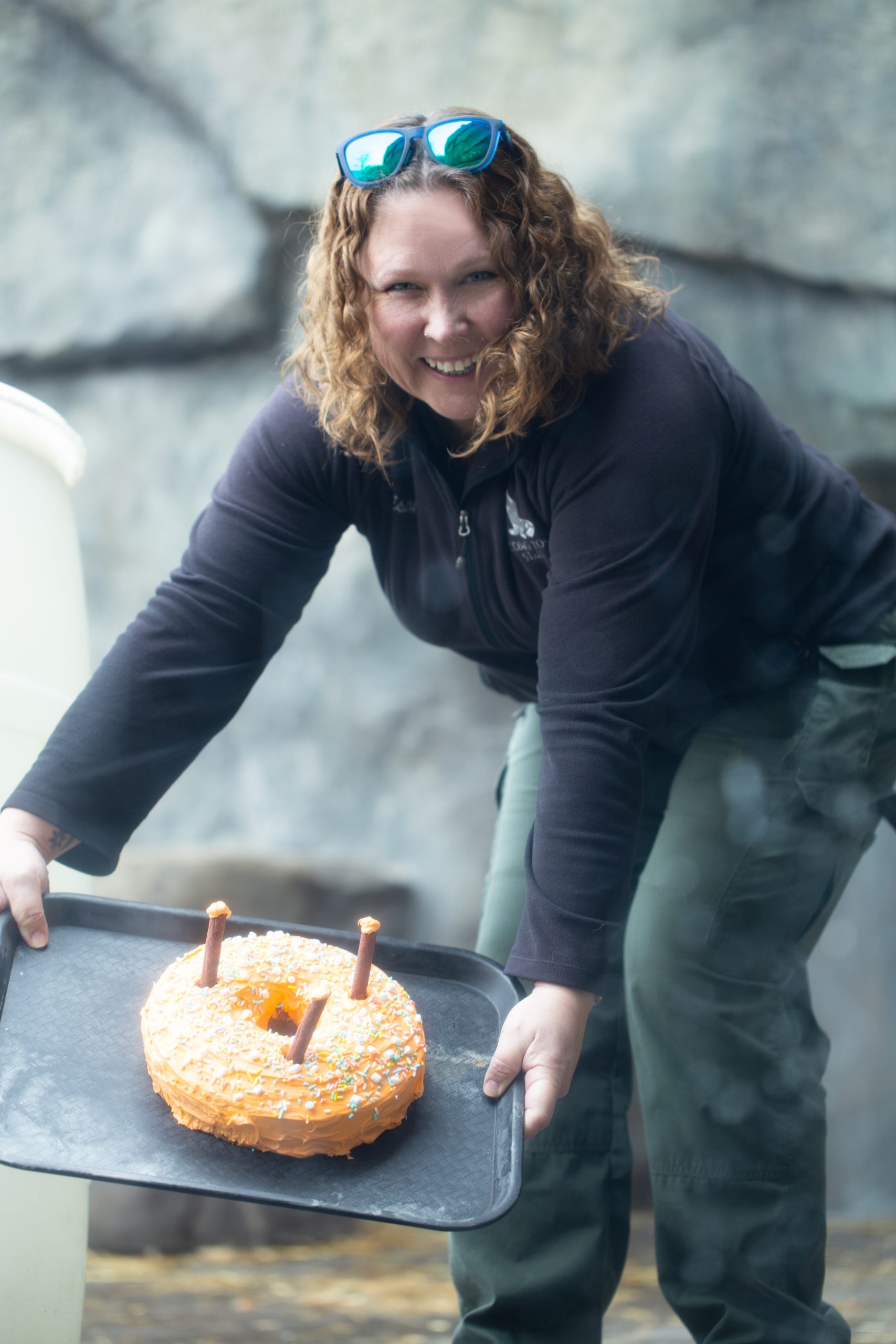
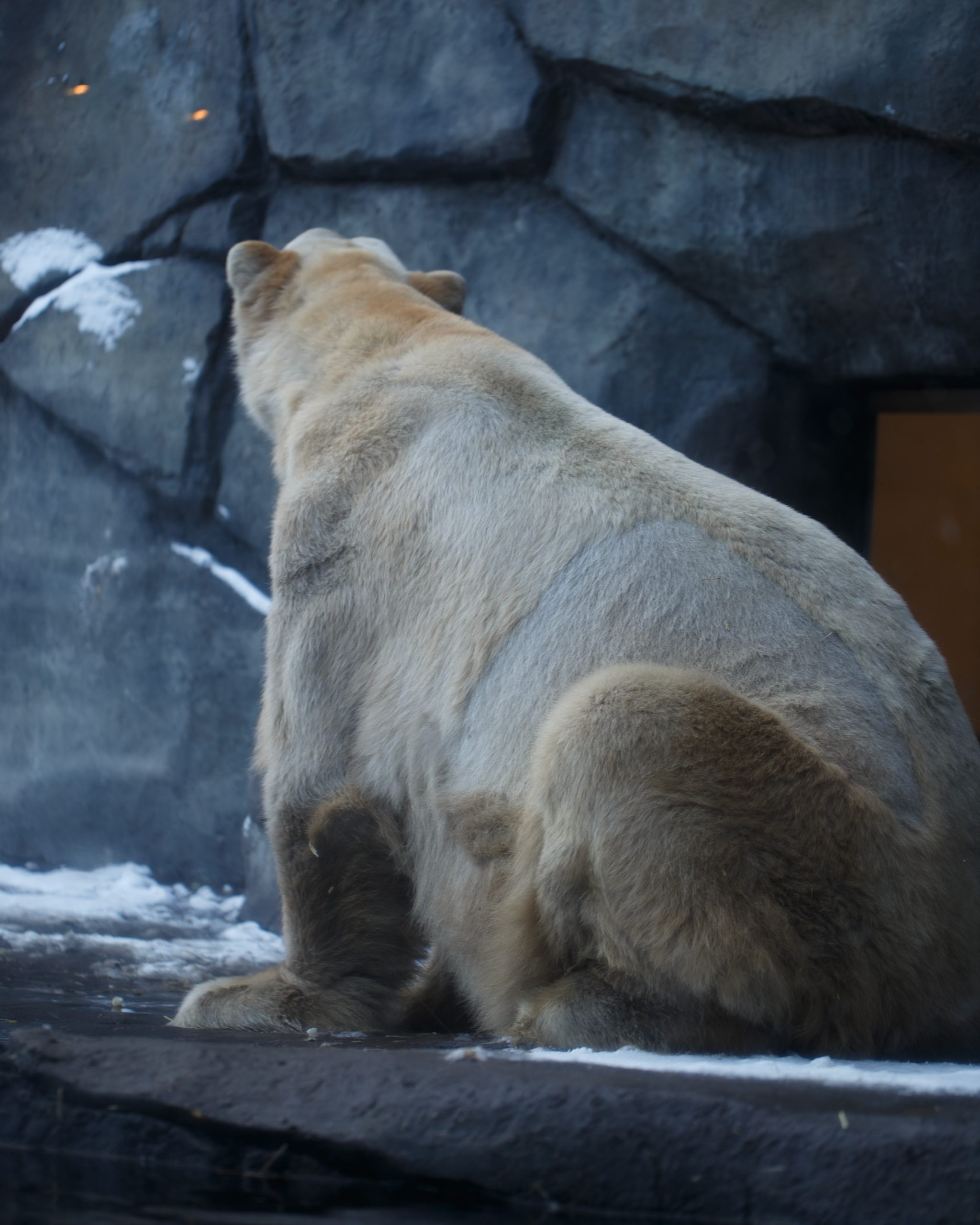
Como’s redesigned Residency Program is bringing the power of plants and animals to third graders across the state
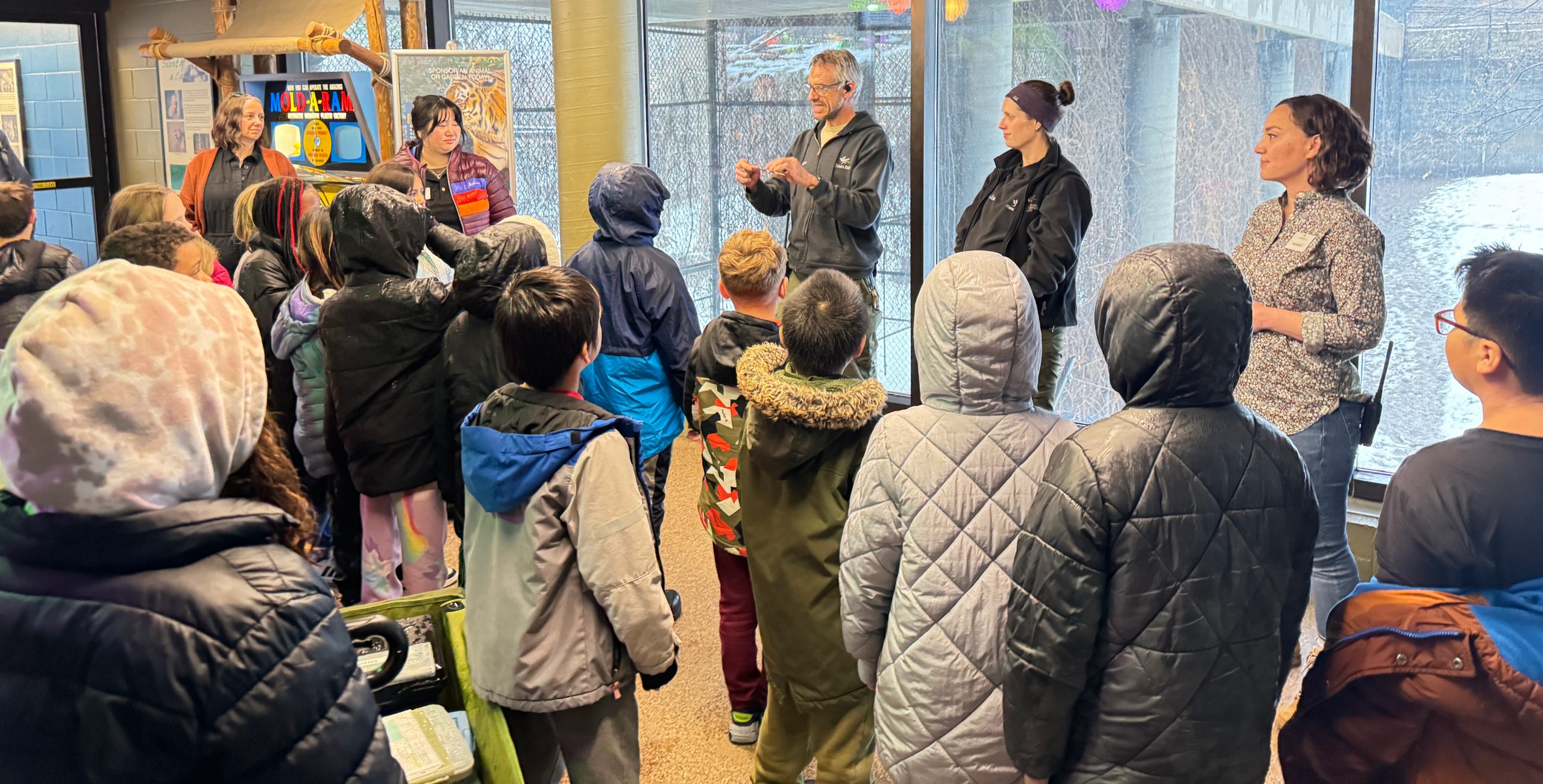
Residency Program students from Roseville’s Central Park Elementary School recently welcomed two new African crested porcupines to Como Zoo’s Large Cat Building by making artwork for their habitat. The porcupine pair were recently relocated to Como following the closure of SeaQuest in Roseville.
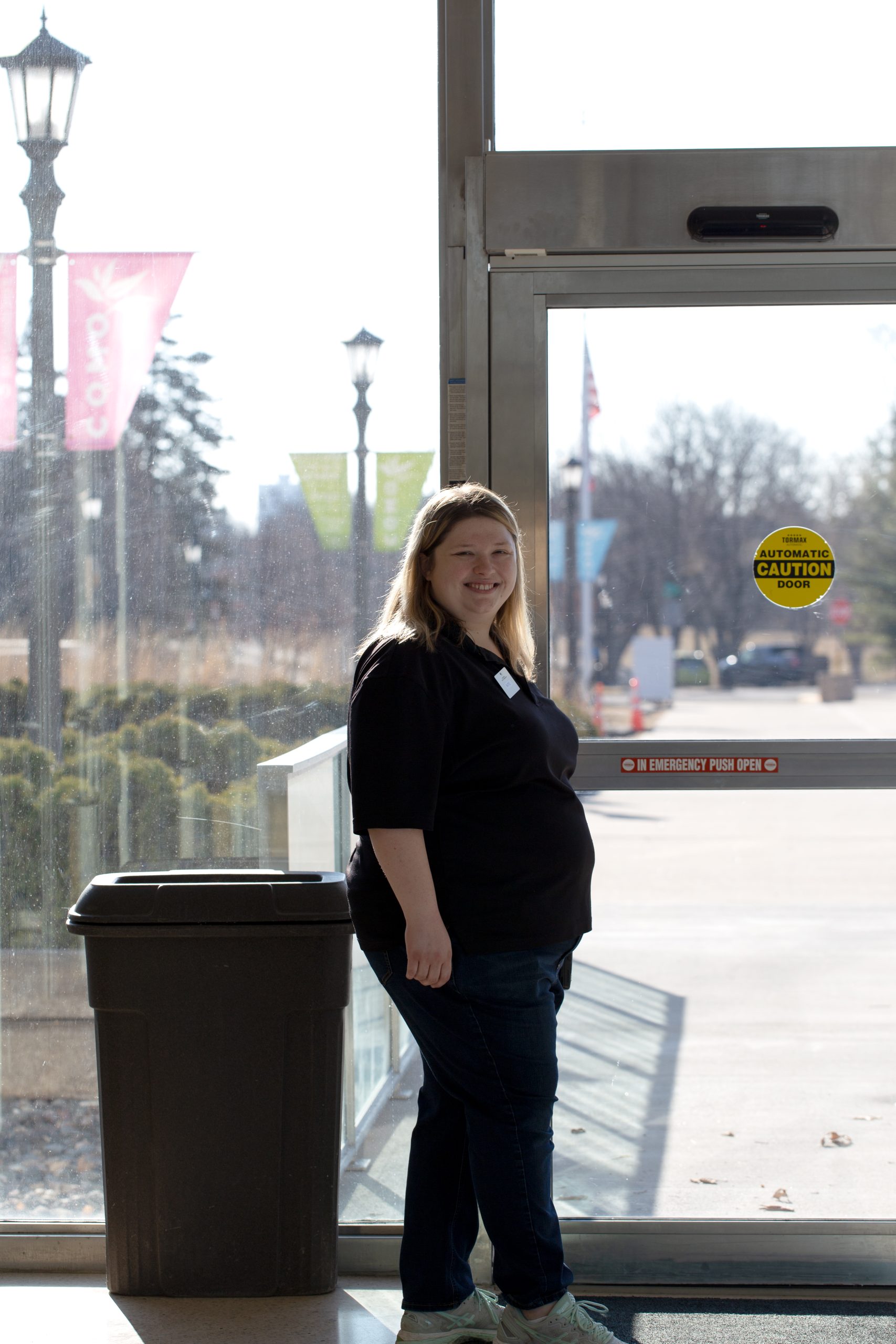
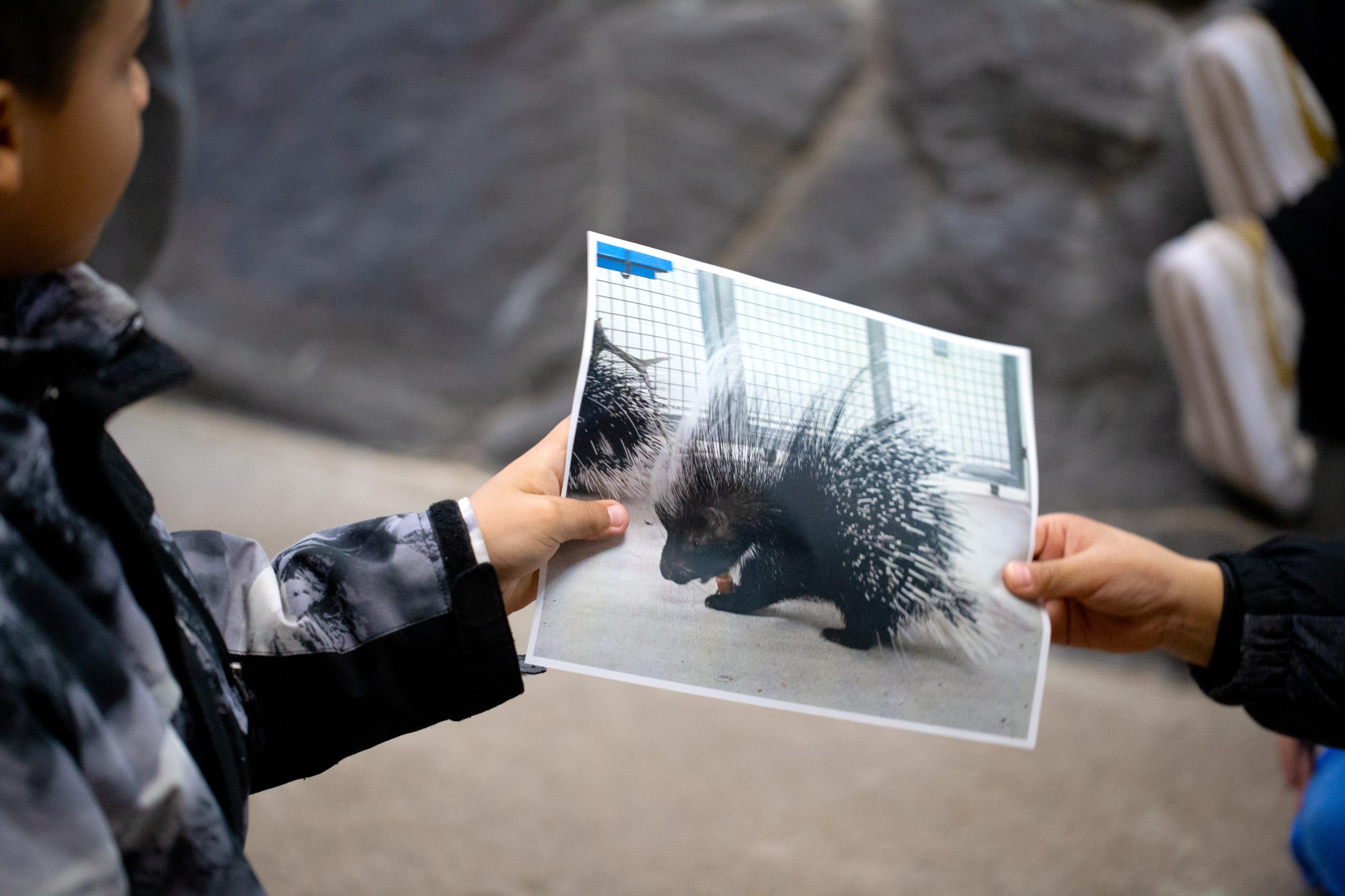
Melrose, Minnesota, is more than a 90-minute drive to Como Park Zoo and Conservatory—longer during rush hour—which makes a field trip to the Twin Cities out of the question for most classrooms.
But thanks to Como’s new and improved Residency Program, 25 third graders in Ms. Brown’s class at Melrose Area Elementary School recently got the chance to spend quality time with Katie Raeker, an educational specialist who knows nearly everything there is to know about Como’s plants and animals. During the course of four days in April, Raeker visited the class for nearly five hours every day, bringing live plants, biofacts, fun animal profile videos and boxes and boxes of art supplies to teach a program called Exploring Ecosystems, that compares the biomes of Minnesota to those of the Brazilian rainforest.
“What’s really fun about teaching kids in greater Minnesota is that they often have first-hand experience with the animals I often bring up in class,” says Raeker. “If I show them a pair of antlers, they know the difference between a deer and a moose. And if I ask ‘How many of you have seen a wolf?’ lots and lots of hands go up. Compared to the kids we teach in the Twin Cities, it leads to very different conversations.”
Taking Como’s education curriculum on the road is the latest iteration of Como’s Residency Program, an immersive conservation program offered free of charge to area schools and made possible by Minnesota’s Legacy Amendment. Several years ago, this popular program got its start by inviting classrooms around the Twin Cities to relocate to Como, using both Como Zoo and the Marjorie McNeely Conservatory as the backdrop for days of cross-disciplinary learning. Put on pause during the pandemic, the Residency Program resumed in January 2025, simultaneously offering on-site experiences for third grade classrooms around the Twin Cities, and off-site programs for third graders across the state.
In fact, the same day Raeker was teaching in Melrose, Residency Program Specialist Grace Coughlin was leading a group of third graders from Roseville’s Central Park Elementary into a new habitat in the Large Cat Building that is now home to two new porcupines. Large cat keepers Hans Jorgensen and Caitlin Allessi greeted the group, and invited them to decorate the glass enclosure with big rolls of craft paper and magic markers.
“So many of the teachers have been telling us how grateful they are for the opportunity to have an art component to the program,” says Residency Coordinator Madeline McCullough. “The other thing we’re hearing is that they really appreciate our multi-modal approach with our curriculum. There’s movement throughout the day, videos and slideshows and pictures, class discussions, and very tactile experiences with biofacts and plants. The curriculum makes them feel supported, and it works to reach many different types of learners.” Another strength of the program: McCullough, Coughlin, and Raeker are all former classroom teachers, skilled at shaping lesson plans to fit the needs of participating classrooms.
With a waiting list of schools eager to sign up, Como has prioritized Title I classrooms where a significant portion of students are from disadvantaged backgrounds, or are eligible for free or reduced-price lunch. In addition to the free classroom experience, Como reimburses local schools for the full cost of bus transportation to campus, ensuring that cost is no barrier to participation. While nearly half of the programs happen right on Como’s campus, for many participating students, it’s their very first trip to Como Park Zoo and Conservatory. “Even though Como is in the backyard for a lot of our participating schools, a lot of kiddos have never been to a zoo before,” says Coughlin. “It’s really fun to show them around and to see their faces the first time they see a giraffe, or watch a sea lion swimming in the water.”
The focus on third graders helps area schools meet state science standards, while connecting with kids in the sweet spot for conservation education. “It’s the perfect age for this program, because they’ve been in school enough years that they have the basic skills down, and they’re a little bit more independent so they can be critical thinkers and sponges for information,” says Raeker.
“Also third graders have no filter, and they have so many interesting questions,” says Coughlin. “Kids are always excited to find out that Como is free and open every day. And a lot of them really want to know when they can come back with their parents.”
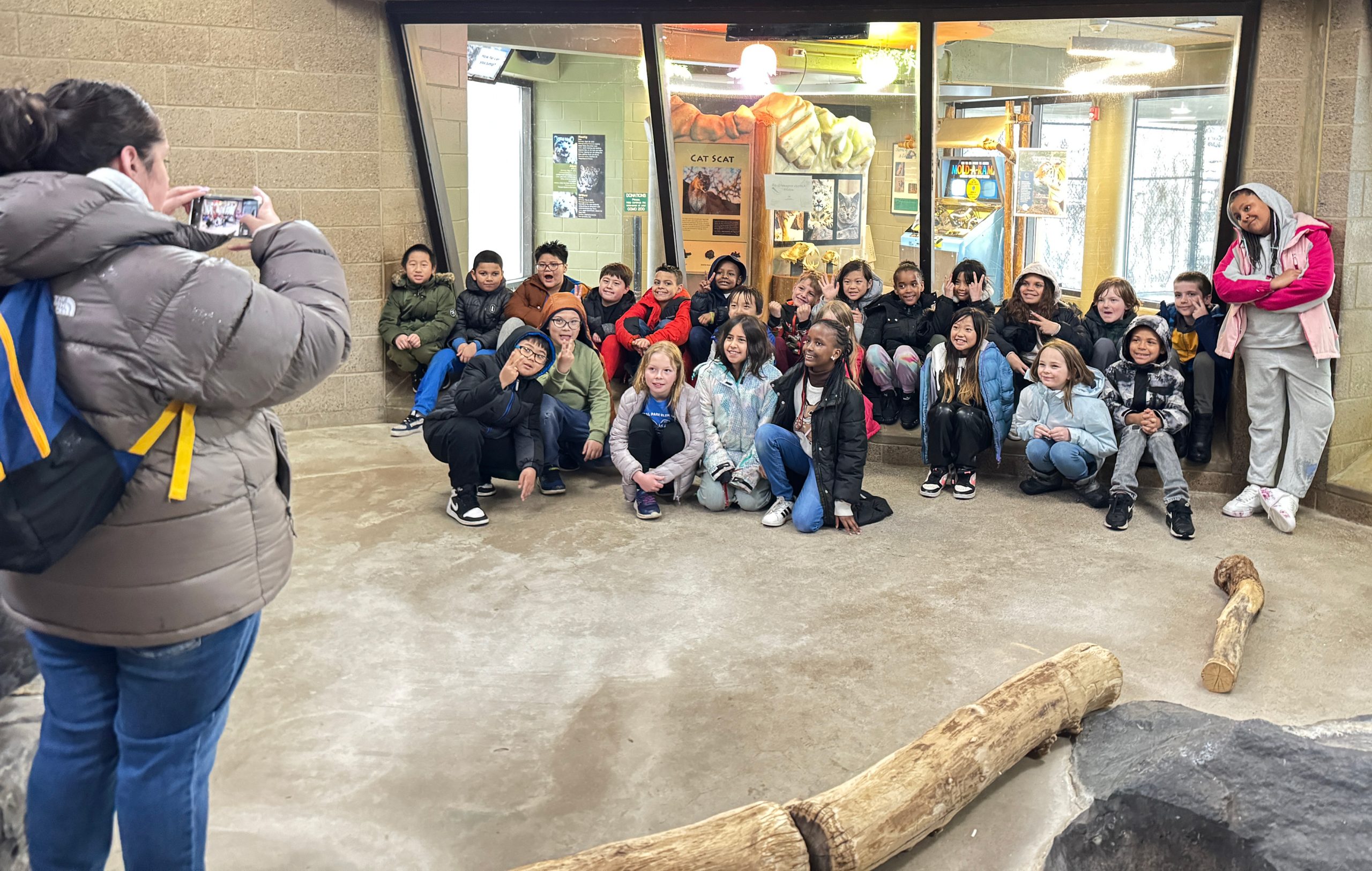
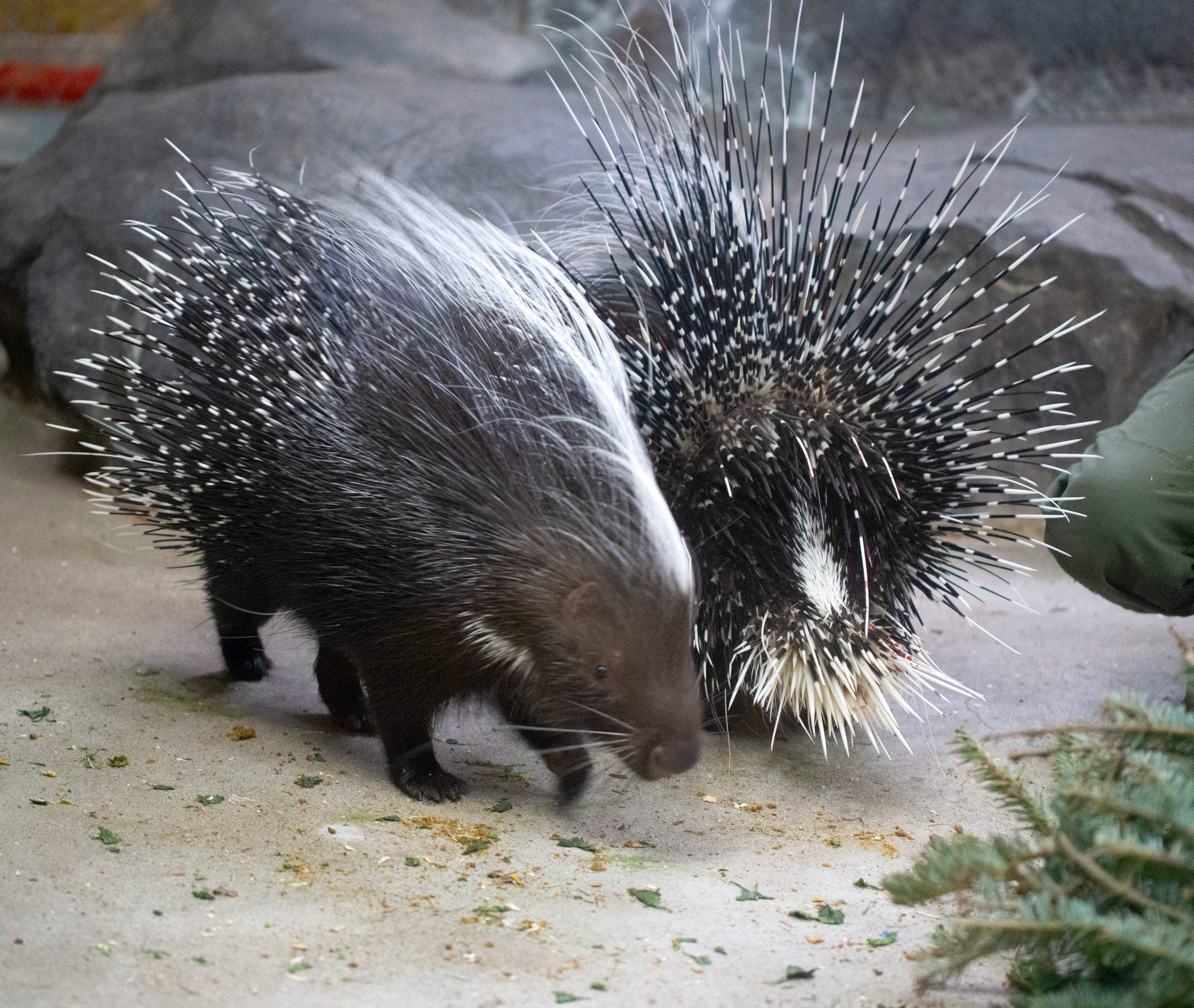
Meet Ray Watson, the Marjorie McNeely Conservatory’s new horticultural curator
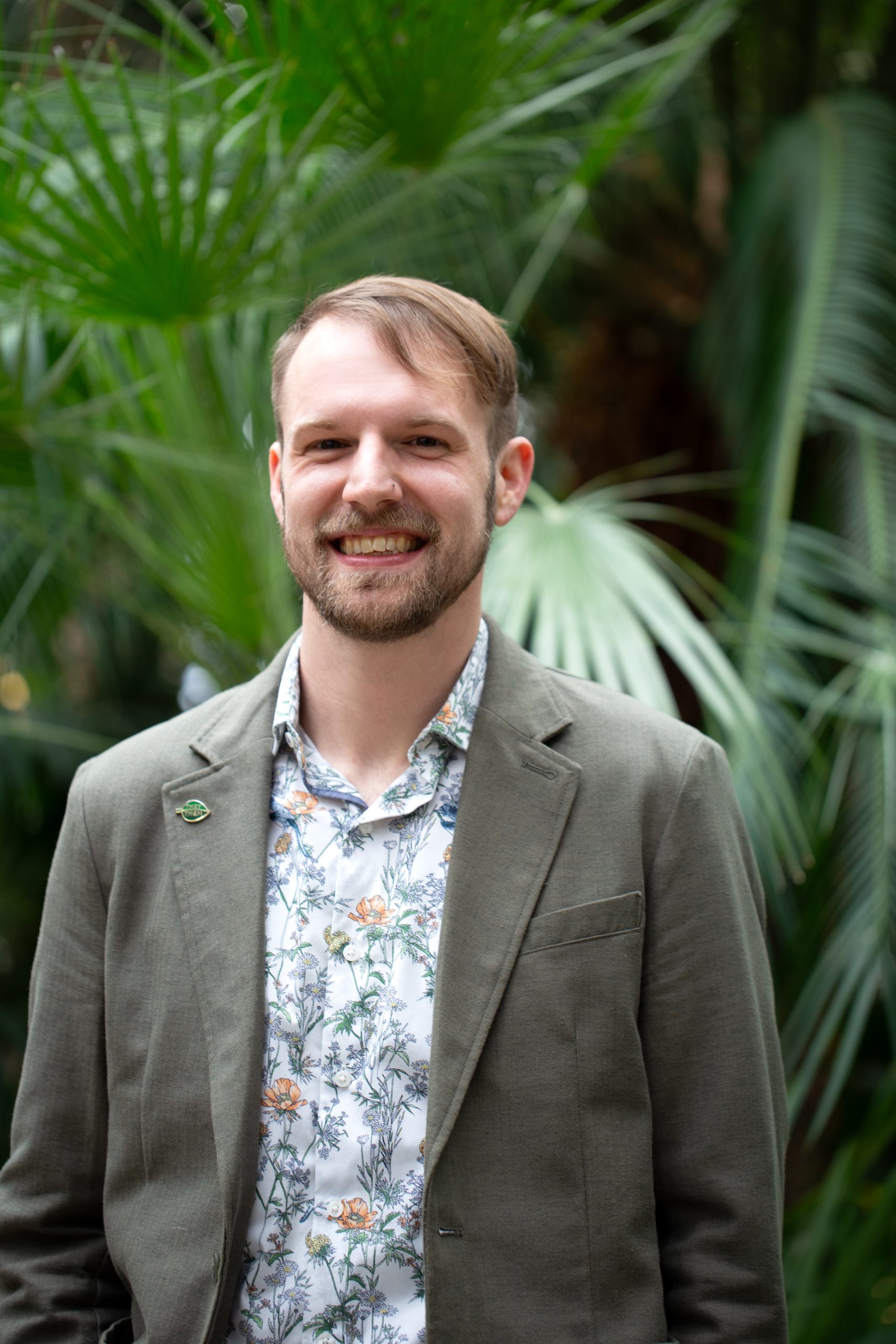
Since taking on the role as curator at the Marjorie McNeely Conservatory, Ray Watson has been impressed by just how passionate Como’s horticulturists are about the plants in their care.
“Within my first week here, every staff member I met apologized for gushing and going on about what they’re interested in, whether that’s staghorn ferns, or carnivorous plants, or orchids,” Watson says. “That enthusiasm is why the plants here are so beautiful and well cared for, and I think the passion that people who work here have for plants evokes something in visitors as well.”
Watson’s own passion for the conservation of living things has been the common thread on a career path that’s taken them from farm work and landscape design, to education and youth engagement, to genomic research and COVID science. “The Marjorie McNeely Conservatory is really fortunate to have found someone with Ray’s unique mix of skills and interests, from field conservation, to curriculum writing, to greenhouse operations,” says Como Friends’ president Jackie Sticha. “Their perspective will definitely help strengthen and grow the plant collections at Como, and how those resources connect visitors to our conservation mission.”
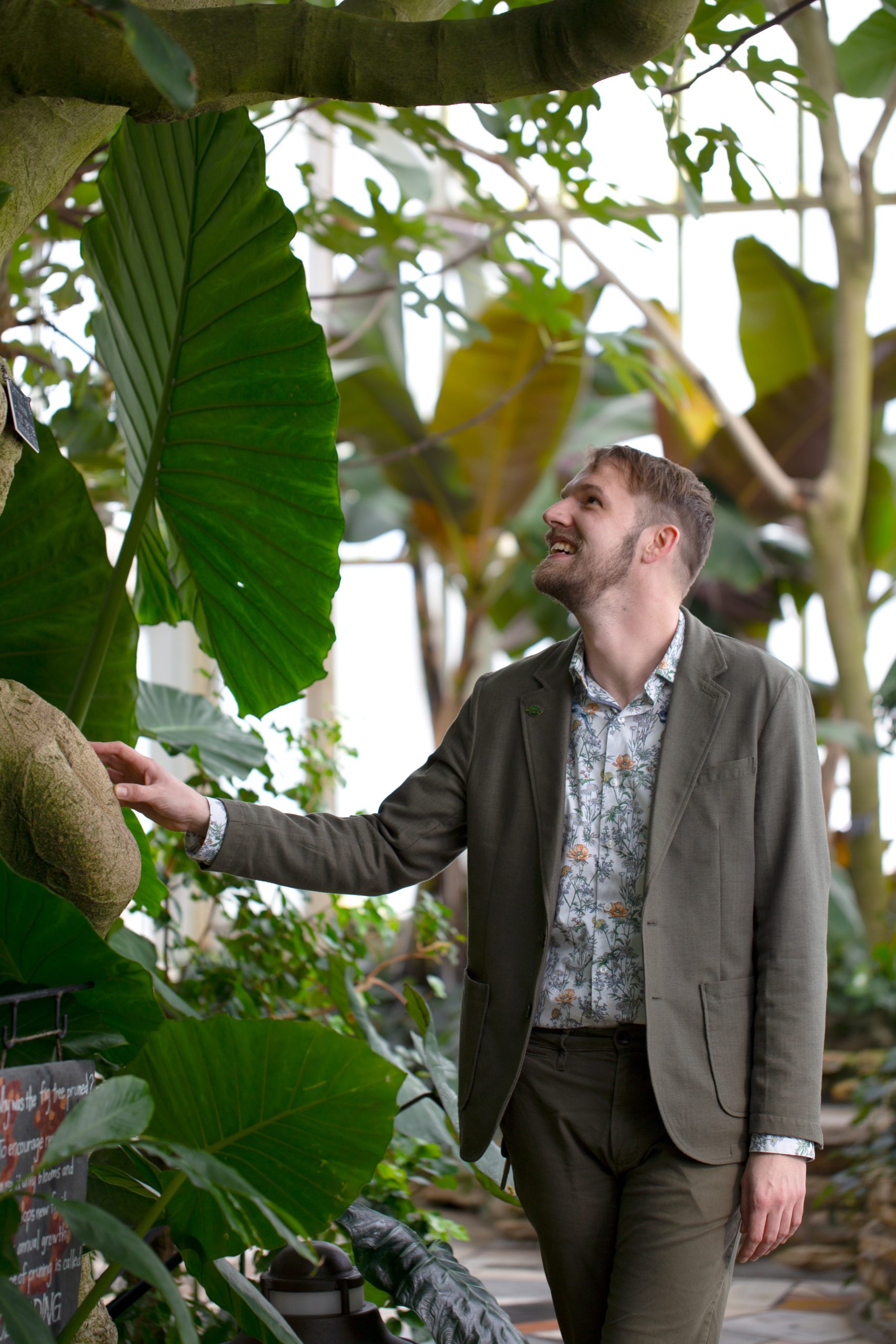
A graduate of Swarthmore College, Watson earned a double major in religious studies and biology, where their research focused on hormones and mating behavior in forked fungus beetles. In graduate school at the University of Virginia, Watson earned a master’s degree in Ecology and Evolution, diving deep into the genetic evolution of domesticated sunflowers. Watson also served as a visiting scholar at the University of California, Berkeley and worked as an educator with the Smithsonian National Museum of Natural History’s Youth Engagement through Science program, writing curriculum as well as collecting and managing research populations of teaching specimens.
Moving to Minnesota with their partner, Watson joined the University of Minnesota’s Genomics Center just before the start of the pandemic, going on to lead a team of researchers in developing COVID testing protocols. But a first visit to the Marjorie McNeely Conservatory’s North Garden inspired them to think about returning to plants as the focus of their work.
“Though I really enjoyed my role in research and development, during the pandemic, I realized that I was more of a public servant than a scientist,” Watson says. “This role really appealed to me because it was a marked shift toward providing that direct service to the public, using the resources that are available here from the city to benefit everyone in the community.”
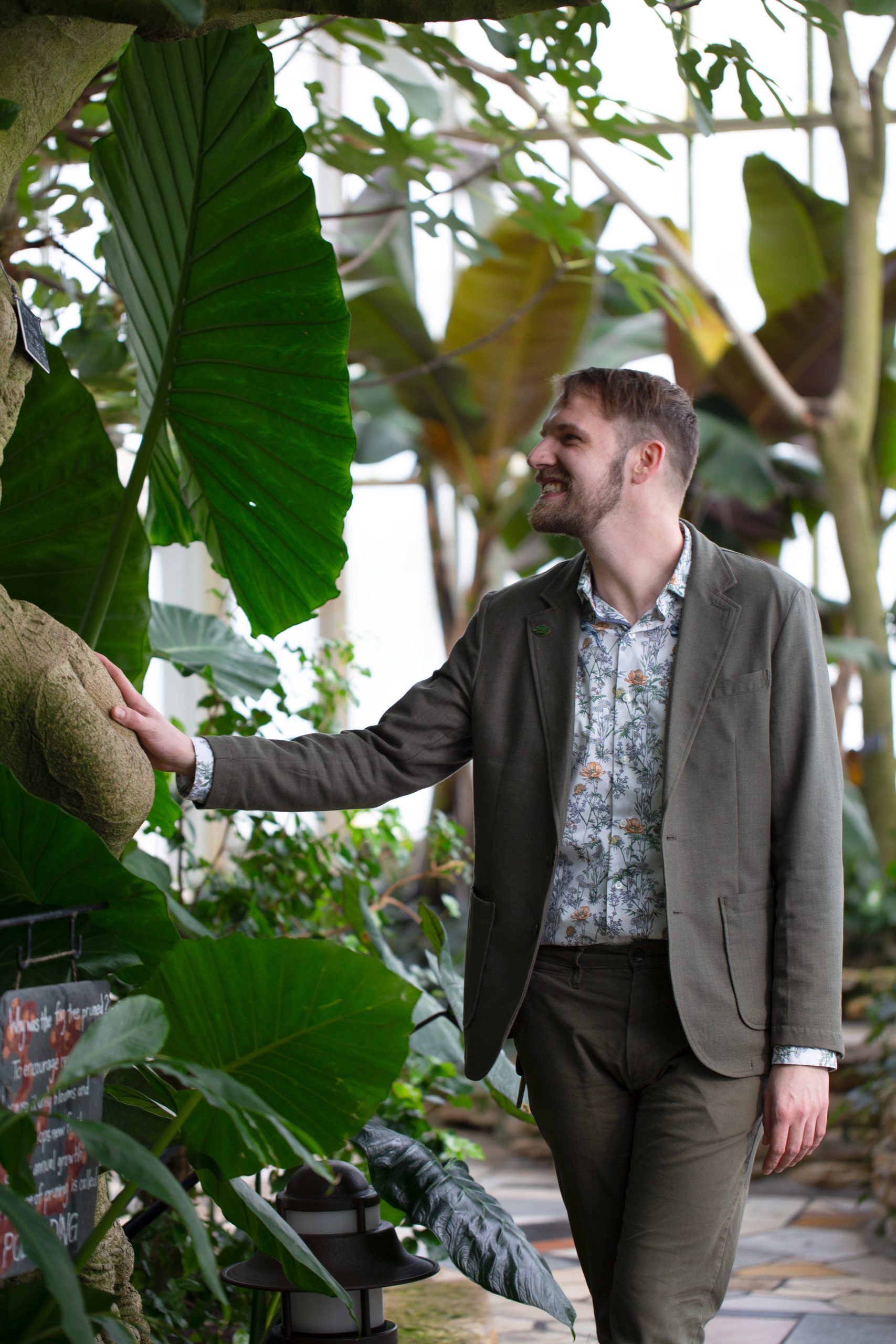
One of Watson’s favorite spots in the Marjorie McNeely Conservatory is the North Garden, home of a long-standing fig tree they’ve affectionately dubbed “Figaro.” To keep the fig from overgrowing its setting, the tree was recently pollarded by Watson and horticulturists Jennifer Love, Isaac Zaman, and Rylee Werden. Pollarding is an age-old system of repeated methodical pruning in which the upper branches of a tree are removed. The result is increased growth at the cut points and a dense head of foliage and branches. A pollarded tree has characteristic knobs at the end of the main branches, like you see today.
Thanks to your generous support, the horticulture team has a lift and other essential tools to carefully trim and maintain the beautiful trees throughout Como’s indoor garden spaces, keeping them healthy and vibrant for everyone to enjoy.

